Early Views of the San Fernando Valley
Historical Photos of the San Fernando Valley |
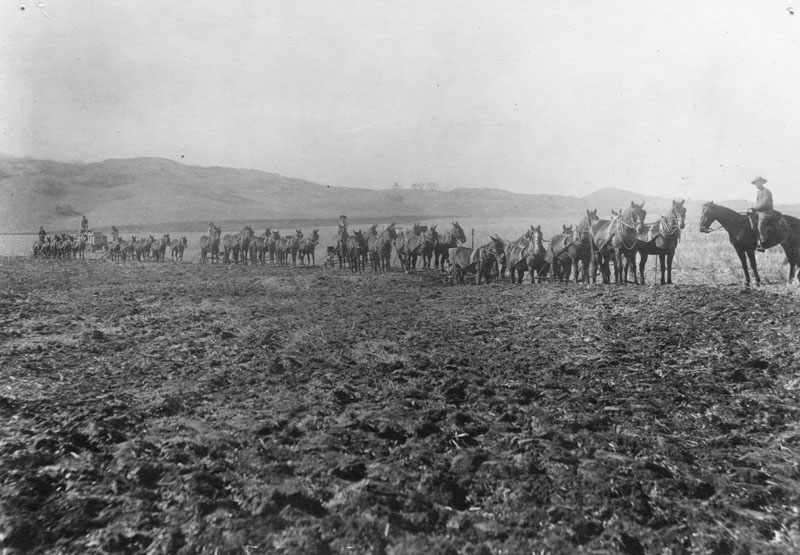 |
|
| (1880s)* - Horses plowing a field in the San Fernando Valley in the early 1880s. Al Redden is the foreman, viewing the teams of eight horses each. |
San Fernando Valley Historical Background The Tongva, Tataviam (north), and Chumash (west) Indians had lived and thrived in the Valley and its arroyos for over 8,000 years. They had numerous settlements, and trading and hunting camps, before the Spanish arrived and took their homeland in 1797 for the Mission San Fernando Rey de España and Las Californias ranchos. Rancho Encino was short lived, though, with the land traded so a Mission could be sited and built there. Mission San Fernando Rey de España was established in 1797 as the 17th of the twenty-one missions. The land trade granted Juan Francisco Reyes was similarly named Rancho Los Encinos, and was also located besides springs at the present day location of Los Encinos State Historic Park in Encino. Later the Mexican land grants of Rancho El Escorpión (West Hills), Rancho Providencia and Rancho Cahuenga (Burbank), and Rancho Ex-Mission San Fernando (rest of valley) were established to cover the San Fernando Valley. |
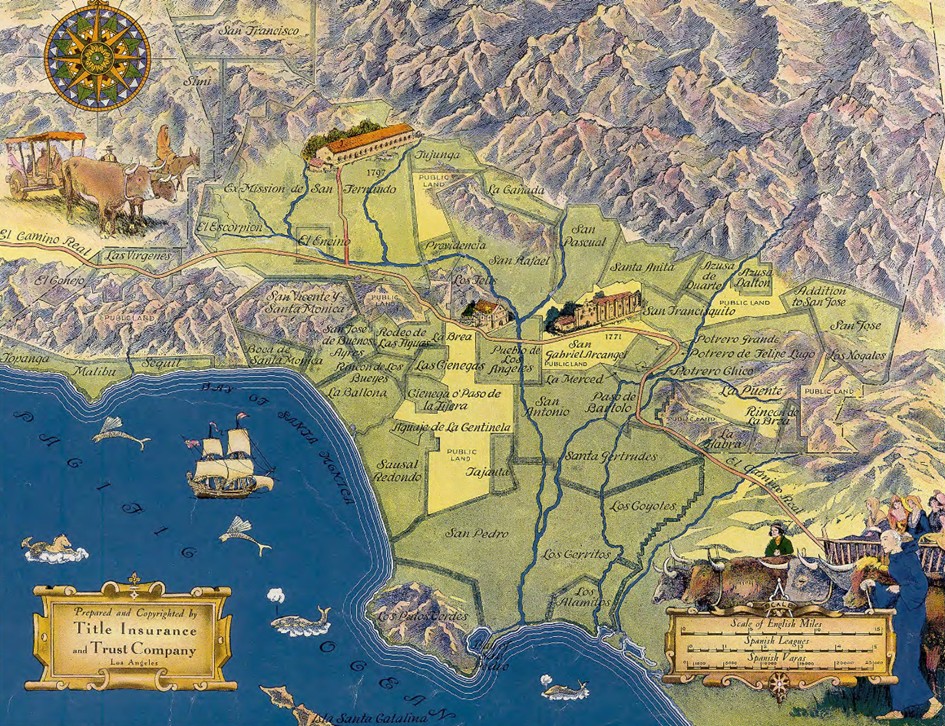 |
|
| (1937)* - Map showing the old Spanish and Mexican ranchos of Los Angeles County. In the upper left can be seen the San Fernando Mission as well as the three main Ranchos that made up the San Fernando Valley at the turn of the century: Rancho Ex-Mission de San Fernando, Rancho El Escorpión, and Rancho El Encino. |
Historical Notes The Spanish and Mexican ranchos of Los Angeles County were large land grants made between 1784 and 1846 to private individuals under Spanish and later Mexican rule. Initially granted to retired soldiers and prominent local families, these ranchos covered vast areas used primarily for cattle ranching and agriculture. After Mexico gained independence in 1821, many mission lands were secularized and redistributed as ranchos, fostering a landed gentry class known as rancheros. The ranchos operated as largely self-sufficient estates, often worked by Native Americans who had lived at the missions. With the U.S. acquisition of California in 1848, land grant holders had to validate their titles through legal processes, leading to subdivision and sale of many ranchos. The boundaries and names of these ranchos have profoundly shaped modern Los Angeles geography, with many neighborhoods and place names—such as Malibu, San Pedro, and Los Feliz—originating from them. The rancho system established land-use patterns and a cultural legacy that remain integral to the region’s identity today. |
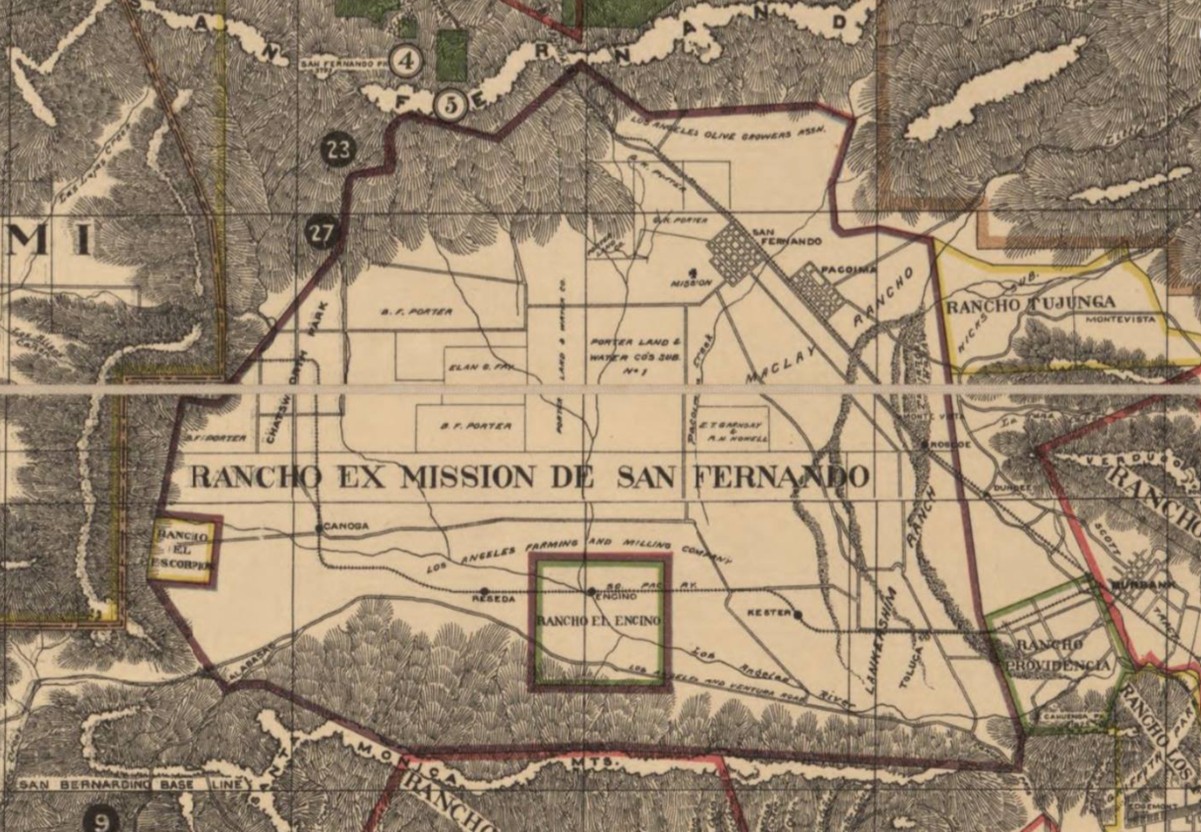 |
|
| (n.d.)* – Early map showing a more detailed view of the three main Ranchos that made up the San Fernando Valley at the turn of the century: Rancho Ex-Mission de San Fernando, Rancho El Escorpión, and Rancho El Encino. Photo courtesy of Rich Krugel. |
Historical Notes Rancho Ex-Mission San Fernando was a massive 116,858-acre Mexican land grant in present-day Los Angeles County, encompassing most of the San Fernando Valley. It was granted in 1846 by Governor Pío Pico to Eulogio F. de Celis, who purchased the secularized mission lands to raise funds during the Mexican-American War. The grant was named "ex-Mission" because it consisted of mission lands outside the immediate church grounds. After acquisition, the rancho was split in 1853 along present-day Roscoe Boulevard between de Celis (north) and Andrés Pico (south). Over time, the southern half passed through Andrés Pico to his brother Pío Pico, who sold it to Isaac Lankershim and partners, leading to large-scale agricultural development. The northern half was sold in 1874 to Charles Maclay and the Porter cousins, shaping much of the San Fernando Valley’s later settlement and land use. Rancho El Escorpión was a smaller rancho of about 1,100 acres, originally a Native American village that became a horse and cattle ranch in 1834. Governor Pío Pico granted it in 1845 to three indigenous men named Urbano, and later a Mexican named Joaquin Romero acquired a share. The land grant claim was upheld by U.S. authorities despite legal challenges. By 1871, Basque immigrant Miguel Leonis became the sole owner. The property was later known as Platt Ranch after being sold in 1912 to dairyman George E. Platt. Rancho El Encino is historically known as a former rancho area within the San Fernando Valley, centered around the natural spring and oak groves that gave the area its name. It was part of the broader network of ranchos that shaped the valley’s early settlement and agriculture. |
* * * * * |
Oldest Known Photograph of the San Fernando Valley
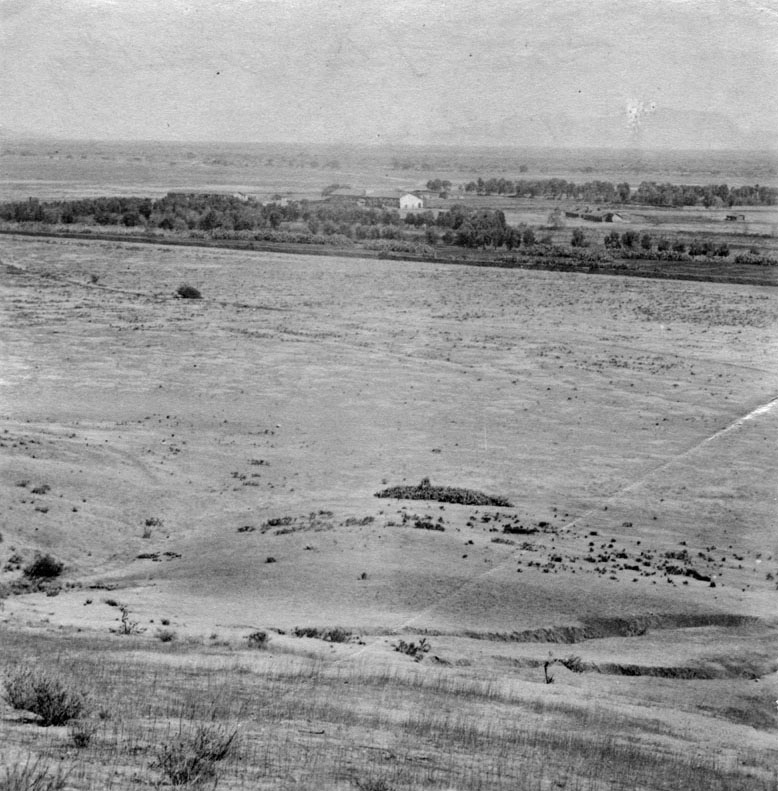 |
|
| (1873)* - This is the oldest known photograph of the San Fernando Valley. View is looking to the southeast, showing San Fernando Rey de España Mission in the center of the photograph. Apart from the mission, the vast land appears to be completely deserted. Mission San Fernando Rey de España is located at 15151 San Fernando Mission Boulevard. |
Historical Notes Founded by father Fermín Lasuén on September 8, 1797 in Mission Hills, Mission San Fernando Rey de España (originally La Misión del Señor Fernando, Rey de España) is located on the former settlement of Encino Rancho. It was the seventeenth mission built in Alto California. It was built in a quadrangle, similar to other missions, in which the church makes up one corner. The Convento stands apart from the quadrangle. |
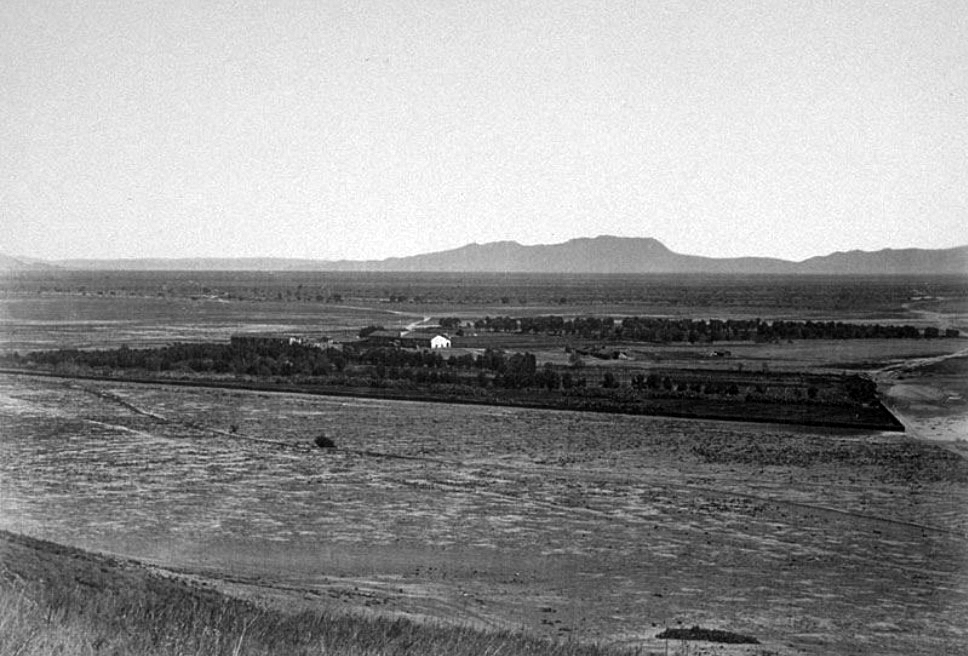 |
|
| (1873)* – Panoramic view of the San Fernando Mission looking southeast across a largely unimproved San Fernando Valley. In the distance are the Hollywood Hills with Cahuenga Pass (low point on the horizon in the upper-right) and the back of Mount Lee (highest peak and ridgeline). |
Historical Notes In 1821, after the successful Mexican War of Independence from Spain, the Mission San Fernando became part of Alta California, Mexico. In 1834, the Mexican government began redistributing the mission lands. In 1846, the Mexican land grant for Rancho Ex-Mission San Fernando was issued by Governor Pío Pico. It was bounded on the north by Rancho San Francisco and the Santa Susana Mountains, on the west by the Simi Hills, on the east by Rancho Tujunga, and on the south by the Montañas de Portesuelo (Santa Monica Mountains). |
 |
|
| (ca. 1875)* - A closer view of the San Fernando Mission and the Valley looking southeast. A clearing stands in the foreground, separated from the buildings of the mission by a line of trees. The buildings stand mainly to the left: a long, two-story adobe can be seen most prominently, surrounded by smaller buildings. The ruins of shorter adobes stand to the right as well. Dirt roads and tree-dappled flatland extends behind them towards the mountains in the distance. |
Historical Notes Rancho Ex-Mission San Fernando was a 116,858-acre Mexican land grant in 1846 by Governor Pío Pico to Eulogio de Celis. The grant derives its name from the secularized Mission San Fernando Rey de España, but was called ex-Mission because of a division made of the lands held in the name of the Mission — the church retaining the grounds immediately around, and all of the lands outside of this were called ex-Mission lands. The grant encompassed most of the present day San Fernando Valley. |
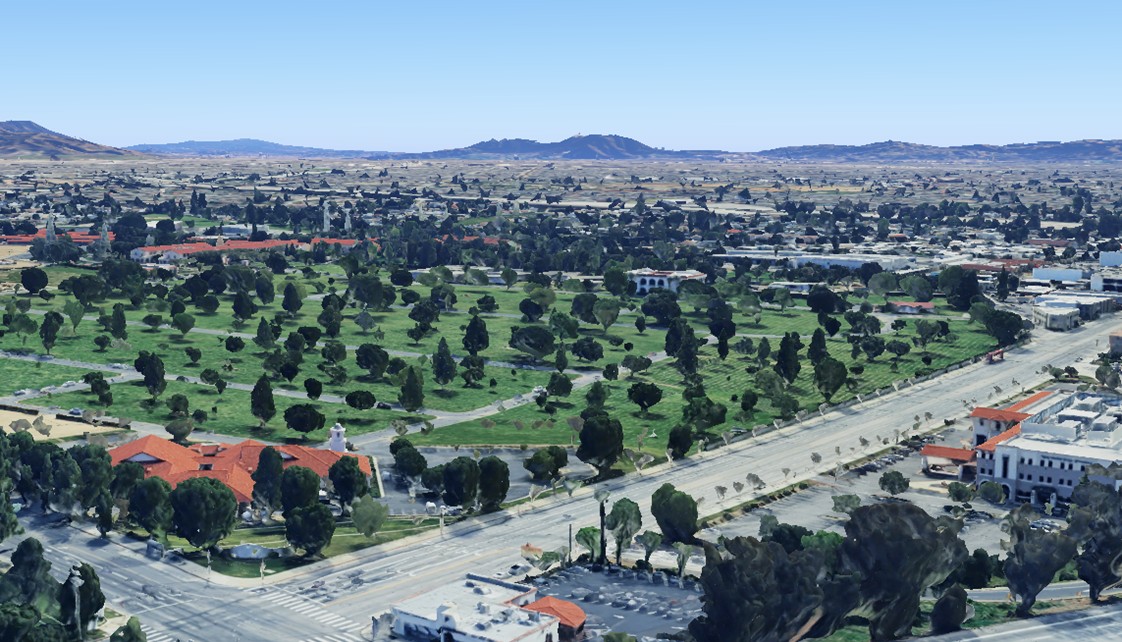 |
|
| (2023)* - Google Earth view looking southeast toward the San Fernando Mission (center-left), with the Hollywood Hills in the distance. The Cahuenga Pass is visible as the low dip on the horizon at upper right, with the back of Mount Lee forming the tallest ridge. The intersection of Rinaldi Street and Sepulveda Boulevard appears at lower left. |
Historical Notes In the foreground are the San Fernando Mission Cemetery & Mission Hills Catholic Mortuary. |
Then and Now
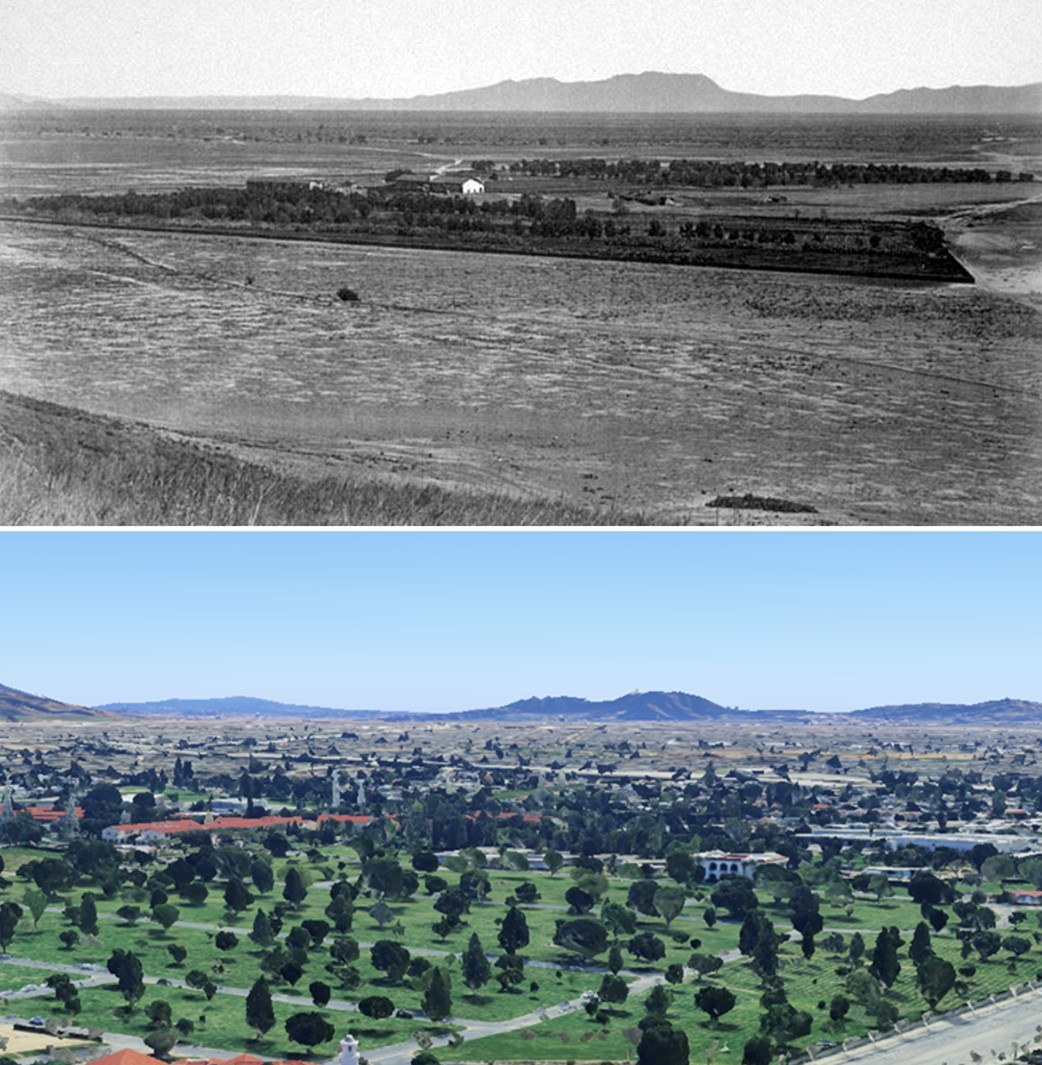 |
|
| (1873 vs 2023)* – Southeast-facing view from above what is now the intersection of Rinaldi Street and Sepulveda Boulevard, looking toward the San Fernando Mission. In the distance rise the Hollywood Hills, with Cahuenga Pass visible as the low point on the horizon at upper right. The back side of Mount Lee forms the highest peak and ridgeline. In the present-day image, Sepulveda Boulevard appears at lower right. Photo comparison by Jack Feldman. |
* * * * * |
San Fernando Mission
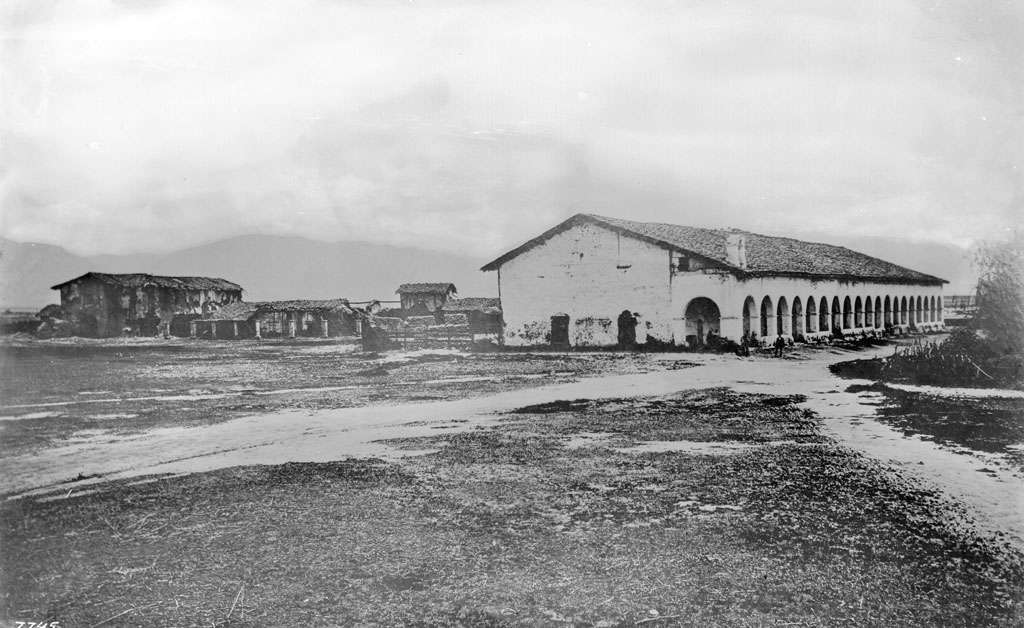 |
|
| (1870s)* - San Fernando Mission - Two dirt paths enter in from the foreground, intersecting at the adobe cloister of the mission, which stands to the right of center. A collection of archways holds the eaves of the terracotta-tiled roof up over the cloister's patio. More adobe buildings can be seen to the left, with two-story adobe building standing to the left of an older cloister whose roof has collapsed. |
Historical Notes In 1874, after the death of Eulogio de Celis, the family sold their northern half of Rancho Ex-Mission San Fernando to northern Californians, California State Senator Charles Maclay and his partners George K. Porter, a San Francisco shoe manufacturer, and his cousin Benjamin F. Porter. The Porters’ land was west of present day Sepulveda Boulevard including most of Chatsworth, and the Maclay land was east of Sepulveda Boulevard. Roscoe Boulevard was the border on the south, with a syndicate led by Isaac Lankershim acquiring the southern half of the Valley. |
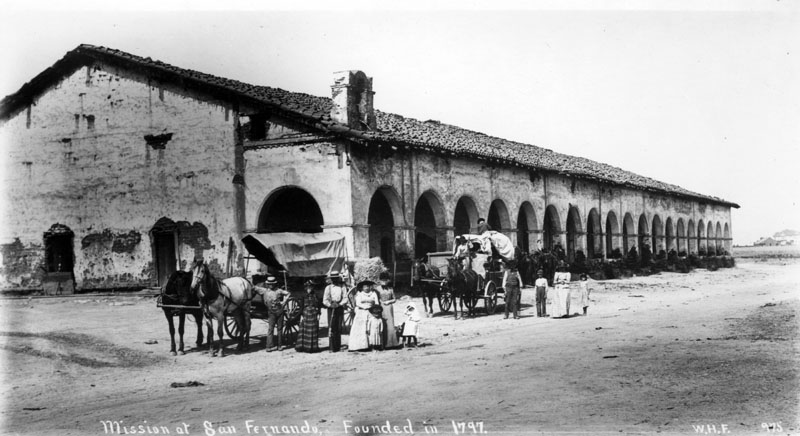 |
|
| (1800s)* - View of the San Fernando Mission's Convento Building, also known as the "Long Building." Two families stand next to their horse-drawn carriages, which have stopped along the road that would eventually become "El Camino Real". |
Historical Notes Construction of the arched Convento Building began in 1810. It took 13 years to construct and was completed in 1822. Most noted for its 21 Roman arches, it is the largest two-story adobe structure in California. |
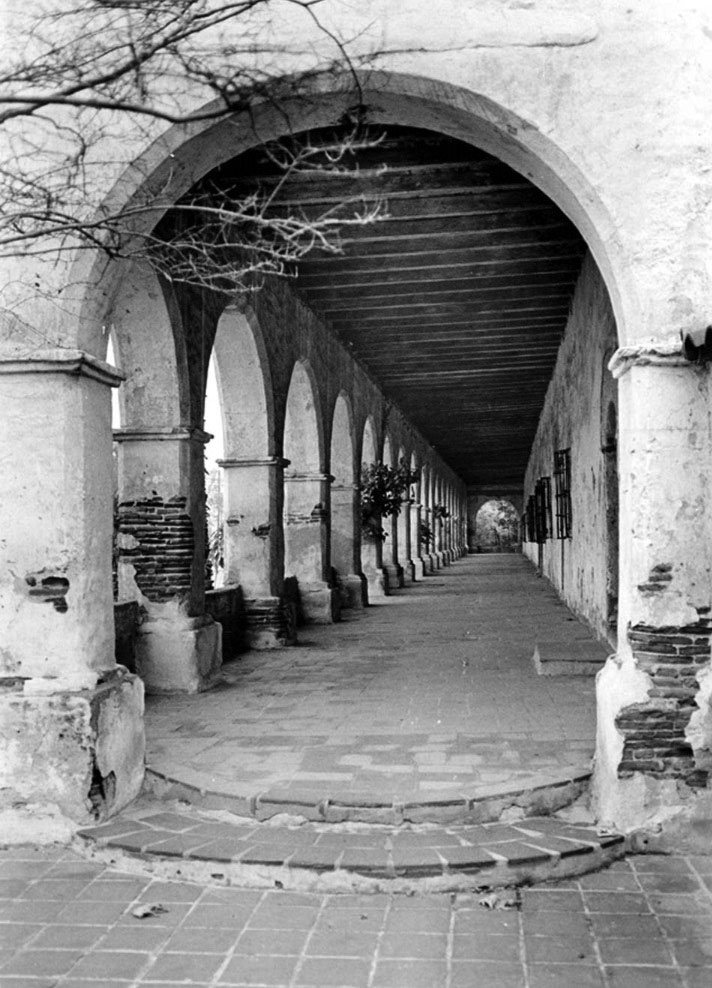 |
|
| (1897)* - The convento building at San Fernando, Rey de Espana Mission as it existed in 1897. Timber roof supports are visible. Donor: Milt Fries. |
Historical Notes The San Fernando Mission was abandoned in 1847. From 1857 to 1861, part of it was used as a stagecoach station. By 1888, the hospice was used as a warehouse and stable, and in 1896, the quadrangle became a hog farm. In 1896, Charles Fletcher Lummis began a campaign to reclaim the property, and conditions improved. Click HERE to see more in Early Views of the San Fernando Mission |
* * * * * |
Rancho Los Encinos
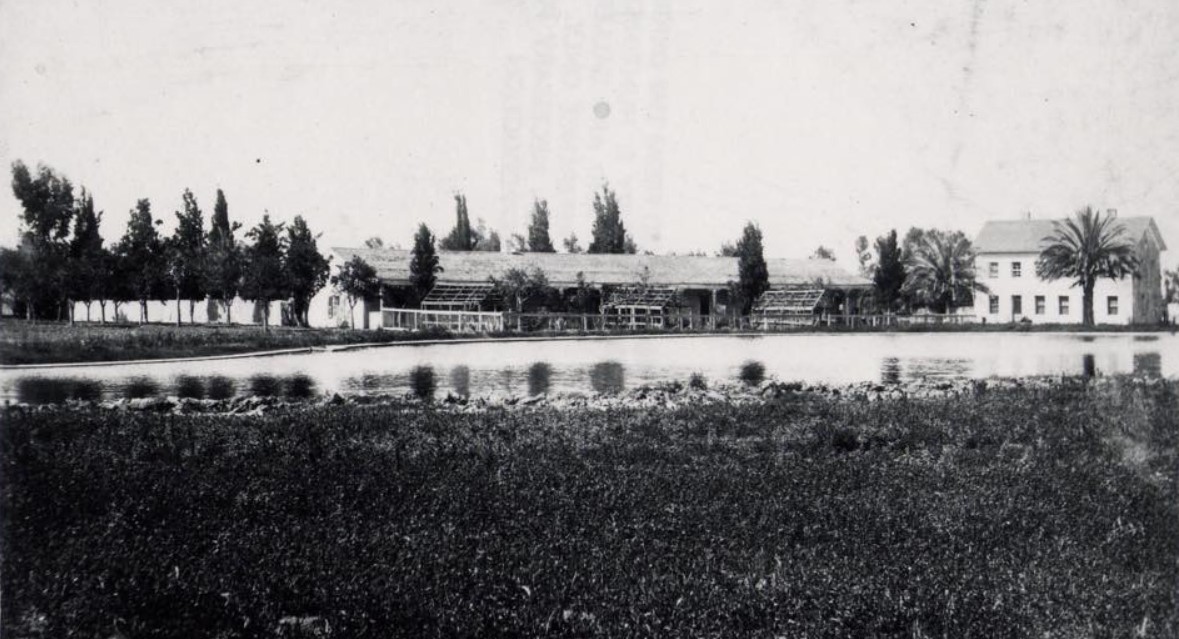 |
|
| (1880s)* - Panoramic view showing Rancho Los Encinos. This is the best surviving photograph of Rancho Los Encinos during its time of greatest prosperity. All the key elements of the current park are visible, as well as some interesting frame structures (probably used for grapevines) and a fence or structure running West from the South end of the De La Ossa adobe. |
Historical Notes Because of its water supply from a natural spring, the Franciscan padres used Encino as their headquarters while exploring the valley before establishing Mission San Fernando in 1797. In 1849 Vincente de la Osa built an adobe with nine rooms on Rancho Los Encinos. Twenty years later (1869), Eugene Garnier bought Rancho Los Encinos and, in 1872, built a French Provincial two-story limestone house adjacent to the existing adobe. He was a French Basque and the house was similar to those in his homeland.#^ The Garniers were energetic builders, and added much to the Rancho. They built a stone-lined pond, in the shape of a Spanish guitar at the site of the spring; they built a two story limestone building to serve as a bunkhouse and they built a roadhouse across the road (Ventura Blvd.) which became the focal point of the local Basque community. |
 |
|
| (1900)* - A herd of horses graze freely on land belonging to Rancho Los Encino. |
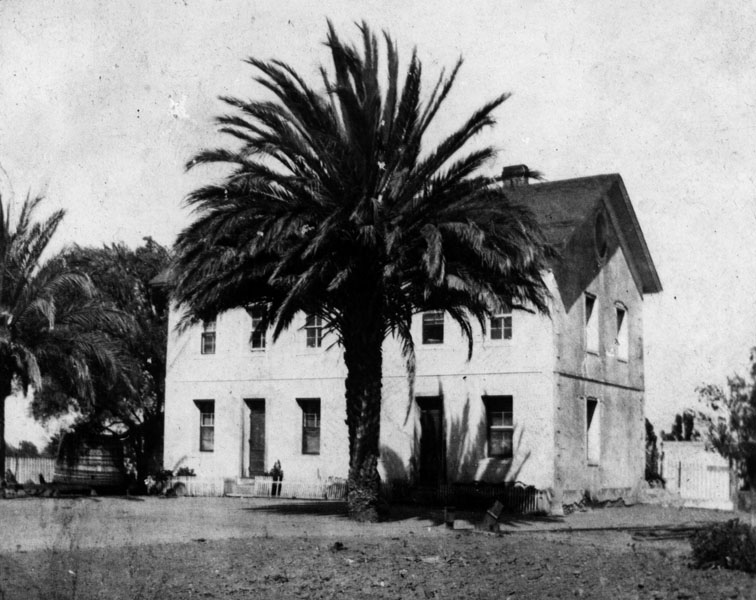 |
|
| (1900)* - Exterior view of Rancho Encino's Garnier House, built in 1872 by French Basque sheepman, Eugene Garnier. The home is a replica of his French home. |
Historical Notes In 1889 Domingo Amestoy acquired all 4,500 acres of Rancho Los Encinos. After his death in 1892, his sons, John and Peter Amestoy, assumed ranch operations and changed the name to Amestoy Ranch. Like other ranches in the San Fernando Valley at the time, the Amestoys cultivated wheat and barley. The Amestoy family held title to rancho for fifty-five years. Prior to purchasing the Rancho Los Encinos, Domingo Amestoy was a successful banker and one of the original founders to provide the financing for the Farmers and Merchants Bank in Los Angeles in 1871. Amestoy Avenue in the San Fernando Valley was named in honor of Domingo Amestoy. Louise Avenue was named after Louise Amestoy, a daughter of Domningo and Marie Amestoy. Click HERE to see more SFV Street Name Origins. |
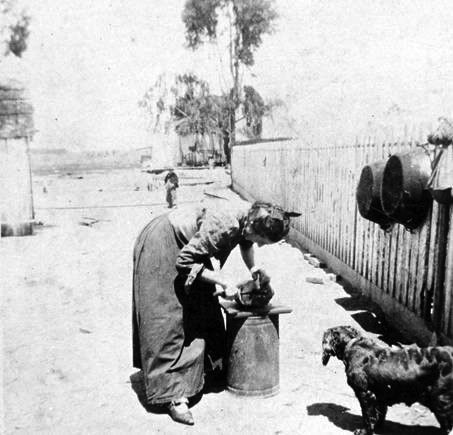 |
(ca. 1906)* - Margarite Larre Amestoy (Mrs. Peter Amestoy) working on Rancho Los Encinos (aka Amestoy Ranch). |
|
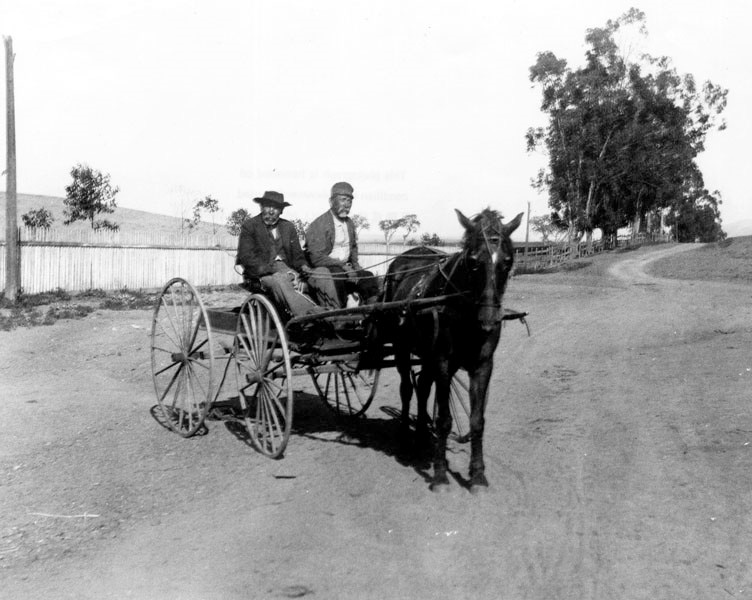 |
|
| (1906)* - Two Native American workers sit in a horse-drawn carriage on Rancho Encino, the Amestoy family property located on Ventura Boulevard, in Encino. From L-R: Sanese and Napoleon. |
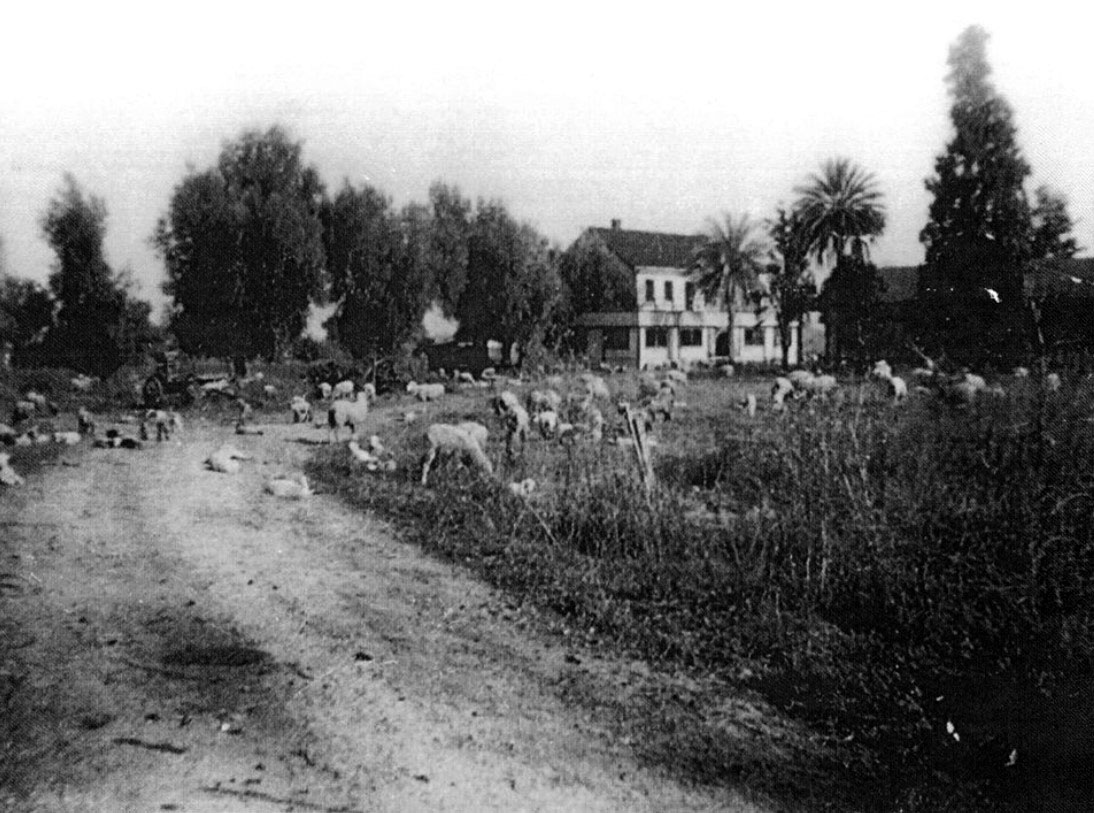 |
|
| (1920s)* - View showing sheep grazing near the Garnier House. |
Historical Notes In 1916, 1,170 acres of land was sold from Rancho Los Encinos. This parcel was subdivided and became the city of Encino. The Amestoys held on to 100 acres, which included the old adobe until selling the property in 1944. |
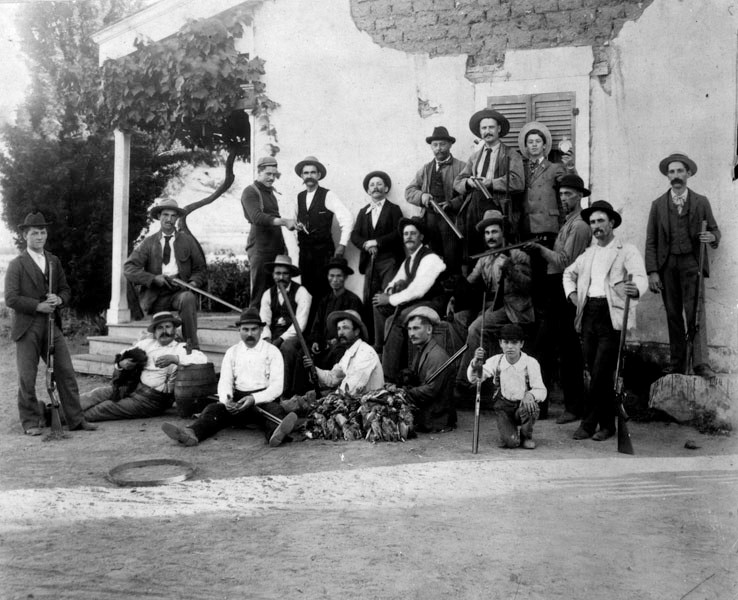 |
|
| (Early 1900s)* - Chow Time on the Amestoy Ranch. A shot of the family returning from a hunting trip. The North side of the de la Ossa adobe is in the background. Note the gun being pointed at the Chinese cook. Back row, against wall: Mike Amestoy |
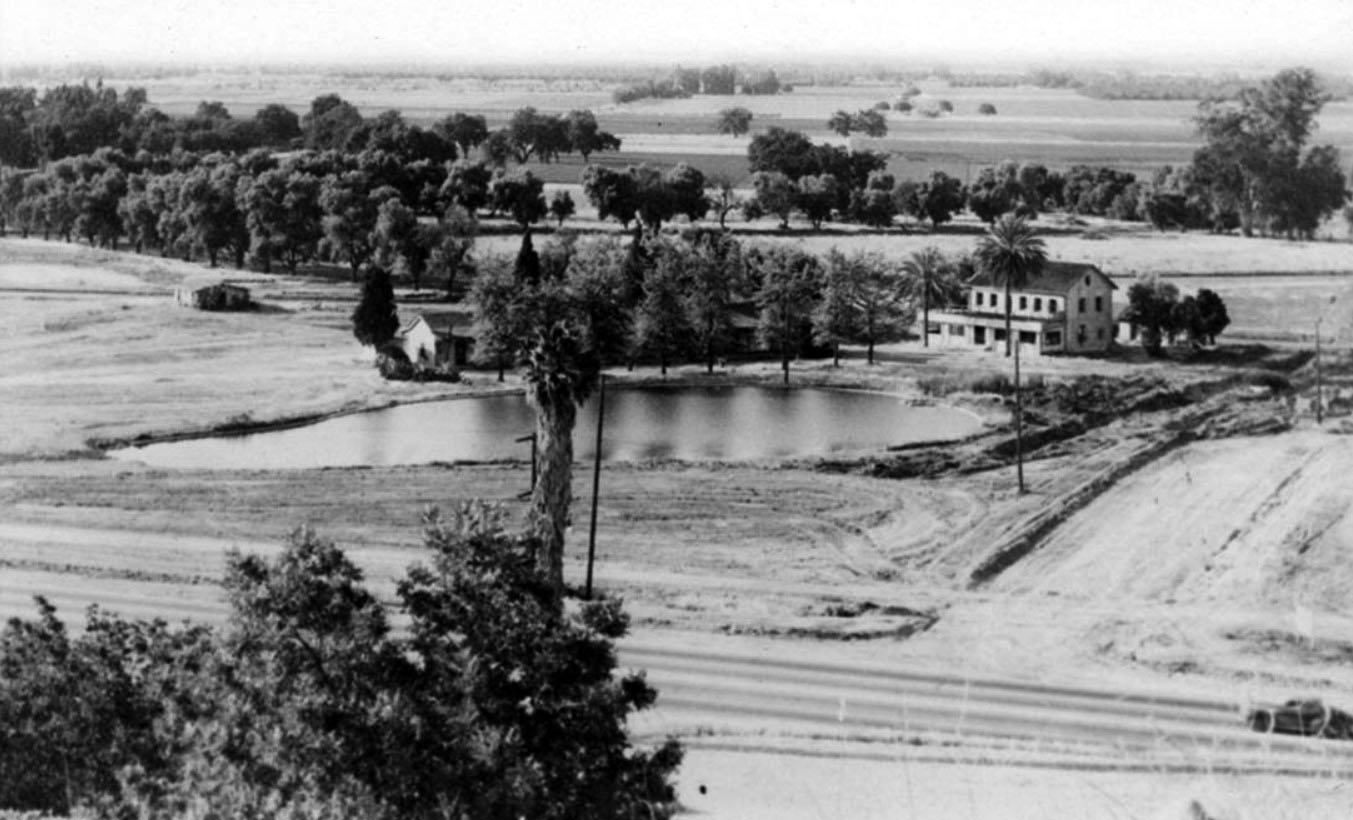 |
|
| (ca. 1940)* - View looking north showing Rancho Los Encinos. The Garnier House and original adobe sit on the other side the large stone-lined pond. Ventura Boulevard can be seen in the foreground with what looks to be an early model pickup truck at lower right. Note the vast open space in the distance. |
Historical Notes The name of the rancho comes from the original designation of the San Fernando Valley by the Portola expedition of 1769: "El Valle de Santa Catalina de Bononia de los Encinos", with "encino" being the Spanish word for oak, referring to the many oak trees in this area, to include a fair number which still exist on the site. |
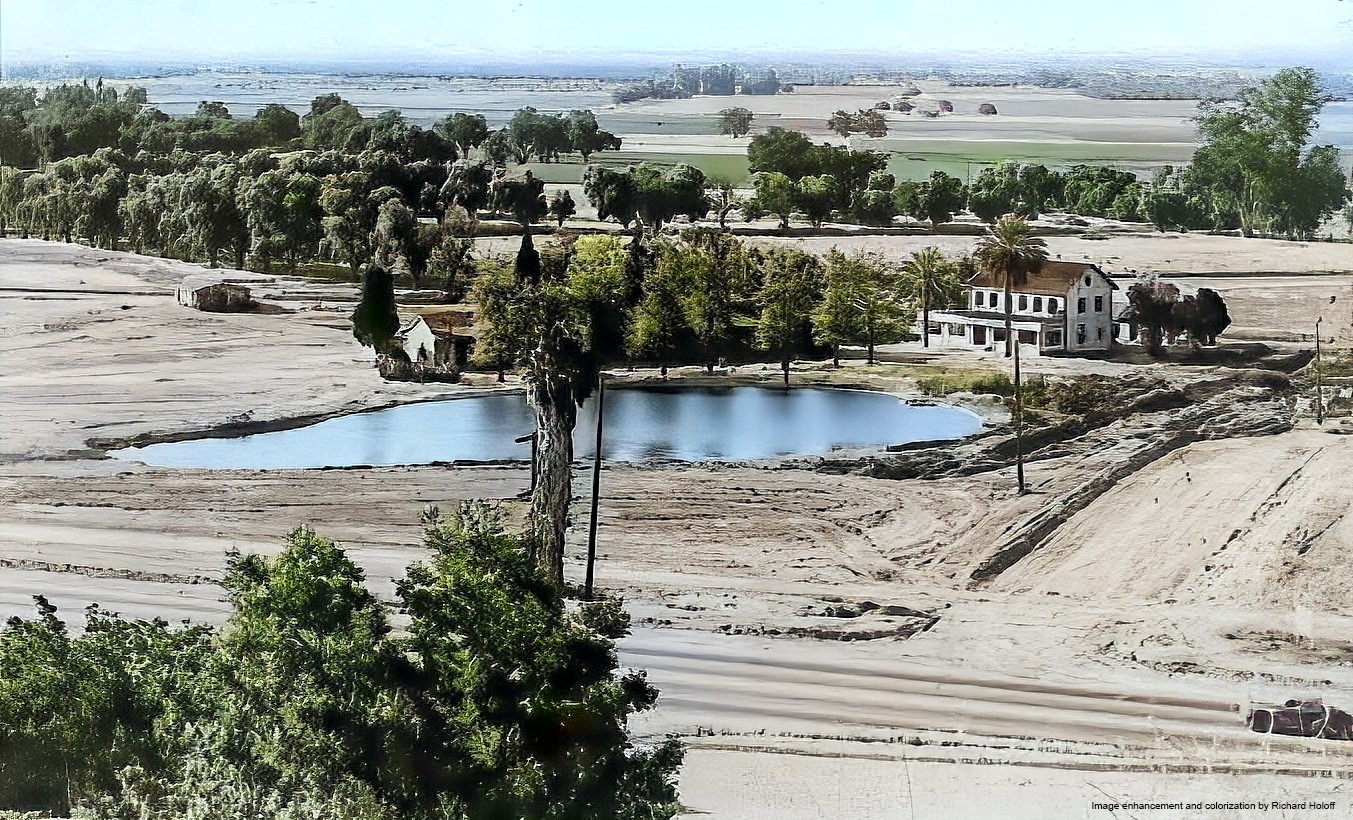 |
|
| (ca. 1940)* - View looking north showing Rancho Los Encinos. The Garnier House and original adobe sit on the other side the large stone-lined pond. Ventura Boulevard can be seen in the foreground with what looks to be an early model pickup truck at lower right. Note the vast open space in the distance. Image enhancement and colorization by Richard Holoff |
Then and Now
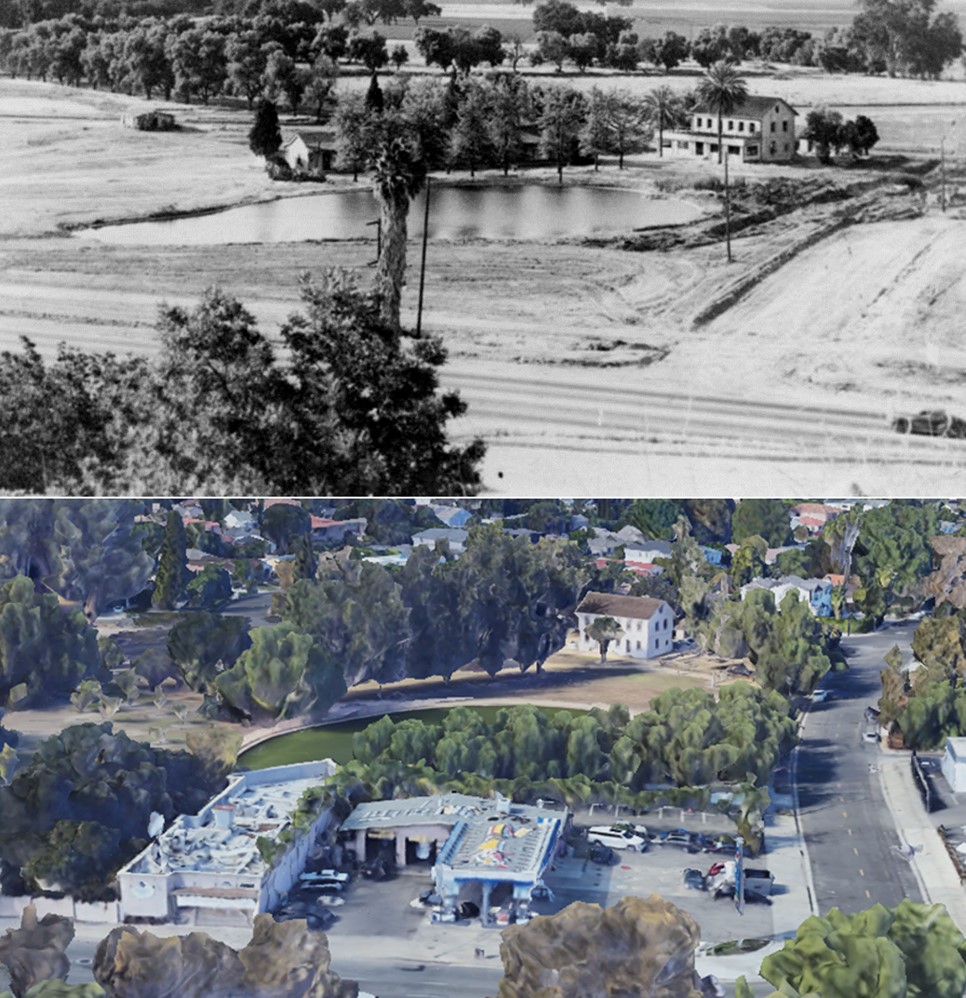 |
|
| (1940 vs 2022)* – Looking down toward the Los Encinos State Historic Park with the intersection of Ventura Boulevard and La Maida Street seen in lower right. Photo comparison by Jack Feldman. |
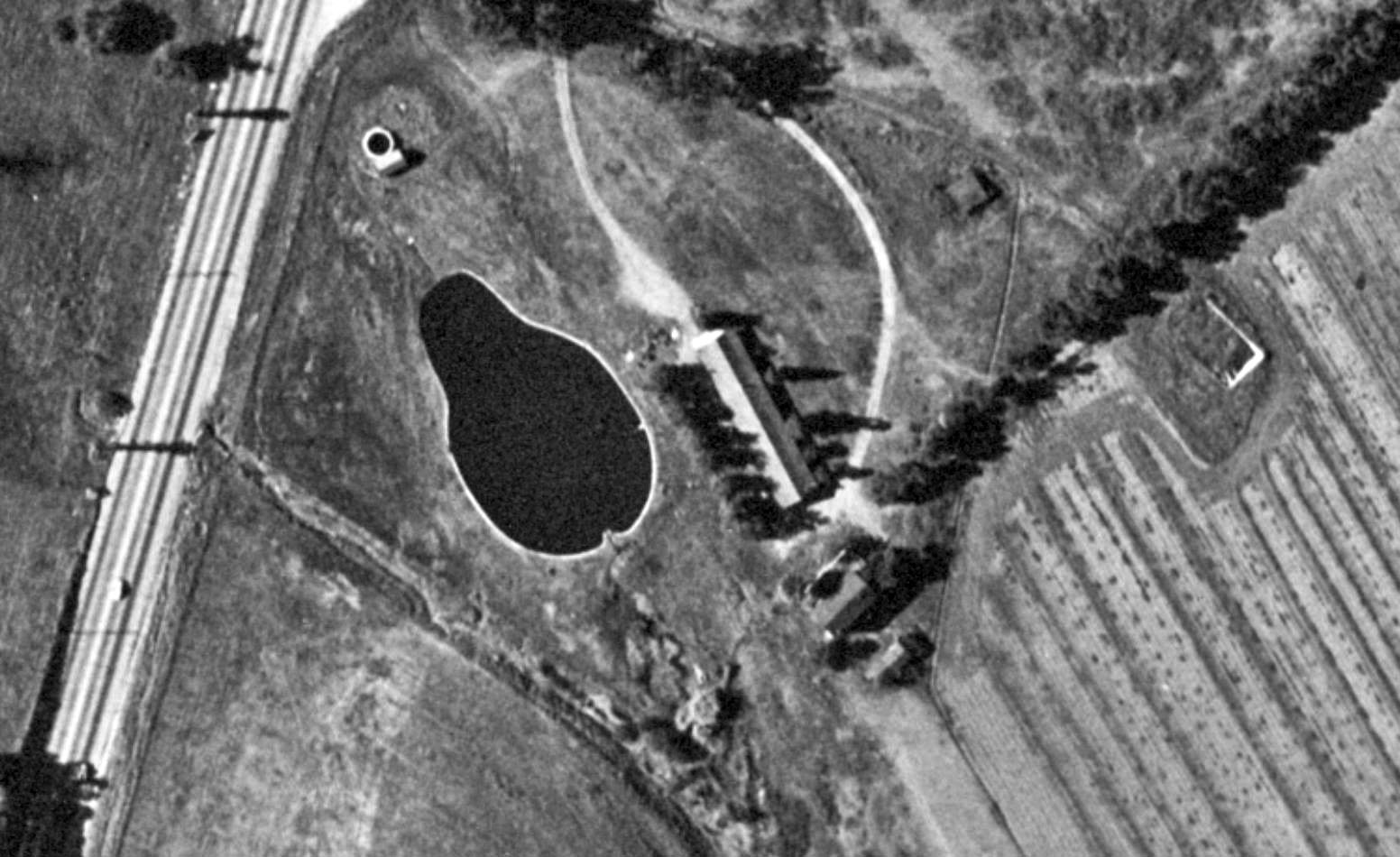 |
|
| (1944)* - Aerial view showing Rancho Los Encinos with Ventura Boulevard seen on the left. |
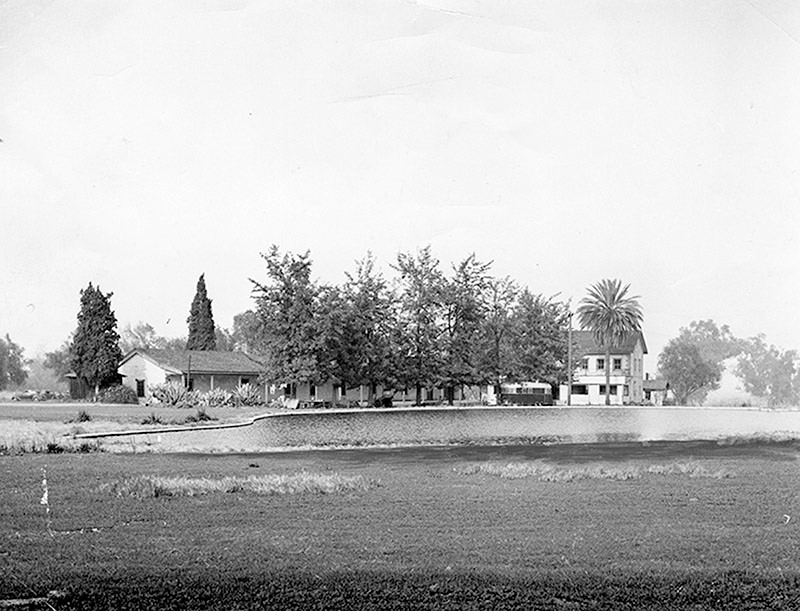 |
|
| (1949)* - View showing the old adobe ranch house at Rancho Amestoy (left), the limestone Garnier House (right), and the lake in the foreground. |
Historical Notes In 1949, through the efforts of Mary Stuart in mobilizing the local community to save the buildings from developers, the last remaining parcel of land, containing the De La Osa adobe, Garnier House and spring were purchased by the State of California, and the Los Encinos State Historic Park was created. |
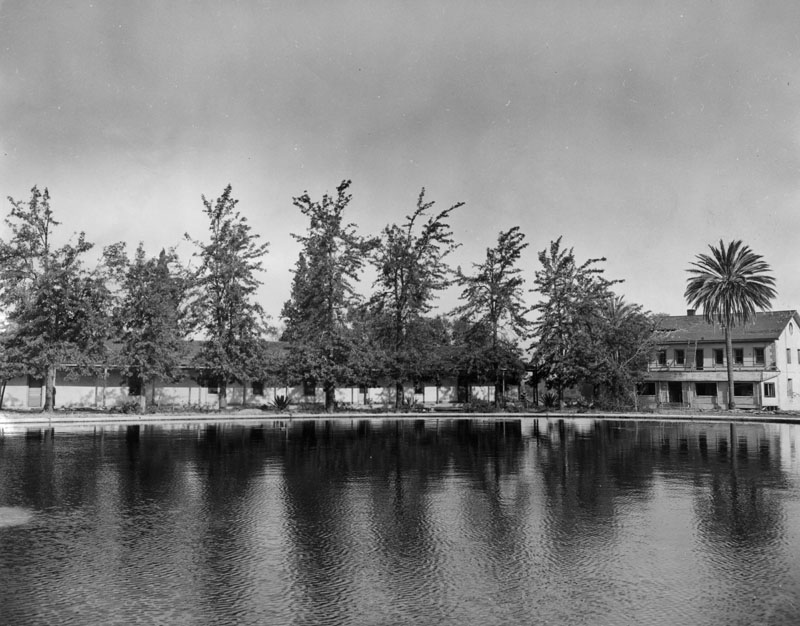 |
|
| (1949) - View showing Rancho Los Encinos the year it became Los Encinos State Historic Park. |
Historical Notes Los Encinos State Park is listed on the National Register of Historic Places: NPS-71000142 and has also been designated as California Historical Landmark No. 689 (Click HERE to see complete listing). |
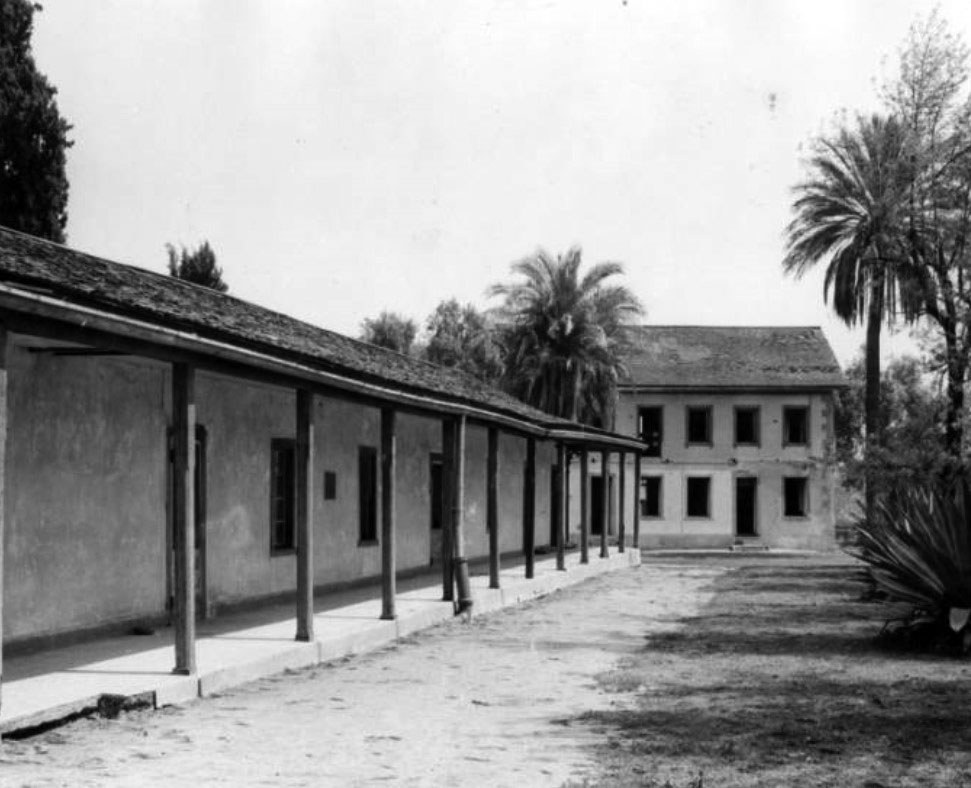 |
|
| (1957)* – Photo caption reads "Two buildings still remain. One-story structure, foreground, known as Osa Adobe, was built in 1849-1850. It serves as park ranger's office and living quarters. It used to be ranch house. In background is the Garnier Building, built in 1873, for ranch hands." |
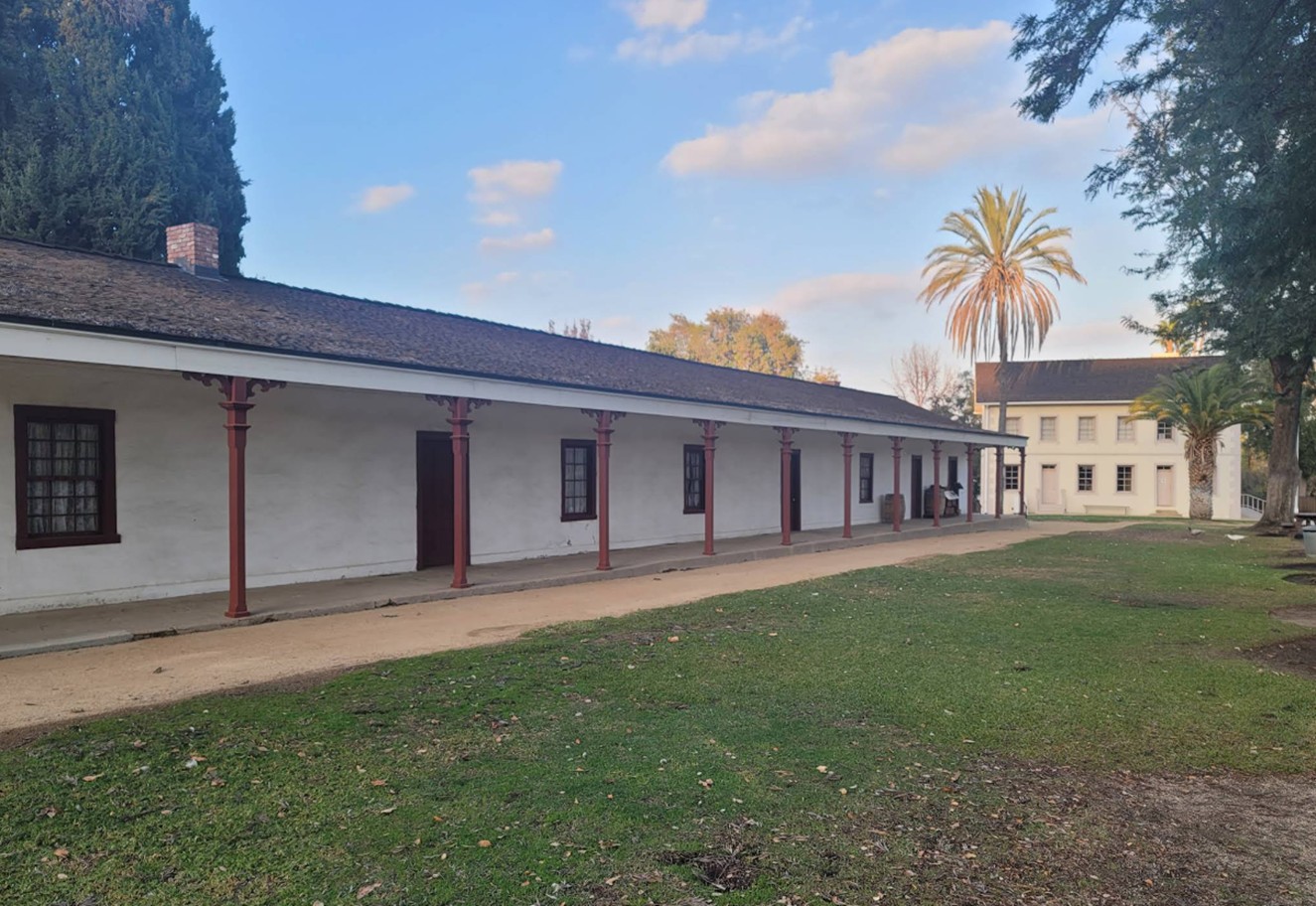 |
|
| (2022)* - Contemporary view showing the Osa Adobe and Garnier Building. |
Historical Notes Today, a Visitors' Center is located in the Garnier Building and is open for self-guided tours. The park is opened Wednesday through Sunday between 10 AM and 5 PM. Click HERE to see more. |
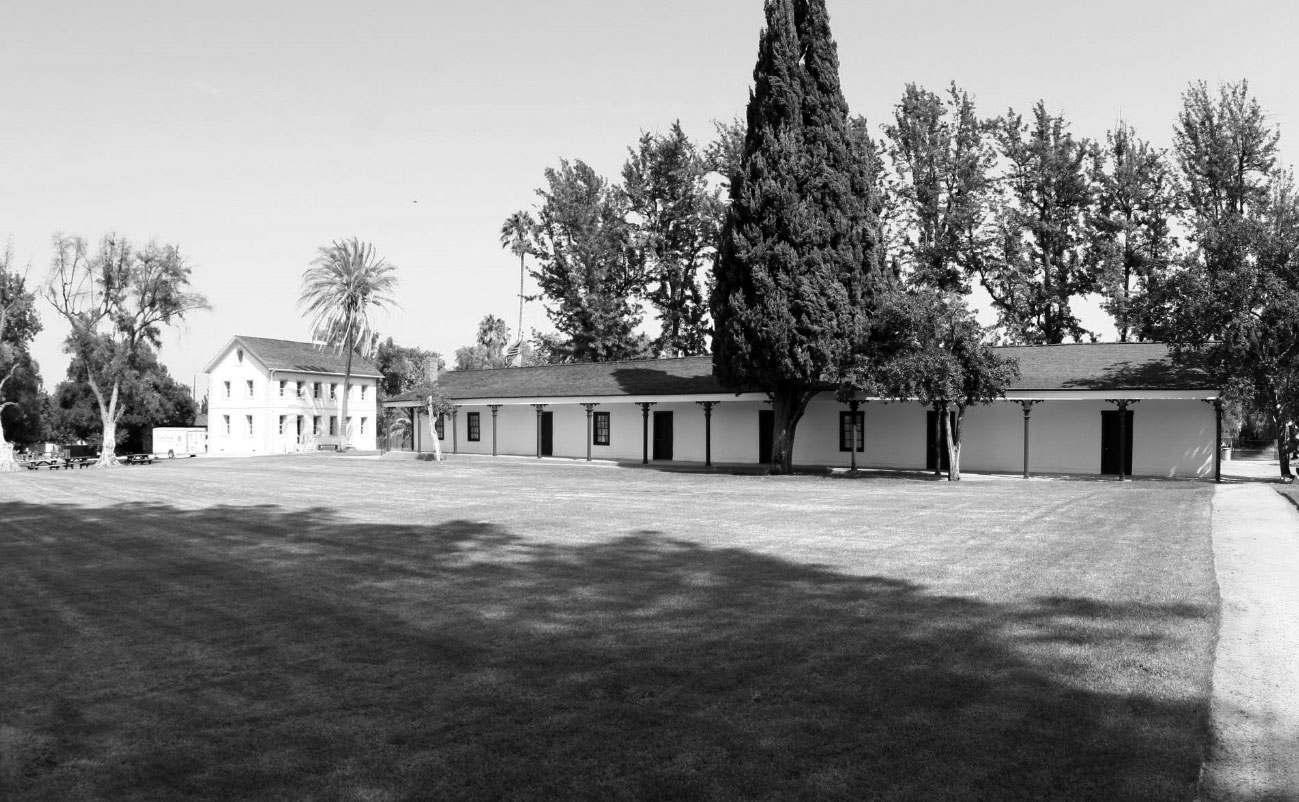 |
|
| (2014) – View of Los Encinos State Park with the Garnier Building on the left and the Rancho Encino adobe at center. The lake is on the other side of the adobe. Location: 16756 Moorpark Street, Encino. Google Street View. |
Historical Notes Click HERE for more contemporary views of Los Encinos State Park. |
* * * * * |
Monte Vista Hotel
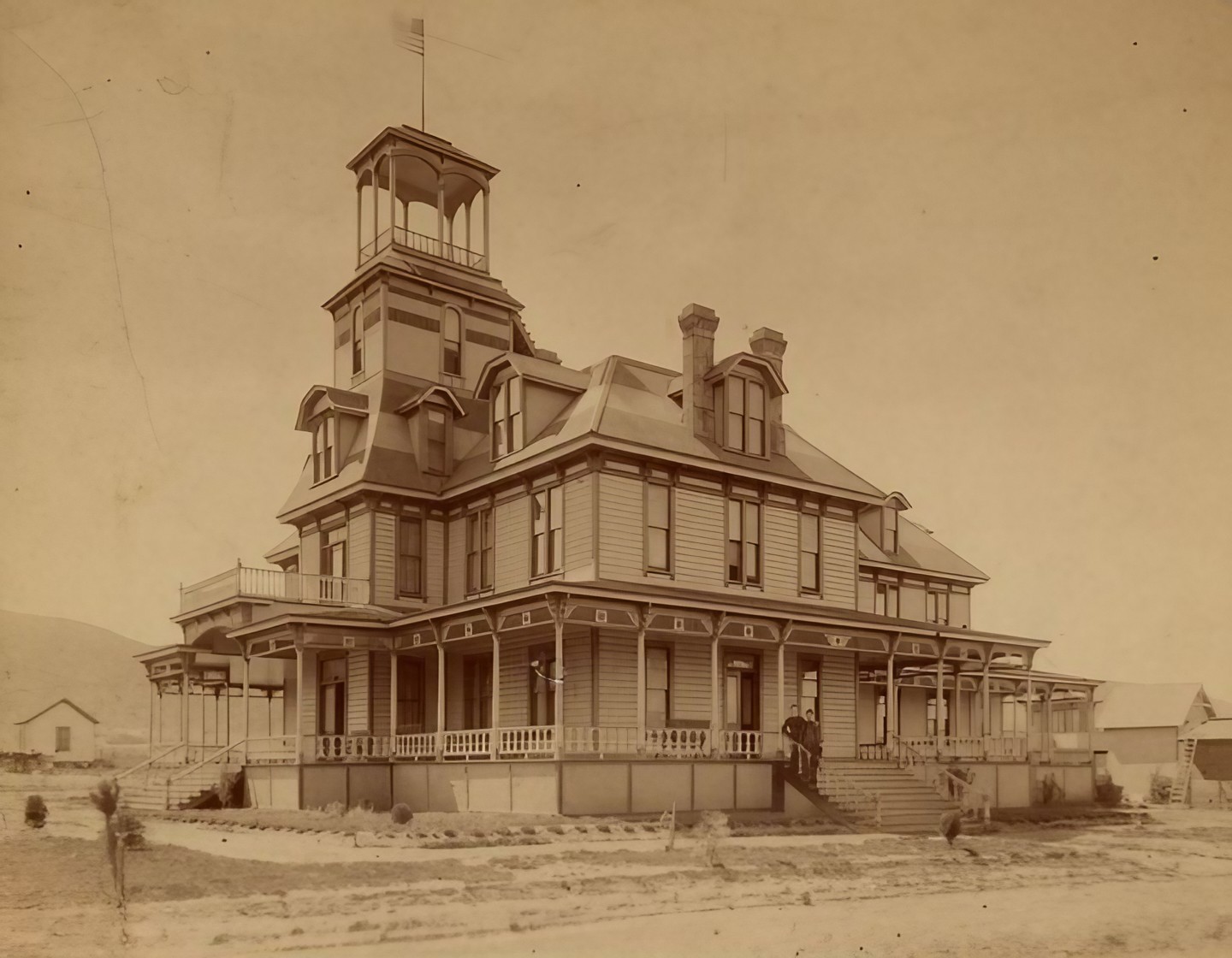 |
|
| (ca. 1886)* - View of the Monte Vista Hotel located at present-day Fenwick Street and Floralita Avenue in Sunland (then known as Monte Vista), nestled in the San Gabriel foothills just northeast of the San Fernando Valley. |
Historical Notes Built in 1886, the Monte Vista Hotel was the first major structure in the growing mountain community of Monte Vista. Designed as an upscale rural resort, it offered guests a peaceful retreat in the clean air of the foothills above the valley. The hotel featured a formal lobby, dining room, and private bedrooms—each with its own fireplace. Fine furnishings and artwork were imported from abroad, and meals were prepared by a French chef. One early ad claimed: “The best cooking, the best furnished house, and better attention than at any hotel in the state.” Wealthy visitors, health seekers, and sportsmen stayed here, drawn by the mountain scenery and game-rich wilderness. The hotel also helped promote land sales and development in the area during the Southern California land boom of the 1880s. |
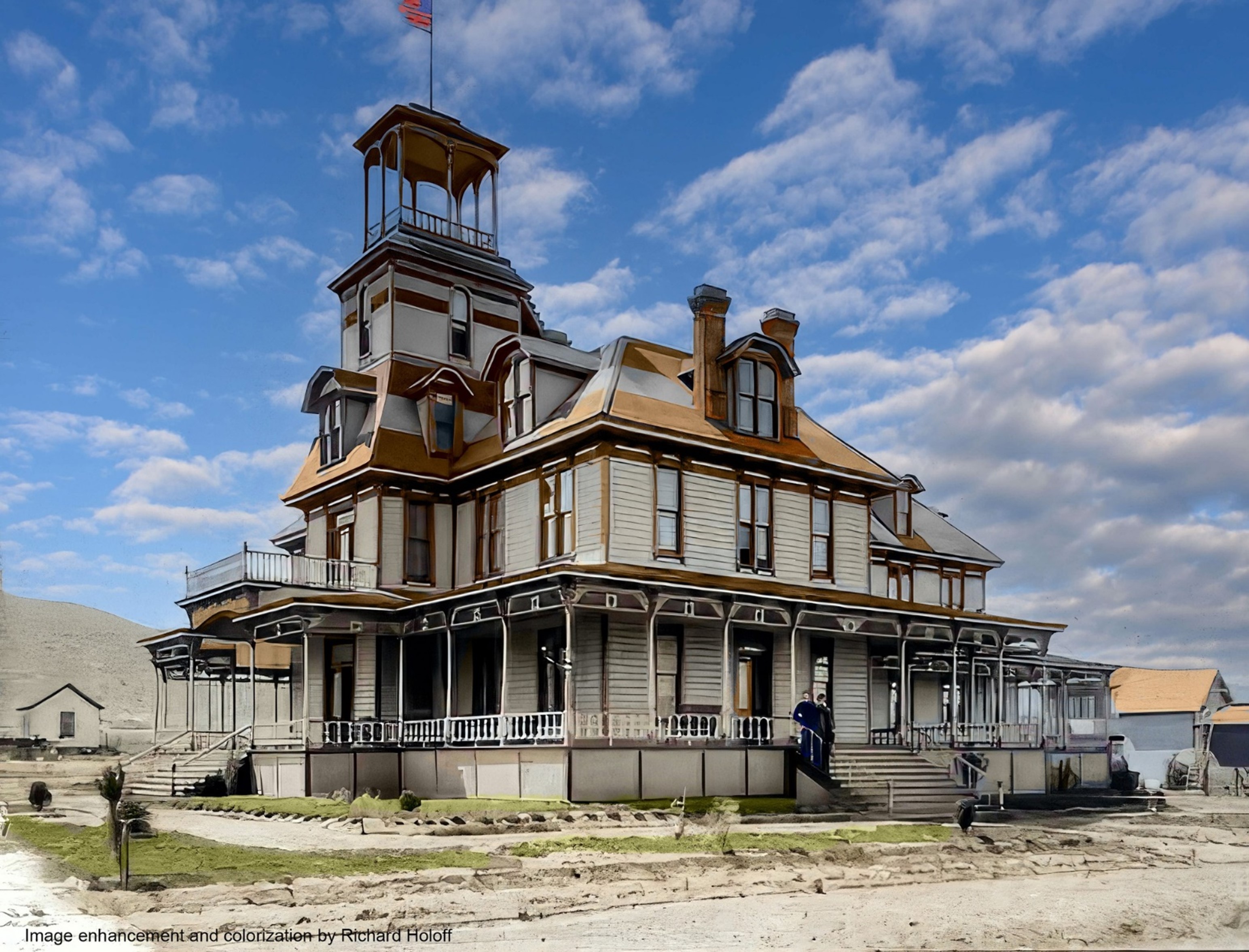 |
|
| (ca. 1886)* - Colorized view of the Monte Vista Hotel at Fenwick Street and Floralita Avenue in Sunland (then Monte Vista). Image enhancement and colorization by Richard Holoff |
Historical Notes This enhanced image brings out the rich architectural details of the Monte Vista Hotel. Its central tower, wrap-around porch, and steep gabled roofs reflect the popular Queen Anne style of the late 19th century. At a time when most of the San Fernando Valley was still open farmland or ranch land, the hotel stood out as a refined mountain lodge in the nearby foothills. It served as both a destination for city dwellers and a symbol of early development in the remote community of Monte Vista—later renamed Sunland. |
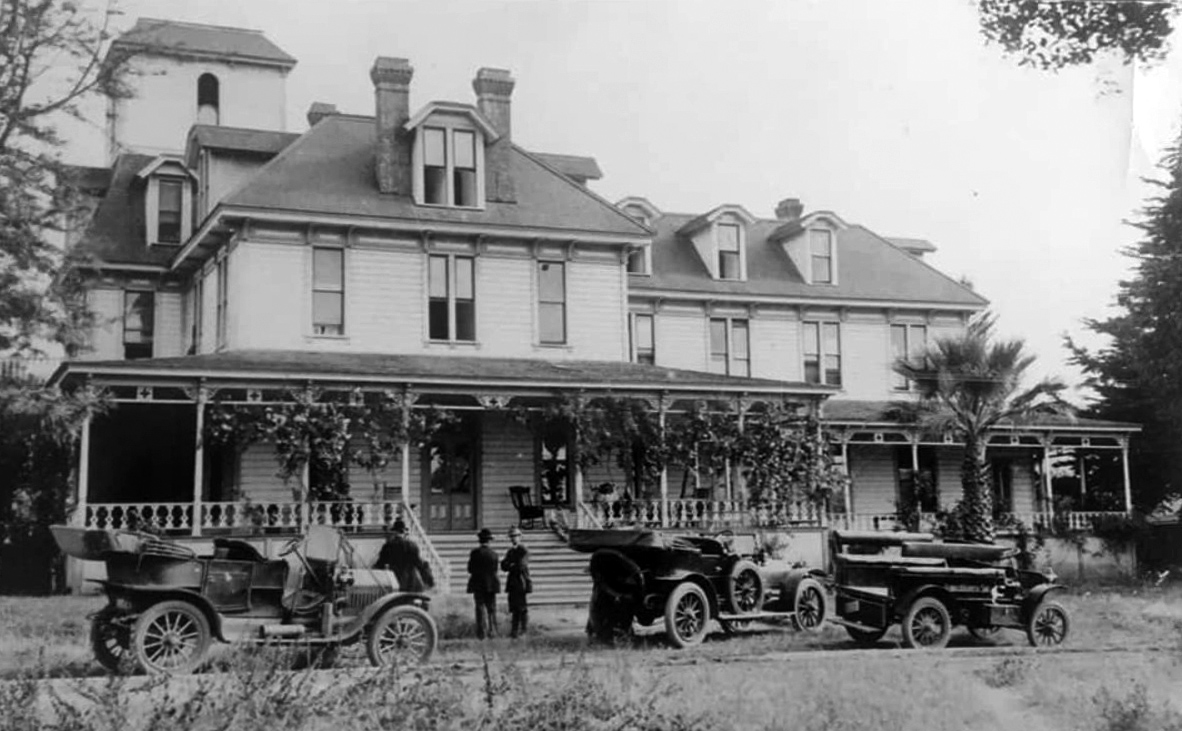 |
|
| (1920)* - A group of men stand beside their early automobiles in front of the Monte Vista Tavern in Sunland. |
Historical Notes By the 1910s, the Monte Vista Hotel had been renamed the Monte Vista Tavern. As the area evolved, the building shifted from a luxury resort to a boarding house, and later became a retirement home called Cypress Manor. The home closed in 1959, and the building was abandoned in 1961. It fell into disrepair, and in 1964, the City of Los Angeles ordered it demolished. Though the building is gone, it remains a key part of Sunland’s early story—marking the transformation of a remote foothill outpost into a residential neighborhood. |
* * * * * |
Early Map of the San Fernando Valley
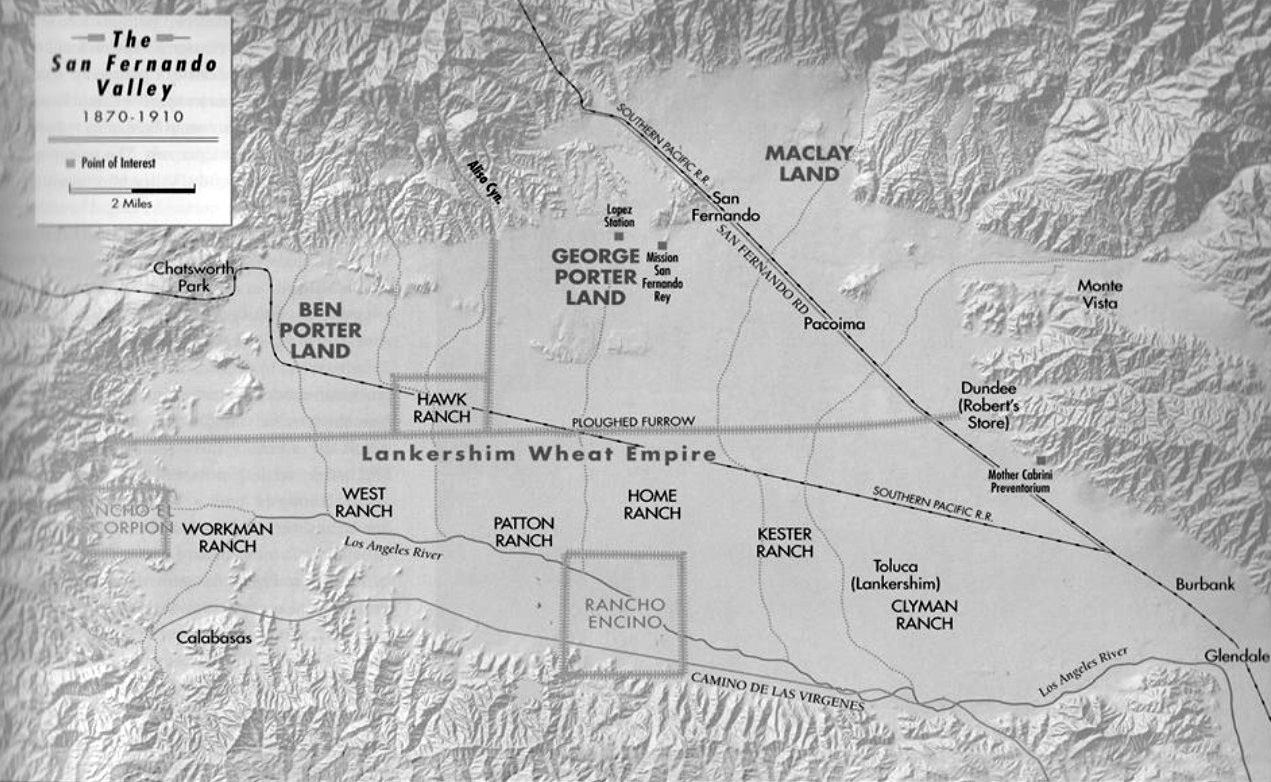 |
|
| (1870–1910)* – Early map of the San Fernando Valley showing locations of towns and ranches. The dividing line between northern and southern properties was what is now Roscoe Boulevard (marked "ploughed furrow" on the map). |
Historical Notes The San Fernando Valley was largely divided between the Lankershim ranches and the Maclay-Porter lands. Towns appeared after 1873, among them San Fernando, Burbank and Toluca. The Valley was initially divided into large Mexican land grants or ranchos after the Spanish mission era, including Rancho Ex-Mission San Fernando, Rancho El Escorpión, and Rancho Encino. In 1874, Charles Maclay and George K. Porter purchased large portions of the northern Valley from the Rancho Ex-Mission San Fernando. Porter and his partners, including Benjamin F. Porter, began ranching operations on these lands. Simultaneously, the southern half of the Valley was owned by the San Fernando Homestead Association, founded by Isaac Van Nuys and J.B. Lankershim who introduced dry wheat farming to the area. Their lands became known as the Lankershim Ranch. After this division of the Valley into the Maclay-Porter and Lankershim lands in the 1870s, towns began to emerge, including: San Fernando (established 1874 by Maclay) Burbank (originally part of the Rancho Providencia and Rancho Cahuenga lands) Toluca (likely referring to the Toluca Lake area, originally part of the Lankershim |
* * * * * |
San Fernando
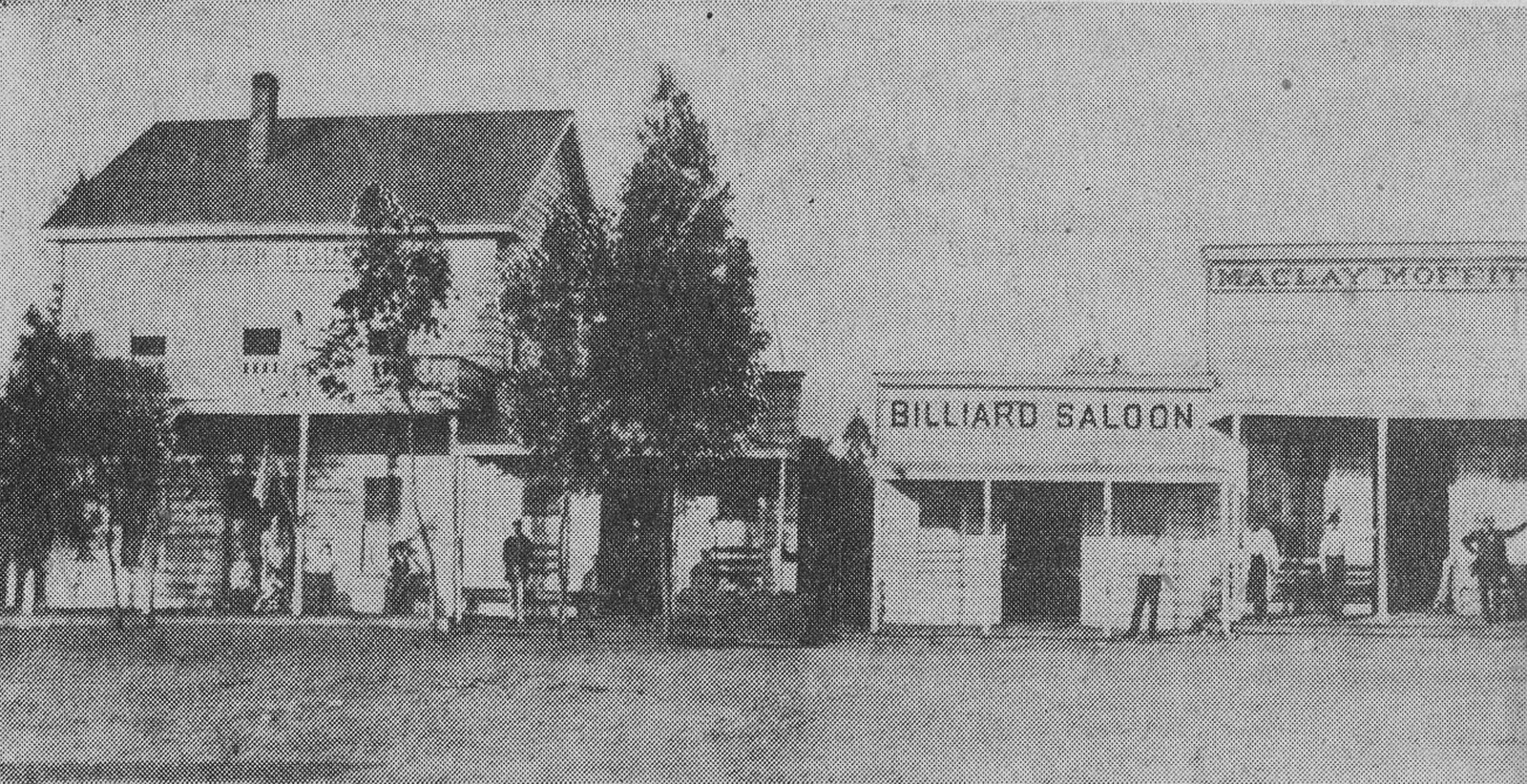 |
|
| (1882)* - Newspaper photo of San Fernando Road near the corner of Maclay. The Porter House was a hotel and dining establishment. Next to it was a billiard parlor and saloon, and the clapboard covered Maclay Moffitt store. |
Historical Notes In 1874, Charles Maclay bought 56,000 acres of the Rancho Ex-Mission San Fernando land grant including the northern half of the San Fernando Valley. In 1882, cousins George K. Porter and Benjamin F. Porter, owner of future Porter Ranch, each received one-third of the total land. A. B. Moffitt was co-partner with Charles Maclay in the store seen above. He was also the town’s coroner. |
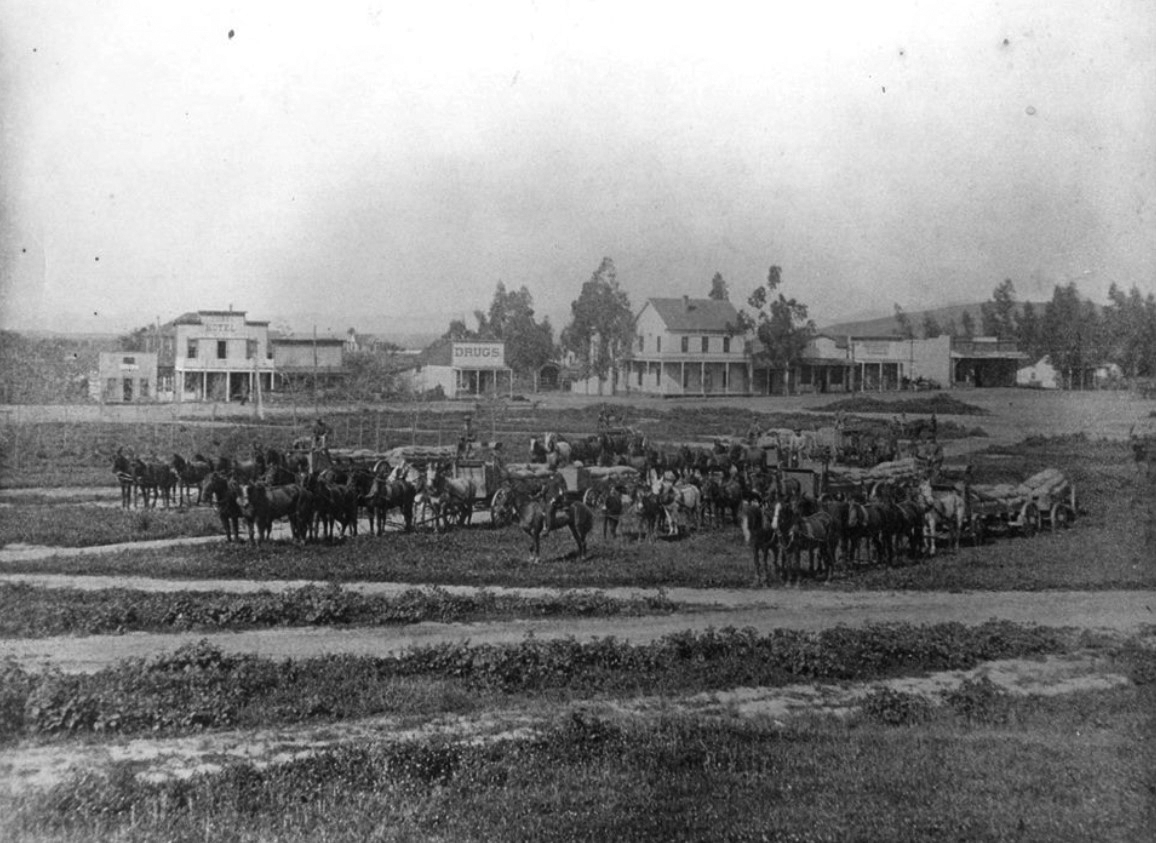 |
|
| (ca. 1880s)* – View showing a horseback rider posing in front of a half dozen teams of horses pulling crop-filled wagons, with the town of San Fernando seen in the background. |
Historical Notes San Fernando, the oldest city in the valley for which it is named, is located about twenty three miles north of Los Angeles, near the foothills of the San Gabriel Mountains. Founded in 1874, it is nicknamed "The Mission City" because of its proximity to the San Fernando Mission that was established in 1797 and on whose former property the city emerged. The city's founding in 1874 was spurred by a land boom in Southern California and the Southern Pacific Railroad's building of a rail line between Bakersfield and Los Angeles through Fremont Pass. Soon populated with an influx of settlers, San Fernando became known as the railroad's "gateway to the north," and with its Mediterranean climate and deep wells that provided water for irrigation, the community cultivated an abundance of vegetables and fruits, especially citrus and olives. |
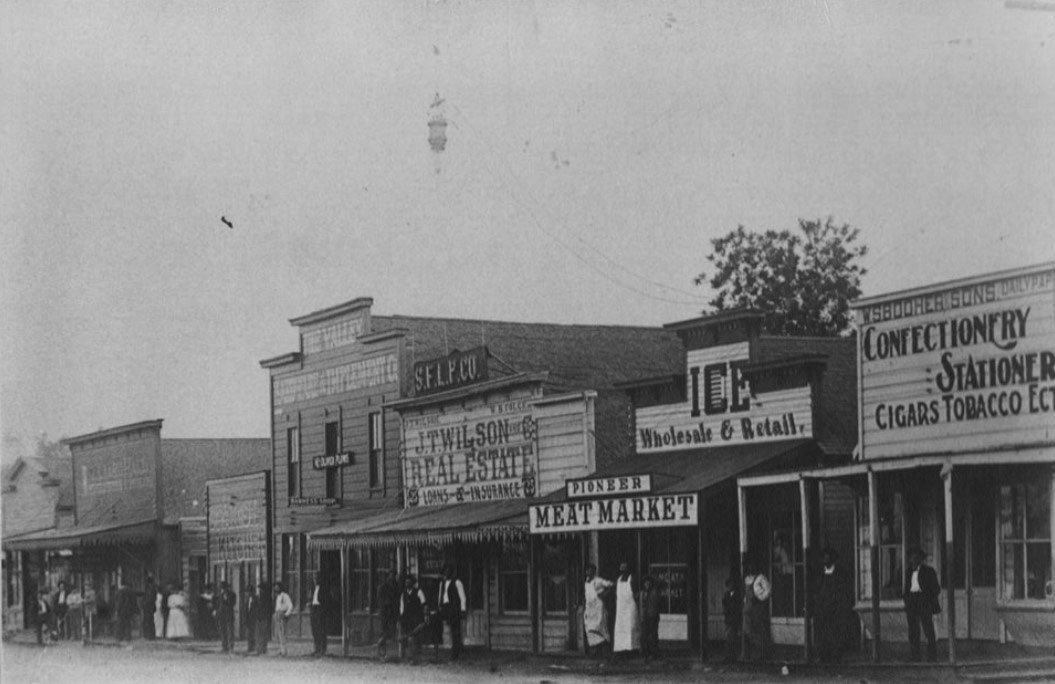 |
|
| (1910)* – Photo caption reads: “San Fernando on a busy day”. McClay at San Fernando Road, April 14, 1910. Taken by A.F. La Gier |
Historical Notes Because of its independent water supply, San Fernando remained autonomous and incorporated in 1911, while most of the valley's other communities felt compelled to annex to Los Angeles in 1915 to avail themselves of the waters of the Los Angeles Aqueduct, which started flowing in 1913. |
Then and Now
 |
|
| (1910 vs. 2014)* - View showing San Fernando Road at McClay. |
* * * * * |
Maclay School of Theology
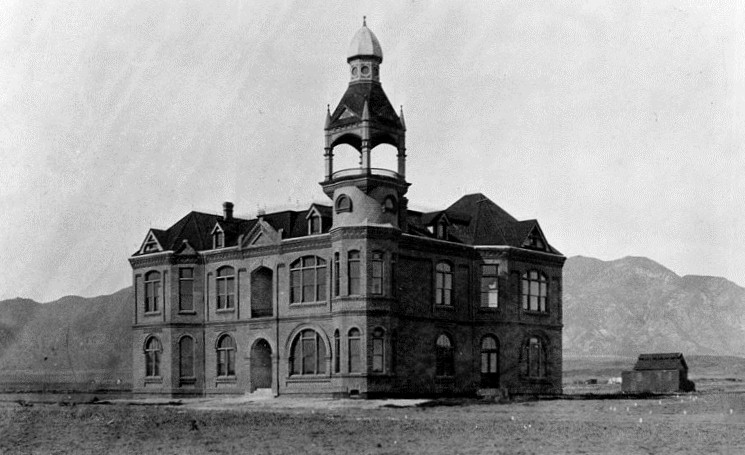 |
|
| (ca. 1887)* - View showing the Maclay School of Theology, a Methodist seminary founded by Charles Maclay, a Methodist minister, in 1885. He is the founder of the city of San Fernando. The school sat on ten acres on the north side of Pacoima Creek with the building designed by the prominent Los Angeles architectural firm of Kysor and Morgan. |
Historical Notes In 1885, Maclay founded the Maclay School of Theology, a Methodist seminary in his newly founded town of San Fernando. After his death it became an affiliate and moved to the campus of the University of Southern California before becoming the Claremont School of Theology in 1957. Click HERE to see Early Views of U.S.C. Charles Maclay's heritage was from Ireland and Scotland. He was the brother of Robert Samuel Maclay, a pioneer missionary to China; and the uncle of Robert Maclay Widney, a founder of the University of Southern California, and of Joseph Widney, the second president of the University of Southern California. Maclay was a Methodist minister. Charles Maclay became a California State Assemblyman in the 7th District from Santa Clara County and later a California State Senator. Additional Note: San Fernando Mission Boulevard was originally called Stanford Avenue, after the former Gov. Leland Stanford who loaned the money for Charles Maclay to purchase the land to found San Fernando. |
Porter Hotel (aka Mission Hotel)
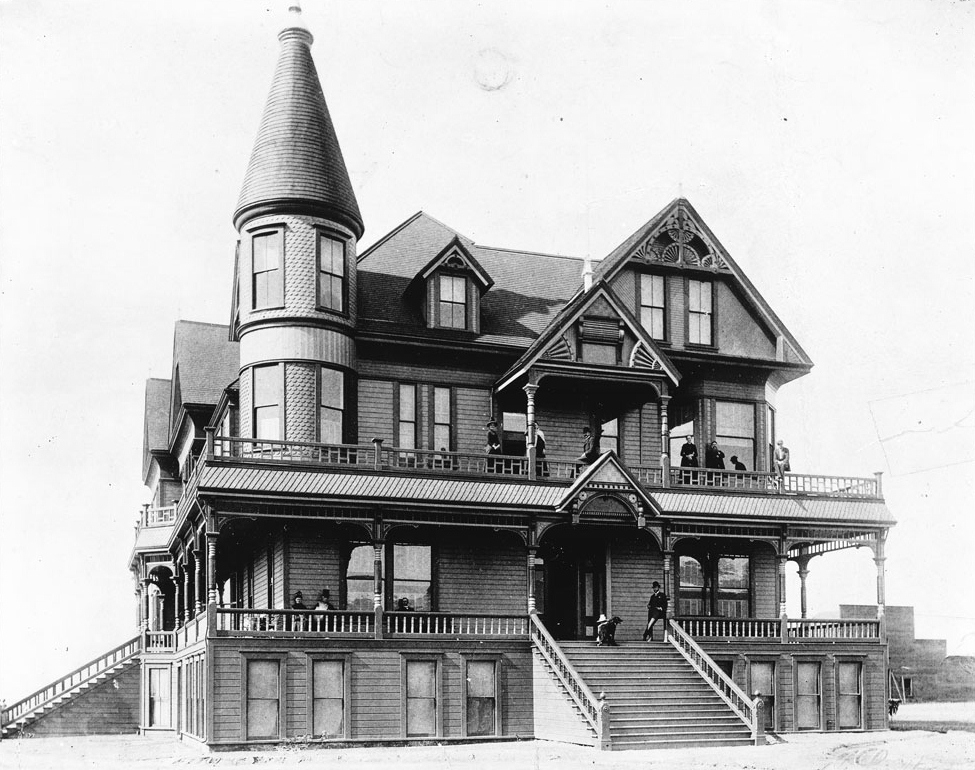 |
|
| (ca. 1888)* - The Porter Hotel (aka Mission Hotel) located in San Fernando. The three and a half-story, Victorian-style hotel is shown with people posing on its porch and balcony. On the second floor a man can be seen leaning against one of the beams which support the overhang near the hotel's entrance. A dog is visible near him at the top of the front steps that lead to the second floor and the subsequent entrance. On the second floor to the left, a two-story tower extends from the hotel, decorated in gingerbread clapboard. |
Historical Notes In the late 1800s the City of San Fernando, as well as the entire San Fernando Valley, saw a significant land boom A major hotel was built near the modern intersections of Laurel Canyon Boulevard and South Brand Street. The hotel was built in 1887 by the Porter Land and Water Company on a knoll about a mile from the center of San Fernando. It served as a hotel for about a year, and later, as a summer residence for the Porter family, 1890.* George Keating Porter came to California in the 1850s from New Hampshire and served as a state senator for Santa Cruz. Initially the Porters, George and cousin Benjamin, engaged in dry land wheat farming. In 1881, they split their holdings with a coin toss. George won and opted for the area between present-day Sepulveda Boulevard and Aliso Canyon. Benjamin F. Porter’s land became Chatsworth and Porter Ranch. George Porter subdivided his land and established the Porter Land and Water Company. In 1887, Porter developed extensive irrigation systems and began experimenting with a variety of different citrus crops. He planted an area 1 mile wide and 3 miles long, which became known as the Long Orchard. Click HERE to see more Early Views of the City of San Fernando. |
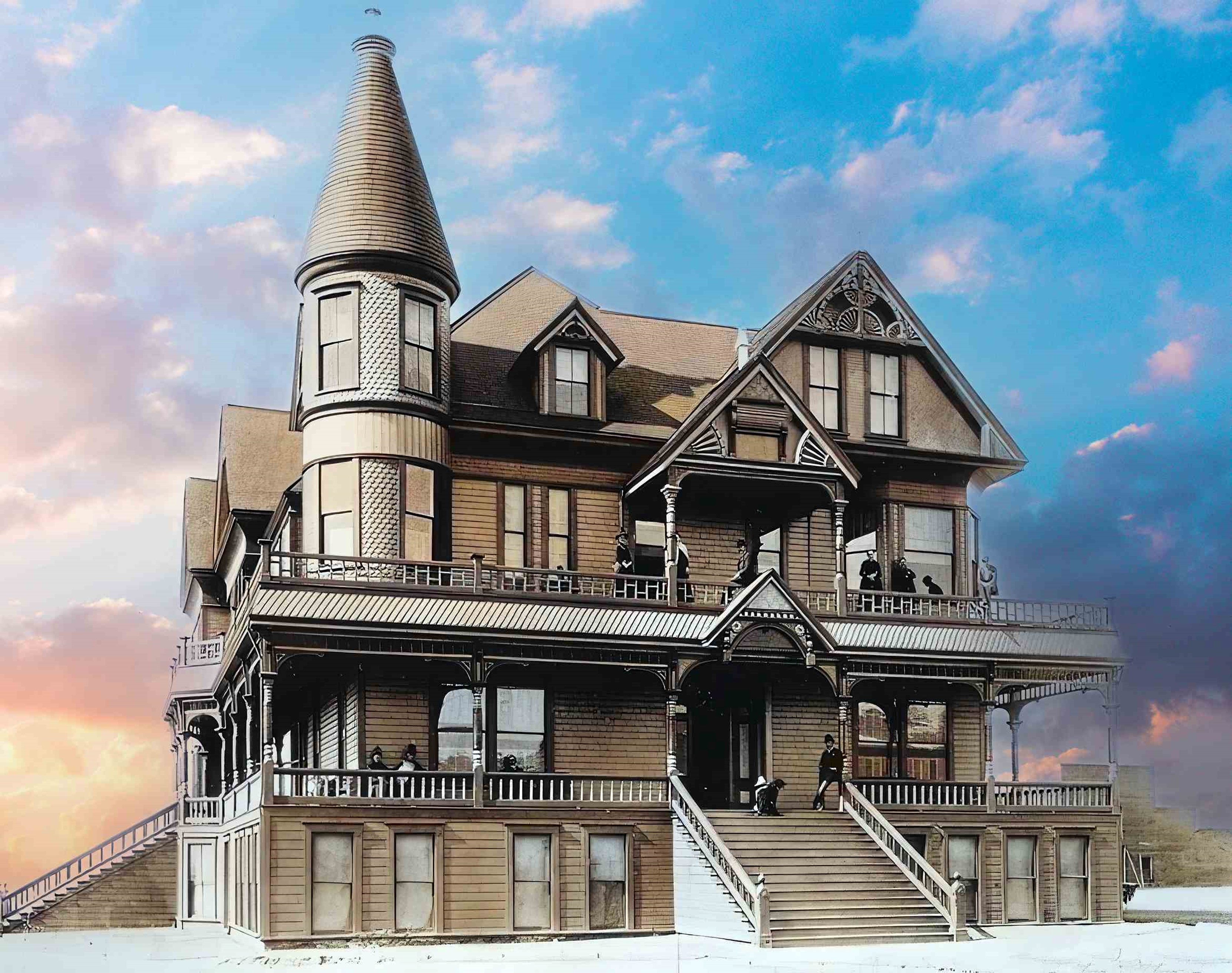 |
|
| (ca. 1888)* - The Porter Hotel (aka Mission Hotel) located in San Fernando. The three and a half-story, Victorian-style hotel is shown with people posing on its porch and balcony. On the second floor a man can be seen leaning against one of the beams which support the overhang near the hotel's entrance. A dog is visible near him at the top of the front steps that lead to the second floor and the subsequent entrance. On the second floor to the left, a two-story tower extends from the hotel, decorated in gingerbread clapboard. Photo enhancement and colorization by Richard Holoff. |
Historical Notes The Victorian-style building served as a hotel for about a year, and later, as a summer residence for the Porter family. |
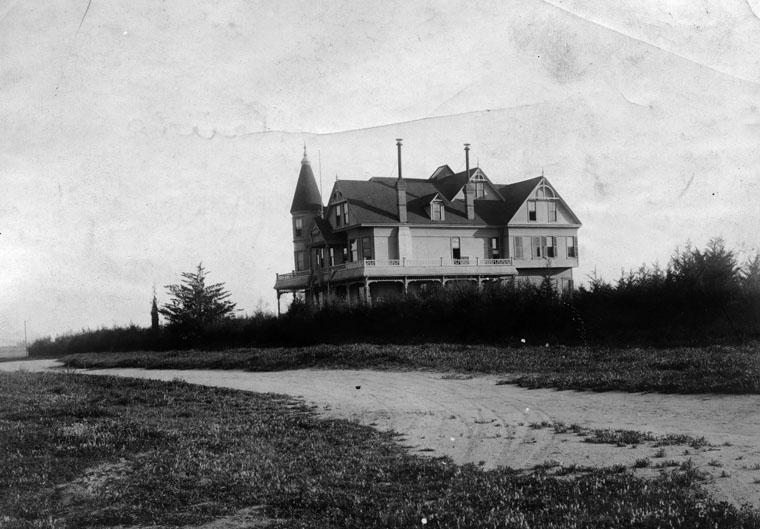 |
|
| (ca. 1890)* - Exterior view of the Porter Hotel (also called the Mission Hotel). Building was built in 1887, on a knoll about a mile from the center of San Fernando. It served as a hotel for about a year, and later, as a summer residence for the Porter family. |
Casa de Lopez (Lopez Adobe)
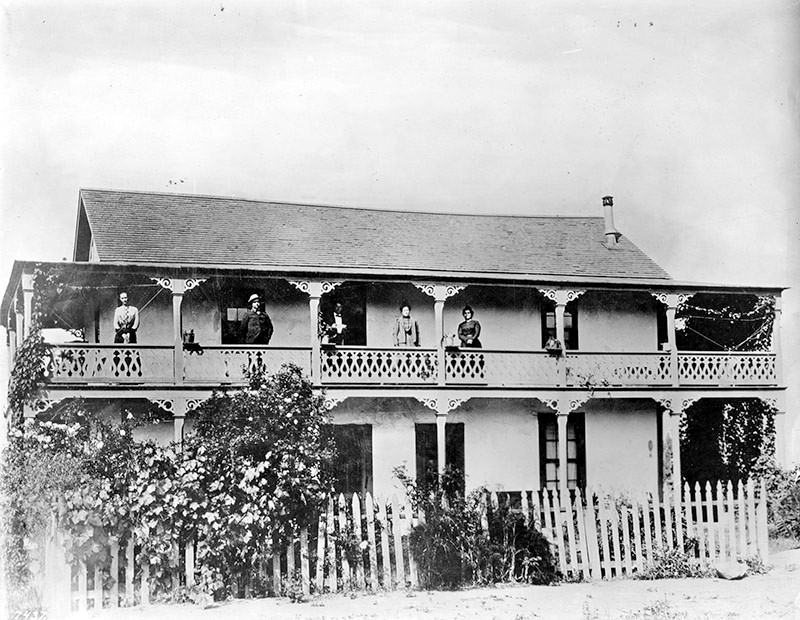 |
|
| (ca. 1883)* - View showing the Geronimo Lopez Adobe of San Fernando. Three women and two men stand on the second floor wrap-around balcony, probably members of the Lopez family. |
Historical Notes The Lopez family built the adobe between 1882 and 1883 using 24-by-6-inch, sun-baked blocks. The surviving adobe home was built by Valentin Lopez, Geronimo's cousin and brother-in-law. It was the first two-story adobe built as a residence in the San Fernando Valley. It is considered the City of San Fernando's oldest standing building.*^ |
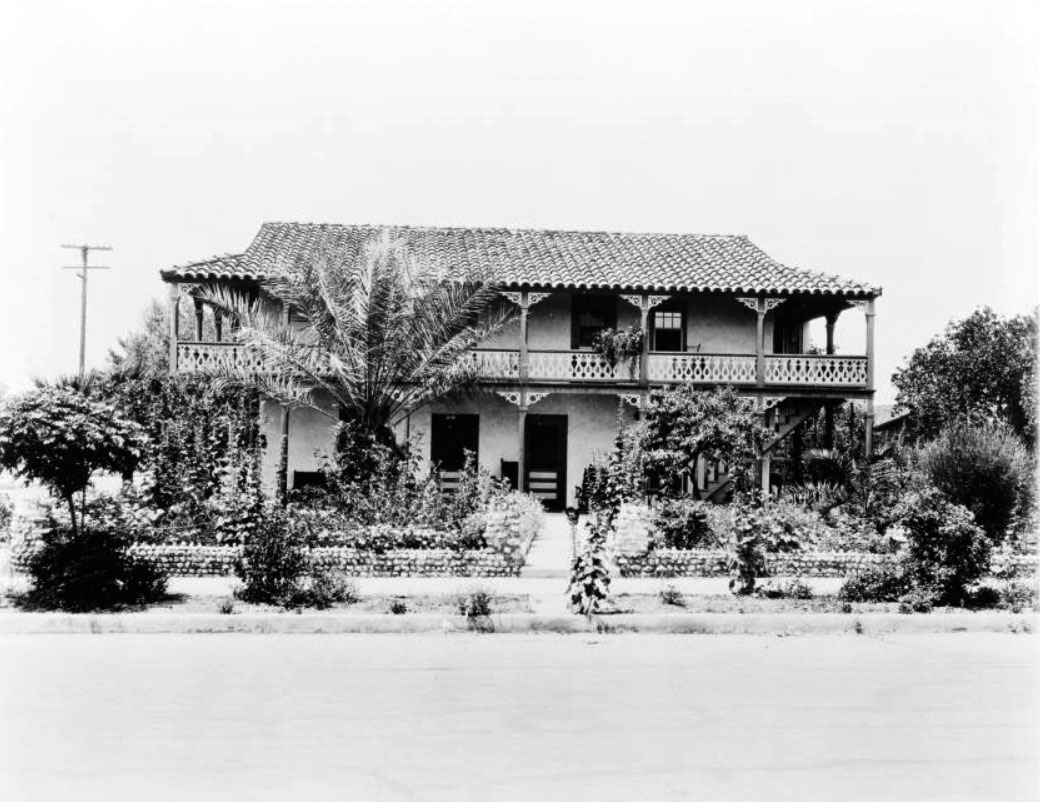 |
|
| (ca. 1925)^^ – View showing the two-story Lopez Adobe with its gilded balcony and terracotta-tiled roof, located at 1100 Pico Street in San Fernando. |
Historical Notes Catalina Lopez died in 1918, and Geronimo Lopez died in 1921, at age 90. In 1928, several modifications were made to the house by one of the Lopez daughters, Louisa Lopez McAlonan. The balcony staircase was changed, and some rooms were divided to form apartments. Modern plumbing and electrical fixtures were also added at the time. The original shake shingle roof was also replaced by clay-tile roof in 1925. *^ |
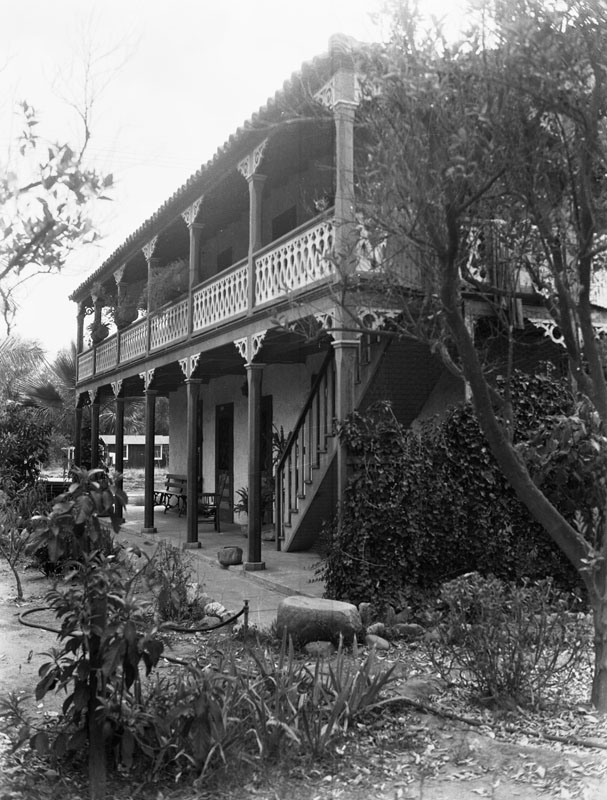 |
|
| (ca. 1935)* - Close-up view of the Geronimo Lopez adobe in San Fernando. It was built by Valentino Lopez for his father, Geronimo, in 1878. It later was used as a stage station, then was the San Fernando Valley's first post office. It is located at 1100 Pico Street, on the corner of Maclay Avenue and Pico Street. |
Historical Notes The Lopez Adobe has been recognized for its blend of Mission Revival and Victorian architectural styles. Catalina Lopez designed the residence's Victorian features. The first local newspaper, the San Fernando Times, was printed in April 1889 from the Lopez Adobe. Members of the Lopez family continued living in the adobe until 1961. The last Lopez to live in the adobe was another daughter, Kate Lopez Millen, who lived in an upper apartment from 1931 until shortly before her death in 1961. The property remained in the Lopez family until 1971. *^ |
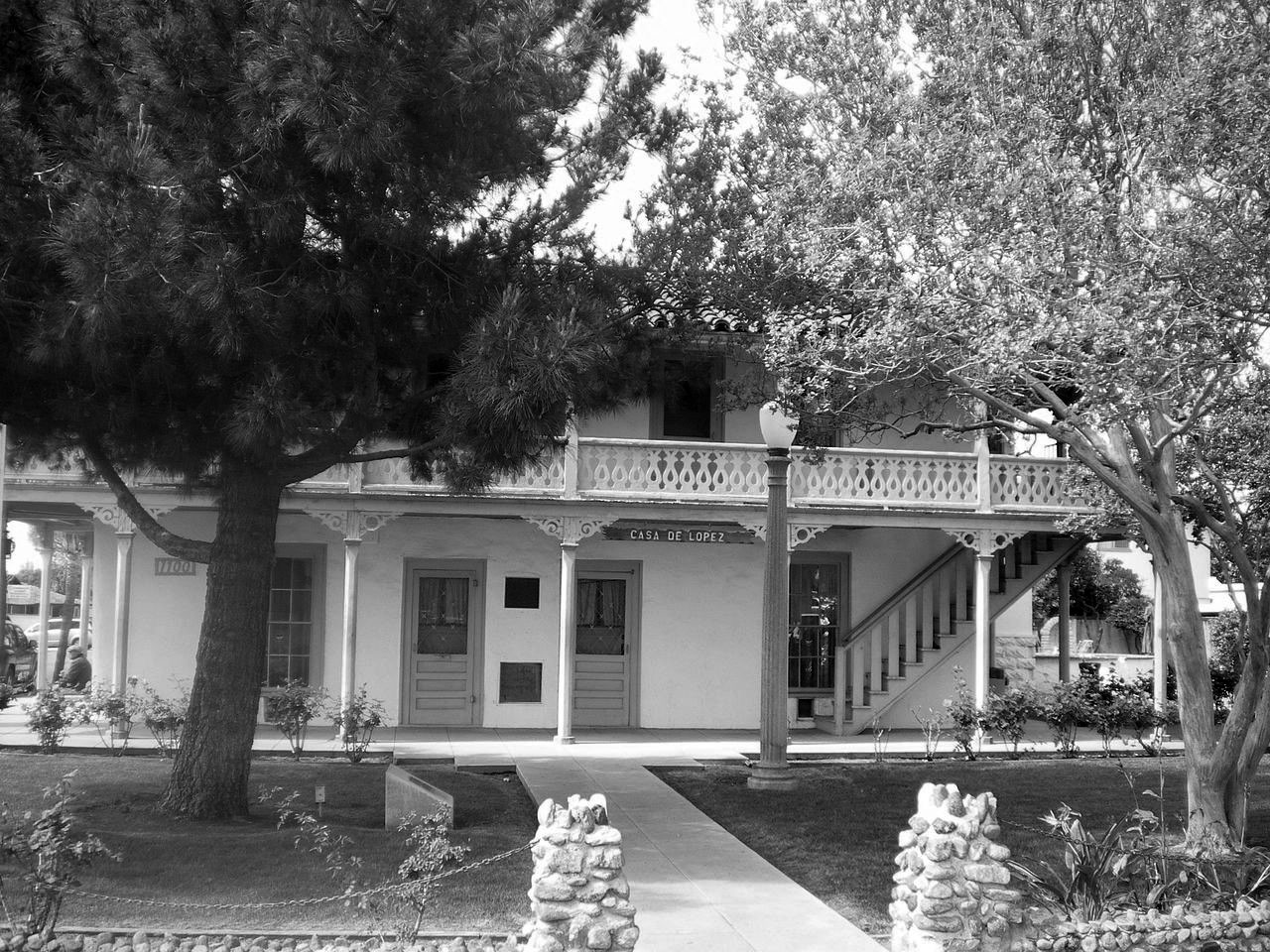 |
|
| (2008)* - Front view of Casa de Lopez (Lopez Adobe), 1100 Pico Street in San Fernando. |
Historical Notes Lopez Adobe is one of the two oldest private residences in the San Fernando Valley. Built by early settlers of the San Fernando Valley a short distance from the San Fernando Mission, it was listed on the National Register of Historic Places in 1971. The Grand-Reopening of the property occurred on March 22, 2015 and is now open for public tours once every 4th Sunday of the month from 12-4 P.M. |
* * * * * |
Lopez Station Stagecoach Stop
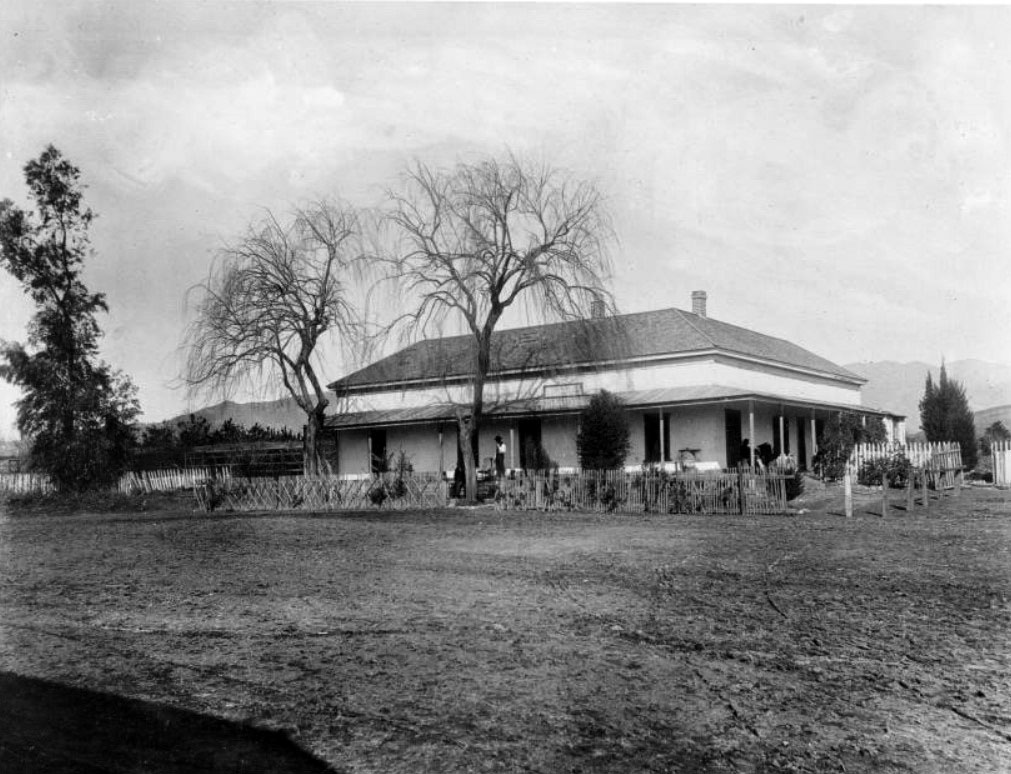 |
|
| (ca. 1885)* - View showing the Geronimo Lopez stage station and ranch adobe. A man is seen standing on the porch of the one and a half-story adobe. The roof of the adobe is shingled, and doors can be seen at regular intervals on each visible wall of the edifice. At the time the photograph was taken, the adobe was being used as a toll and stage station. It was built by Valentino Lopez. |
Historical Notes Geronimo and Catalina Lopez purchased 40 acres of land near the Mission San Fernando in 1861 and built an adobe home along the Butterfield Overland Mail 1st Division, on the Stockton - Los Angeles Road wagon route that connected Los Angeles and San Francisco. The original adobe became known as Lopez Station. The couple also operated the San Fernando Valley's first general store, its first English language school, and the first post office (in 1869) at the site. One account of the early days of the San Fernando Valley noted the significance of the Lopez family: In the late 1860s and early 1870s a traveler riding through the high wild mustard fields of the San Fernando Valley would find little evidence of people except for the mission, a few other adobes, cattle grazing in the fields and a stage house built by Geronimo Lopez and his wife, Catalina. |
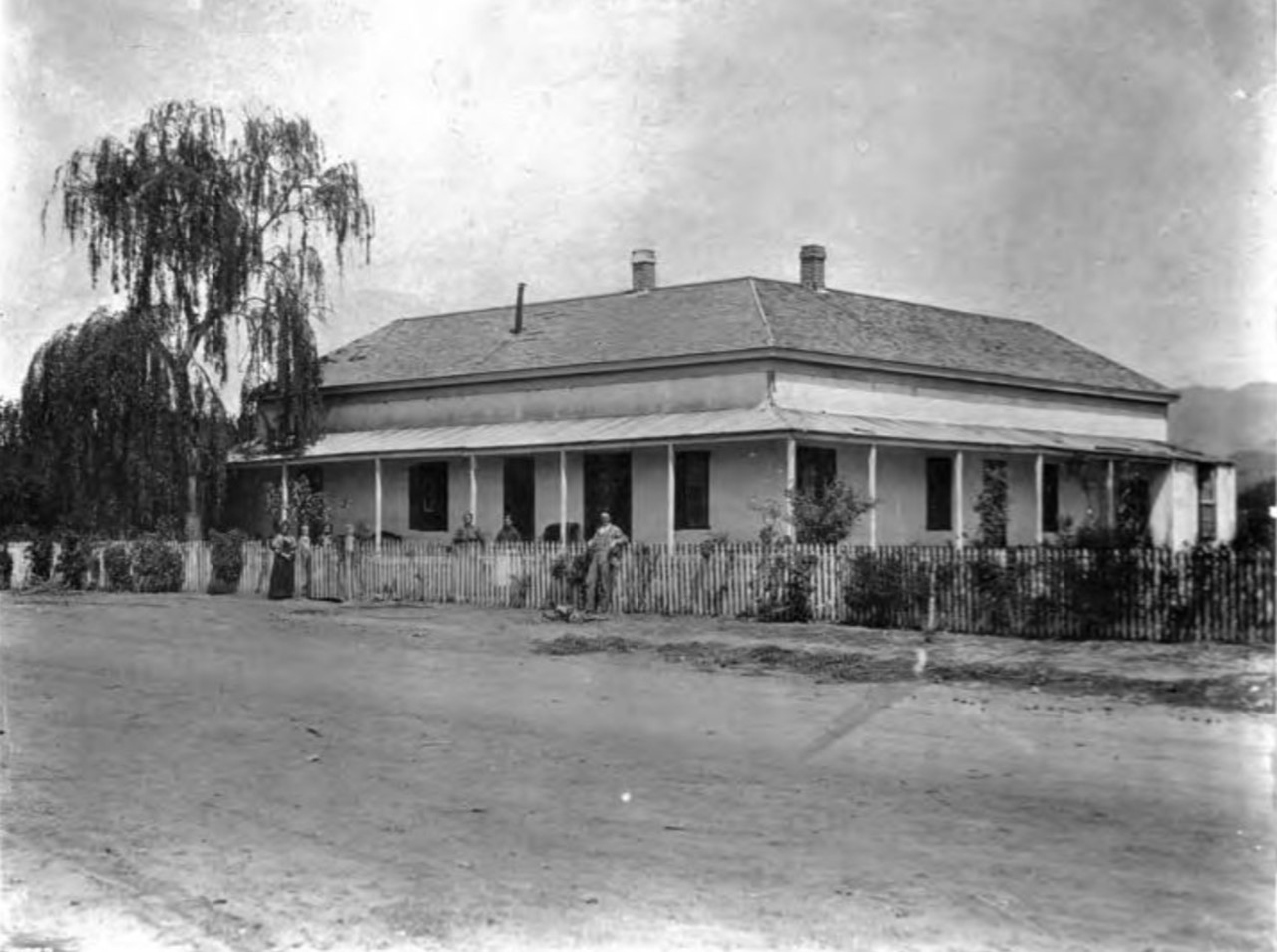 |
|
| (ca. 1890)* - Lopez Station around the year 1890 was used as a stagecoach stop on the route from Los Angeles to San Francisco. It was located on the 15700 block of Rinaldi Street in Mission Hills. |
Historical Notes Lopez Station served as a stopping place for the Butterfield Stage. The station sat on 40 acres of land originally owned by Geronimo Lopez. Here Lopez established a stage stop and a general store. This valley stop would expect two stages a week from Los Angeles en route to San Francisco. Lopez Station served the Butterfield Stage Line throughout its run from 1861 until 1874. When the railroad was completed linking Northern and Southern California, stagecoach travel became obsolete. In 1868, Lopez Station also became an overnight stop for Remi Nadeau’s Cerro Gordo Freighting Company. Nadeau ran freight wagons hauled by teams of sixteen or more mules back and forth from San Pedro to the Cerro Gordo mines in the rugged Sierra Nevada Mountains in Inyo County. The original Lopez Station adobe was destroyed in the 1910s for the construction of the San Fernando Reservoir (later renamed Van Norman Reservoir), part of the then new Los Angeles Aqueduct system. After the 1971 Sylmar earthquake the foundation was again exposed in the reservoir basin. It was later covered by the vehicle track when the Los Angeles Police Department built the Davis Training Center in the late 1990s. |
* * * * * |
Beale’s Cut (Fremont Pass): Los Angeles’ Historic Mountain Gateway
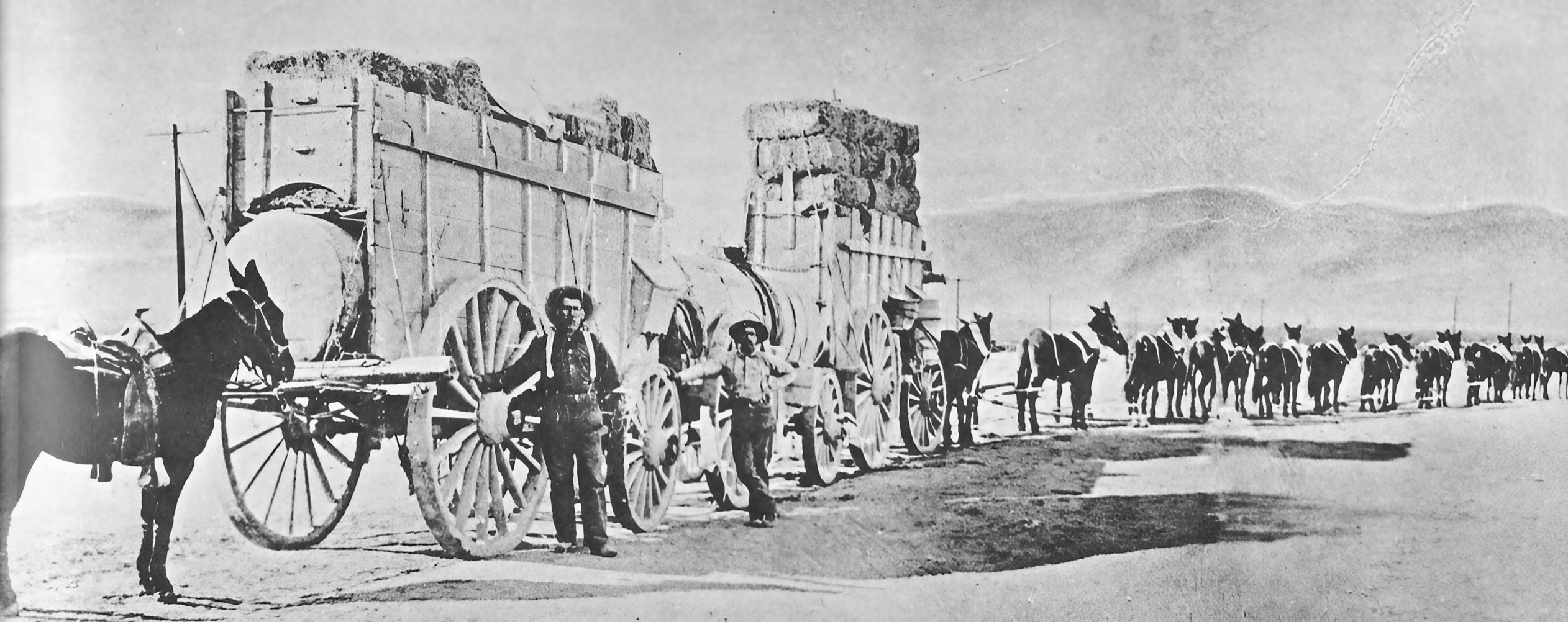 |
|
| (ca. 1875)* - Freighting strings belonging to Remi Nadeau are captured here in Soledad Canyon. Remi Nadeau’s tall, narrow freight wagons navigate the canyon roads en route to Beale’s Cut—the principal engineered slot in the San Gabriel and Santa Susana Mountains. Lopez Station (now Mission Hills) served as one of his overnight stops. |
Historical Notes Remi Nadeau, a French-Canadian pioneer, arrived in Los Angeles in 1861 driving ox teams. During the silver boom at Cerro Gordo, his outfit hauled tons of silver ore south and returned north with food and supplies. By 1873 he commanded more than 80 teams. Along the way, Lopez Station in present-day Mission Hills served as one of his key overnight stops. Nadeau also built the four-story Nadeau Hotel in Los Angeles, the city’s first building with an elevator. This freight commerce depended heavily on Beale’s Cut, then the only engineered road link through the mountain barrier. |
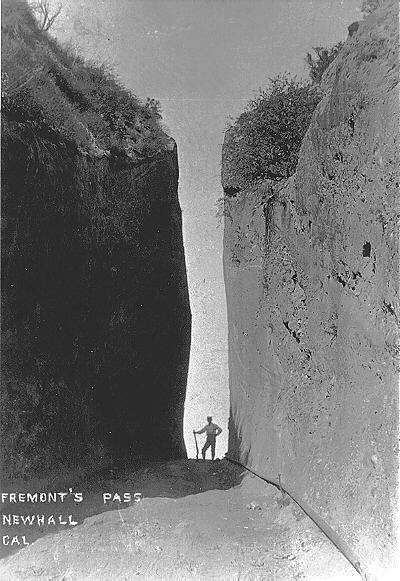 |
|
| (late-1800s)* - A lone figure stands near the deep slot of Fremont Pass (later Beale’s Cut). Originally called “Fremont” after John C. Frémont, the name was later overshadowed by businessman Henry Newhall, and ultimately changed when Edward F. Beale took control. |
Historical Notes Spanish explorer Gaspar de Portolá noted the pass in 1769, though it had long been used by the Tataviam people. By the mid-19th century, travelers struggled over the treacherous La Cuesta Vieja (“Old Grade”), a 29% grade notorious for wrecked wagons. In the early 1850s, entrepreneur Henry Clay Wiley built a windlass system to haul wagons over the summit, and a tavern and stable—later known as Lyons Station. In 1854, Phineas Banning and partners cut a shallow 30-foot notch through the summit, the first real attempt at an engineered passage. This photo recalls the steep, narrow crossing before Edward Beale’s expansion. |
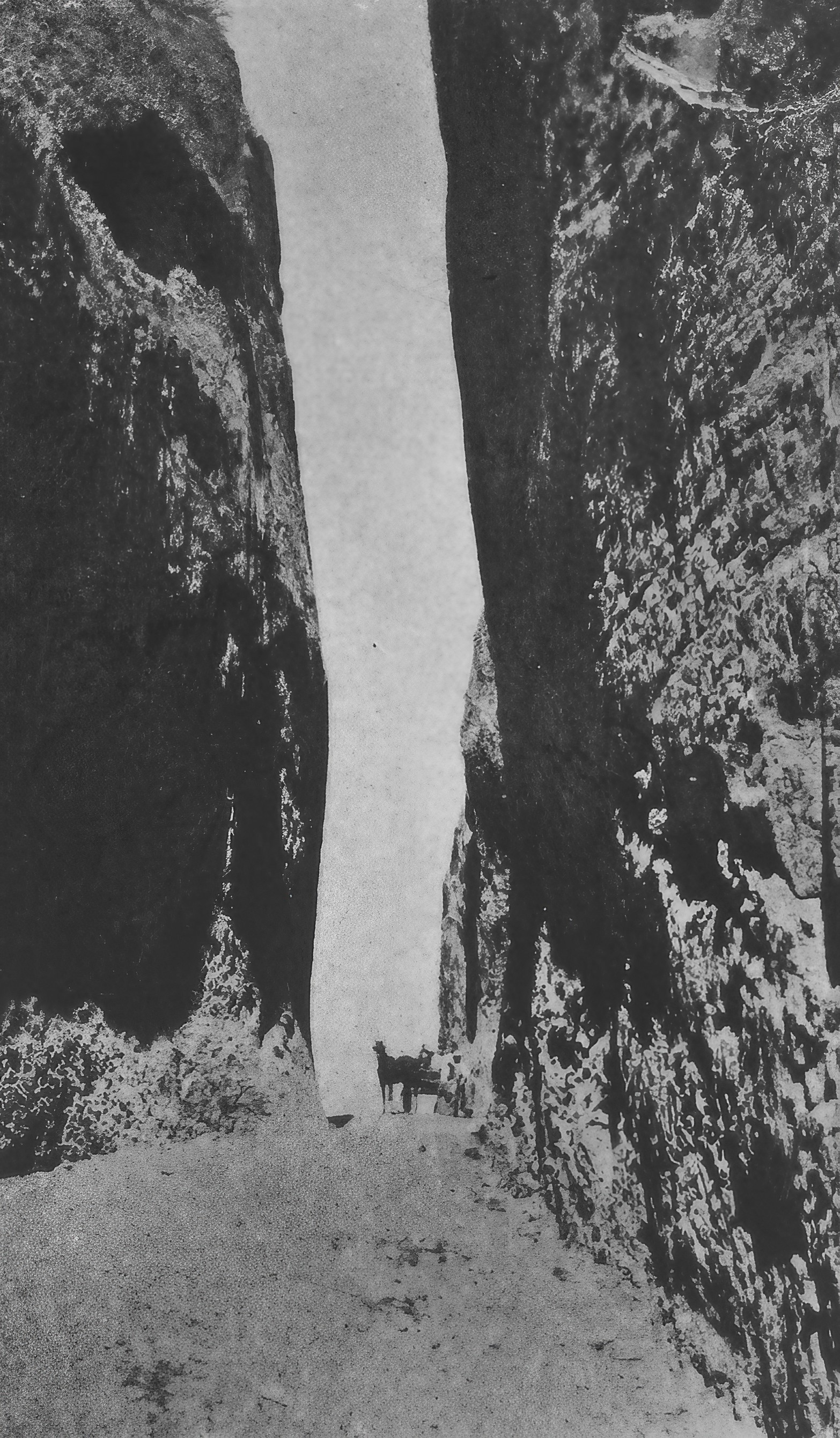 |
|
| (1870s)* - A horse-drawn wagon passes through the sheer walls of Beale’s Cut, deepened in 1863 to nearly 90 feet. |
Historical Notes After being appointed federal Surveyor General in 1861, Edward Fitzgerald Beale challenged Andrés Pico for control of the toll road. By 1863 he held the rights and hired crews—many of them Chinese laborers—to deepen the slot from 30 to about 90 feet. More than 40,000 cubic yards of rock were removed with hand tools and black powder. A small adobe house at the base of the grade housed the toll keeper. This image shows the narrow scale of the passage: only 15 feet wide, barely accommodating coaches and wagons. Over time, stagecoach wheels carved grooves into the bedrock, visible in later photos. |
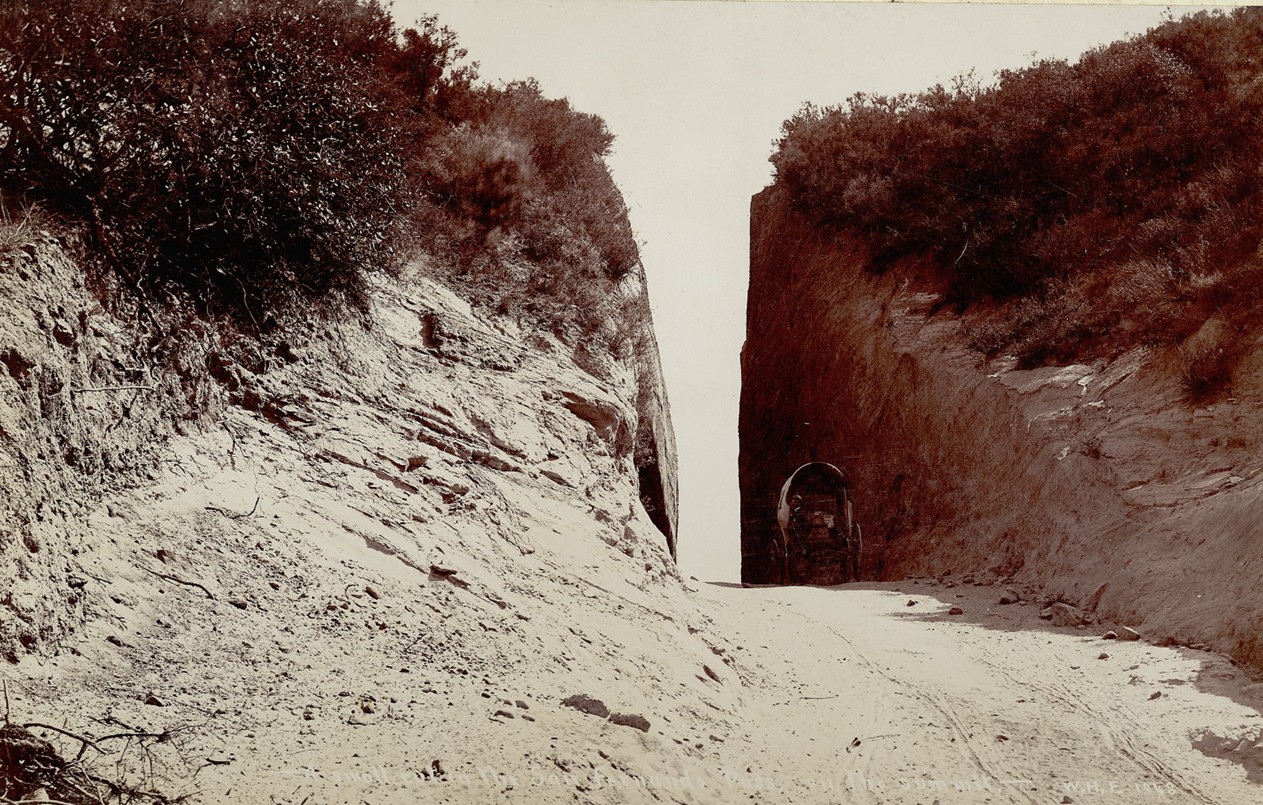 |
|
| (ca. 1890)* - A horse-drawn wagon at the summit of Beale’s Cut, photographed by W. H. Fletcher. The vertical walls on either side illustrate the dramatic scale of the man-made passage. |
Historical Notes For decades, Beale’s Cut served as the primary gateway between Los Angeles and the north. Freight wagons hauled farm goods south and brought oil from nearby Pico Canyon fields to Los Angeles. Stage lines carried passengers through the slot, and the Butterfield Overland Mail used the pass between 1858 and 1861. By the late 19th century, the cut was already a symbol of human determination against a daunting geographic barrier. |
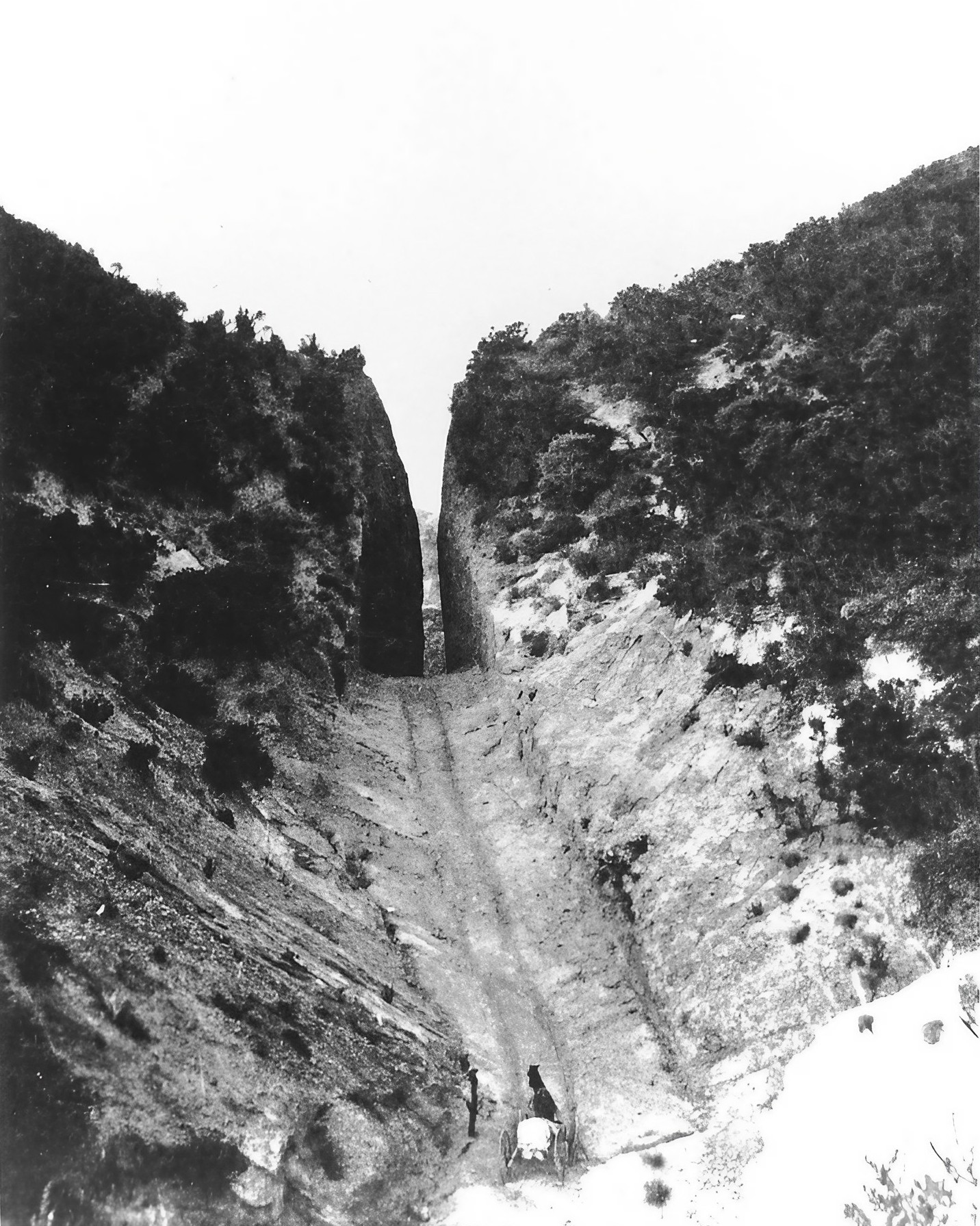 |
|
| (ca. 1872)* - A carriage makes its way up toward Beale’s Cut. The grooves carved into the rock from decades of wagon traffic are clearly visible. |
Historical Notes This image underscores how heavily the cut was used. Thousands of freight wagons, stagecoaches, and mail carriers wore deep ruts into the sandstone floor, physical reminders of the constant flow of goods and people linking Los Angeles with the rest of California. |
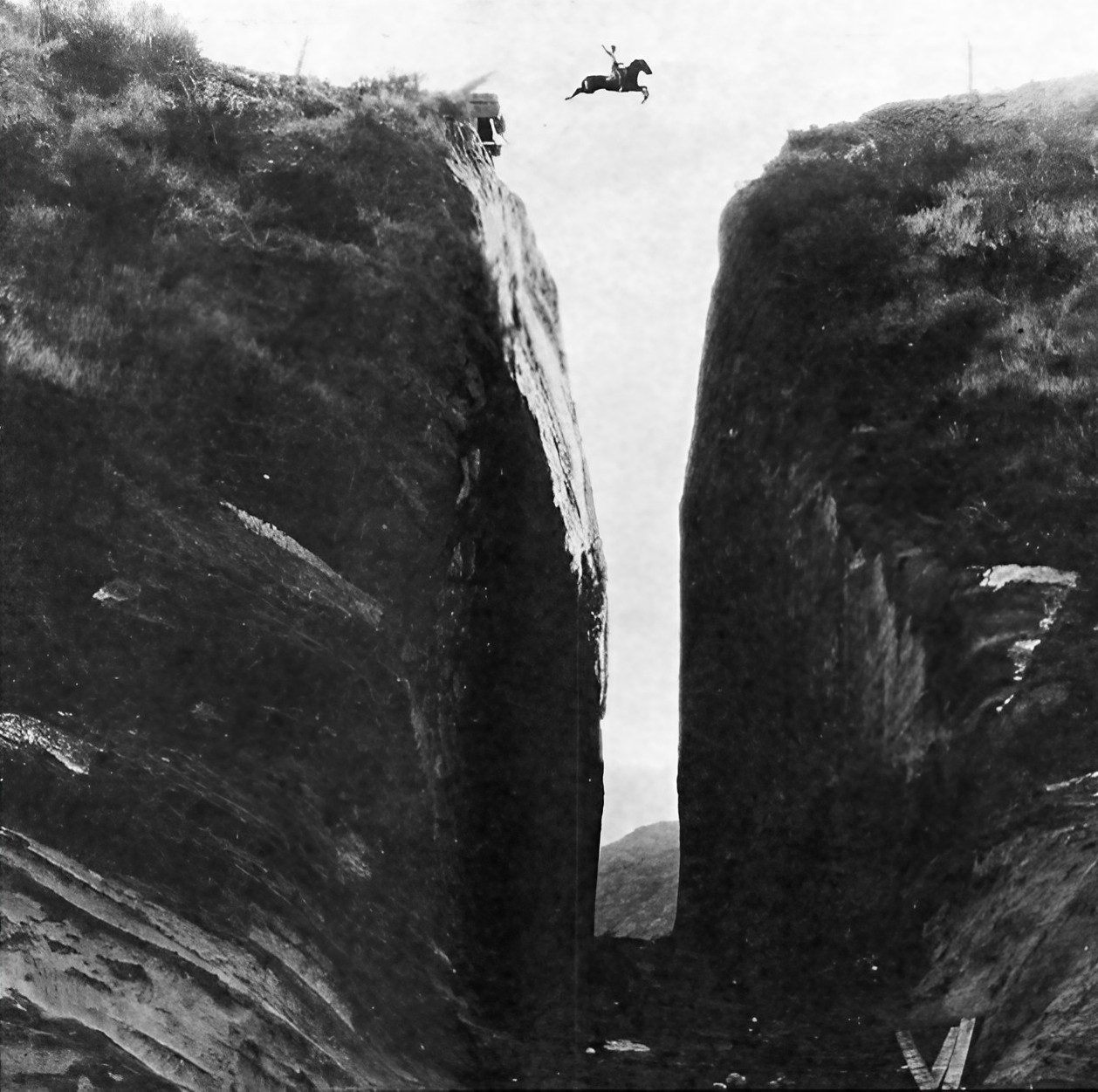 |
|
| (1923)* - Silent film star Tom Mix (or more likely a stunt double) is shown leaping a horse across Beale’s Cut in John Ford’s Three Jumps Ahead. |
Historical Notes By the early 20th century, the narrow slot was too small for automobiles. In 1910, the Newhall Tunnel replaced it as the preferred route. But Hollywood quickly adopted Beale’s Cut as a dramatic filming location. Directors like D. W. Griffith and John Ford used it repeatedly in Westerns, often portraying it as a remote canyon of the Old West. The Mix stunt is one of Hollywood’s most enduring myths: the lost film and promotional stills suggest a daring leap, though historians agree special effects and doubles were involved. |
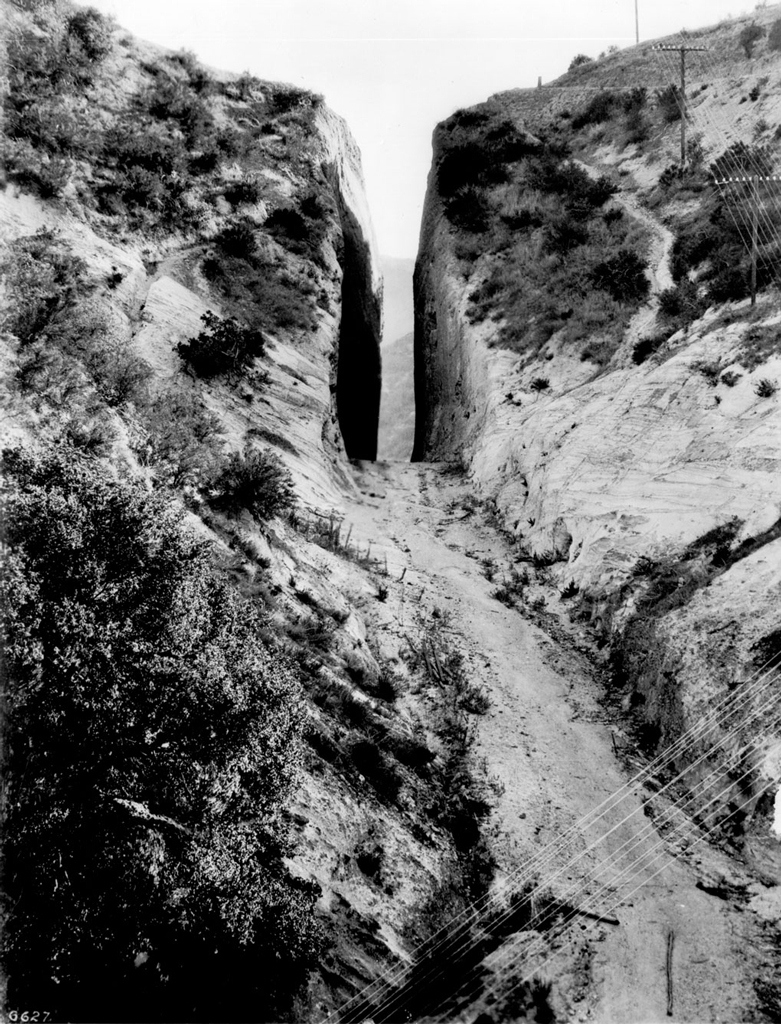 |
|
| (Early 1900s)* - Beale’s Cut seen from the intersection of Sierra Highway and Clampitt Road, Santa Clarita Valley. |
Historical Notes By this time, the cut had lost its role as a vital roadway but remained a landmark along the growing road network. Automobiles occasionally attempted the steep passage, but it was quickly eclipsed by modern engineering. |
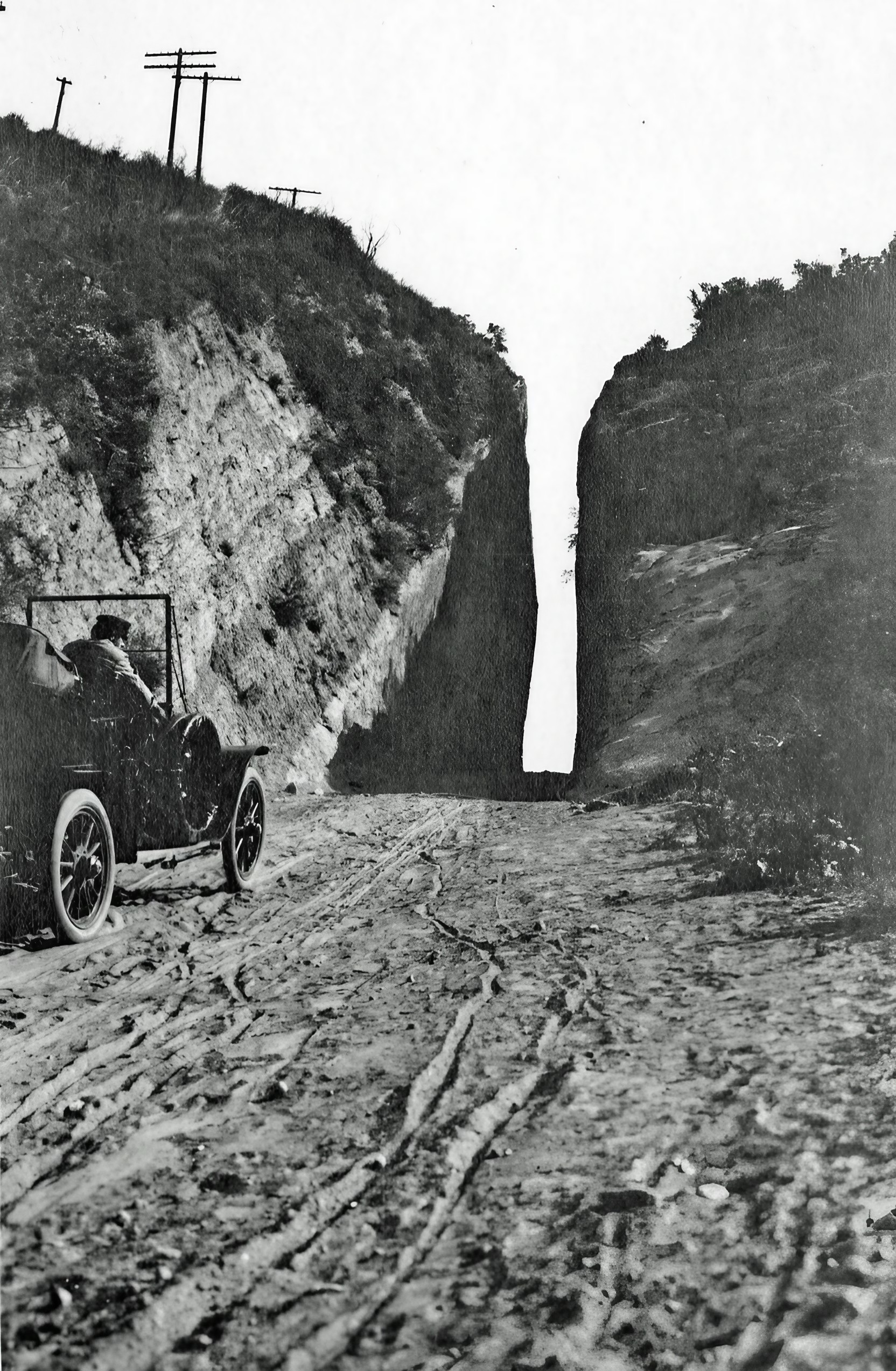 |
|
| (1908)* - Fremont Pass (Beale’s Cut) in 1908, two years before the Newhall Tunnel opened. |
Historical Notes The tunnel, completed in 1910, reduced the grade from 22% to 6% and allowed safe automobile travel. This marked the end of Beale’s Cut as an active transportation route, though it lingered as a backup and film location. |
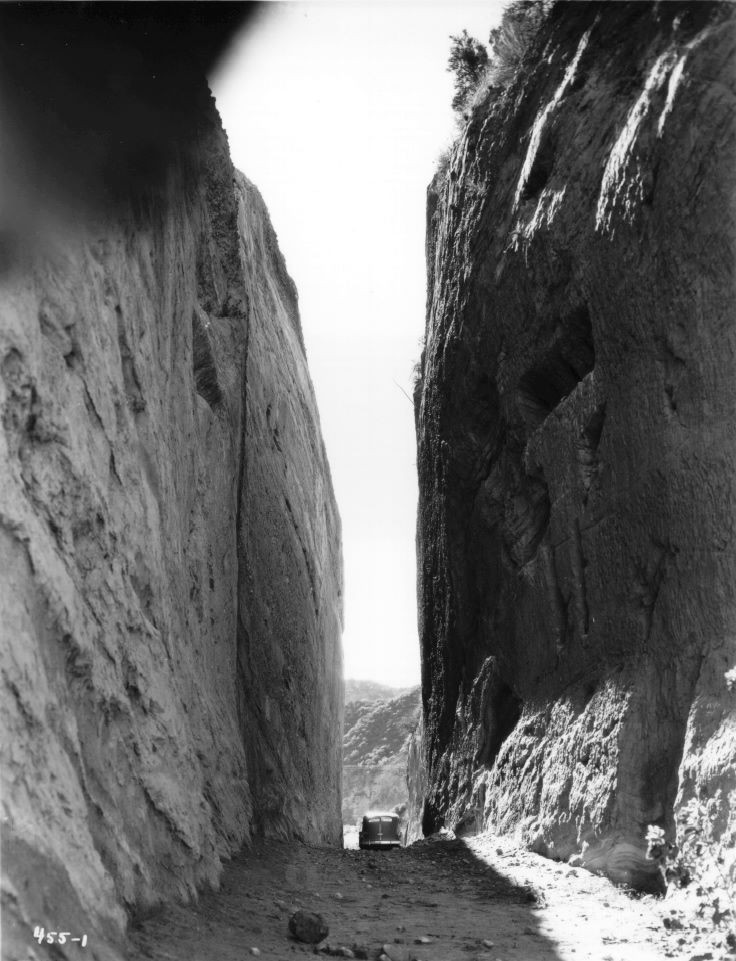 |
|
| (1937)* - Beale’s Cut, by then limited to light automobile traffic. |
Historical Notes Even after the Newhall Tunnel opened in 1910, Beale’s Cut did not vanish from use overnight. Locals still drove through the old slot when traveling between the Santa Clarita and San Fernando valleys, though only compact vehicles could manage its steep, narrow grade. By the 1930s, the once-vital passage was already becoming a relic of the past—still dramatic in form, but increasingly bypassed by modern roadways. Within a decade, erosion and collapse would make it impassable except on foot. |
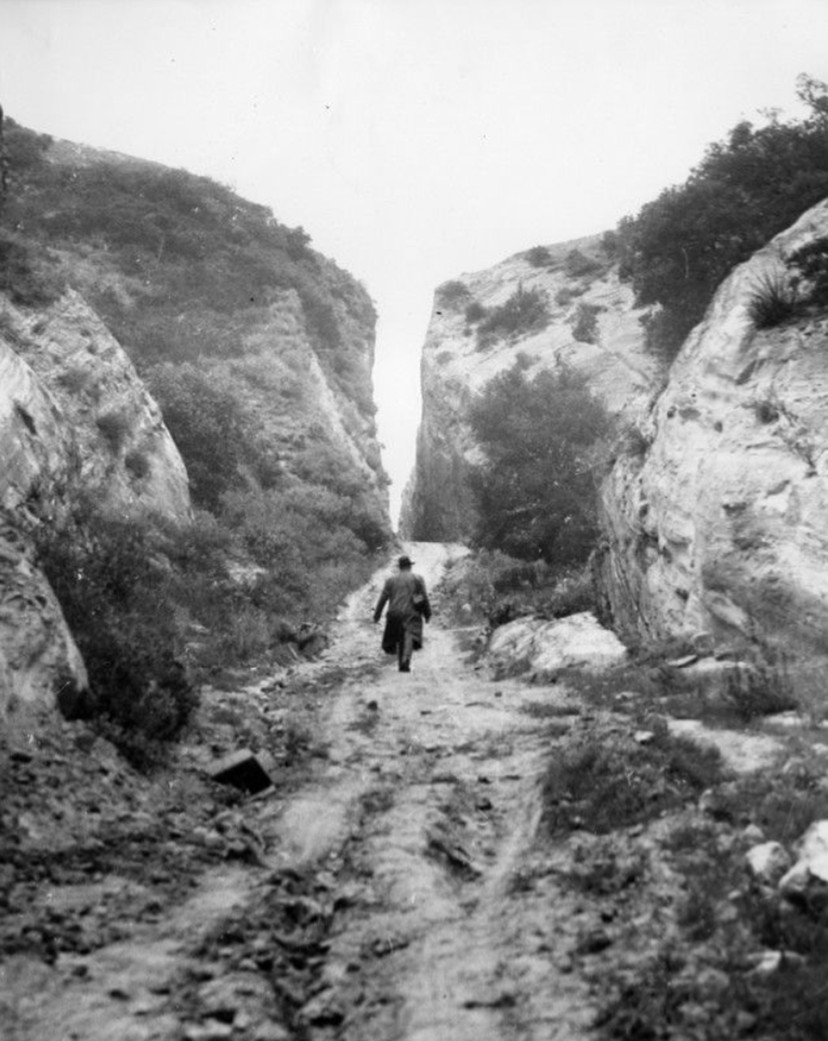 |
|
| (1948)* - A hiker scrambles up the eroded remains of Beale’s Cut. Once nearly 90 feet deep, it had already partially collapsed by mid-century. |
Historical Notes The cut continued to erode through storms, landslides, and earthquakes. The 1994 Northridge earthquake and subsequent landslides reduced its depth to about 30 feet. In 1992, it was recognized as California Historical Landmark No. 1006, but markers have since disappeared. |
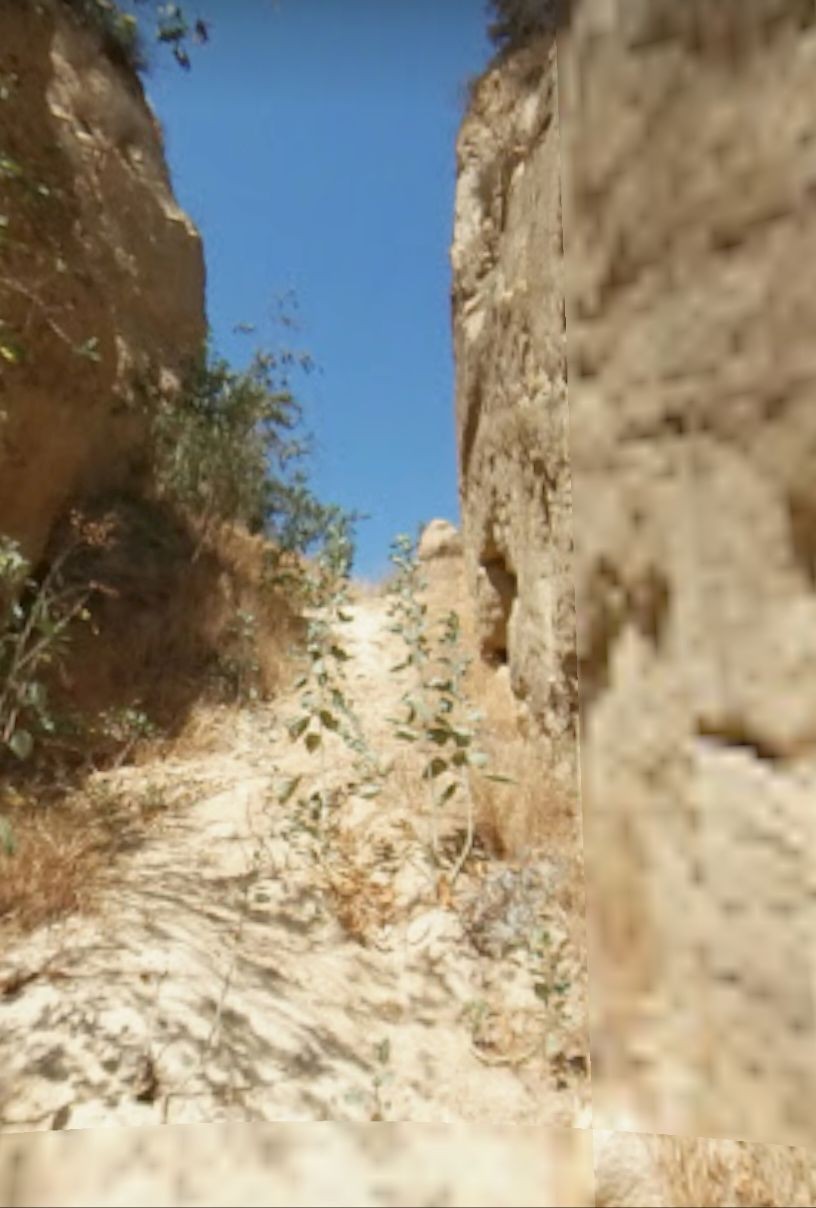 |
|
| (2025)* – Modern view of Beale’s Cut (Photo courtesy of Roy Hooper). Though fenced off and diminished, the cut remains visible from Sierra Highway. Photo courtesy of Roy Hooper. |
Historical Notes Today, few of the thousands of commuters passing nearby on Interstate 5 and Highway 14 realize that this quiet scar in the hillside once represented the lifeline of Los Angeles—linking the isolated pueblo to the rest of California and the nation. |
Then and Now
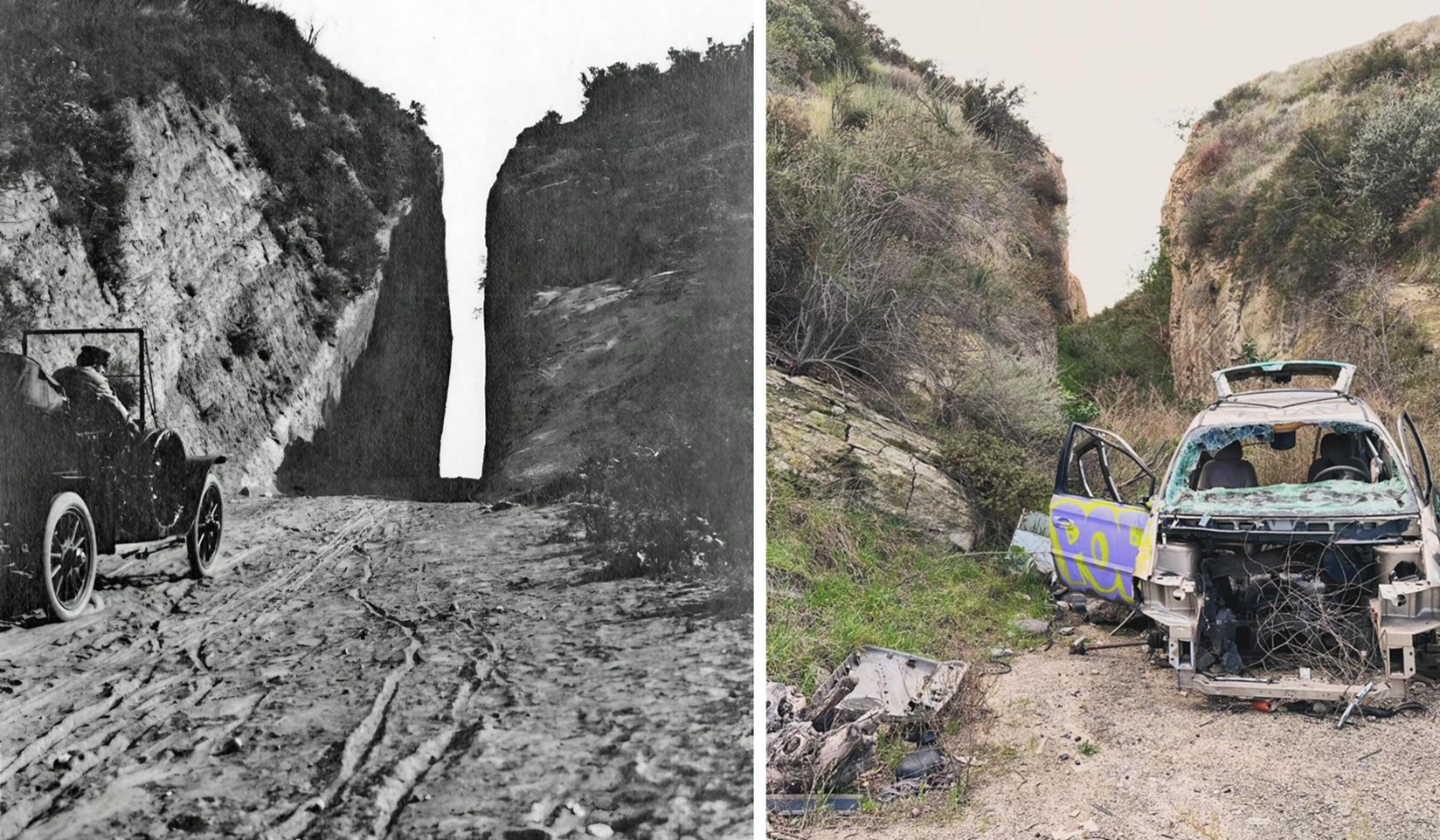 |
|
| (1908 vs. 2025)* - Beale’s Cut, past and present. Contemporary photo courtesy of Mark Hartman. |
Historical Notes The 1908 view captures Beale’s Cut at the very end of its usefulness as a main highway. Just two years later, the Newhall Tunnel opened, reducing the steep grade and ushering in the automobile age. Over the decades, storms, landslides, and the 1994 Northridge earthquake steadily reduced the once-dramatic 90-foot slot to less than a third of its original depth. The 2025 view shows the scarred but still recognizable passage, fenced off yet visible from Sierra Highway. Together, these images illustrate the transformation of Southern California’s first engineered mountain gateway—from the lifeline of the San Fernando Valley to a hidden remnant overshadowed by freeways. |
* * * * * |
Van Nuys Residence
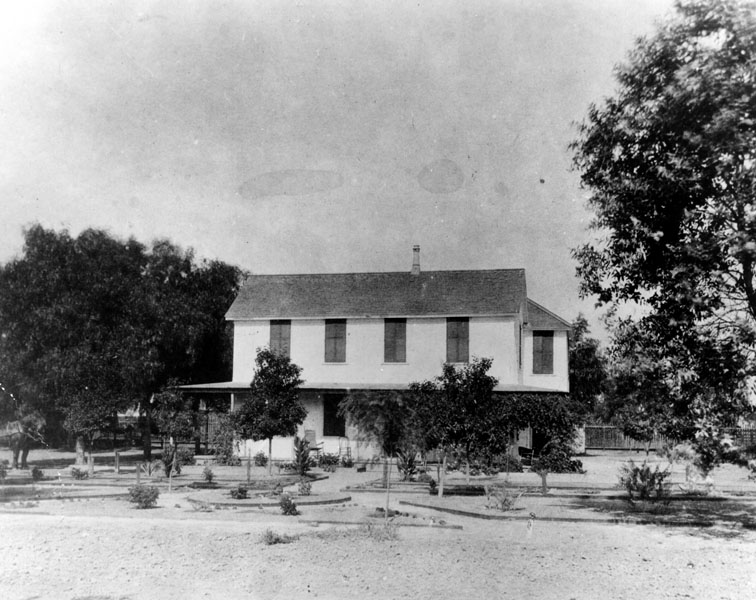 |
|
| (1882)* - Exterior view of the residence belonging to Isaac Van Nuys located in the San Fernando Valley. |
Historical Notes In 1865 at age 30, Isaac Newton Van Nuys moved to California, the first Van Nuys to actually do so. He first lived in Napa and later Monticello, where he owned a country store. In 1871, Van Nuys moved to Los Angeles, where he bought in with Isaac Lankershim's corporation, the San Fernando Homestead Association, that in 1869 had bought the southern half of Rancho Ex-Mission San Fernando totaling sixty thousand acres and engaged in the raising of stock, principally sheep. In 1873, Van Nuys, and future brother-in-law Isaac Lankershim's son, James Boon (J. B.) Lankershim, moved to the San Fernando Valley and took over management of the property. In 1874 they began raising grain, introducing dry land farming. In 1876 they filled two ships with Valley wheat at the Los Angeles Harbor in San Pedro. It was both the first grain cargo ever shipped from the L.A. Harbor, and the first grain ever shipped to Europe from the United States. As a major figure in regional history and development, there are schools, streets, libraries, and a Liberty Ship with the name of Van Nuys. |
* * * * * |
Hotel Cecil
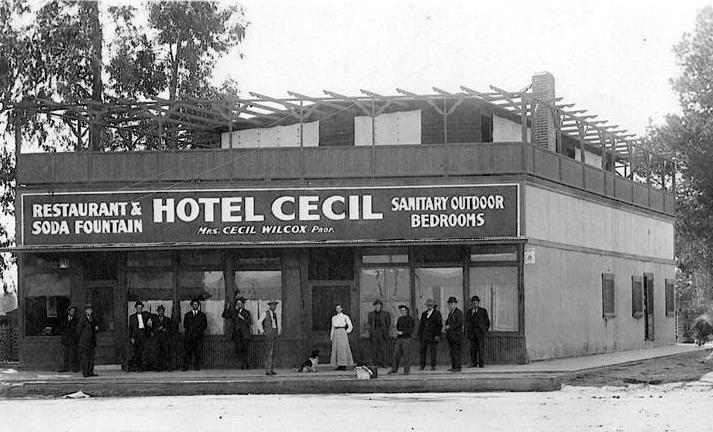 |
|
| (1888)*^^^ – View of the Hotel Cecil in Lankershim (North Hollywood). It was one of the first hotels in the San Fernando Valley. Pictured in the center is the owner, Mrs. Cecil Wilcox, with a dog by her side. A dozen men surround her, all posing for the photographer. |
Historical Notes Cecil Wilcox was the husband and his wife's given name was Clara. They appear in the censuses. He owned a furniture/book store and was apparently the publisher of a San Fernando Valley newspaper "The Lankershim Laconic." While it is not mentioned in the censuses, a newspaper article in the early 1950's promoting a "pioneer picnic" in Toluca/Lankershim, lists her as a widow who was the owner of the hotel. The photo date more than likely should be 1898 since Cecil was born in 1876. Clara (Hoegerman) and Cecil were married in 1897 in Los Angeles County. Cecil had died in 1933. Clara died in 1958. Ancestry.com has a picture of Clara and her sister Rose. |
* * * * * |
Lankershim Elementary School
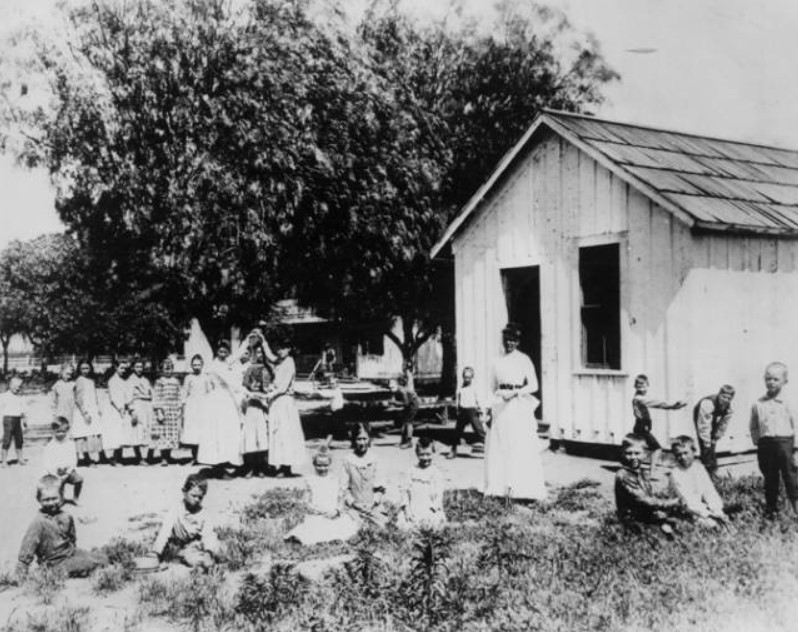 |
|
| (1888)^ - View of children and adults playing in front of the first elementary school in Lankershim (now North Hollywood). |
Historical Notes Lankershim’s first elementary school was located on Vineland Avenue, just south of Third Street (now Riverside Drive). Mary Crawford, visible in front of the doorway, was Lankershim's first elementary school teacher.^ |
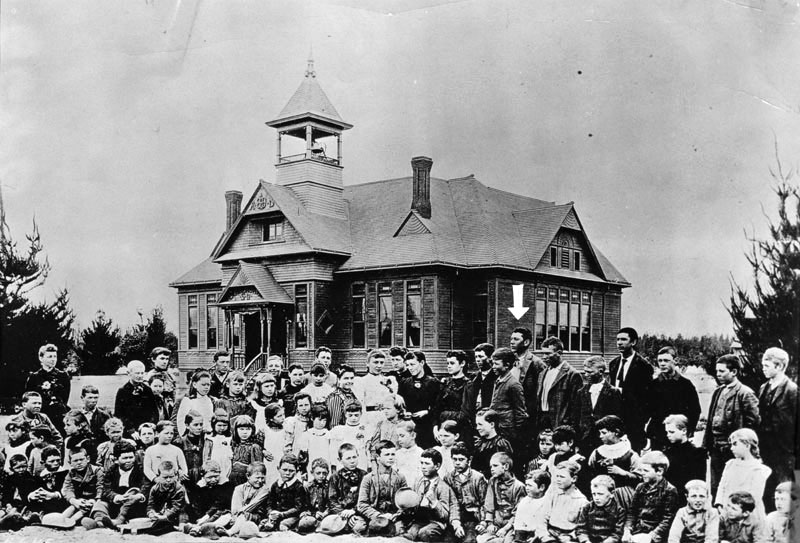 |
|
| (ca. 1889)* - Group portrait of children and adults in front of the second Lankershim Elementary School, built in 1889. Today, the elementary school is located at 5250 Bakman Avenue, North Hollywood. The arrow is pointing to Fred Weddington who graduated in the second class. |
Historical Notes Wilson Weddington opened a general store and employed his two sons, Guy and Fred. Fred Weddington was appointed the town's first deputy sheriff. He made news in 1904 by using his horse to chase down two robbers who had assaulted a man and then fled into a barley field. They were convicted and sent to prison. Fred Weddington went on to become a land developer, and he opened the town's first bank. He remained active in North Hollywood affairs until his death in 1967.^^^ |
Lankershim and Chandler
 |
|
| (ca. 1891)* - This was the intersection of Lankershim and Chandler as it appeared in the late 19th Century. See what the intersection of Lankershim and Chandler looked like in: 1924 / 1946 / 2018 |
Historical Notes Lankershim Boulevard was named for the town of Lankershim (first called Toluca, now North Hollywood) and its founding family. Isaac B. Lankershim grew wheat on a wide swath of the Valley floor on his Lankershim Ranch. North Hollywood was established by the Lankershim Ranch Land and Water Company in 1887. It was first named Toluca before being renamed Lankershim in 1896 and finally North Hollywood in 1927. Chandler Boulevard was originally a leg of Sherman Way, it was renamed for land developer and Los Angeles Times publisher Harry Chandler.^* Click HERE to see more SFV Street Name Origins. |
Weddington House
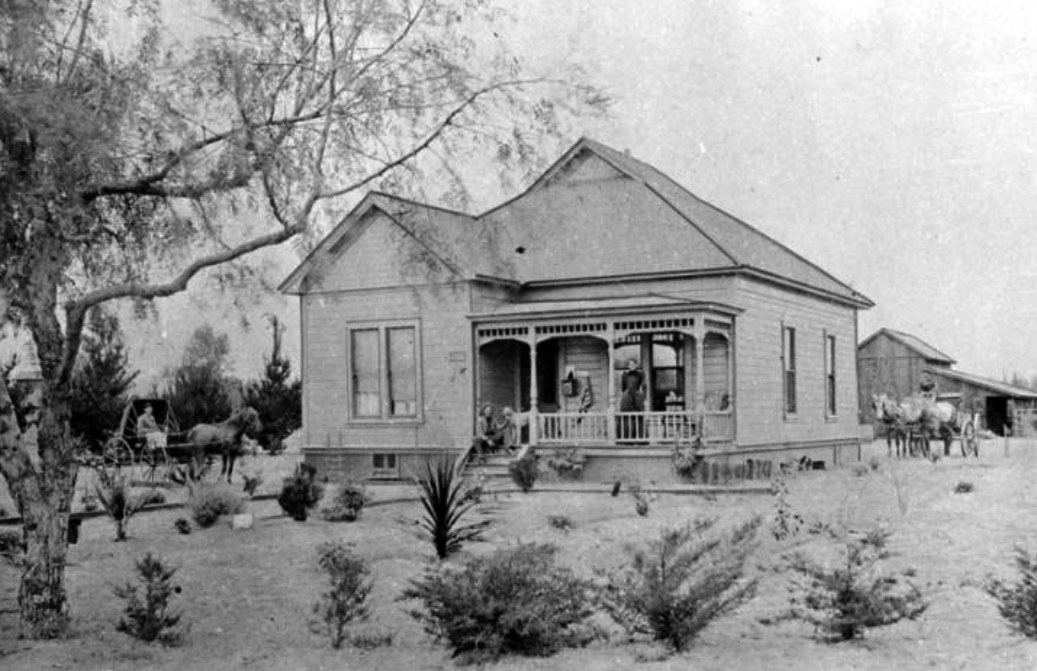 |
|
| (ca. 1895)* - View of the Weddington ranch house, now the location of the El Portal Theater, 5269 Lankershim Boulevard, North Hollywood. |
Historical Notes The above photograph was used for an article in the Valley Times dated March 4, 1949; it reads, "Tiny palm sprout in front of porch of this building, the early Weddington ranch house, grew to be large enough to be lifted out with a steam shovel for groundbreaking for the El Portal theater in 1926. This house was built in the 80's, later was post office of Toluca before town became Lankershim." * |
Pioneer Store
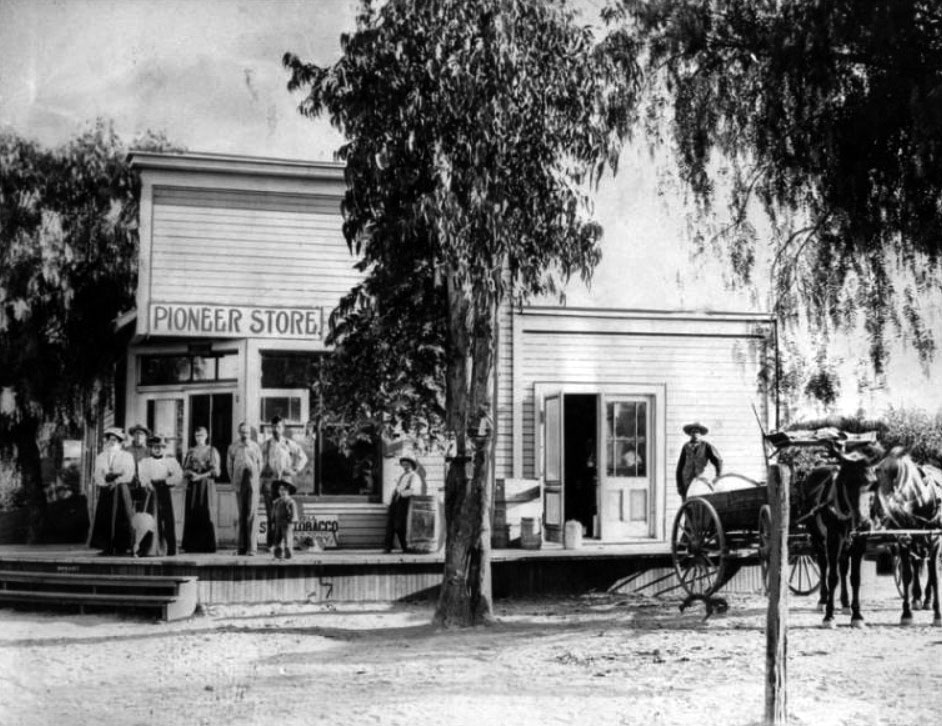 |
|
| (1897)* - Men, women, and children pose in front of the Pioneer Store located near what is now the southwest corner of Lankershim and Chandler boulevards. |
Historical Notes The above photograph was used for an article in the Valley Times dated March 4, 1949; it reads, "Taken in July, 1897, historic picture above shows The Pioneer store, part of the first business block erected in what then was Toluca, now North Hollywood, at the southwest corner of Lankershim-Chandler boulevards intersection. Store contained post office headed by Wilson C. Weddington, father of Fred Weddington." |
Lankershim Ranch
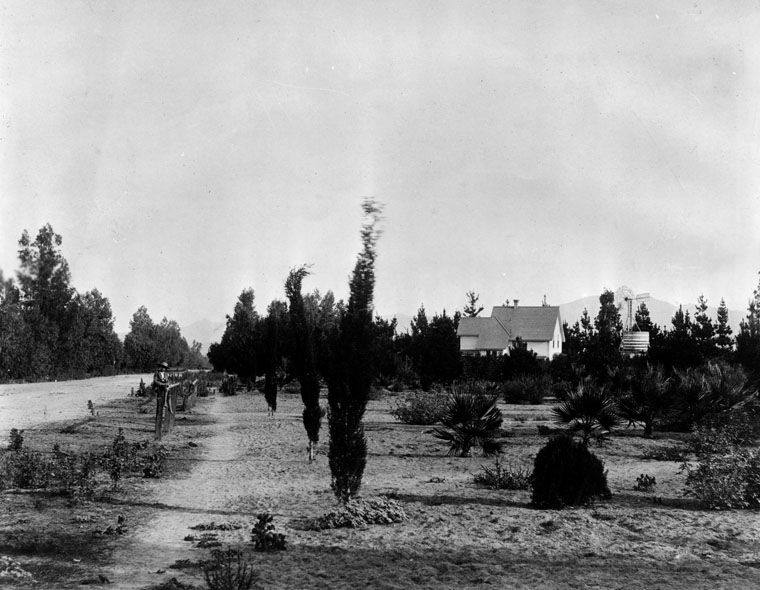 |
|
| (ca. 1900)* - View looking down Vineland Avenue just south of Third Street (now Riverside Drive) showing the residence of William H. Andrews, located on the Lankershim Ranch. |
Historical Notes On the Van Nuys / Lankershim lands, in the late 1880’s, as wheat profits began to decline, JB Lankershim, son of Isaac, formed a group, the Lankershim Ranch Land and Water Company, and bought the easternmost 12,000 acres, and plotted the area for fruit-growing farms. William H. Andrews was the superintendent for these lands, and was the on-site director for the sale and lease of the farms for JB. As the farms grew, Andrews was instrumental in securing lands in the area for the Southern Pacific Railroad; the line that slanted across the valley to Chatsworth. #^*^ |
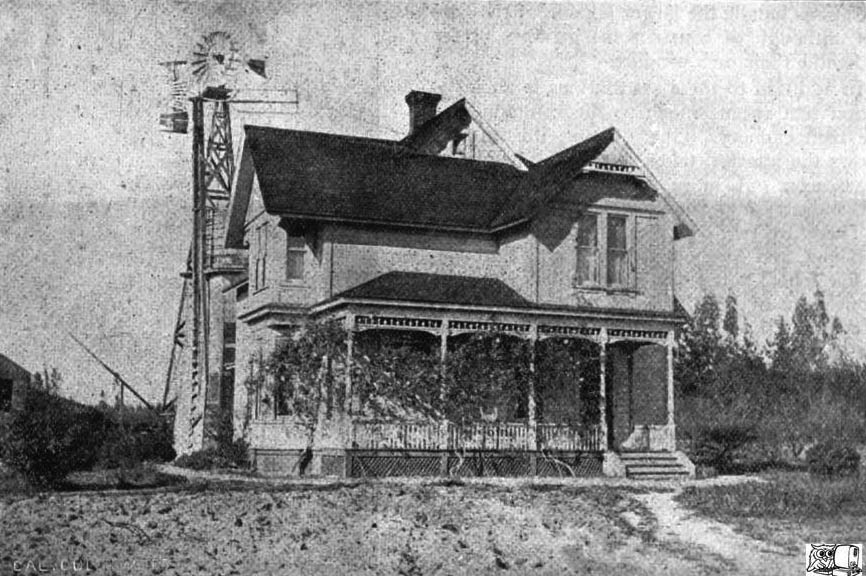 |
|
| (ca. 1900)#^*^ – Front view of William H. Andrews' House, once the only house on the Lankershim Ranch. |
Historical Notes William Andrews was married to Mary "Mollie" Weddington, the sister of Sheriff Wilson Weddington of Storm Lake Iowa. During the winter of 1890, the Andrews invited their relatives to spend the winter in warm Southern California. The Weddingtons came and saw real opportunity in the San Fernando Valley. That same winter, William Andrews conducted a land auction for the Lankershim Land and Water Company, and the Weddingtons made their first big purchase of Valley land.^^# |
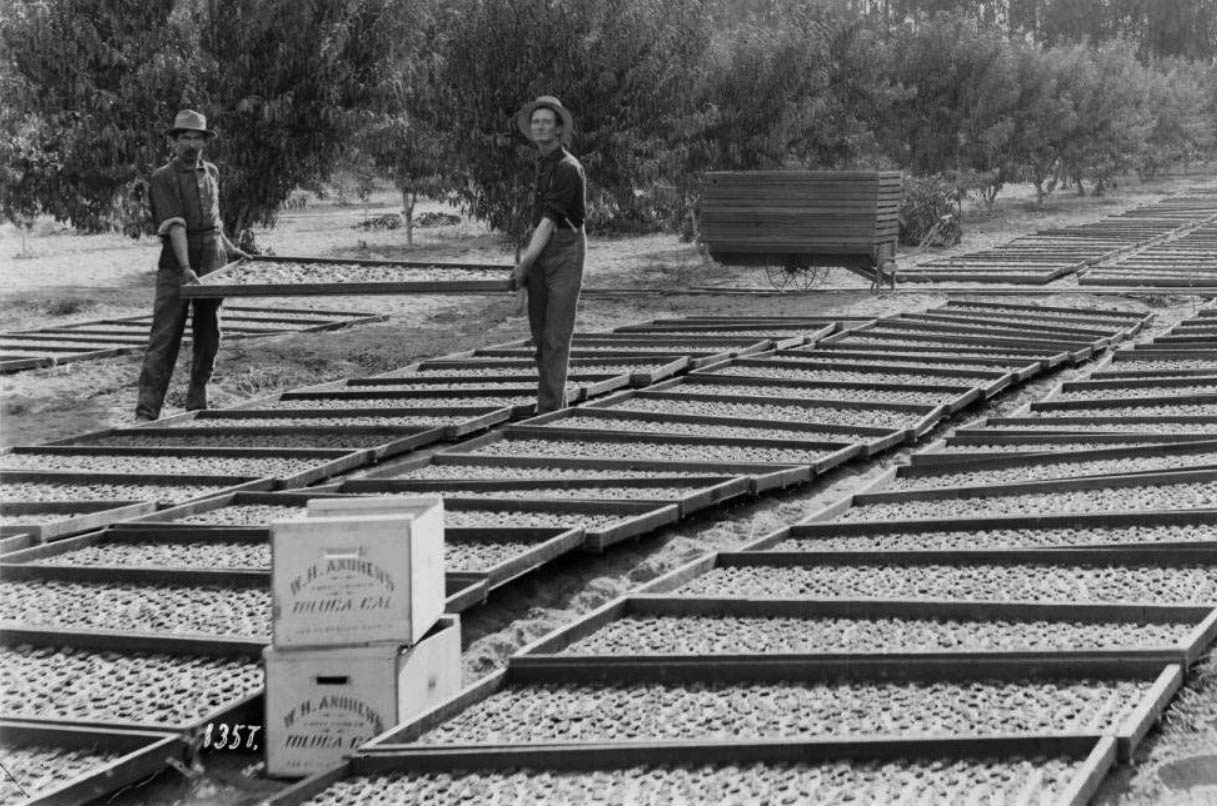 |
|
| (ca. 1900)#^*^ – Fruit processing at Andrews’ ranch. Freshly picked fruit are lined up in large wooden trays. |
Historical Notes W. H. Andrews was in charge of a labor force consisting of 120 Chinese workers. Utilizing 200 mules, they cut roads through the brush and stubble of the Lankershim Ranch. The same force was also used in laying out the new town of Burbank.^^# |
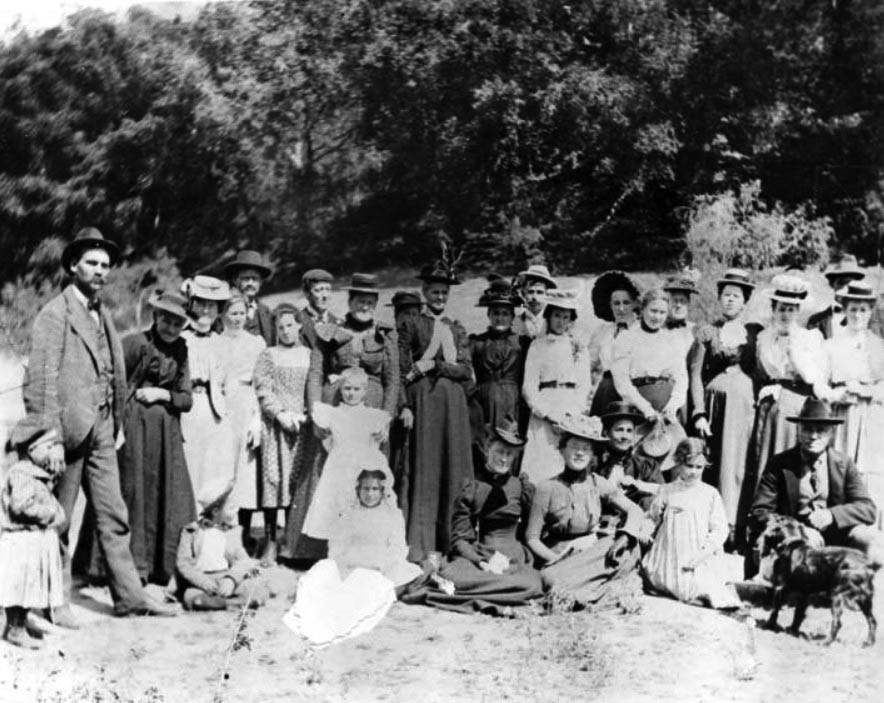 |
|
| (ca. 1894)^ - Picnic by the Los Angeles River and Tujunga Avenue. W. H. Andrews on the left, standing. Either a Methodist Church or a family social gathering. |
Historical Notes William H. Andrews was superintendent of lands owned by the Lankershim Ranch Land and Water Company in Toluca/Lankershim. |
Chatsworth Park (later Chatsworth)
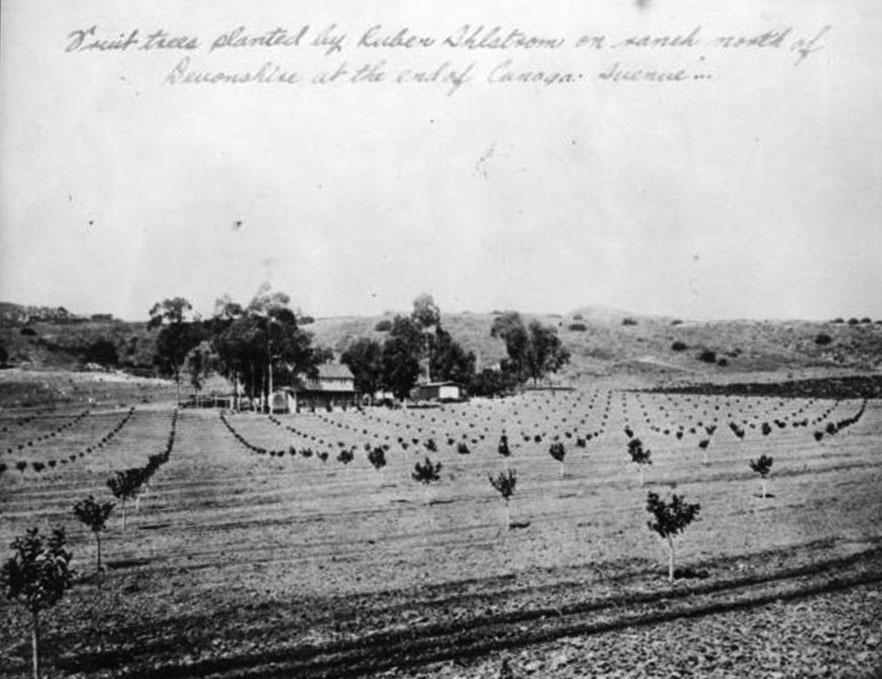 |
|
| (ca. 1890s)^ - Fruit trees planted by Ruben Ahlstrom on ranch north of Devonshire at the end of Canoga Avenue, Chatsworth Park. |
Historical Notes In 1888, George R. Crow filed a map of a subdivision called Chatsworth Park with the Los Angeles County Recorder's Office, naming it after the Duke of Devonshire's estate in England Originally planned as a farming community with land divided into ten-acre family plots, Chatsworth Park was envisioned with only three roads: Ben Porter Avenue (Chatsworth St.), Devonshire Avenue, and Fernando Avenue (Lassen). In 1872, Benjamin F. Porter sold 19,417 acres to F.C. Howes, William Booth Barber, W.F. Barber, and George R. Crow for $500,000, leading to the establishment of Chatsworth Park. By 1915, residents of Chatsworth voted to become part of Los Angeles, and in the 1920s, the area became a popular backdrop for western movies. |
 |
|
| (ca. 1890s)^^ - Photograph of Chatsworth Park and its live oak trees, San Fernando Valley. Beyond a lone oak tree in the foreground, piles of wood are stacked between two pairs of railroad tracks. Four buildings are visible in the center of the field. A newly planted orchard borders the buildings. Mountains are visible beyond the distant rocky hills. |
Historical Notes In the late 1800s the San Fernando Valley was divided into thirteen ranches, seven of which were located in the southern half of the valley and six in the northern half. The Granger Ranch, owned by Benjamin F. Porter, became Chatsworth Park. |
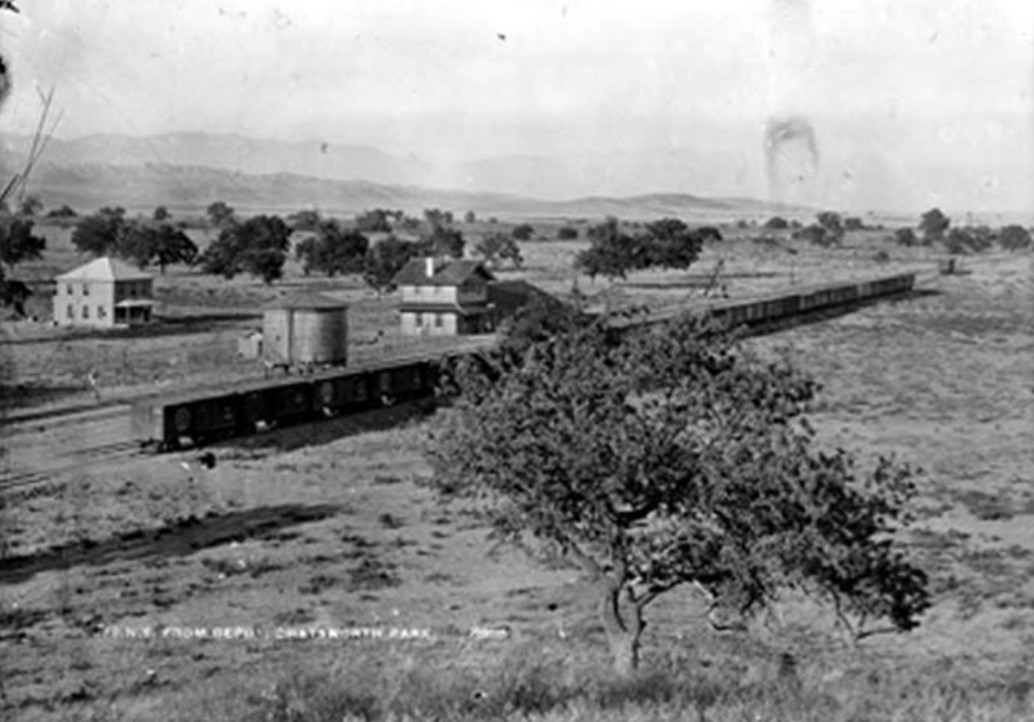 |
|
| (1893)^ - View of the first Chatsworth Park railroad station (center). A water tank and train are also visible as well as the 1890--built Chatsworth Hotel (center-left). Note the beautiful oak tree in the foreground. |
Historical Notes The above photograph illustrates the abundance of valley oaks (Quercus Lobata) in the Chatsworth region before the 1920s when reliable water sources for irrigation became available. The image may also be evidence of the density of valley oak that originally covered the entire Valley.^ |
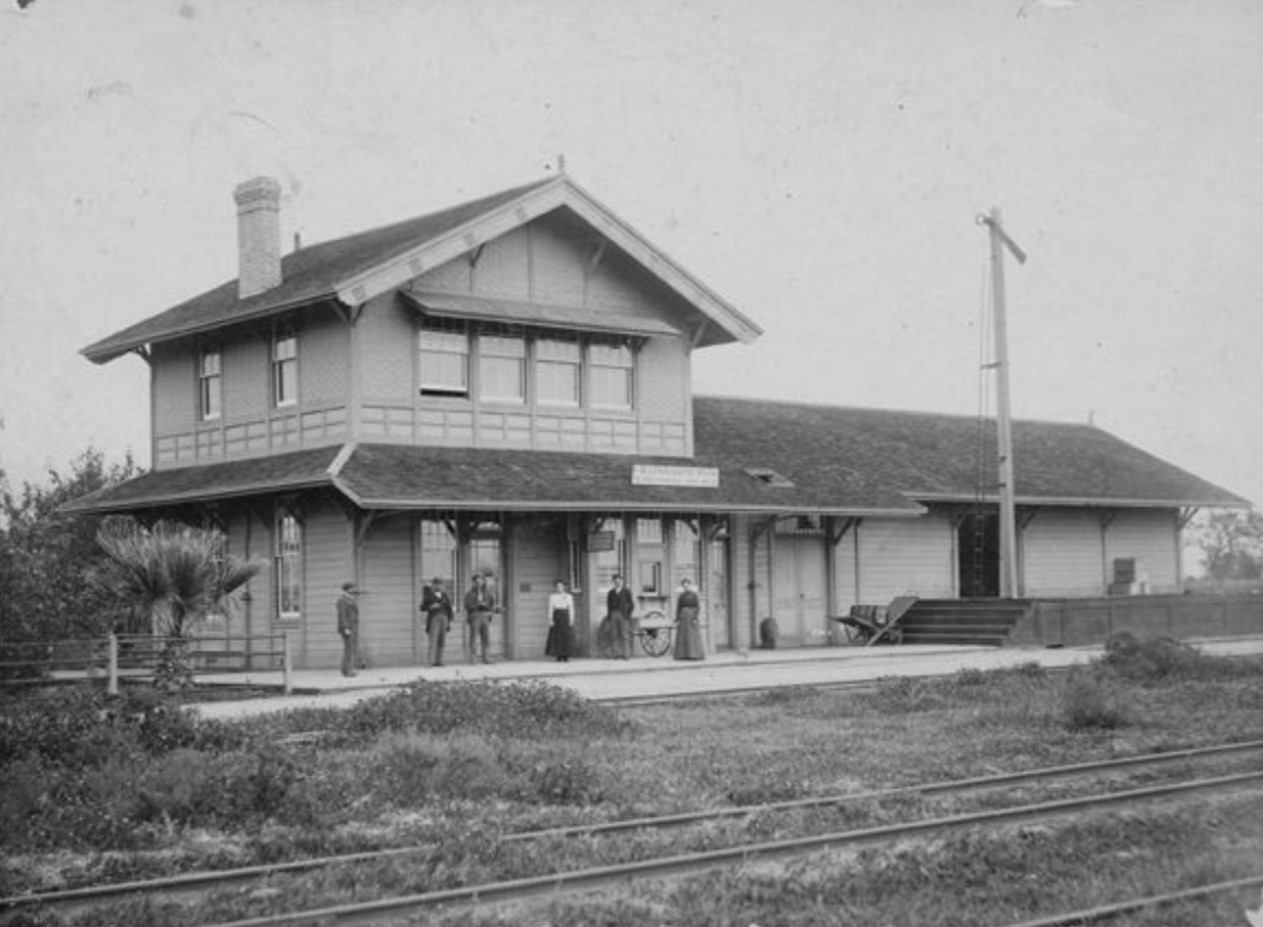 |
|
| (1893)^ - A closer look at Chatsworth's first railroad station, built 1893 and destroyed by fire in 1917. The sign on the station facing the tracks ("Trackside") reads, "Chatsworth Park, to San Francisco 494 miles" and the sign under the awning reads, "Western Union Telegraph Office." The station was located north of Marilla Ave and east of Santa Susana Avenue (later Topanga Canyon Boulevard). There were four tracks and a right-of-way between Marilla and the station. There was also a hotel (Chatsworth Hotel) located north (“Teamside”) of the station (see previous photo). Few records remain of the depot because Southern Pacific's records were destroyed in the 1906 San Francisco Earthquake. |
Historical Notes Once the railroad came to Chatsworth in 1893, the town's economy began to expand. First, the railroad gave farmers a broader market to sell their crops. Second, the construction of the Santa Susana railroad tunnel from 1898 through 1904 made Chatsworth one of the busiest places in the valley. Men came from all around the country to work on the tunnel. |
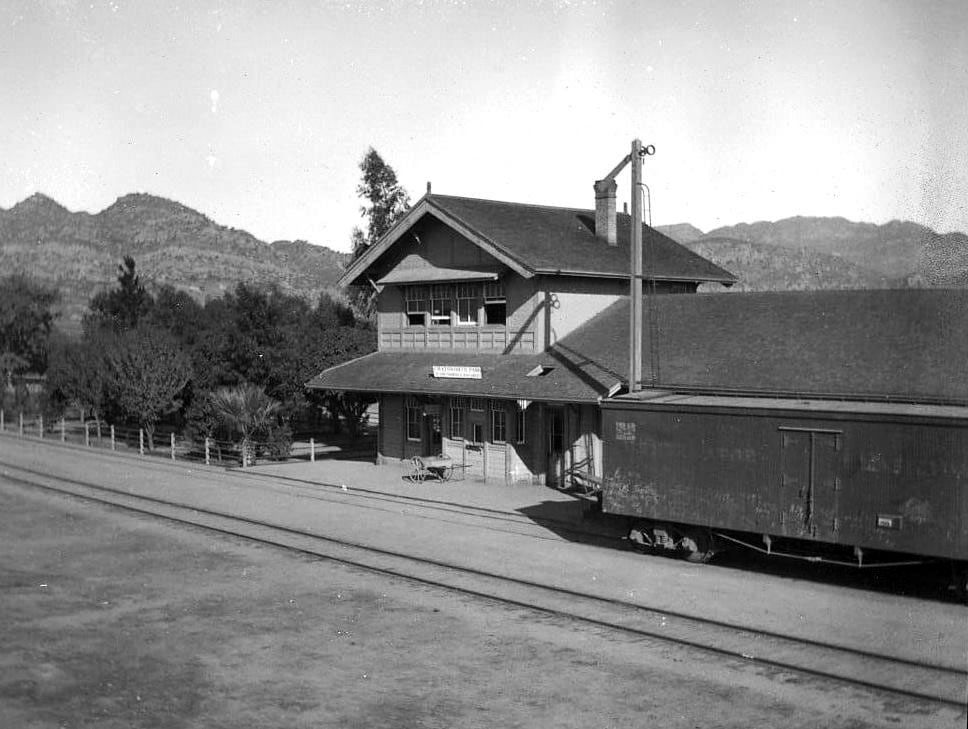 |
|
| (ca. 1906)^ – View looking NW showing the Southern Pacific Depot at Chatsworth Park with the Simi Hills seen in the background. Photo by R.A. Carpenter from the collection of his great-grandson, Rob Roche. |
Historical Notes The depot was built in 1893 and burned in 1917. |
 |
|
| (ca. 1890s)#^*^ – Panoramic view showing a train stopped just east of "Topanga" and north of the later Marilla. Stoney Point is seen in the background and the Train Station is at the right with the Chatsworth Hotel just behind it. The Hill/Graves store is at the left and Topanga (then Santa Susana Rd) dead ends at Marilla. |
Historical Notes In 1893 Southern Pacific Railroad completed the Burbank Branch to Chatsworth, ending along what is now Marilla and between what is now Topanga and Farralone. An additional mile of train track was also laid westward into the Chatsworth Park Quarry (Bannon Quarry) in 1898.^# |
 |
|
| (ca. 1902)* – Diagram showing the Chatsworth Park Depot, the Chatsworth Hotel, the turntable, and the engine shed in relation to each other. Source: "Southern Pacific in the San Fernando Valley" by David Coscia |
Historical Notes Fourth Street = present-day Topanga Cyn Blvd. Third Street = Farralone Avenue. |
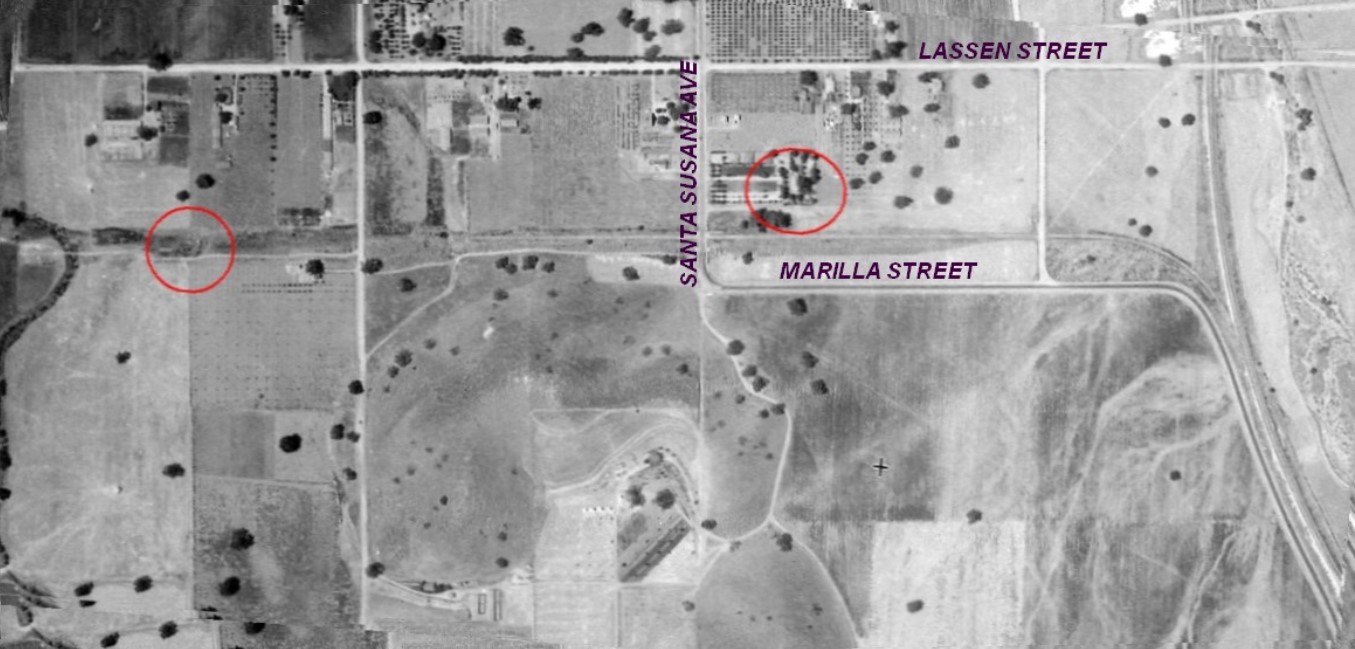 |
|
| (1930)^.^ - Aerial view showing where Marilla Street turns into Santa Susana Avenue (now Topanga Cyn). Remains of turntable is circled on the left, Chatsworth Hotel to the right. Annotations by William Flower |
Historical Notes For 11 years from the opening of the Burbank Branch Line of the SPRR in 1893 until the faster Coast Line and the tunnels were placed in service, the town of Chatsworth Park was the end of the line. Southern Pacific made heavy use of the Burbank Branch, for delivering building materials, livestock, equipment, hardware, tools, meat, produce, mail and passengers to various depots along its length. SP picked up plenty as well.. outbound produce, livestock, and passengers. There had to be a way to turn the locomotive around at the end of the line. Locomotives could move backward, but not with any speed.* |
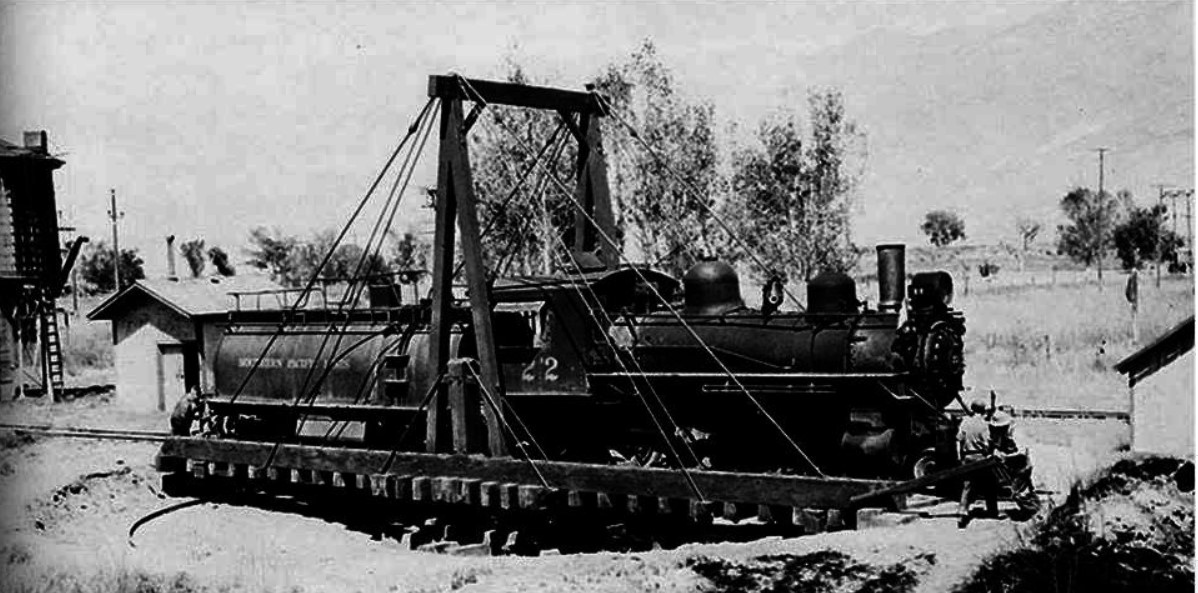 |
|
| (n.d.)^ - Two men are giving their all to get Southern Pacific No.22 turned around.. heave ho! Turntable similar to the one that existed in Chatsworth Park. |
Historical Notes The Bannon Quarry spur was placed in service from 1898 to 1915 to streamline the loading of up to fifty cars a day of oddly shaped "rip rap" for building the San Pedro Breakwater (1901-1905) as well as the Quarry's coveted role in providing dimensional sandstone for city buildings through 1915. Their locomotive was kept busy shuttling small numbers of flatcars up the grade to the quarry site, then down to the sidings at the Depot. Trains had to be assembled as well. This locomotive may have made use of the turntable while performing these roles. But for certain, any locomotive delivering 25 to 50 cars loaded down with rock to San Pedro would need to be at the head of the train, facing forward.* |
 |
|
| (1898)* - Cranes lift large boulders onto flatbed railroad cars at the Chatsworth Park Quarry (Bannon Quarry), located 1.5 miles northwest of the original Chatsworth Station (now Marilla and Topanga). |
Historical Notes A mile of track was laid in 1898 into Chatsworth Park, a canyon surrounded by the craggy sandstone formations of the Santa Susana Mountain Range where the Burbank branch terminated. At the right-of-way quarry above the park, sandstone formations were blasted into large boulders which would be used in the construction of the San Pedro Breakwater miles away. Derricks loaded the giant rocks carefully onto flat cars. Heavily laden trains traveled the newly built Burbank branch connecting to the main line at Burbank heading southward through Los Angeles towards San Pedro. |
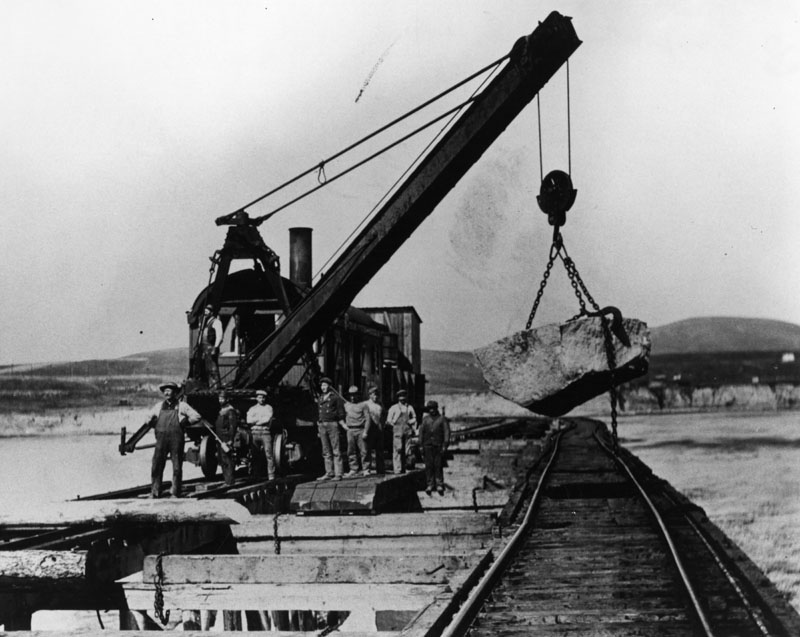 |
|
| (1904)* - Photo of workers building the breakwater in the San Pedro Harbor. Work was started in 1899. |
Historical Notes Most of the boulders used to construct the breakwater in San Pedro Harbor came from the mountains of west San Fernando Valley. Between 1898 and 1904, Southern Pacific was grading, cutting, and tunneling through the Santa Susana Mountains near Chatsworth Park as they establshed their new Coast Line connection from Ventura to Burbank. This provided San Pedro with an ample supply of boulders for their new breakwater. Click HERE to see more in Early Views of San Pedro and Wilmington. |
Chatsworth Tunnels
.jpg) |
| (1897)* - Seen in the left photo, the tunnel crew is begining the west end heading for tunnel No. 27. The right photo shows the tunnel finished and ready for the track laying gang. |
Historical Notes Construction was started for the three tunnels built for the Southern Pacific's new Montalvo Cutoff in 1898 and continued until 1904. This was to be the new Coast Line connection from Ventura to Burbank. Nearly twenty miles of new mainline trackage was also built across the San Fernando Valley between Chatsworth and the new Burbank Junction. |
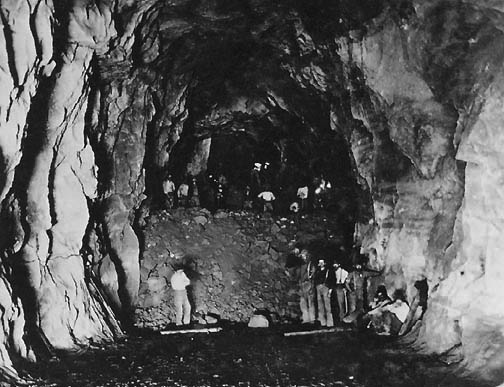 |
|
| (ca. 1898)* - Construction of Tunnel No. 26. The top half of the tunnel rock was removed first, then the lower part. Tunnel No. 26 is 1.4 miles in length (7,369 feet). |
Historical Notes Of the three tunnels (No.'s 26, 27 and 28) bored through the Santa Susana Mountains, the longest was Tunnel No. 26, being 7,369 feet in length. |
 |
|
| (ca. 1904)^^ - View of the west end of Chatsworth Park railroad tunnel. The rectangular entrance to the tunnel is at center, and a narrow railroad track leads out of it into the foreground, where it splits into two lines. |
Historical Notes The tunnels and right-of-way took five years to complete and by 1904, trains were running on the new Coast Line trackage. The San Fernando Valley stations along the Coast Line, in order, were Burbank, North Hollywood, Van Nuys, and Chatsworth. |
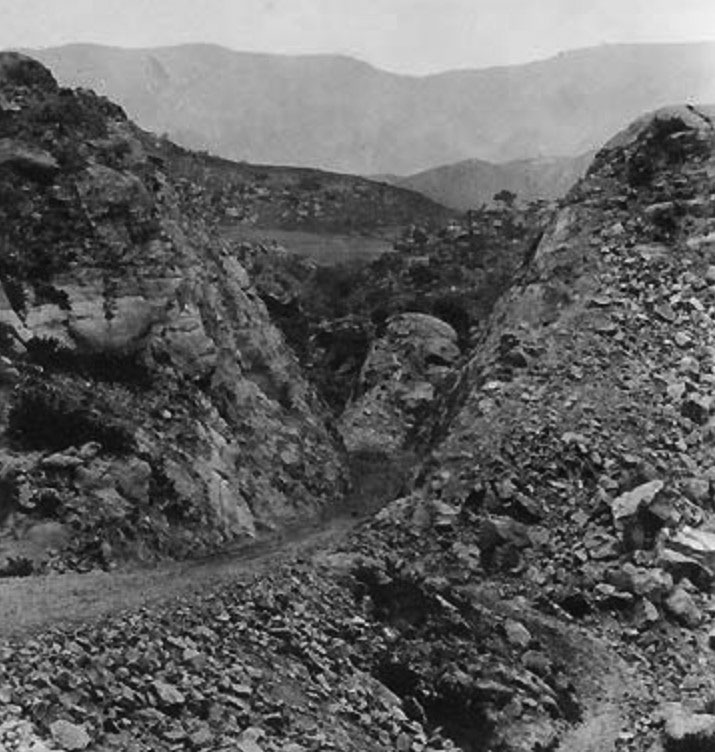 |
|
| (ca. 1900)#^*^ – View looking at the Santa Susana Mountains in Chatsworth Park near Tunnel No. 27 before tracks were built. |
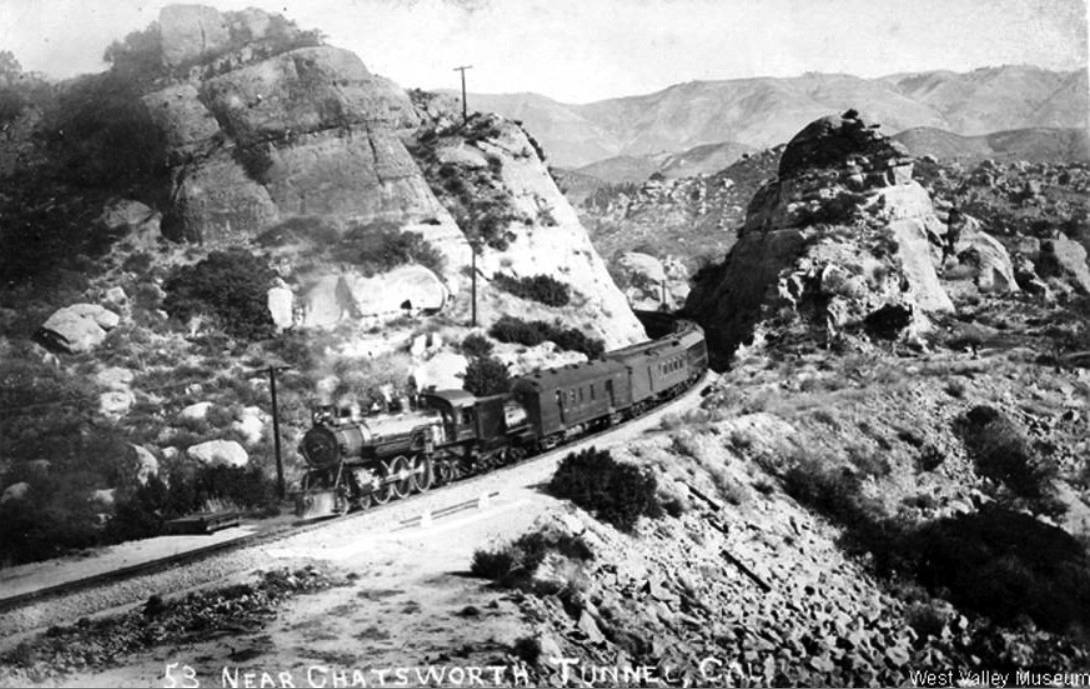 |
|
| (ca. 1914)^ - Postcard view of a Southern Pacific Train near Chatsworth Tunnel No. 27. |
Historical Notes The first car after the locomotive is a steel Railway Post Office Car carrying the mail. Steel cars were not built until circa 1910.^ |
.jpg) |
|
| (2008)^ – Interior view of the 7,369-ft long Tunnel No. 26 as seen from ground (rail) level. |
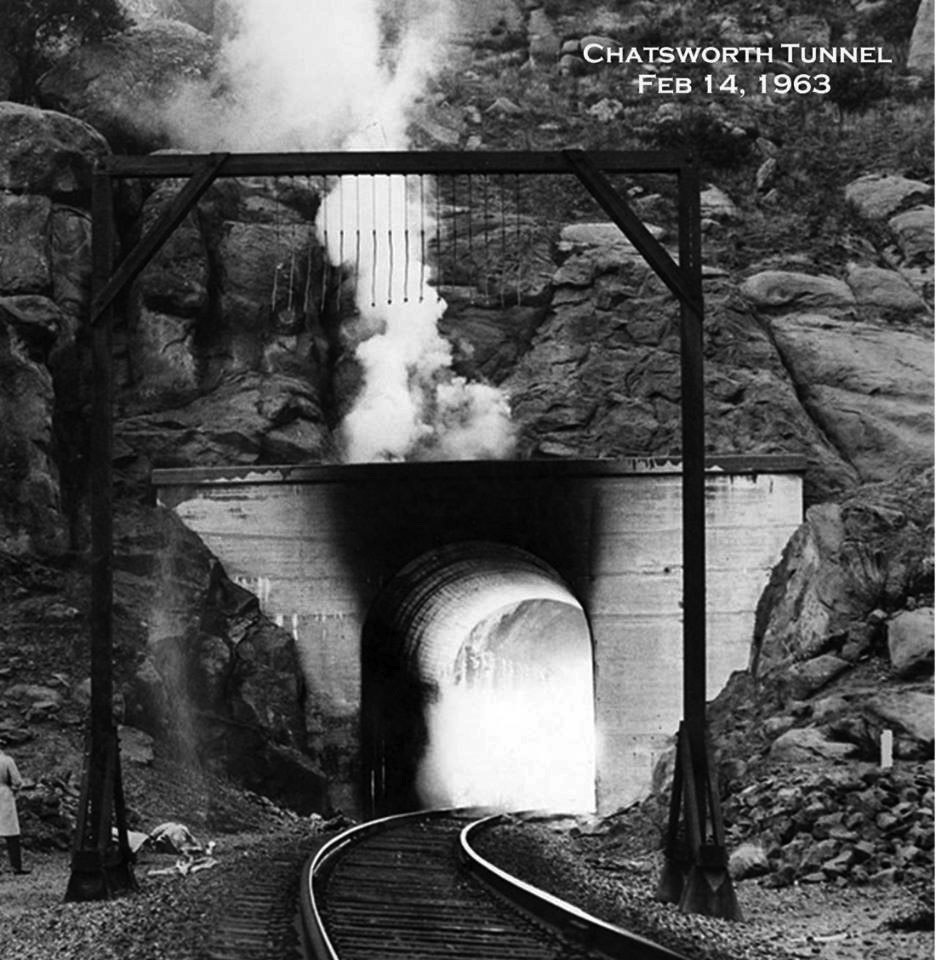 |
|
| (1963)^ - Flames and Smoke belch from Chatsworth Tunnel No. 27. Caption reads: "Fire officials say they will let the blaze burn itself out rather than send men into tunnel." |
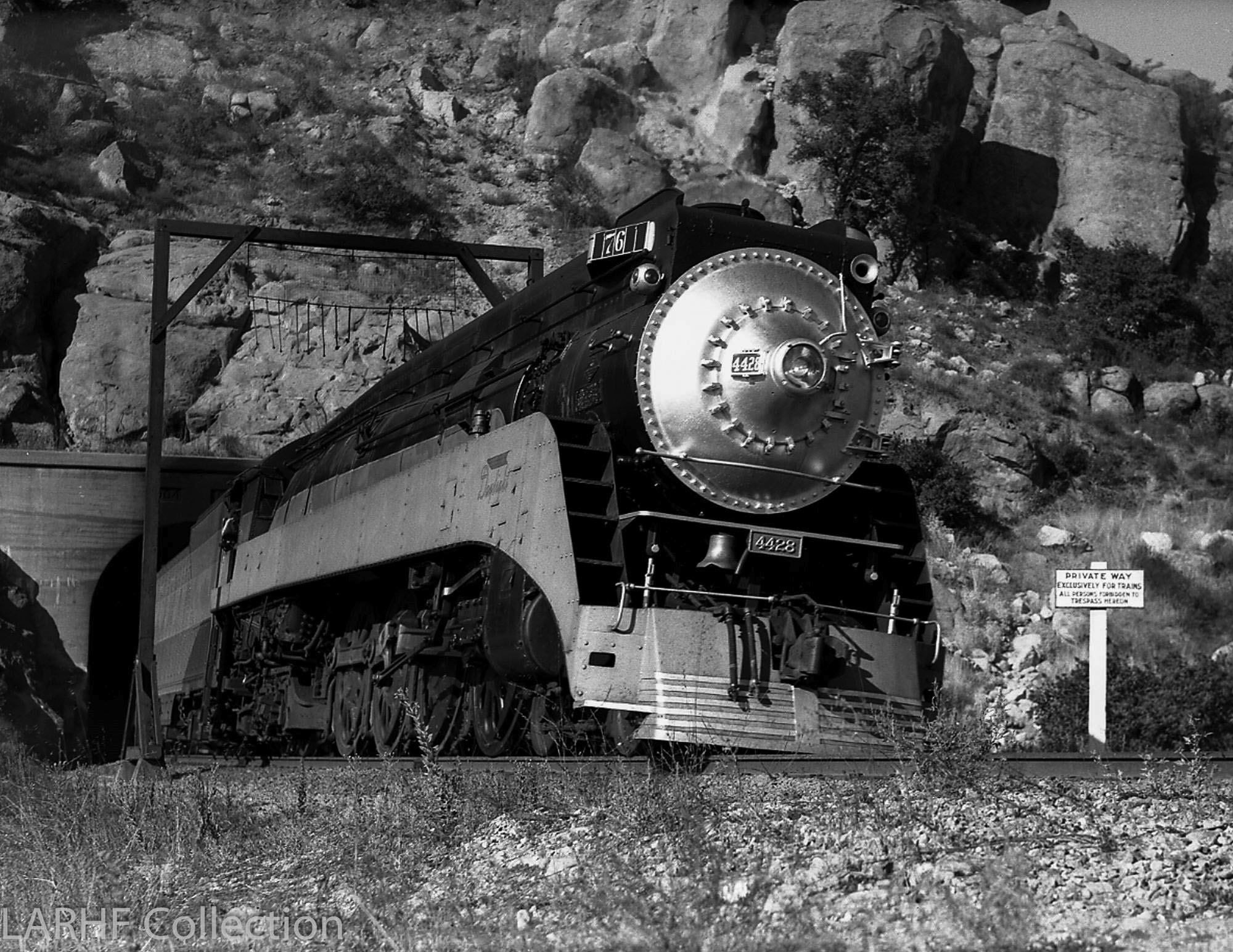 |
|
| (1948)^ - The Chatsworth Rocks in the Santa Susana Pass provide a dramatic frame for Southern Pacific's "Lark," train no. 76, as it emerges from tunnel No. 27 heading into Los Angeles in January 1948. (Photo by Frank J. Peterson / Donald Duke Collection / LARHF) |
Historical Notes No. 4428 seen above is a GS-3 type built in 1937, the first GS class with 80-inch drivers, and built to operate with a maximum speed of 106 mph. The Southern Pacific Lark was an overnight passenger train that operated between San Francisco and Los Angeles. It started its service on May 8, 1910, and became a streamliner in 1941, running until April 8, 1968. |
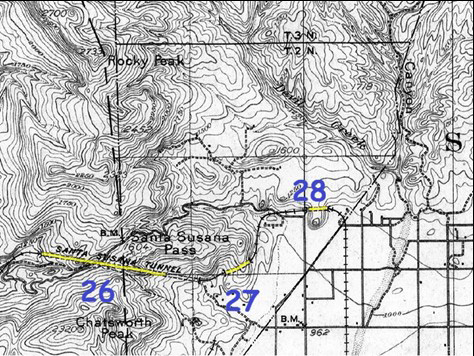 |
|
| (n.d.) – Topographical map showing locations of the three tunnels (26, 27, & 28) in Santa Susana Pass. The longest tunnel (No. 26) is 7,369 feet in length. Annotated map courtesy of William Flower |
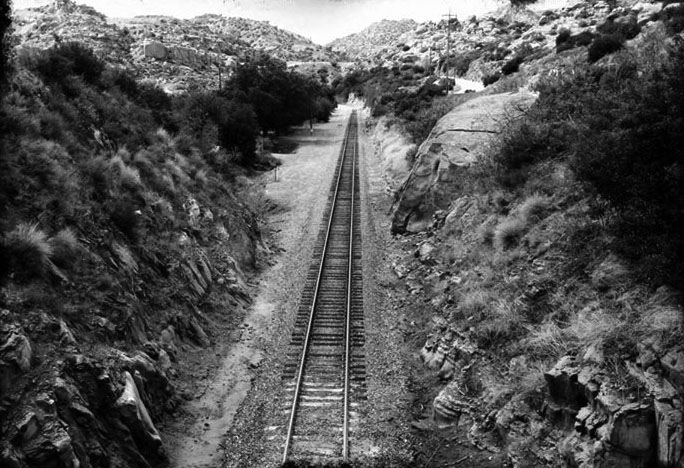 |
|
| (n.d.)^ - Heading westward from Tunnel No. 28, which passes near Stony Point. It's the only straight stretch of single track that sees daylight along this cavernous passage. |
Historical Notes As the brimming metropolis of Los Angeles continued to spill into the San Fernando Valley it created intensive building activity. Farms and ranches were giving way to homes and business. |
 |
|
| (n.d.)^ – Ground view looking down the tracks from the Simi Valley side of the Santa Susana Pass toward Chatsworth. |
Santa Susana School (later Chatsworth Park Elementary School)
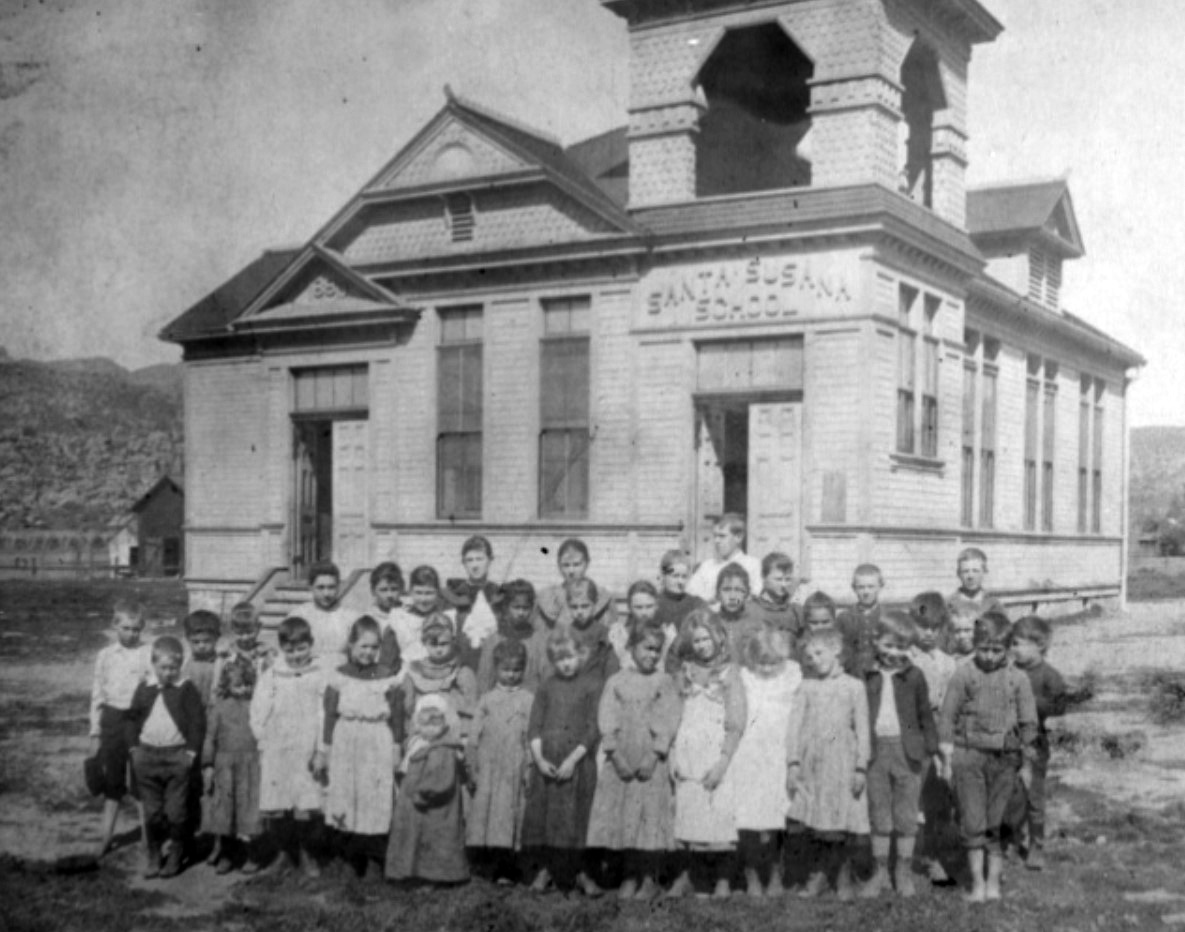 |
|
| (1902)^x^ - Group portrait of children in front of Santa Susana School (later Chatsworth Park Elementary School) located on the northwest corner of Devonshire and Topanga. The small child in the bonnet (first row) is Minnie Hill Palmer. |
Historical Notes The first school in Chatsworth Park had its early beginnings in the frontier home of Ann and Neils Johnson, who homesteaded land in the Santa Susanna Pass in 1874. At first Mrs. Johnson taught her own children at home in the evenings gathered around a kerosene lamp. As more families moved into the area, a school room was set up on a ranch located on Santa Susanna Avenue just below Chatsworth Street on the east side. In 1890, the first Chatsworth Park school building was constructed at the present site of Devonshire and Topanga. N.A. Gray donated the land on which to build the school. Chatsworth Park's first teacher was Miss Mary Gower of Hollywood and Mrs. Johnson was the clerk of the board of trustees. Mrs. Johnson's daughter, Lenora Johnson was another early teacher at the school.^ |
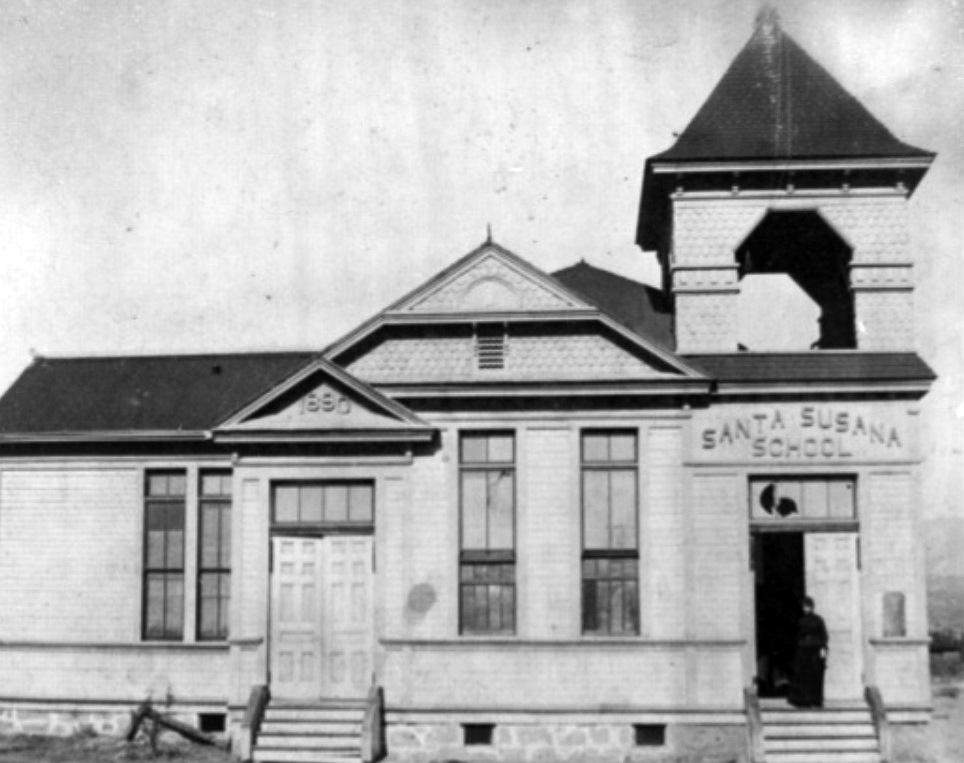 |
|
| (1890s)^x^ - Close-up front view of Santa Susana School with woman seen standing in the doorway. |
Historical Notes In the 1880's parents were reluctant to send their children to school because they needed their help working on the family ranches. There are stories of Mrs. Johnson driving around in her buggy picking up children to maintain the minimum number students needed to keep the school open.^ |
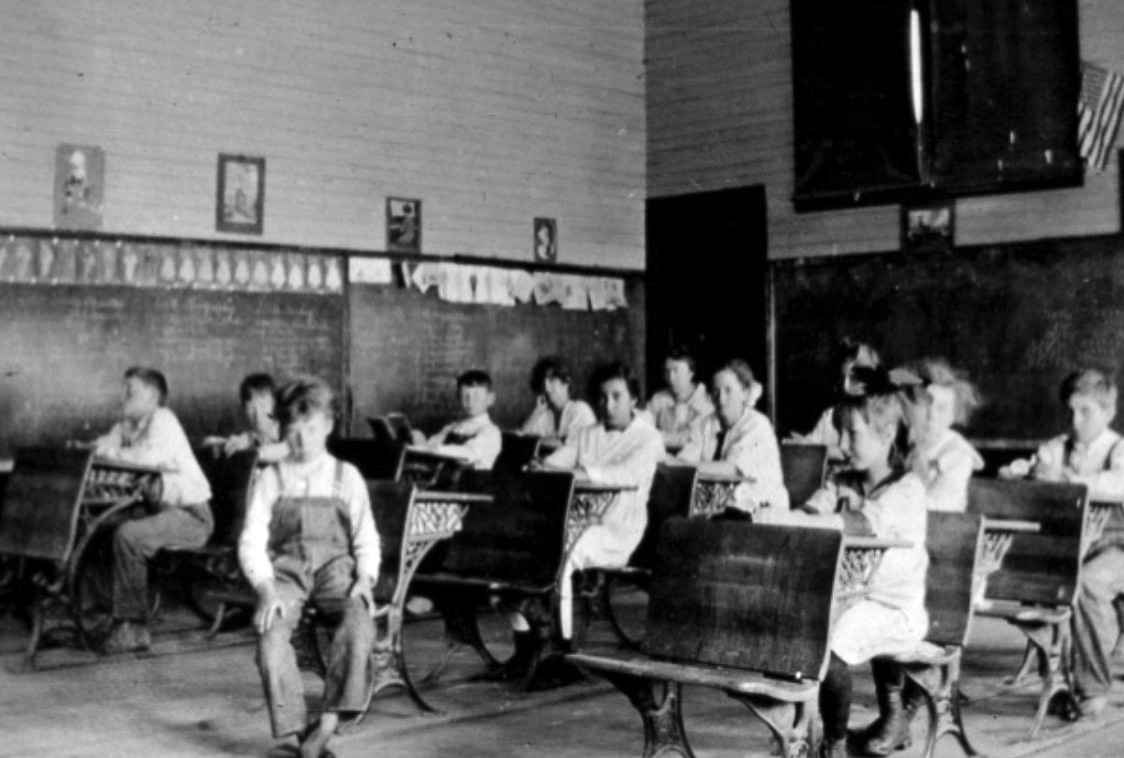 |
|
| (ca. 1900)^x^ - Interior view of the Santa Susana Schoolhouse with children sitting at their desk. |
Historical Notes In 1902, the school name was changed to Chatsworth Park Elementary School to avoid confusion with the new 1902 Santa Susana School built in Simi Valley. Click HERE to see more Early Views of Chatsworth Park Elementary School. |
* * * * * |
 |
|
| (ca. 1900)^ – View showing Ann Johnson in front of her home in Chatsworth Park (later "Park" was dropped from the name). |
Historical Notes Verso of photograph reads: "The home she and Niels carved from the wilderness." This residence was one of the first buildings in Chatsworth, constructed circa 1870. Settlers Ann and Neils Johnson came to the area in the 1870s and carved a home from the wilderness. Mrs. Johnson became the first English-speaking woman to live in the San Fernando Valley and her daughter, Emma Johnson Graves, is said to be the first blue-eyed baby born in the Valley. Following the Johnson's, many families homesteaded on the land available outside the mission land grant, forming the beginnings of a community. |
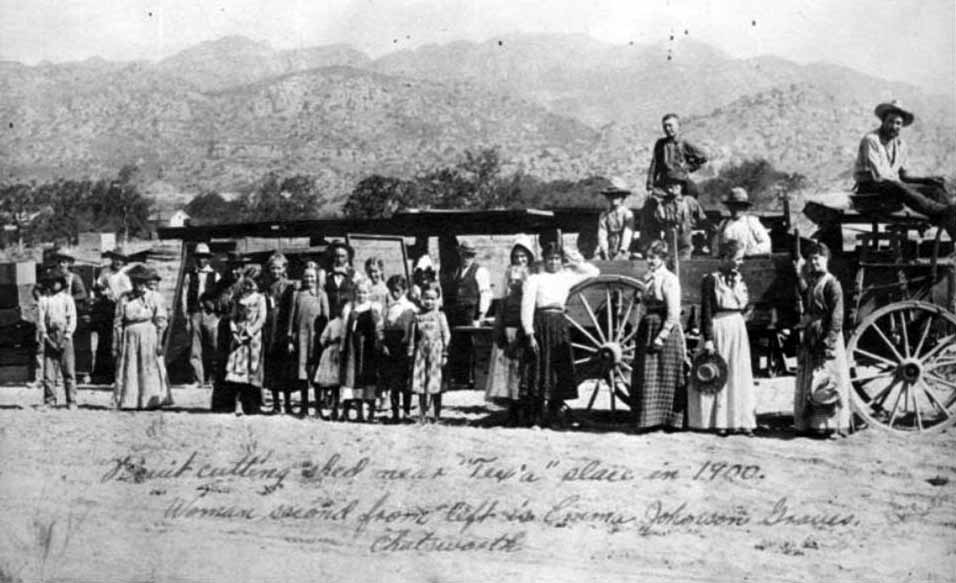 |
|
| (1900)^ - Group picture of farm workers in Chatsworth. Fruit cutting shed in rear of this portrait of farmworkers in Chatsworth, near the "Tex'a" place. The second woman on the left is Emma Johnson Graves. |
* * * * * |
Topanga and Lassen - Chatsworth
.jpg) |
|
| (1911)* - Graves & Hill General Store. Lowell Hill, a part owner, is standing in front of the store. The store was located on the northwest side of the street at the intersection of Lassen Street and Topanga Canyon Boulevard. |
Historical Notes Lowell “Lovell” Hill, part-owner, stands in front of the store, located on the northwest corner of Topanga Canyon Boulevard and Lassen Street—about where the Country Deli stands today. This was Chatsworth’s third Post Office location (circa 1900–1915) and the heart of the small rural community. The store was co-owned by Fred “Jess” Graves, former sheriff of Chatsworth, and Lovell Hill, older brother of pioneer Minnie Hill Palmer. The building was much more than a grocery—it was the town’s general store, post office, and informal meeting hall. Locals came here for provisions, to collect mail, hear the latest news, and chat with neighbors. The Hill family lived on their homestead at 10385 Shadow Oak Drive, today preserved as The Homestead Acre with the 1911–1913 Minnie Hill Palmer House, the last remaining Valley pioneer homestead. |
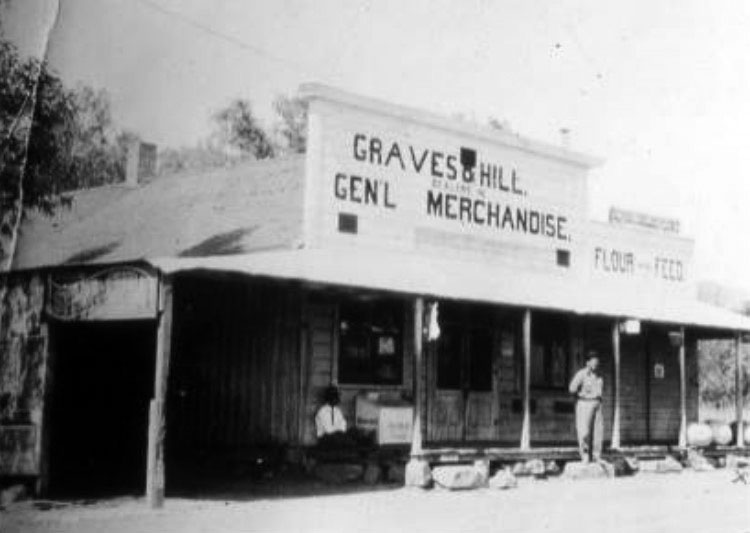 |
|
| (1910s)* - View showing two men in front of the Graves & Hill General Merchandise Store at Topanga and Lassen, Chatsworth. |
Historical Notes This early 1910s view shows two men outside the Graves & Hill store, which operated at this location from 1906 until 1915. Graves and Hill had purchased the property after the deaths of the previous owners, Mr. and Mrs. Jackson. Lovell Hill served as Chatsworth postmaster from July 1912 to March 1915, operating out of the store. Beyond its postal role, the store supplied farm tools, hardware, dry goods, and staples, extended credit to residents, and served as a social gathering spot in the days when Chatsworth’s population was just a few dozen families. |
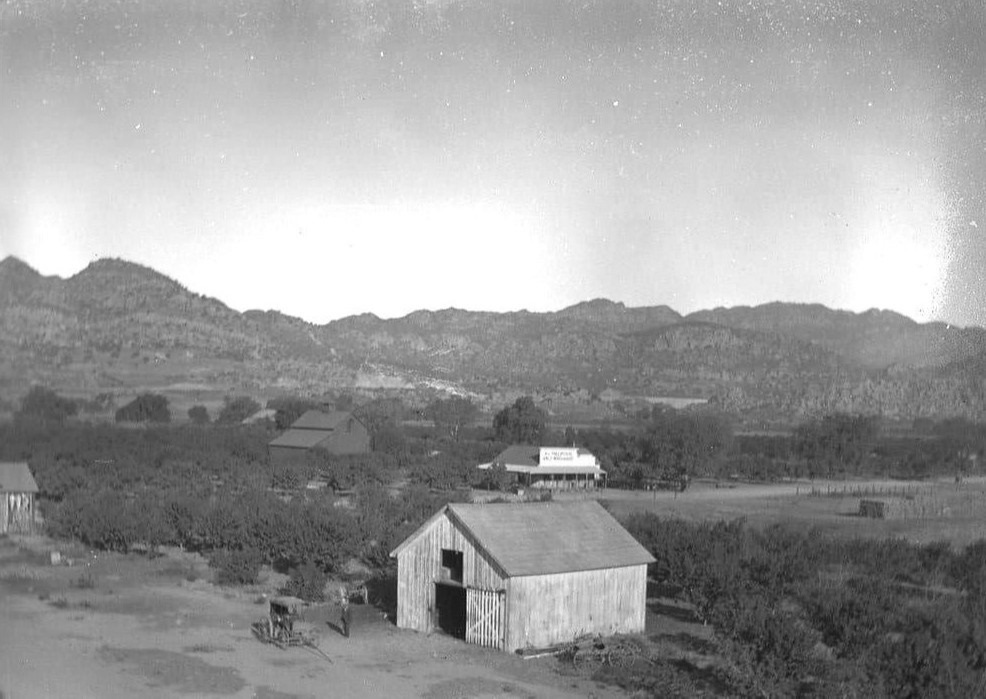 |
|
| (ca. 1910)* - View looking NW showing structures to the east of the SP Chatsworth Park depot. In the distance is the Graves & Hill General Merchandise Store at what is now near Topanga and Lassen. |
Historical Notes From this vantage point near the Southern Pacific Chatsworth Park depot, the Graves & Hill General Store can be seen in the distance, anchoring the small commercial strip along what would become Topanga Canyon Boulevard. The depot, just to the southwest, linked Chatsworth to the wider San Fernando Valley and Los Angeles via the rail network. By this time, the old Santa Susana Stage Road had largely been replaced for freight and passenger service by the Southern Pacific rail line through the Santa Susana Pass. The proximity of the store to the depot made it a natural gathering point for ranchers, farmers, and townspeople meeting arriving trains or shipping produce. |
Then and Now
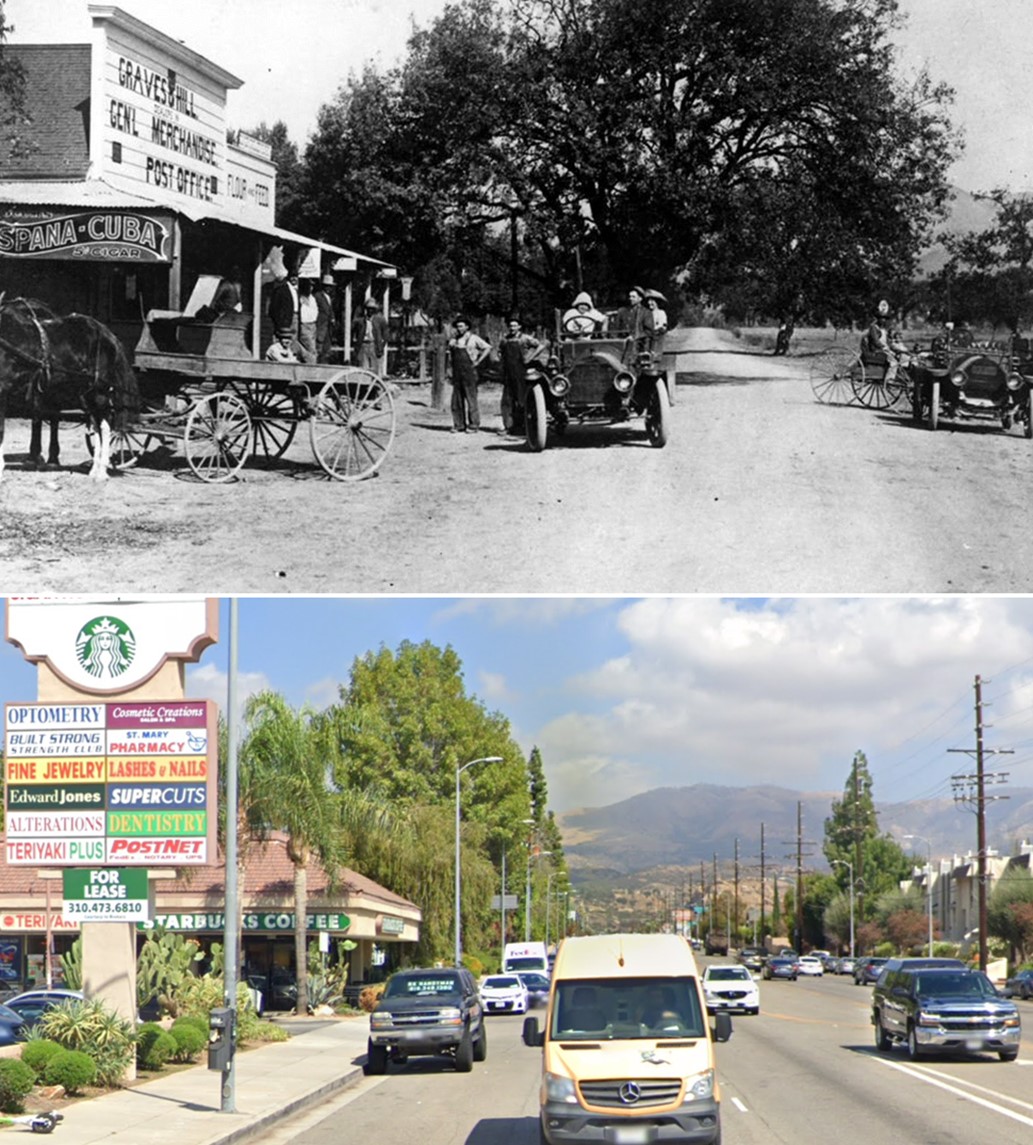 |
|
| (1911 vs 2022)* - Looking north on Topanga Cyn Blvd from near Lassen Street in Chatsworth. Photo comparison by Jack Feldman. |
Historical Notes In 1911, this intersection was the commercial heart of Chatsworth, marked by wooden storefronts, hitching posts, and dusty roads. Residents gathered here for goods, mail, and social exchange. By 2022, the same stretch remains a commercial corridor, though transformed with modern strip malls, asphalt, and cars. The mountains in the distance remain the most visible reminder of the original setting. The Country Deli and nearby shops occupy the ground where Graves & Hill once stood—linking today’s landscape to more than a century of community history. |
* * * * * |
Chatsworth Hotel
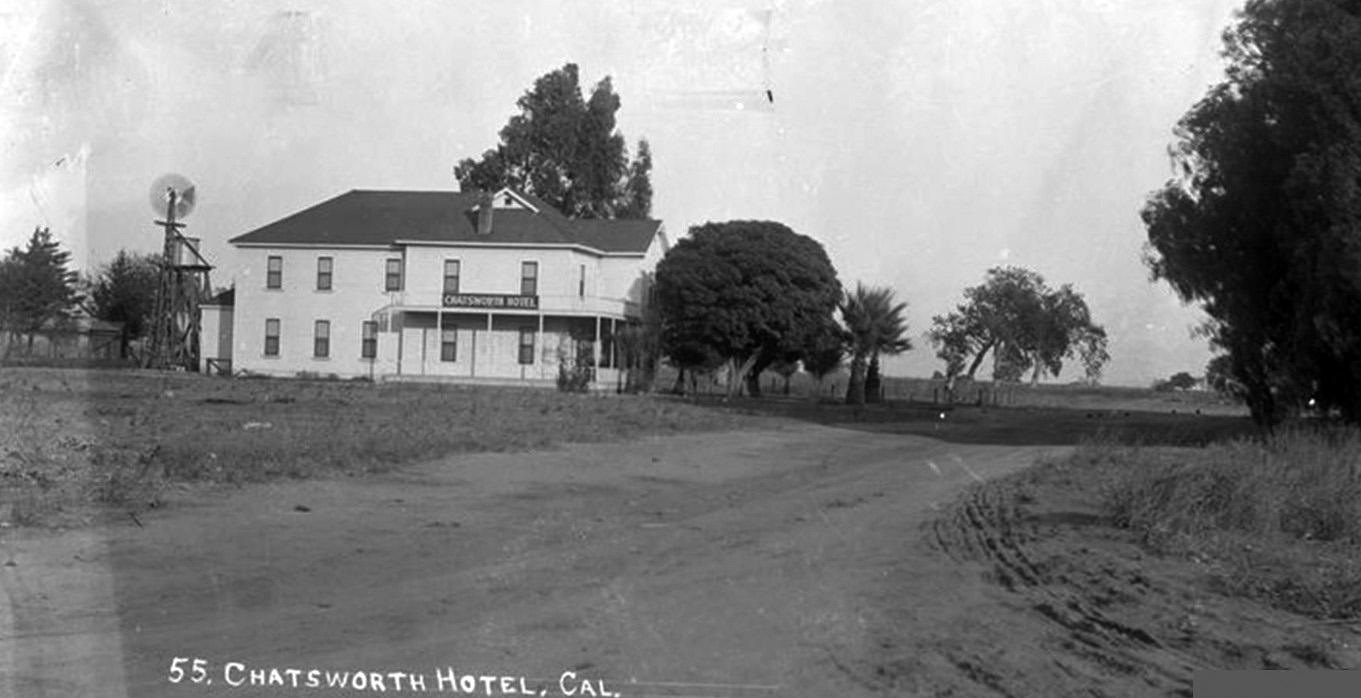 |
|
| (n.d.)* - View showing a dirt road leading to the Chatsworth Hotel located just north of the Chatsworth Park Train Depot. Today this is the site of the Staybridge Suites, 21902 Lassen Street. |
Historical Notes The Chatsworth Hotel opened in 1890, and later operated as The Chatsworth Inn. A true "roadhouse" in its day, by its reputation as a "drinking club" and the only supplier of booze in a "dry town"; by its location at the crossroads of paths being forged through Chatsworth to points beyond; by its connection to the Southern Pacific Railroad and its record-breaking tunnel; and by its frequent use by the burgeoning film industry and its rising stars. |
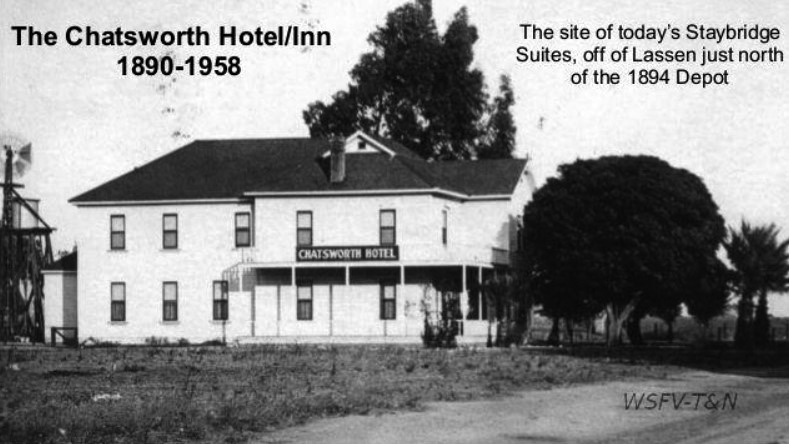 |
|
| (n.d.)* - Close-up view of the Chatsworth Hotel / Inn. This is the site of today's Staybridge Suites, off of Lassen just north of the 1894 Depot. |
Historical Notes Built in 1890, the Chatsworth Inn was known for splendid meals and true western hospitality. Stars of silent picture days, railroad brass and the common man mingled here during heyday. |
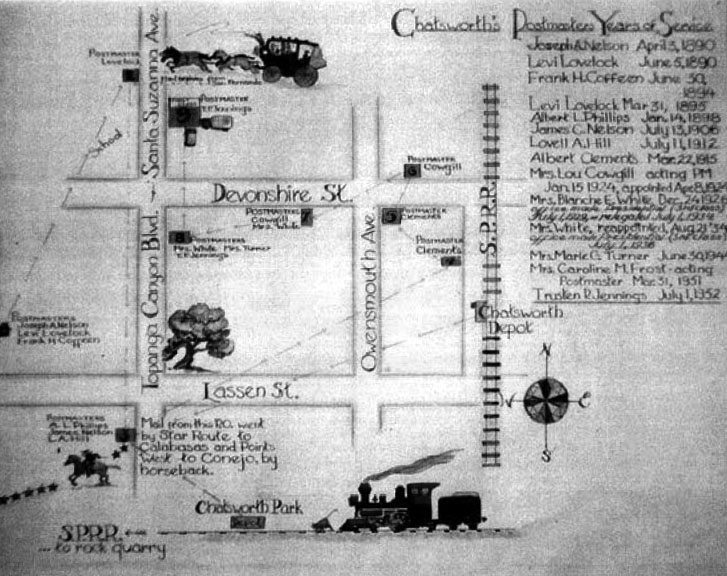 |
|
| (n.d.)^# - Photograph of a poster showing the various locations of the Chatsworth Post Office made by a former Chatsworth woman, Mrs. Elsa Braun. It was made for the opening of the Post Office when it was located on Topanga Canyon Boulevard just north of Devonshire Street in the 1950s. The poster shows the list of Postmasters and shows where the Post Office was located during their terms of office. |
Historical Notes Chatsworth is located to the southeast of the Santa Susana Pass, an extremely steep mountain pass that stagecoaches had to traverse when travelling the Overland Stage Road from Los Angeles to San Francisco. Santa Susana became a relay station for the stagecoach lines where the drivers would trade in their tired horse before attempting to cross the Overland Stage Road. Being located near a relay station made Chatsworth an important town in term of transportation history in California. As late as 1891, Chatsworth remained an active relay station for the stagecoach lines. The location of that first post office was on the stage line at the foot of the Santa Susana Mountains on the northern boundary of Oakwood Memorial Park. And it was not far from the stagecoach marker that can be seen from Chatsworth Park South today. |
* * * * * |
Santa Susana Pass Wagon Road
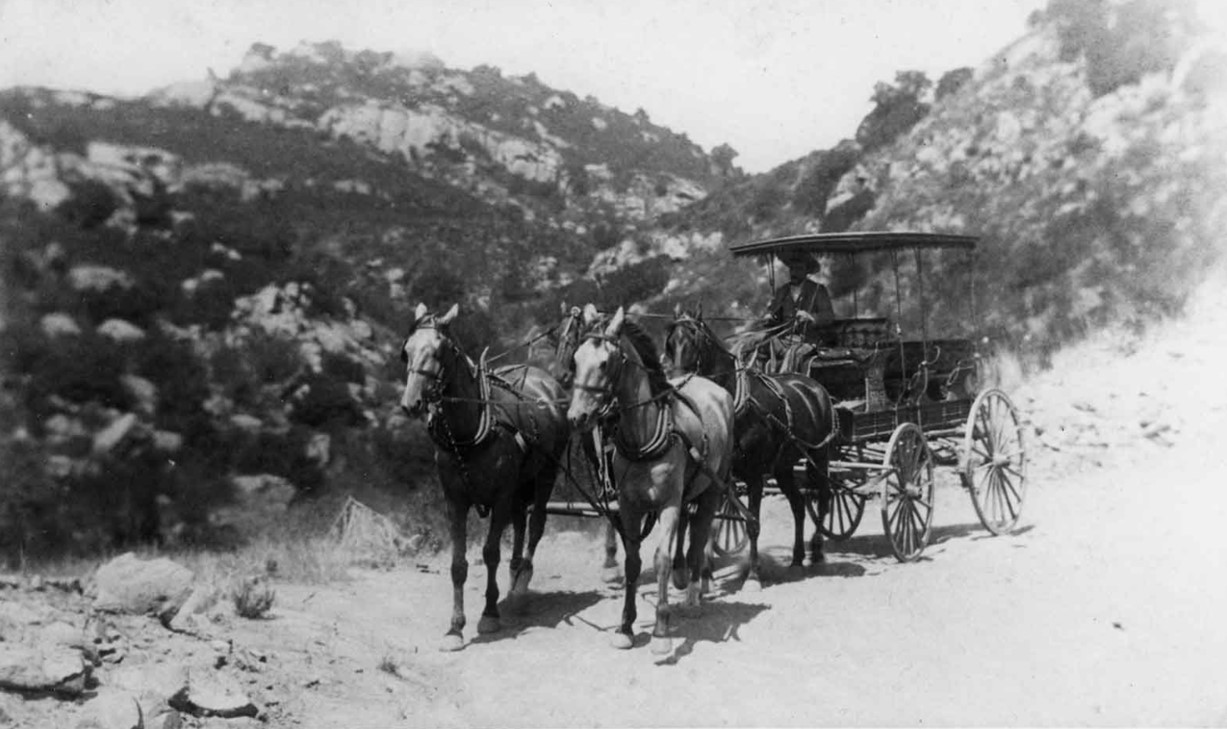 |
|
| (ca. 1890)* – View showing Joe Horner in Stage Wagon on the Stagecoach Trail. Joe Horner ran the Simi Stage from Simi Hotel to San Fernando in 1890. |
Historical Notes There have been three Santa Susana Pass Roads over the years: ◆ The first road, the “Santa Susana Pass Wagon Road”, was in use from 1859-1895. It became known as the Stagecoach Trail, and was also called “Devil’s Slide”. ◆ The second road was built north of the first road, “The New Santa Susana Pass Road through William’s Cañon”. It was a graded dirt road and in use from 1895 to 1917. It was commonly called the Chatsworth Grade Road, and is called El Camino Nuevo on the Santa Susana Pass State Historic Park maps. ◆ The third road was built just north of the second road in 1917, was paved with asphalt, and is known today as the Santa Susana Pass Road. |
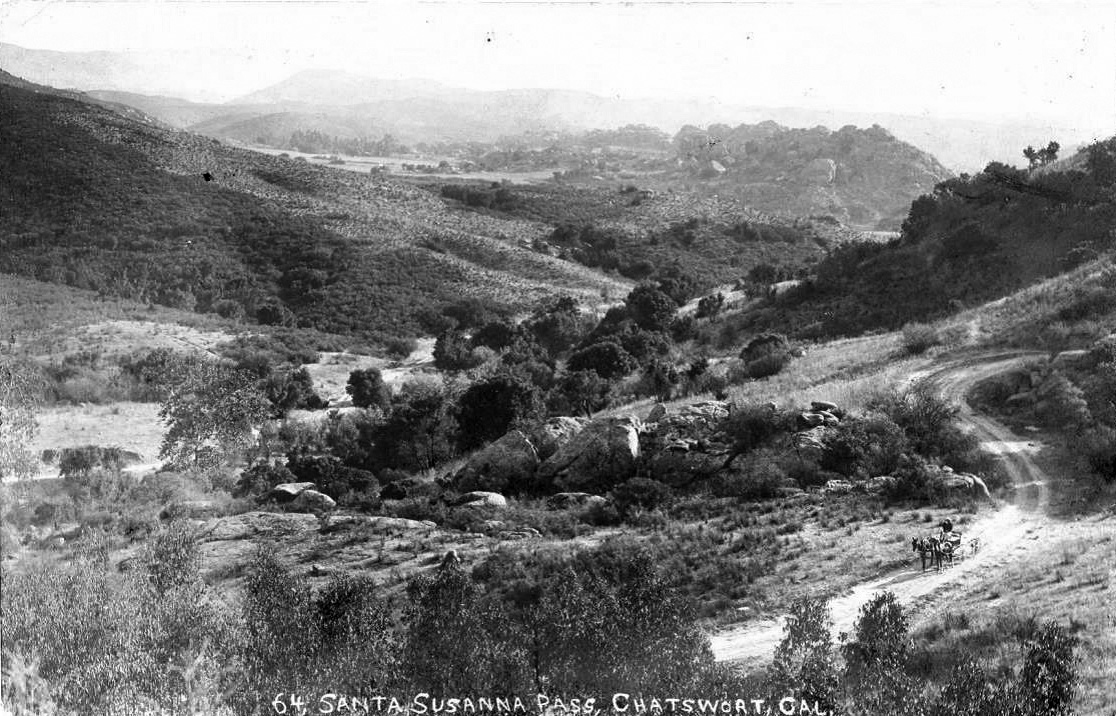 |
|
| (1912)* - Postcard view looking east on the 1895 Chatsworth Grade Road, before the current Santa Susana Pass Road was completed in 1917. Horse-drawn wagon facing west but traveling east to Chatsworth on a switchback. Photo courtesy of the Chatsworth Historical Society |
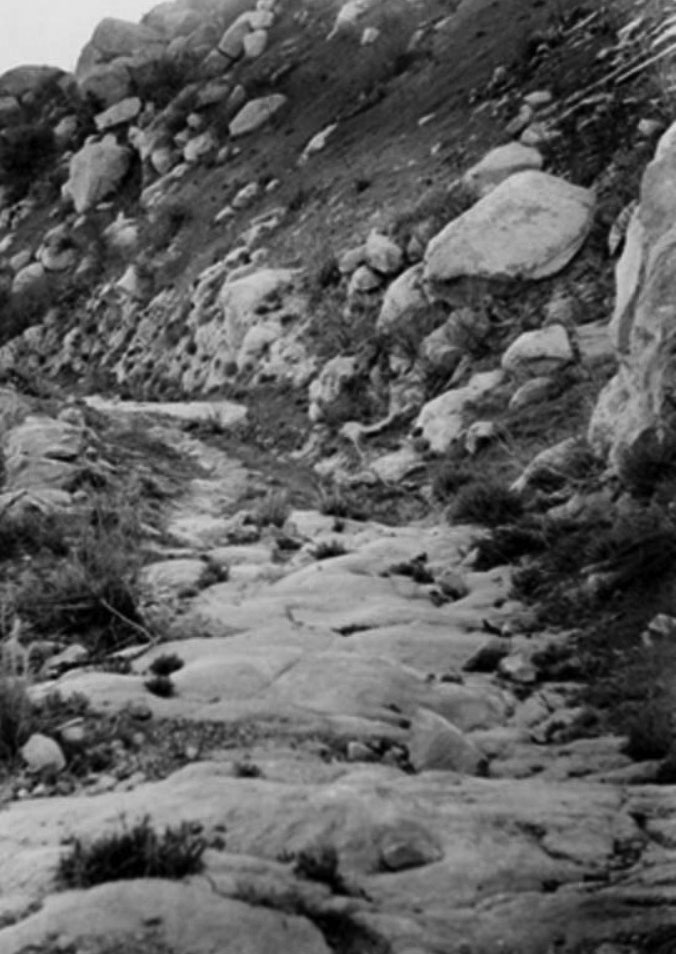 |
|
| (1971)* - Old stage coach road in Chatsworth shows the rough terrains over which the stage lines traveled. |
Historical Notes In 1859, the state put up $15,000 to fix up the Santa Susana Pass Wagon Road, under the supervision of James P. Thompson. Thompson was also the man awarded the contract to use the pass for carrying mail. The first overland stagecoach to use the pass made its run between San Francisco and Los Angeles on April 6, 1861. The trip took 72 hours. Devil’s Slide, was the portion of the trail where the grade was so steep that extra precautions were needed to prevent accidents involving runaway coaches. These precautions included tricks such as tying wheels together, using a windlass, blindfolding easily spooked horses, and cutting step grades into the stone paths. The Santa Susana Pass became the main transportation link between L.A. and San Francisco during the Civil War and remained so for about a dozen years. However, a group of new owners abandoned the stage line in 1875, although local ranchers and farmers continued to use the pass. The Chatsworth Grade Road (pretty much the 118 today), built in 1895, rendered the old Santa Susana Pass obsolete. |
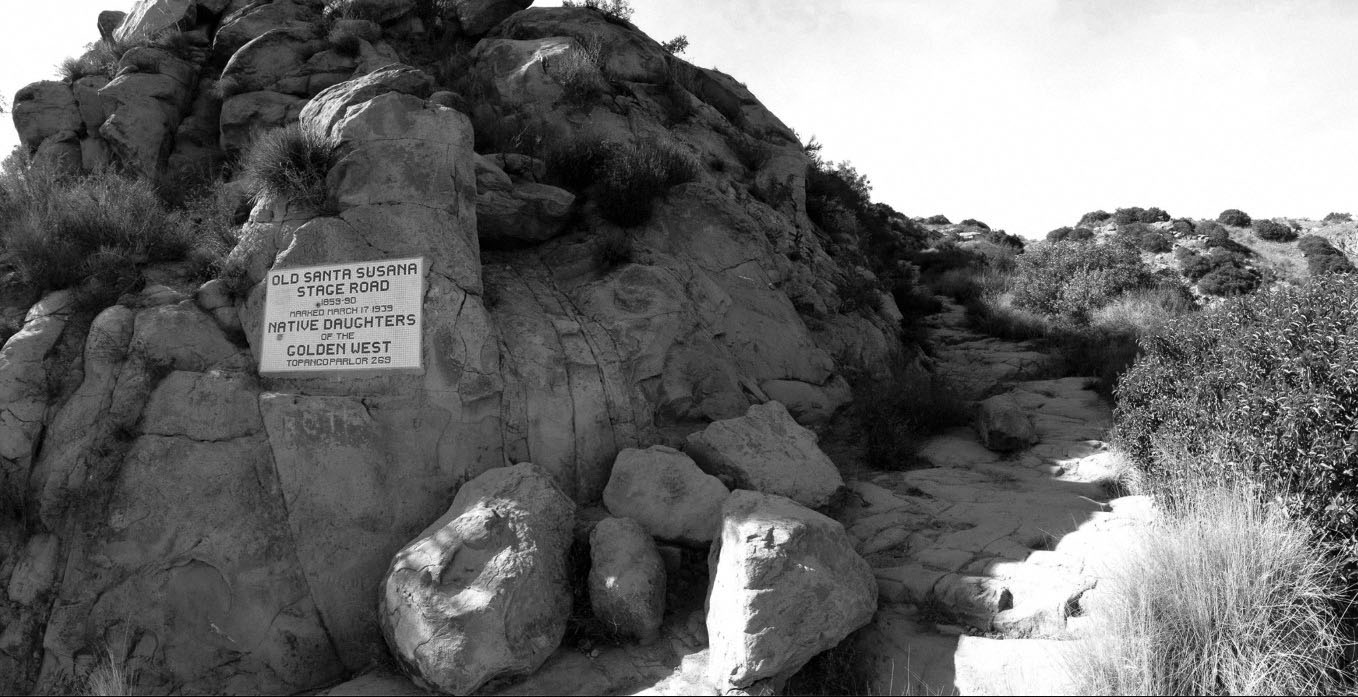 |
|
| (n.d.)*– View showing the remains of the Old Santa Susana Stage Road. Hewn out of solid rock, the route was used by the Overland Stage Company. Plaque reads: “Old Santa Susana Stage Road, 1859-90 - Marked March 17, 1939 - Native Daughters of the Golden West – Topanga Parlor” |
Historical Notes The road dates from the 1860's and represents a period in the Valley when the trail linked Los Angeles, Encino, Simi Valley, and Ventura. In 1972, the Old Stage Coach Property was designated LA Historic-Cultural Monument No. 92 (Clcik HERE to see complete listing). |
 |
|
| (ca. 1910)* – View of Chatsworth looking east from the old Santa Susana Stage Road. Tunnel 27, one of the three Chatsworth Tunnels constructed between 1898 and 1904, is visible on the left. The clearing in the center marks present-day Chatsworth Park South, while the newer rail station appears in the upper right, still under construction, with its second story not yet visible. |
Historical Notes In the early 1900s, Chatsworth had two train depots: The original depot, built in 1893, was located at the northeast corner of Marilla and Topanga. A second depot was constructed around 1910, south of Devonshire on the west side of the tracks. These two depots coexisted for several years until the first depot was destroyed by fire in 1917. |
Then and Now
.jpg) |
|
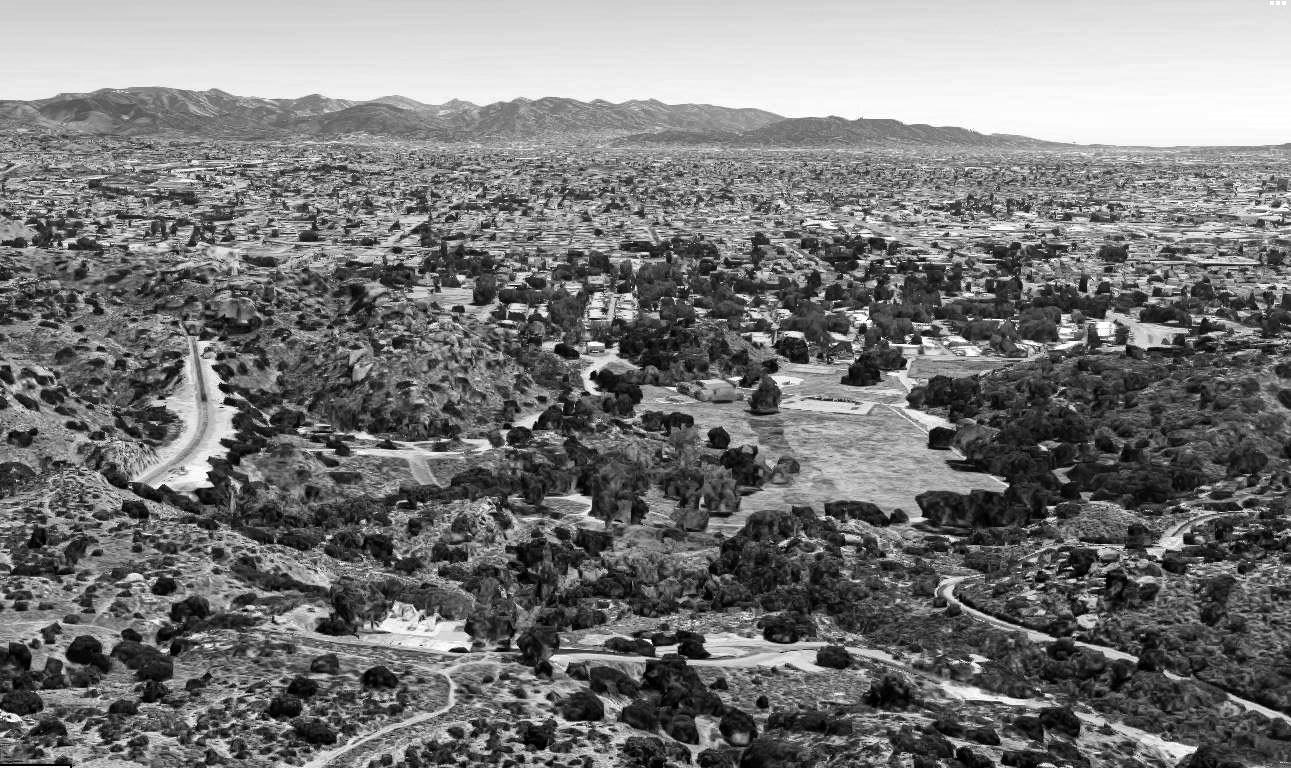 |
|
| (1910 vs 2019)* |
* * * * * |
The Homestead Acre
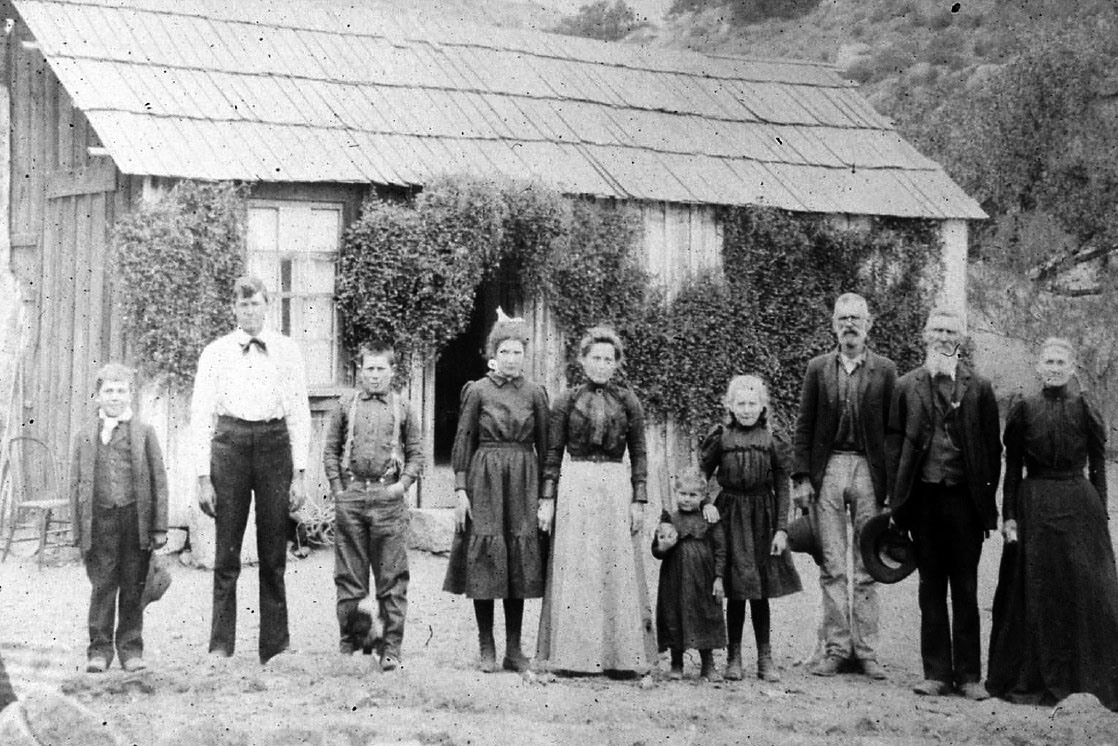 |
|
| (ca. 1900)* – The Hill Family standing in front of the original Homestead House in Chatsworth Park South. James and Rhoda Hill are to the right. Minnie is in the center with black stockings. |
Historical Notes In the spring of 1886, James David and Rhoda Jane Hill homesteaded 110 acres in Chatsworth Park South. It is a portion of their property which is known as "The Homestead Acre" where the Chatsworth Historical Society is currently located. The Hills had eight children, two of whom were born in Chatsworth. Their seventh child, Minnie, was born in November 1886 and lived the majority of her life in Chatsworth. |
 |
|
| (ca. 1911)* – View showing the Minnie Hill-Palmer Residence soon after it was built with the Susana Mountains in the background. Minnie's sisters are sitting on the porch and Lovell, Minnie's brother, is seated in an early EMF automobile. |
Historical Notes Between 1911 and 1913, the Hill family built a cottage on Homestead Acre. Minnie Hill and her husband, Alfred Palmer, lived in this house, now known as the Hill-Palmer Homestead Cottage. Minnie lived there until shortly before her death in March 1981. The Hill-Palmer Cottage is the only remaining homestead cottage in the San Fernando Valley. Surrounded by a garden and fruit trees, many of which were planted by Minnie Hill-Palmer. The Hill-Palmer Cottage was named to the National Register of Historic Places in 1979. |
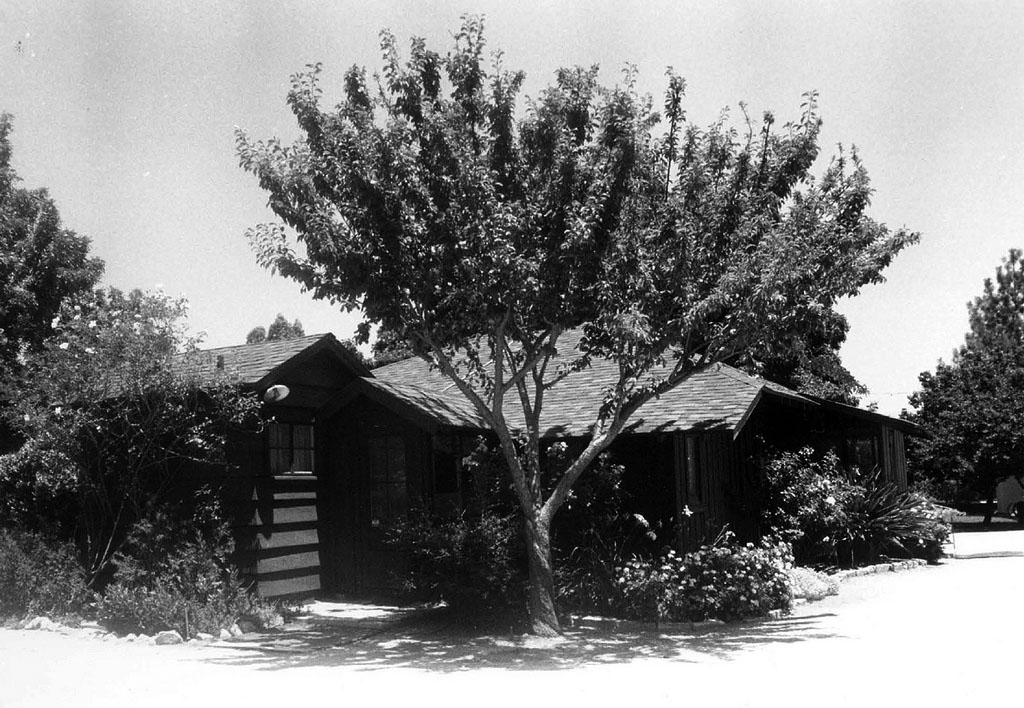 |
|
| (2008)* - View of the Minnie Hill Palmer Residence at 22360 Devonshire Street, built in 1911. The house was designated LA Historic-Cultural Monument No. 133 in 1974 (Click HERE to see complete listing). |
Historical Notes The Minnie Hill Palmer House, also known as The Homestead Acre, is the only remaining homestead cottage in the San Fernando Valley. The cottage is a redwood Stick-Eastlake style American Craftsman-Bungalow located on a 1.3 acres site in Chatsworth Park South, Chatsworth. The Homestead Acre and Palmer House have been preserved as they were in 1911 when the surviving cottage was built. It is owned by the City of Los Angeles Department of Recreation and Parks and maintained by the Chatsworth Historical Society as a monument. The city maintains the building's exterior, and the Chatsworth Historical Society maintains the interior. The Chatsworth Historical Society conducts tours of the cottage by appointment for groups of 10 or more and on the first Sunday of the month from 1-4 p.m. Many of the trees and flowers on the property were planted by Minnie Hill Palmer and her family. According to the Los Angeles Department of Recreation and Parks, the Palmer House has become a popular location for weddings and private parties and is also rented as a movie location. |
* * * * * |
Williams Residence
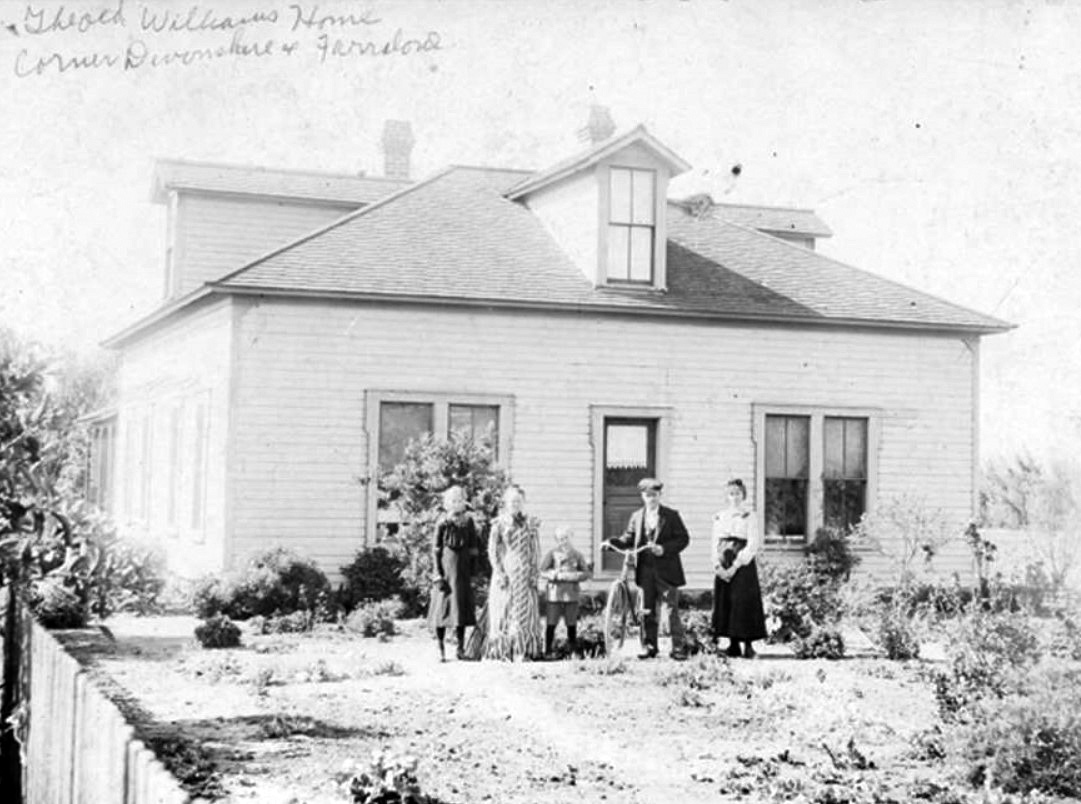 |
|
| (ca. 1900)* - Home of the J. R. Williams Family--one of the first in Chatsworth. It was located near the southeast corner of Devonshire Street near Farralone Avenue. In 1975 it was torn down to make way for new homes. Shown here from left to right: Ida Williams, Mrs. J. R. (Carrie Vaughman) Williams, Richard Williams, E. M. (Shorty) Williams, and Mae Williams. |
* * * * * |
Cahuenga Pass
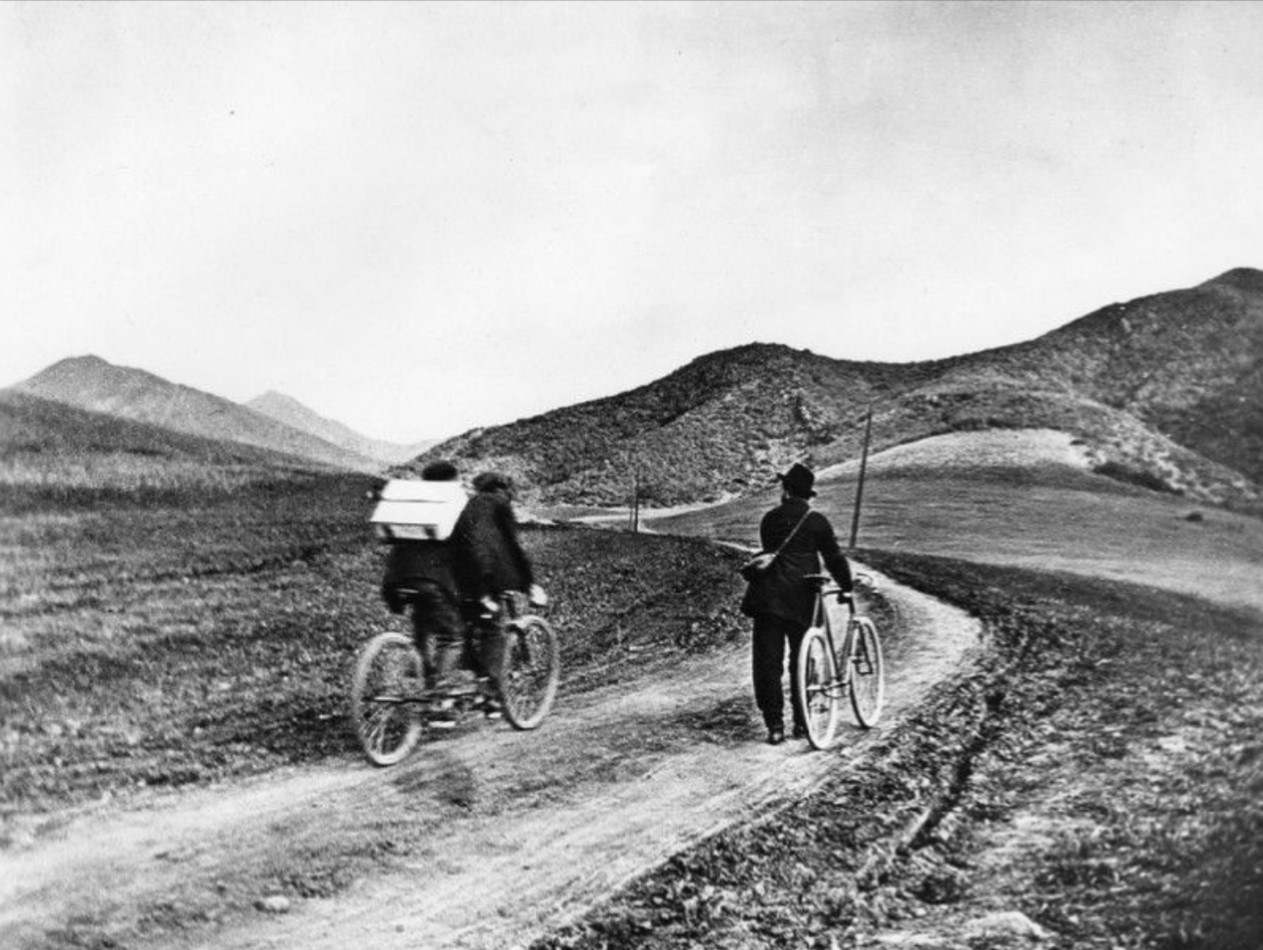 |
|
| (1901)* - Early travel through the Cahuenga Pass, which connected Hollywood and the San Fernando Valley, was done on bicycles by some. This area would later become Cahuenga Boulevard, just south of Whitley Terrace. |
Historical Notes The Cahuenga Pass connects the Los Angeles Basin to the San Fernando Valley and is the lowest pass through the mountains. Cahuenga is the Spanish name for the Tongva village of Kawengna, meaning place of the mountain. |
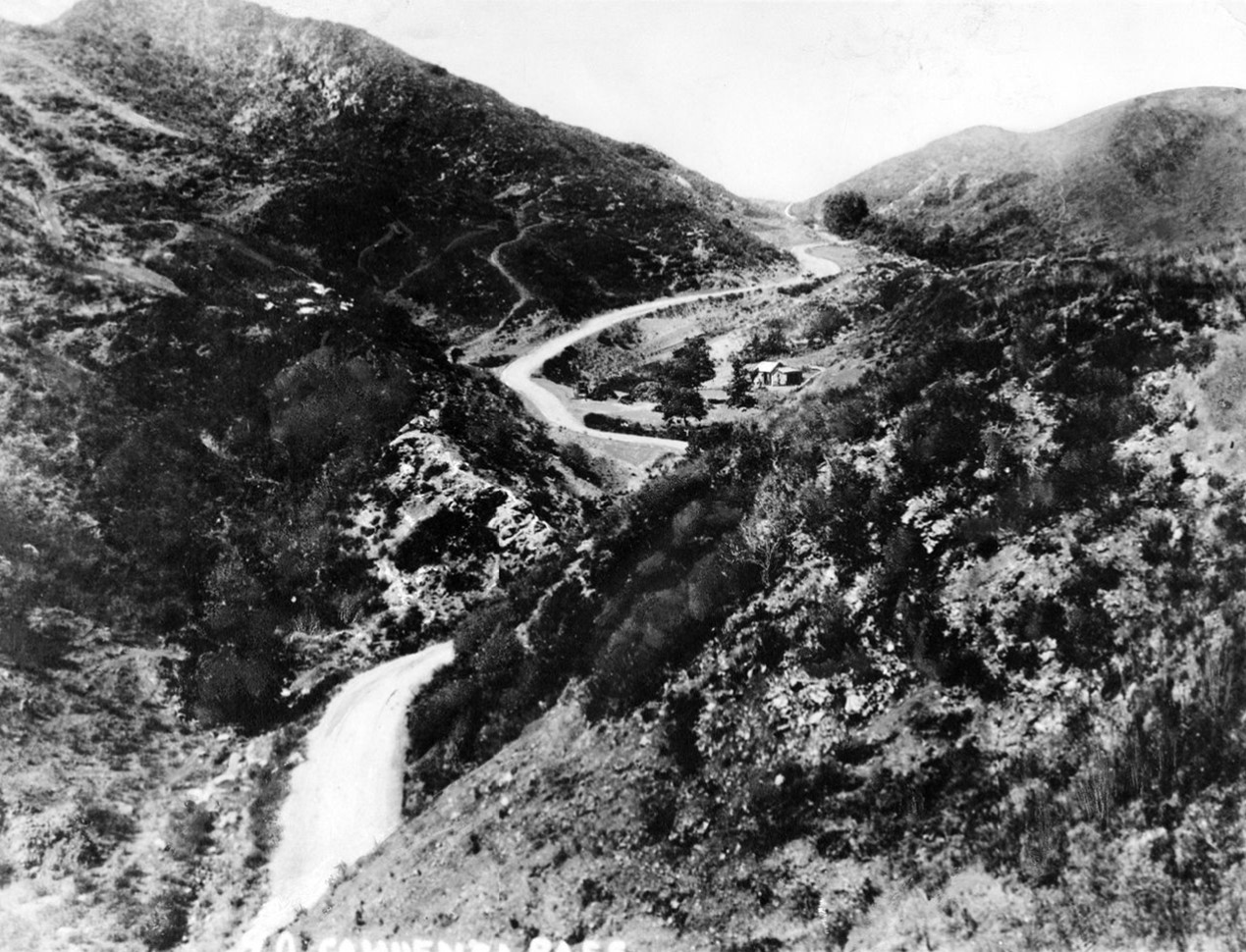 |
|
| (ca. 1890)* - High-angle view of Cahuenga Pass near North Hollywood, with road between mountains and stagecoach stop at right center. |
Historical Notes In the center of the photograph was a coach stop where people could stay overnight. It was owned by Geronimo Lopez. The road was narrow enough so that if two teams of horses met, the heaviest one won, the lighter one had to back down. Lightning would hit the horses during storms and was considered a very dangerous pass to cross. Miguel Leonis was killed in the Pass. |
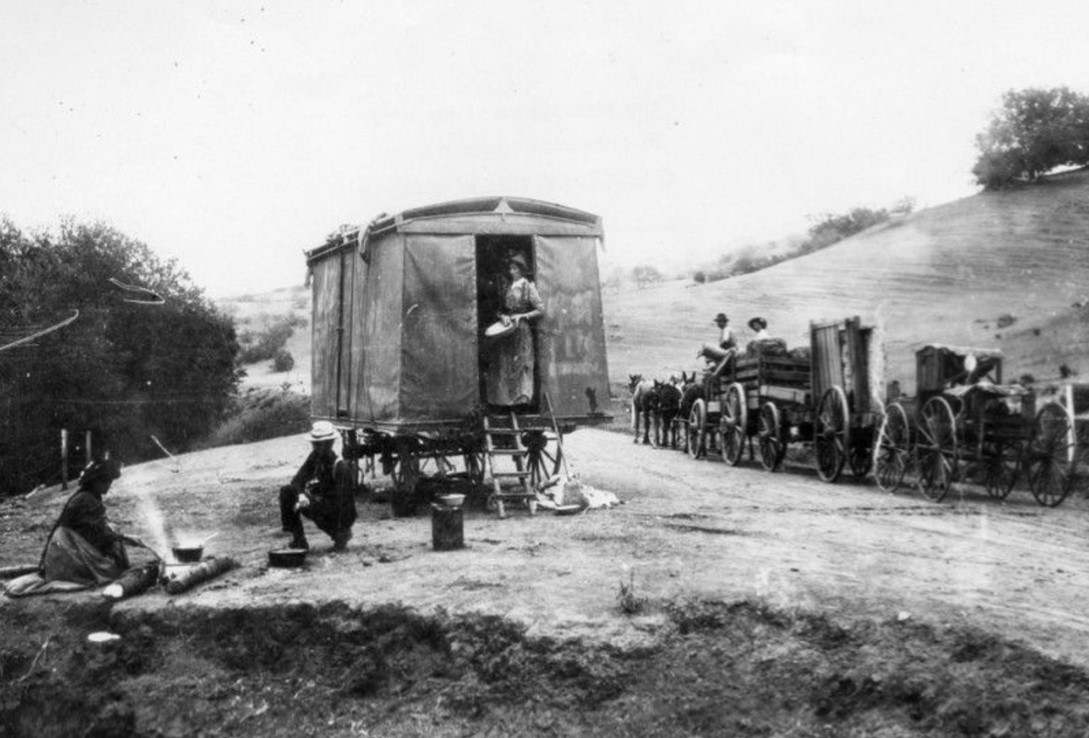 |
|
| (1892)* - Before roads and rail lines were built traveling through the Cahuenga Pass was by wagons and horses. Here a group of people have stopped to camp and cook something to eat. Another horse drawn vehicles passes them by on the road. |
Historical Notes During the 19th century, Cahuenga Pass saw significant development. By the 1850s, ox-carts and mule-teams were crossing the hills through the pass, and in 1858, the Butterfield Overland Mail Company stage made its first crossing. The 1870s brought the construction of the Pass Hotel, also known as Eight Mile House, which served as a toll station and store. |
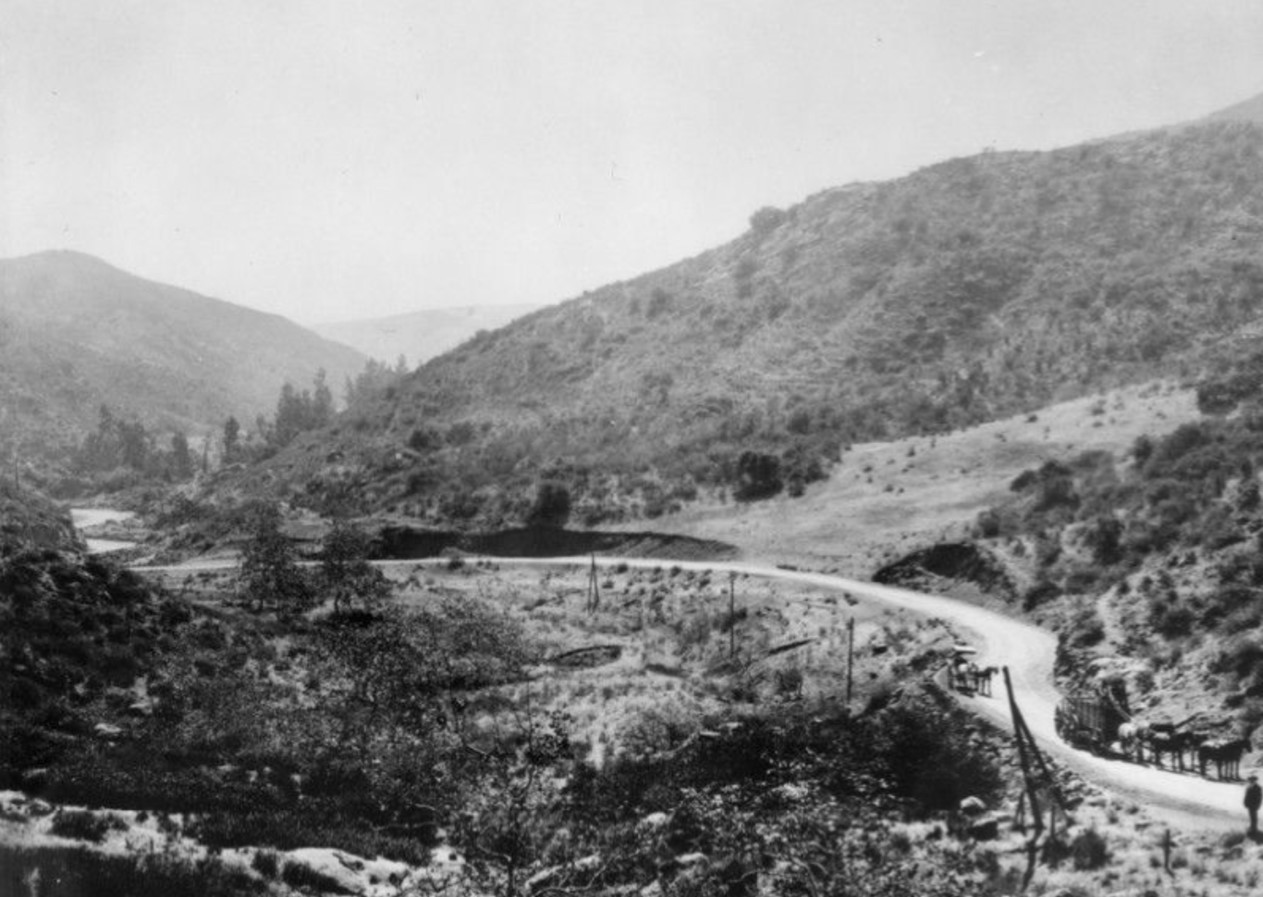 |
|
| (ca. 1894)* - Early view of area later to become part of the Cahuenga Pass. A road is visible in the photograph with what appears to be a horse-pulled buggy, and another team of horses in the lower right hand corner. |
Historical Notes Click HERE to see more Early Views of Cahuenga Pass |
* * * * * |
Farming in the San Fernando Valley
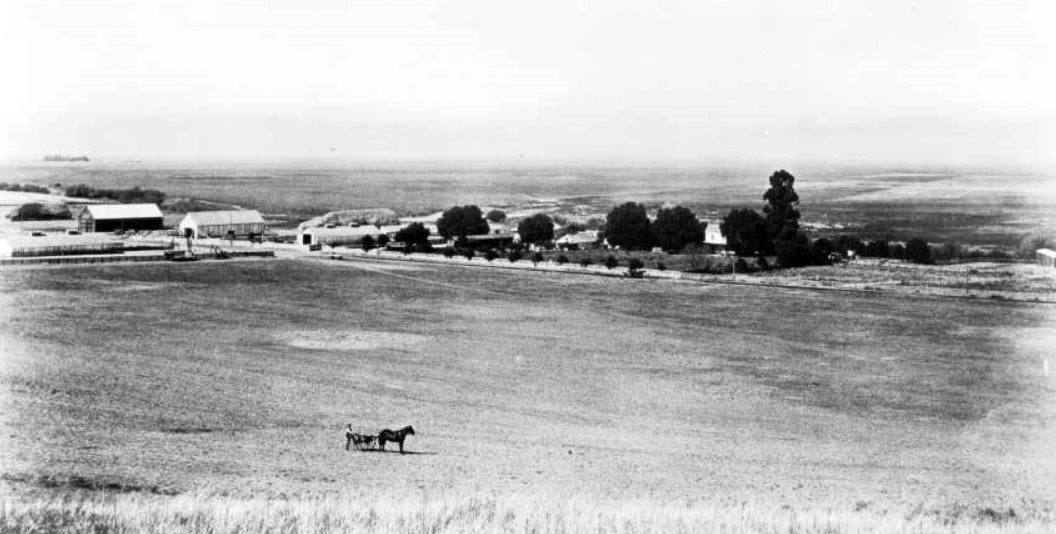 |
|
| (ca. 1890)* - Panoramic view looking north of the San Fernando Valley near Coldwater Canyon and Ventura Boulevard at what would become the site of the Hollywood Country Club. A man stands a distance away at center, trailing behind a horse-drawn cart. A large, flat field stretches out behind him, meeting several barns and a farm house in the distance, which is partially obscured by trees at the center. |
Historical Notes The valley was initially dominated by large cattle ranches, but in the late 1800s transitioned to wheat farming and the cultivation of a variety of crops including citrus, olives, walnuts, and other fruits and vegetables. This agricultural boom was enabled by the arrival of the Southern Pacific Railroad in 1876, which provided access to markets in San Pedro and San Francisco. By the 1880s, the Lankershim family's Los Angeles Farming and Milling Company was one of the largest wheat farming operation in the world, shipping their product as far as the UK. Other major crops included citrus, olives, and a wide variety of fruits and vegetables. |
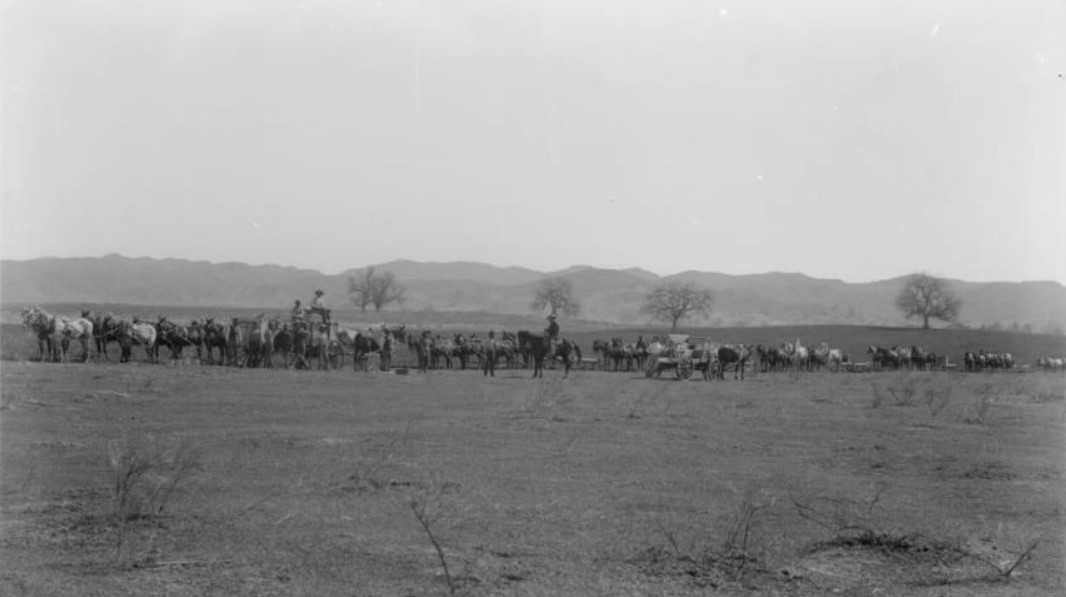 |
|
| (ca.1898)* – Panoramic view of a long row of horse-drawn wagons and men on horseback plowing and seeding 5,000 acres of wheat on the southeasterly portion of the Lankershim Ranch in the San Fernando Valley. Here the outfit is stopping for noon lunch in the fields. One hundred horses were used in this field for plowing. |
Historical Notes By the 1890s, a series of droughts led many farmers to adopt dry farming practices. This technique, developed on the Great Plains, was particularly suited to growing wheat and barley. In fact, the Los Angeles Farming and Milling Company, which owned a significant portion of the valley, became the world's largest wheat-growing empire. |
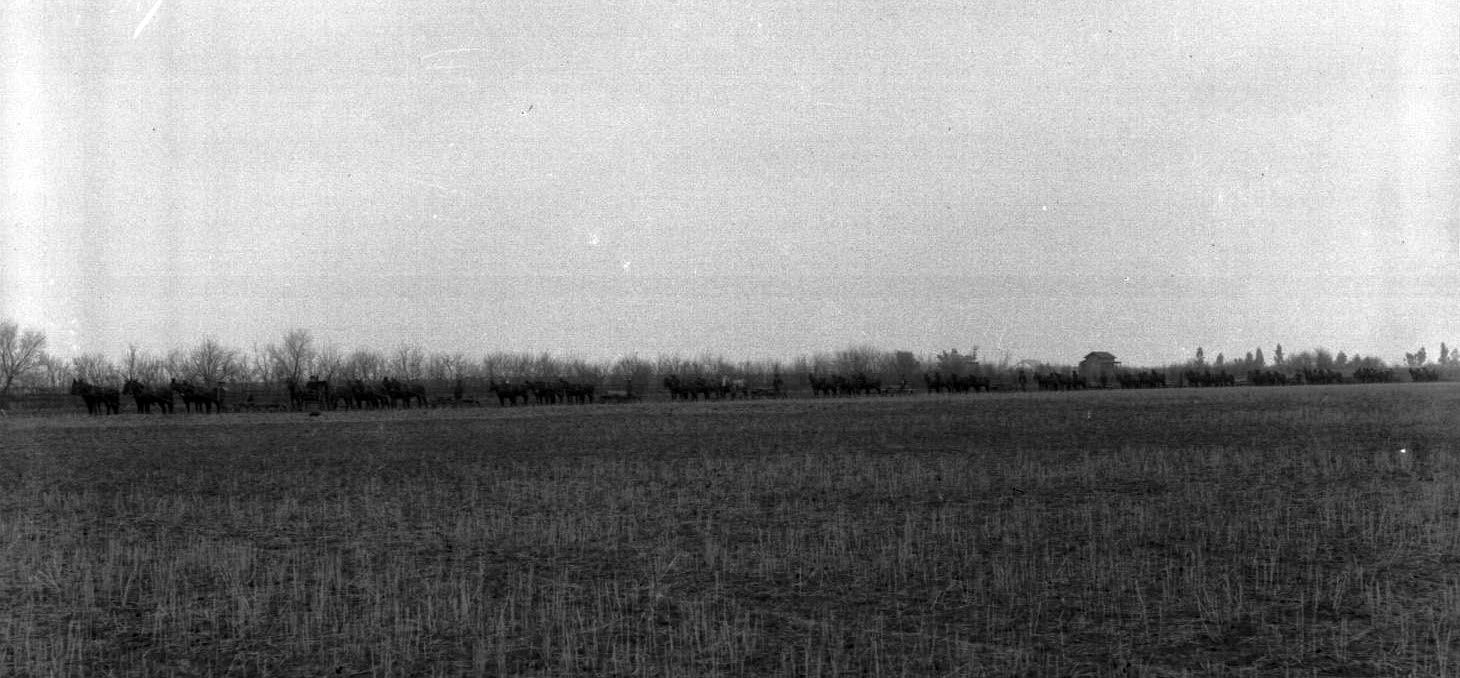 |
|
| (ca. 1900)* - Panoramic view showing 13 horse-drawn plows on Van Nuys grain ranch. Six horses and a driver are on each team. The long line of teams is lined up at the edge of a large field prepared to begin plowing for the day. A line of trees devoid of foliage is visible behind them. This wheat field is located in the southeasterly portion of the San Fernando Valley. |
Historical Notes Early plowing in the San Fernando Valley was done using horse-drawn plows. This method of plowing was labor-intensive but effective for preparing large tracts of land for cultivation. |
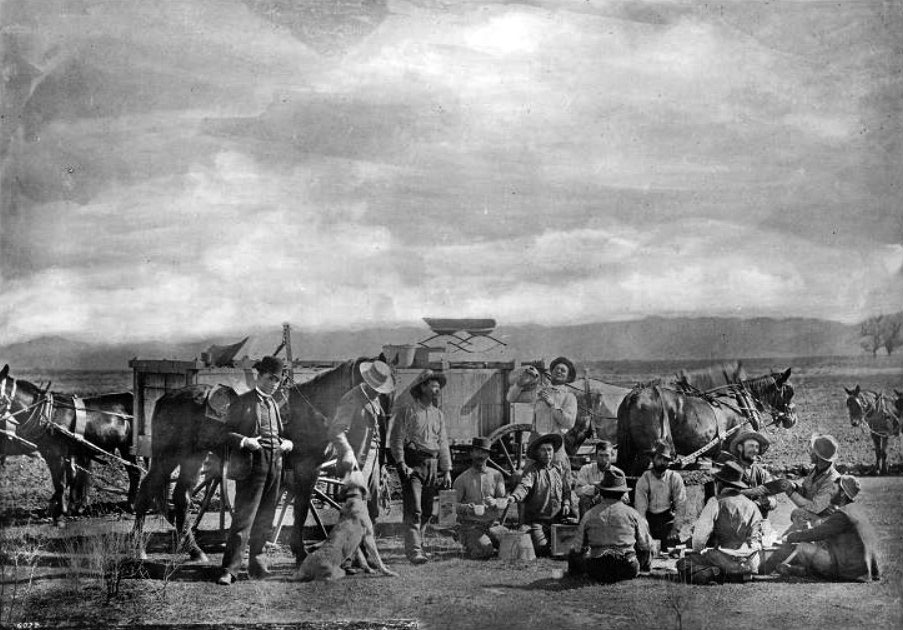 |
|
| (ca. 1900)* - Grub time on Van Nuys Ranch, eating in the field. About a dozen men and a dog take a break for a meal. Photo by C. C. Pierce |
Historical Notes Isaac Van Nuys’ great ranch eventually became the “Van Nuys townsite” and then simply, Van Nuys. No landmark house, statue, or even a formal portrait of the land baron remains. The only thing he left behind was his name. |
 |
|
| (ca. 1900)* - Grub Time at the Van Nuys Ranch - Men and Their Canine Companion Dine in the Field. Isaac Van Nuys’ great ranch eventually became the "Van Nuys townsite" and then simply, Van Nuys. No landmark house, statue, or even a formal portrait of the land baron remains. The only thing he left behind was his name. |
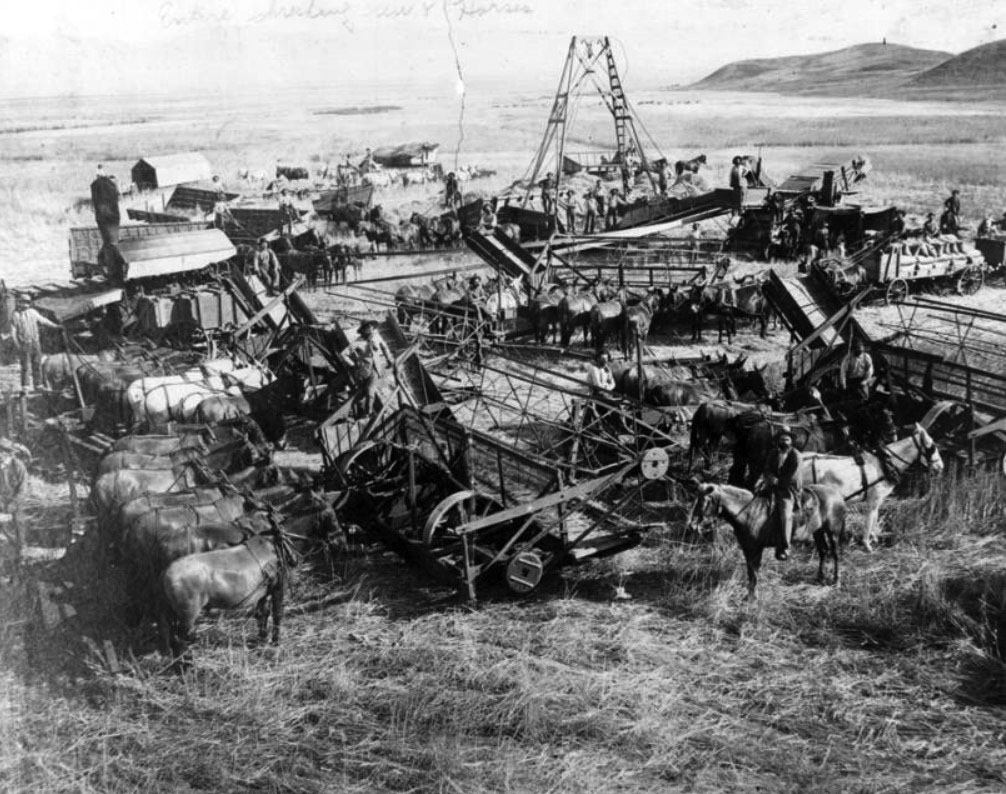 |
|
| (ca. 1900)^ - Hubbard-Wright farming crew at work in Chatsworth. |
Historical Notes This team of men and machines harvested wheat for the ranches of the San Fernando Valley in the early 1900's. Mules were used to pull the equipment. The man on horseback at the lower right hand corner is J. R. Williams II. He was the supervisor in charge of the crew. He lived in Chatsworth. His mother and father came to the Santa Susana Pass area in the 1870's from Kansas. |
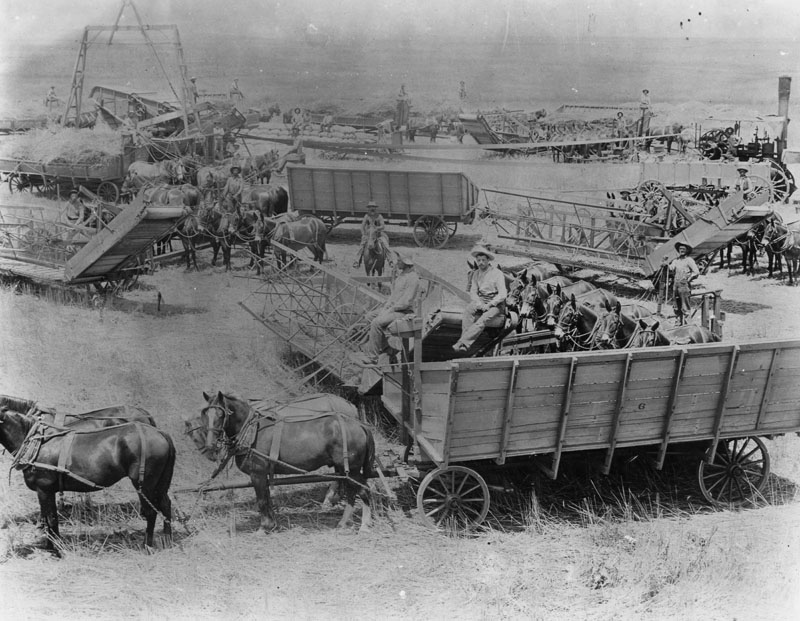 |
|
| (1890)* - Photograph of several threshing machines in the San Fernando Valley. Each thresher is hauled by a team of horses or mules. |
Historical Notes The adoption of threshing machines in the San Fernando Valley occurred in the late 19th or early 20th century, coinciding with the region's focus on grain production. These machines significantly increased efficiency in processing crops such as wheat, which was one of the valley's important products. |
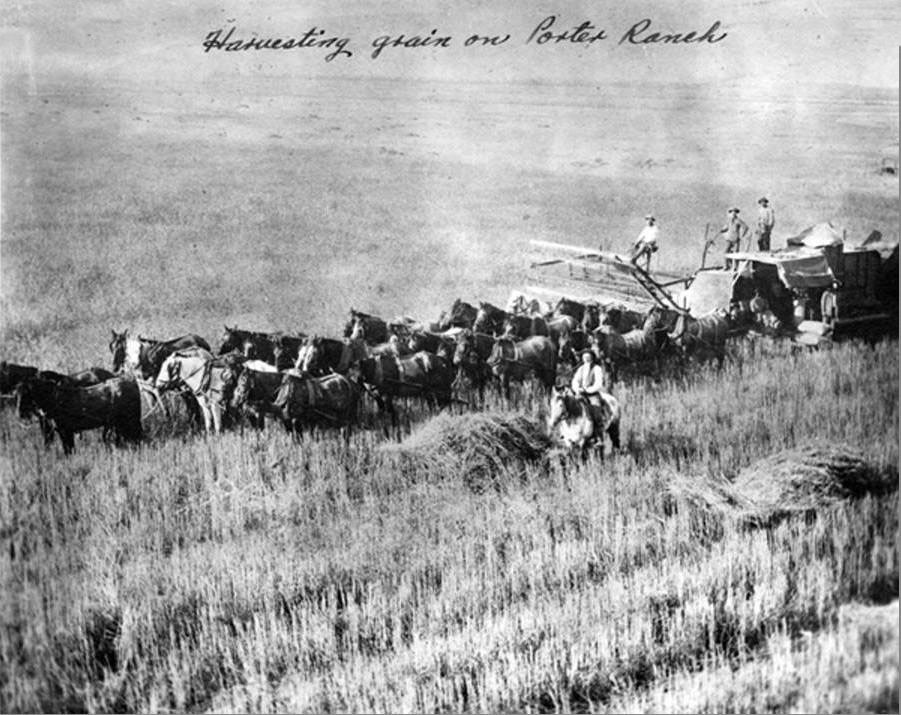 |
|
| (ca. 1900)^ - Farmers harvesting grain on Porter Ranch, circa 1900. |
Historical Notes The Porter Ranch was located in the northern part of present day Northridge and Granada Hills between Limekiln Canyon on the east and Aliso Canyon on the west side. The ranch was part of the 56,000-acre San Fernando rancho purchased by Senator Charles Maclay and George K. Porter in 1874 with George's cousin, Benjamin Porter, joining the partnership a few years later. |
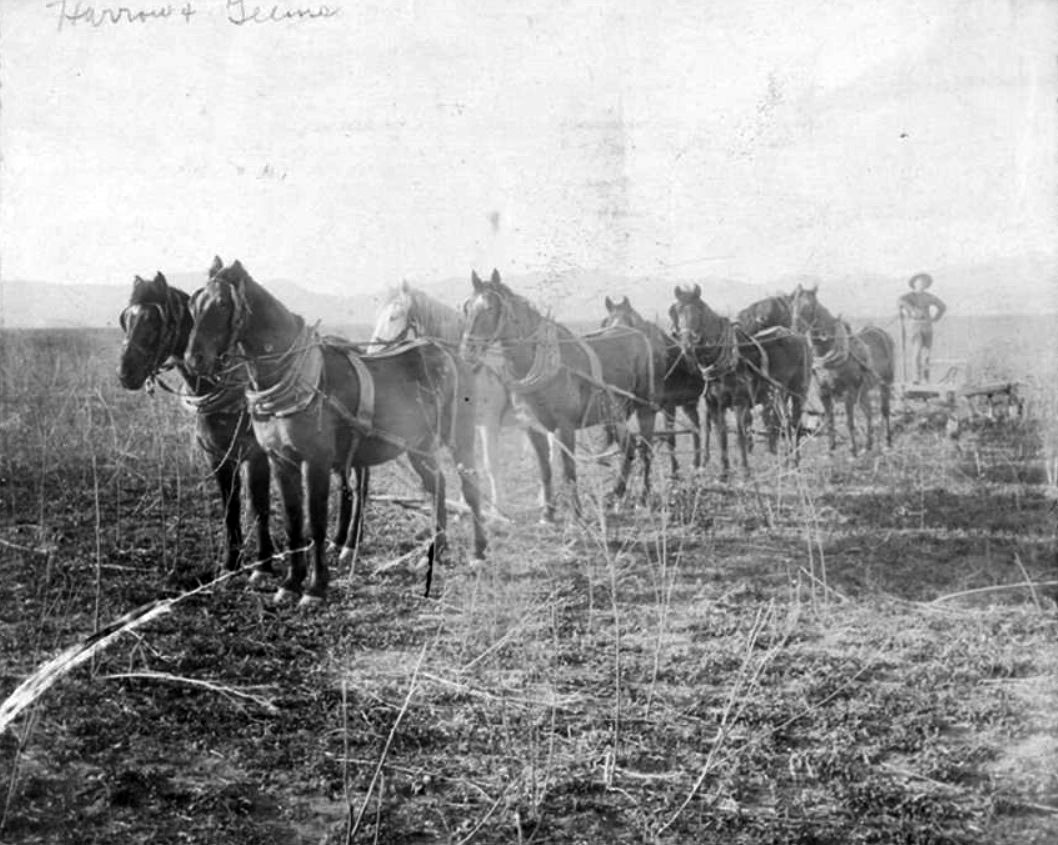 |
|
| (1890s)^ – View showing wheat farmer working the land belonging to B. F. Porter. |
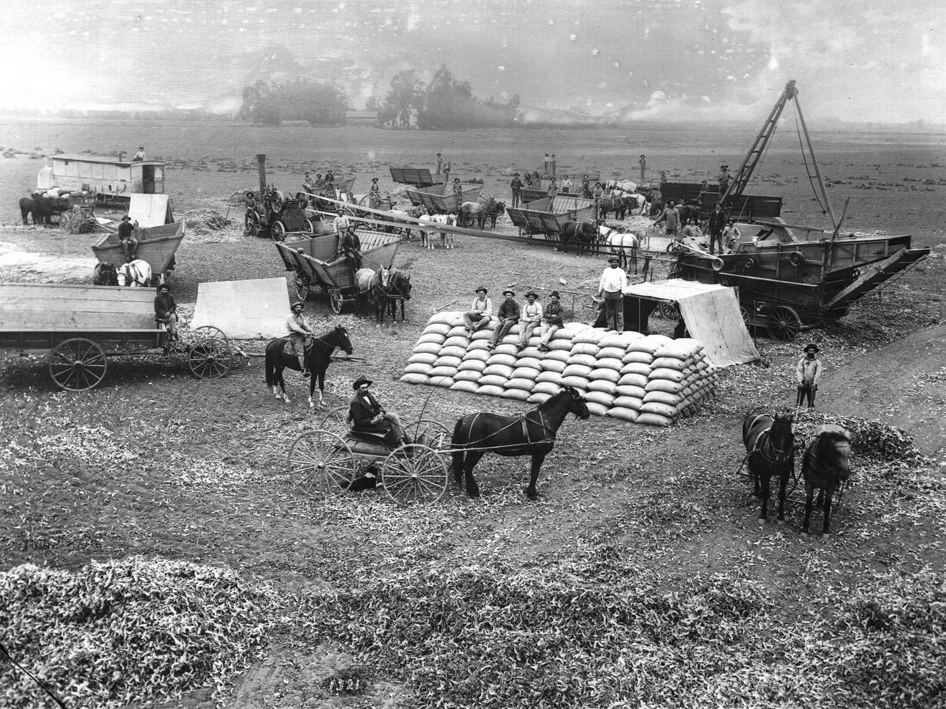 |
|
| (ca. 1898)* - Photograph of harvesters at work on a Van Nuys-Lankershim ranch in the San Fernando Valley. About 10 horse-drawn wagons are bringing the crop to a central belt-driven machine. A neatly pile of full burlap sacks can be seen with four men sitting on top. |
Historical Notes A group of investors assembled as the San Fernando Farm Homestead Association purchased the southern half of the Rancho Ex-Mission San Fernando. The leading investor was Isaac Lankershim, a Northern California stockman and grain farmer, who was impressed by the Valley's wild oats and proposed to raise sheep on the property. |
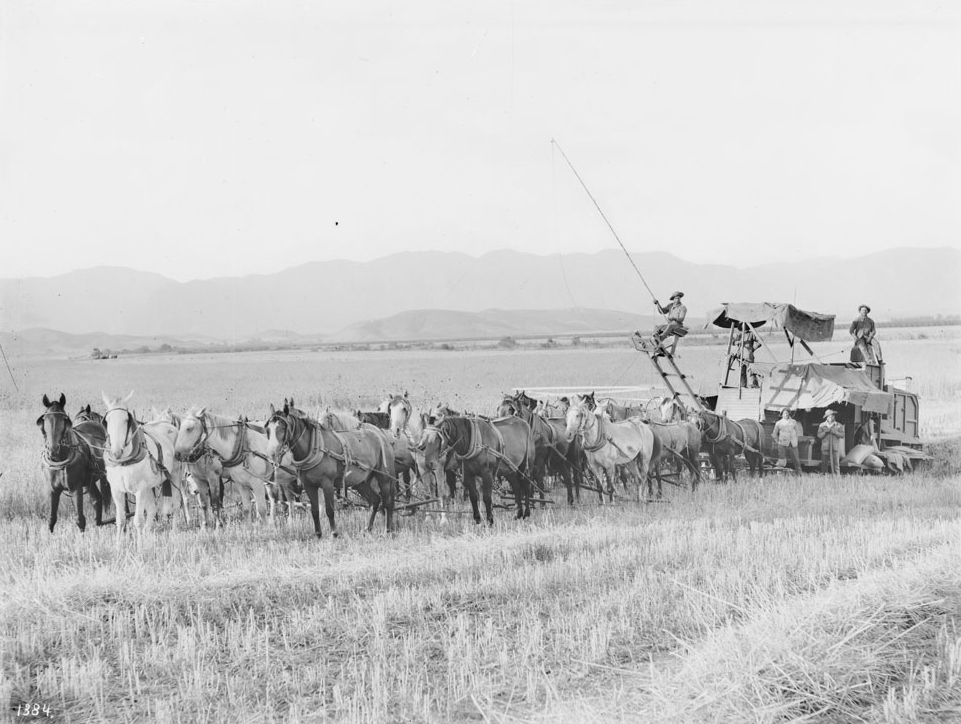 |
|
| (ca. 1905)* - A twenty-horse harvester at work in a field on a Van Nuys-Lankershim ranch in the San Fernando Valley, California, ca.1905-1908. It takes 5 men to operate the harvester. Mountains are visible in the distance. |
Historical Notes In 1873, Isaac Lankershim's son and future son-in-law, James Boon (J. B.) Lankershim and Isaac Newton Van Nuys, moved to the Valley and took over management of the property. Van Nuys thought the property could profitably grow wheat using the dryland farming technique developed on the Great Plains and leased land from the Association to test his theories. In time the Lankershim property, under its third name, the Los Angeles Farming and Milling Company, would become the world's largest wheat-growing empire. |
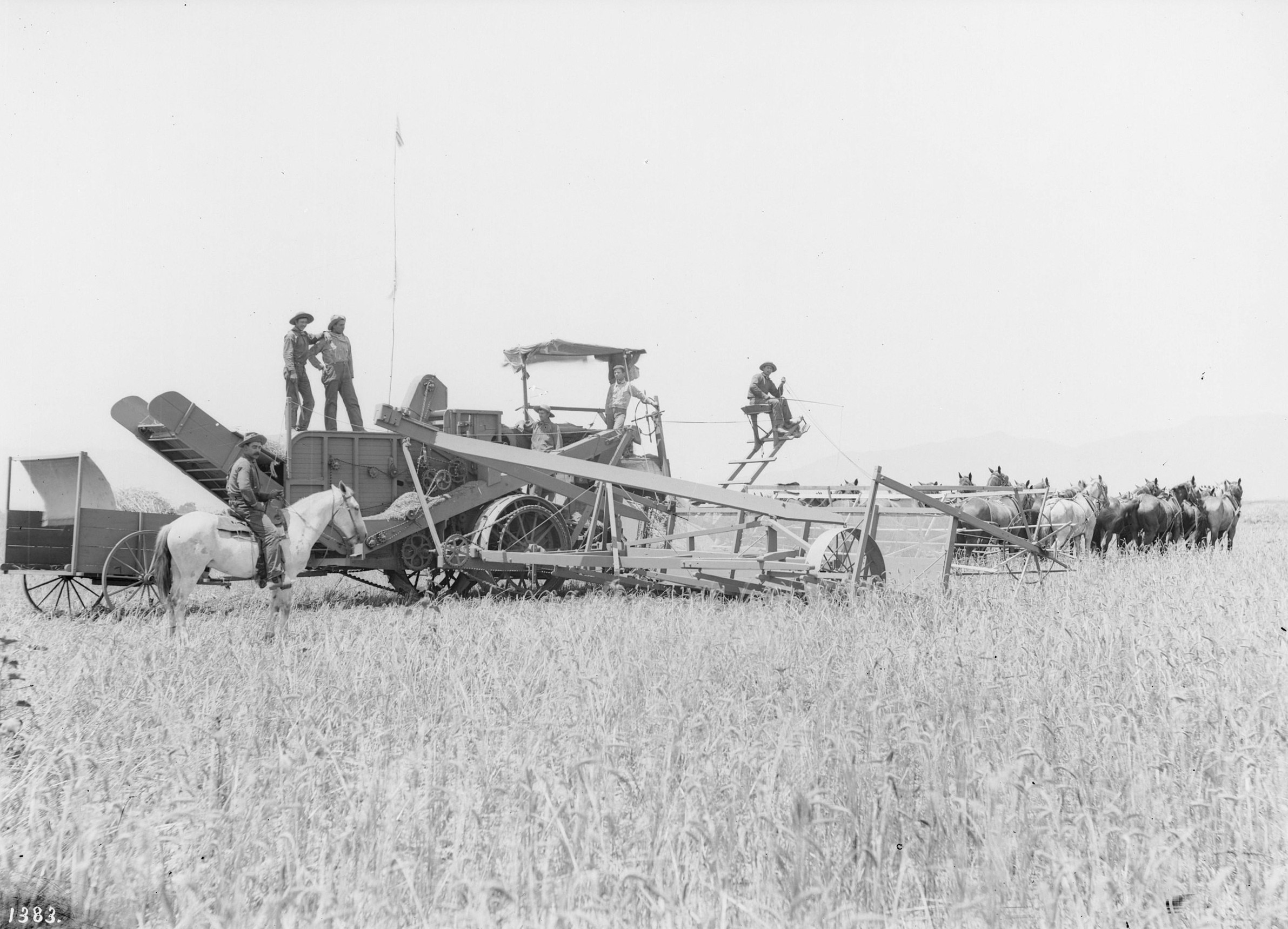 |
|
| (ca. 1890–1900)* – A horse-drawn combine harvester at work on a Van Nuys ranch in the San Fernando Valley. Multiple teams of horses pull the massive machine while laborers ride and operate its complex mechanisms to cut, thresh, and collect the wheat. |
Historical Notes The use of combine harvesters like this one signaled a leap forward in Valley agriculture. These early machines, powered by large teams of horses or mules, could reap, thresh, and winnow grain in a single pass, drastically reducing labor and time compared to earlier methods. While still reliant on animal power, they represented the start of a mechanized shift in Southern California’s wheat industry—an industry that, by the turn of the 20th century, was already exporting product overseas and transforming the San Fernando Valley into one of the most productive agricultural regions in the state. |
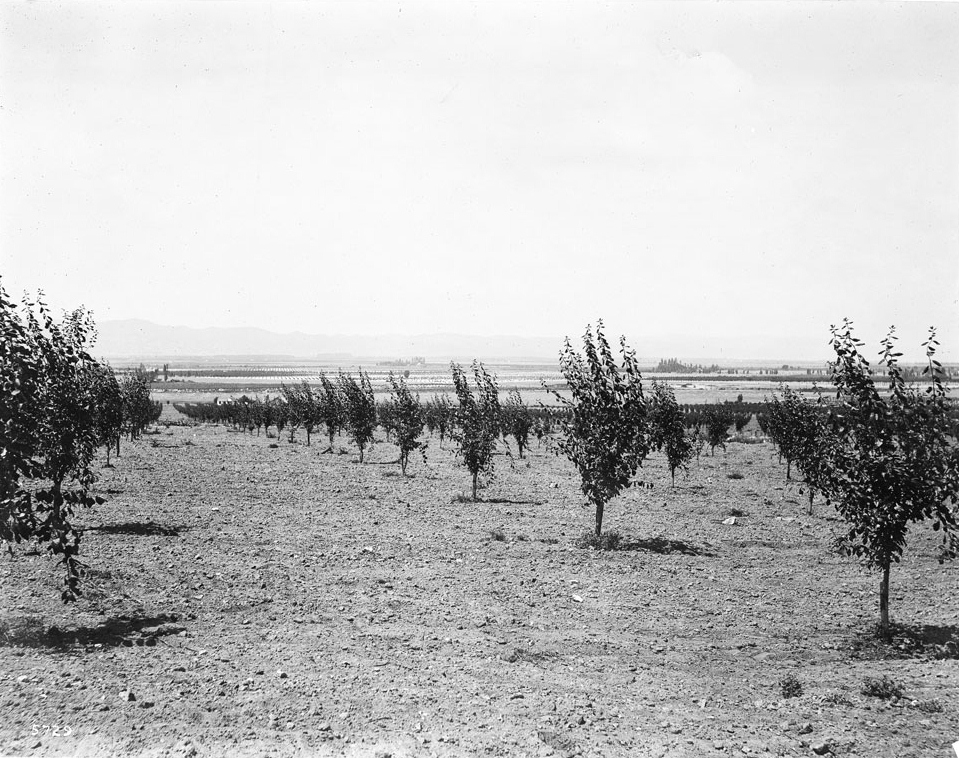 |
|
| (ca. 1900)* - Photograph of a view of a prune orchard in the San Fernando Valley. Rows of prune trees are planted in what appears to be dry and rocky soil. Aside from the prune trees, the landscape is pretty flat. Trees and grids of other types of crops are visible in the distance. |
Historical Notes The world wheat market remained strong through the 1870s and early 1880s, but then supply began to exceed demand, and prices began to fall. When the Santa Fe Railroad reached Los Angeles in 1885, fare wars between the Santa Fe and the Southern Pacific brought ever more settlers to Southern California, and pressure rose to subdivide the great ranches. In October 1887, J.B. Lankershim and eight other developers organized the Lankershim Ranch Land and Water Company, purchasing 12,000 acres north of the Cahuenga Pass from the Lankershim Farming and Milling Company. |
* * * * * |
Toluca
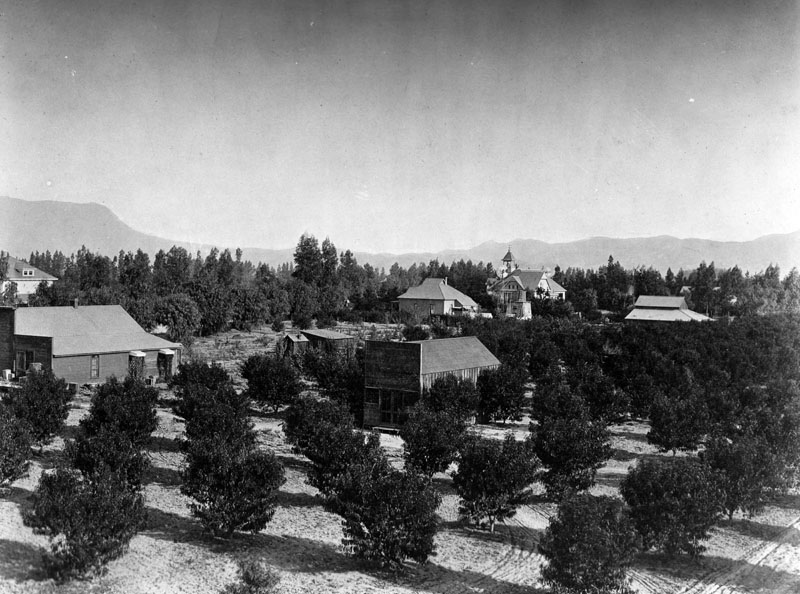 |
|
| (1899)* - Toluca Road, now Lankershim Boulevard, in North Hollywood. |
Historical Notes J. B. Lankershim established a town site which the residents named Toluca along the old road from Cahuenga Pass to San Fernando. On April 1, 1888, they offered ready-made small farms for sale, already planted with deep-rooted deciduous fruit and nut trees—mostly peaches, pears, apricots, and walnuts—that could survive the rainless summers of the Valley by relying on the high water table along the Tujunga Wash rather than surface irrigation. |
 |
|
| (1890)* - A group of agricultural laborers take a break from harvesting peaches to pose for the camera, in the Toluca area of the San Fernando Valley. 'Toluca, Ca.' is printed on the side of the peach boxes. |
Historical Notes North Hollywood was established by the Lankershim Ranch Land and Water Company in 1887. It was first named Toluca before being renamed Lankershim in 1896 and finally North Hollywood in 1927. ^ |
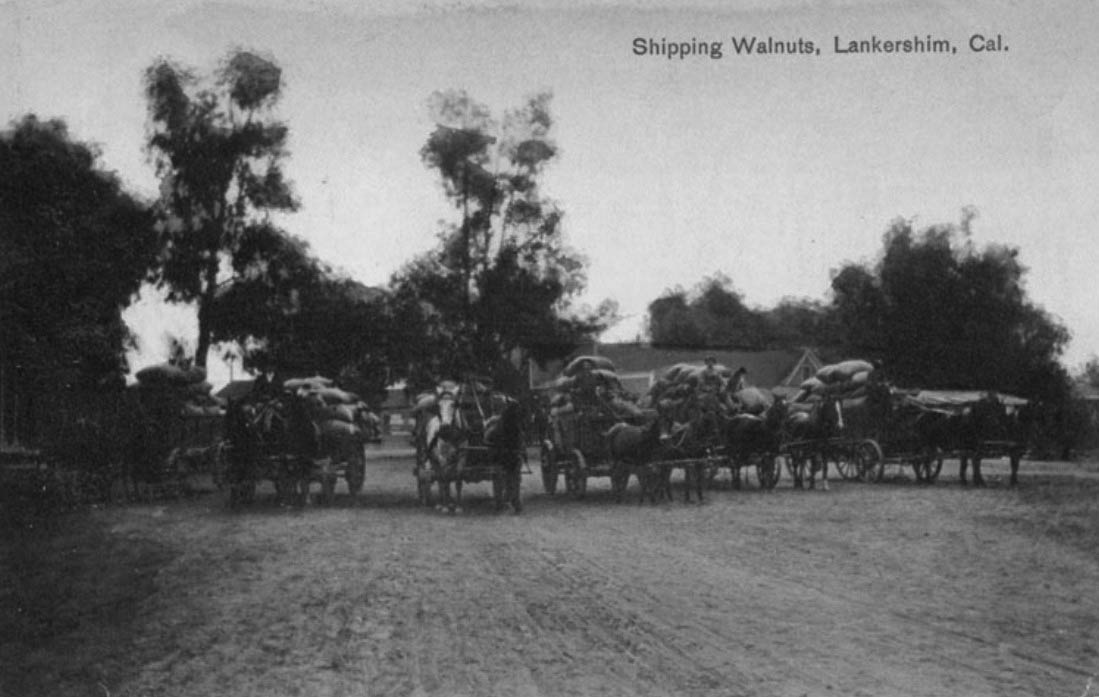 |
|
| (ca. 1912)* – Postcard view showing six horse-drawn wagons carrying sacks of walnuts for shipping in Lankershim (now North Hollywood). |
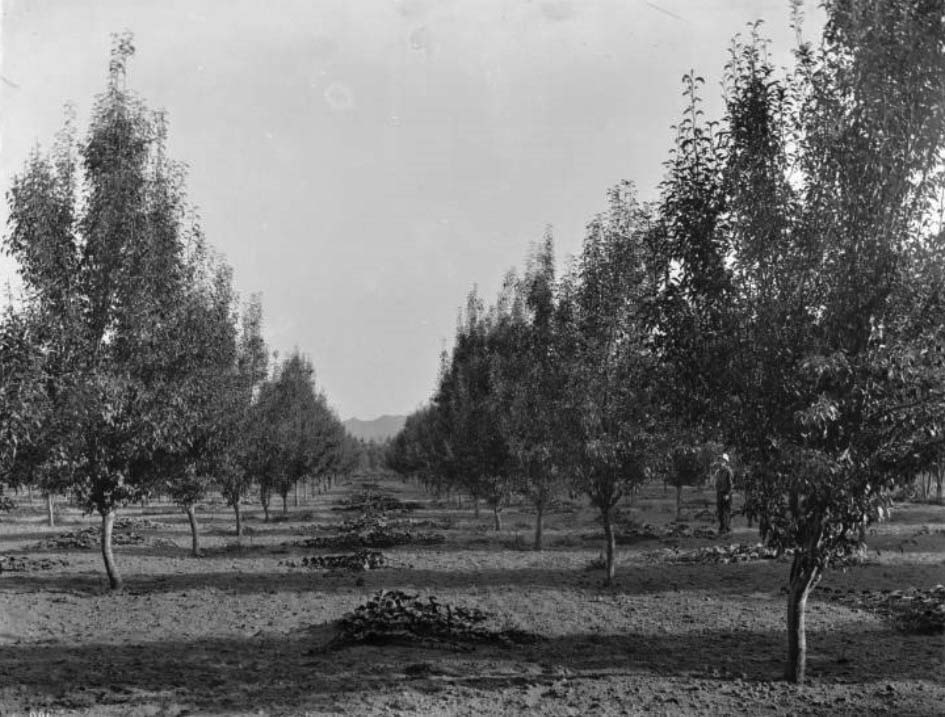 |
|
| (ca. 1900)^^ – Anderson's pear orchard, Toluca (Lankershim), San Fernando Valley. View is down the space between two long rows of trees. A man is standing at right and the silhouette of mountains is visible in the distance. |
Historical Notes The land boom of the 1880s went bust by the 1890s, but despite another brutal drought cycle in the late 1890s, the fruit and nut farmers remained solvent. The Toluca Fruit Growers Association was formed in 1894. The next year the Southern Pacific opened a branch line slanting northwest across the Valley and stopping at Lankershim on its way to Chatsworth. *^ |
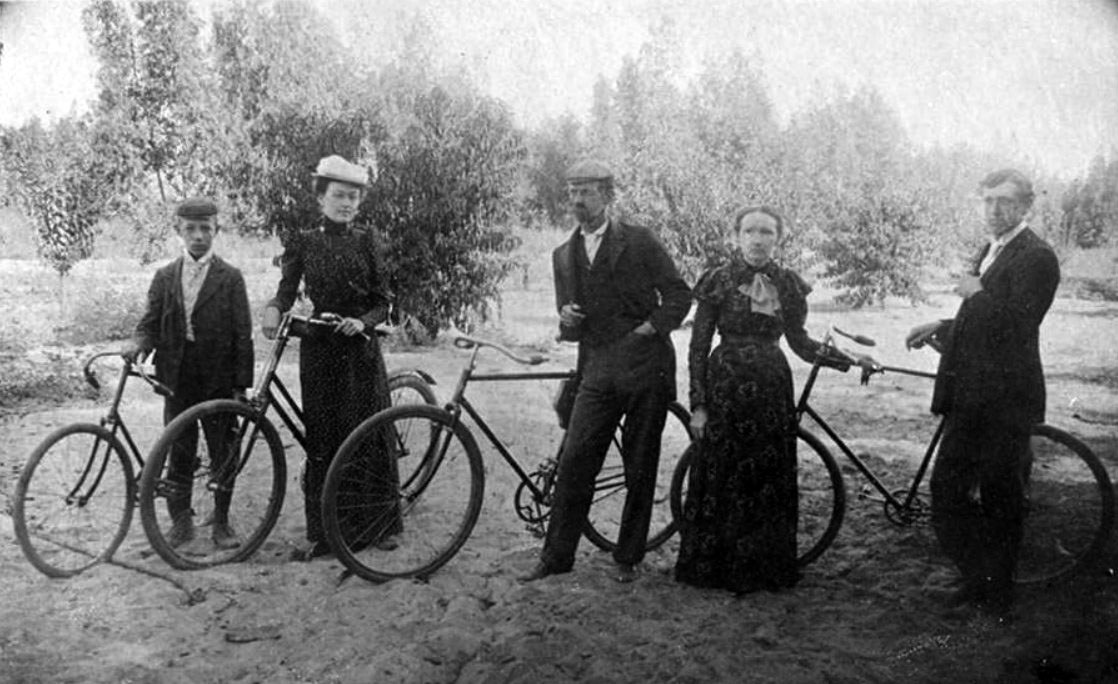 |
|
| (ca. 1900)^ - The Van Winkle Family posing with their bicycles in Lankershim (now North Hollywood). Seen above are father, Andrew Van Winkle, mother, Amanda Van Winkle, oldest daughter, Mae, and two sons, Ralph and Arthur Ado. |
Historical Notes The Van Winkle Family was active in the Lankershim community. ^ |
Lankershim Station
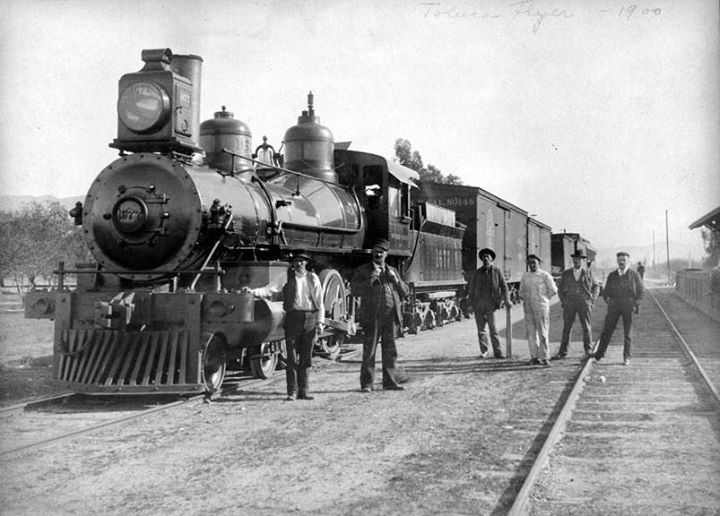 |
|
| (1900)*^^^ - This is the "Toluca Flyer" at the Lankershim Station in 1900. |
Historical Notes In 1895, the Southern Pacific opened a branch line slanting northwest across the Valley to Chatsworth. The Chatsworth Limited made one freight stop a day at Toluca, though the depot bore the new name of Lankershim. With the Post Office across the street called Toluca, controversy over the town’s name continued and the local ranchers used to quip, “Ship the merchandise to Lankershim, but bill it to Toluca.” In 1896, under pressure from Lankershim, the post office at Toluca was renamed "Lankershim" after his father, although the new name of the town would not be officially recognized until 1905.*^ |
.jpg) |
|
| (1927)* - Exterior view of the Lankershim (later North Hollywood) station of Southern Pacific and Pacific Electric railways. |
Historical Notes When it first opened in 1895, the train depot at the corner of Lankershim Boulevard and Chandler Boulevard was crucial to the rapid growth of the town that was first called Toluca, then Lankershim, and finally, North Hollywood. The depot still stands today, and is one of the oldest existing structures in the San Fernando Valley. It has been named a cultural and historic monument by the city of Los Angeles and is slated to be restored. Click HERE to see more of the North Hollywood Pacific Electric Station. |
* * * * * |
Mail and Stage Service
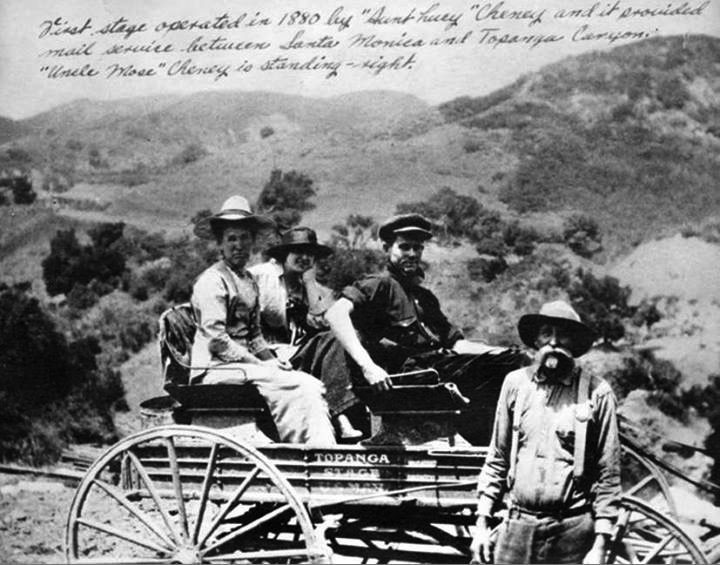 |
|
| (ca. 1880s)^ - First stage and mail service operated in 1880s between Santa Monica and Topanga Canyon. |
Historical Notes The 1st mail wagon was established by "Aunt Lucy" Cheney and began service in 1880. It provided mail service between Santa Monica and Topanga Canyon. They began to carry passengers (as shown here) in 1885. Also pictured is "Uncle Mose" Cheney.*^^^ Possible Correction (not yet verified): |
* * * * * |
Vejar Stage Station (Agoura)
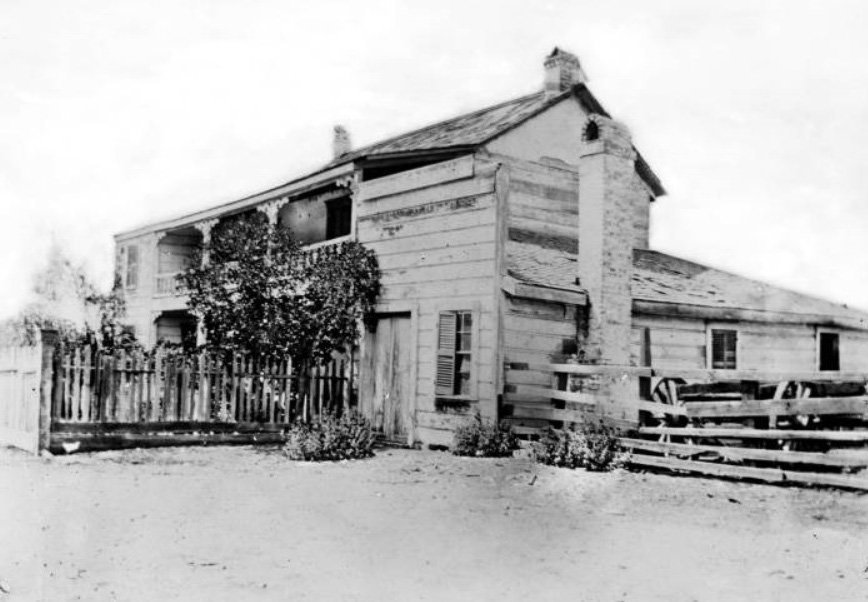 |
|
| (ca. 1886)^^ - Exterior view of Crisostona Vejar Stage Station on Ventura Road. The station, built in 1820 by the family of Thomas Delano and Crisostona Vejar, is a two-story wooden building with a covered porch and balcony. The Vejar Station was located at the present city of Agoura. |
Historical Notes In its earliest days, Agoura Hills was nothing more than a stagecoach stop and was referred to as "Vejar Junction." In the early 1920s, after Paramount Studios purchased a ranch in the neighborhood, the community became known briefly as "Picture City." But neither name stuck. In 1928, a group of residents formed a Chamber of Commerce which, as one of its first actions, asked to have a permanent post office established in the community. The Postal Department informed the chamber that it would need to submit a list of ten potential names for the town. One of the area's more colorful early landowners had been a man by the name of Pierre Agoure. Though French by birth and a shepherd in his youth, he favored Spanish costumes and adopted the moniker Don Pedro Agoure. In compiling a list of possible names, the townspeople inserted "Agoure" in the tenth spot. Bob Boyd, the town's first postmaster, later recalled that the tenth name was selected because it was the shortest. How the "e" became an "a" remains an unsettled issue. Some say it was done intentionally for ease of spelling, others lay blame at the door of the post office, arguing that the modification was simply an error.*#^* |
El Camino Real
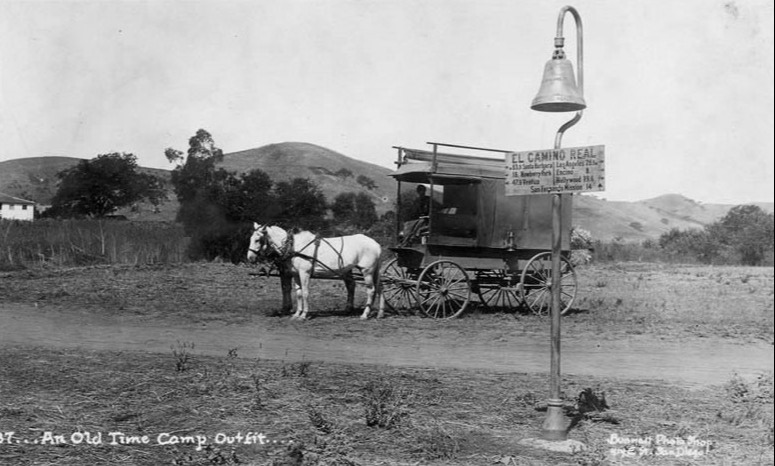 |
|
| (ca. 1900)^ - An old time camp outfit near Ventura Boulevard and Valley Circle Boulevard. Leonis Adobe is in the background. On the El Camino Real sign it says, "83.9 Santa Barbara, 18 Newberry Park, 47.9 Ventura, Los Angeles 26.1, Encino 8, Hollywood 19.6, San Fernando Mission 14." The El Camino Real bells were placed along the mission routes. |
Historical Notes Ventura Boulevard is the oldest continuously traveled route in the Valley. Laid out to follow a portion of the Spanish settlers' famed El Camino Real, it has been known as Camino de las Virgenes, U.S. highway 101 and Ventura Road.^* |
 |
|
| (1906)* - A man holds onto the base pole of the El Camino Real Mission Bell Marker. Two women near a late model car observe. |
Historical Notes In 1906, members of the L.A. Chamber of Commerce and the Southern California Automobile Association began placing facsimile mission bells along the El Camino Real. The road, called "the royal road" in Spanish, was built to connect the network of missions, presidios and pueblos in Baja and Alta California. Today, the path of El Camino Real is roughly mirrored by US Highway 101.* |
* * * * * |
Leonis Adobe
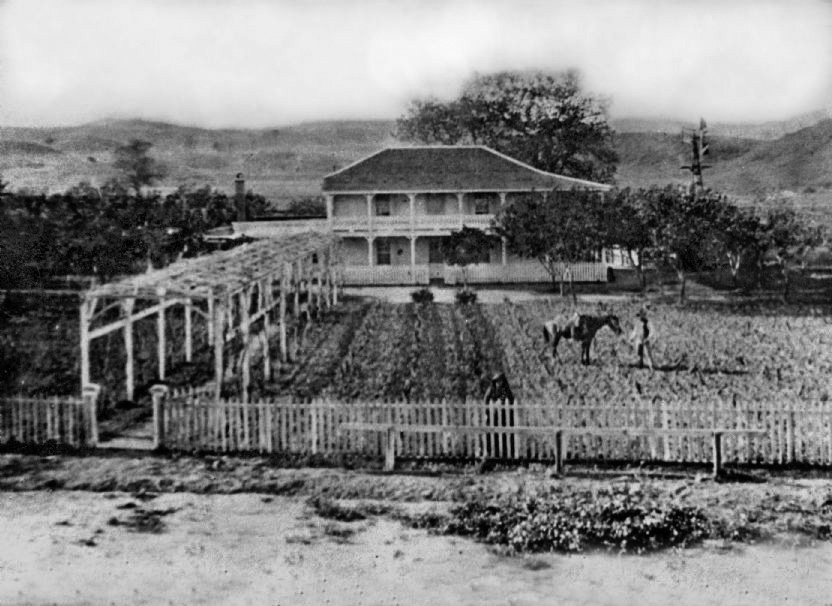 |
|
| (ca. 1900)* - The Leonis Adobe as it appeared around 1900. A man stands in the field beside his horse. If you look closely, a woman is standing just behind the fence at center, looking toward the photographer. She is believed to be Espiritu Leonis, the partner and later legally recognized common law wife of Miguel Leonis. |
Historical Notes El Escorpion, also written as El Scorpion, was a large ranch in the west San Fernando Valley. It was granted in 1839 to three Native residents of Calabasas who were connected to Mission San Fernando. The land later passed to Espiritu, daughter of one of the original grantees. In the late 1860s, the Basque rancher Miguel Leonis became involved with Espiritu, whose inherited rights allowed him to gain control of the ranch and expand it into a major cattle and sheep operation. He later became known locally as the King of Calabasas. By the time of his death in 1889, the ranch extended to more than one thousand acres. The Leonis Adobe was built in 1844 and is one of the oldest standing private residences in Los Angeles County and one of the oldest buildings in the San Fernando Valley. Although the original structure was a simple adobe room, Leonis expanded it over time with wood frame additions and Victorian details. After his death, the property became the center of a long legal battle between Espiritu, Leonis family members in France, and a daughter born out of wedlock. In 1905 the courts finally recognized Espiritu as his lawful partner and awarded her the estate. |
Then and Now
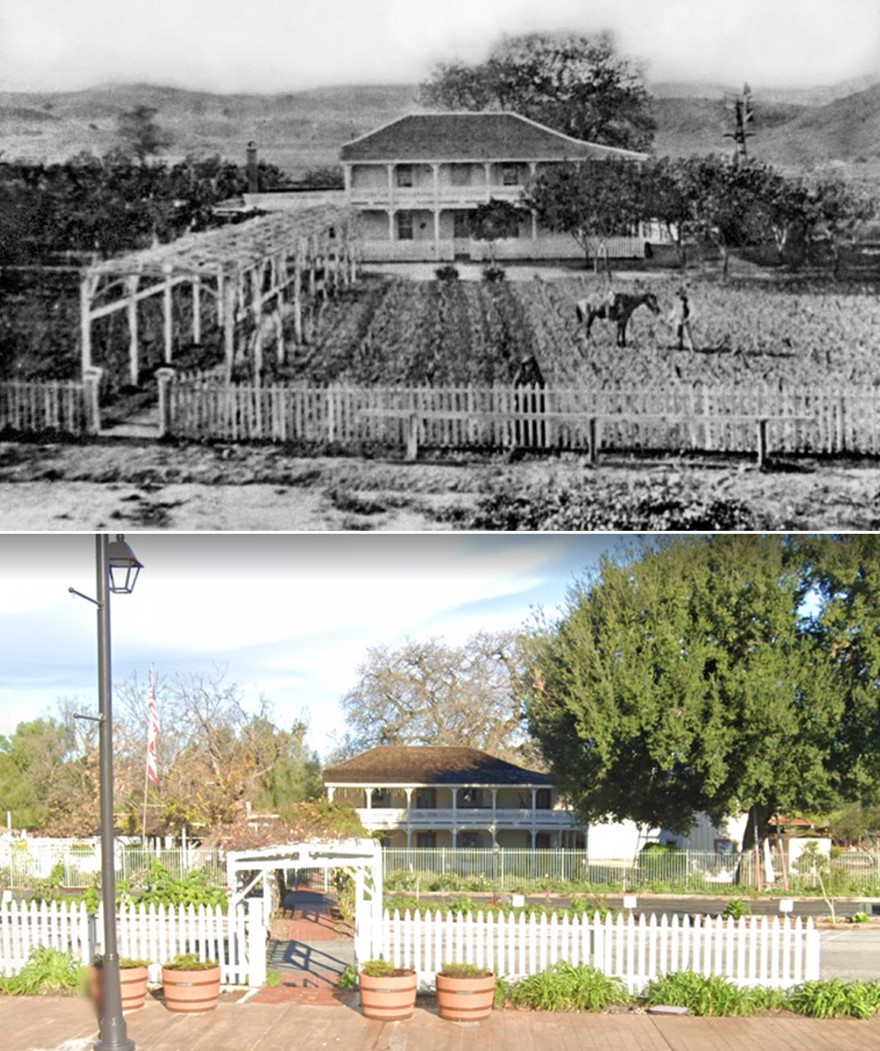 |
|
| (1900 vs 2023)* – The 1844 Leonis Adobe in Calabasas. It remains one of the oldest houses in Los Angeles County. In 1962 it became the very first building in Los Angeles to be designated a Historic Cultural Monument. Photo comparison by Jack Feldman. |
Historical Notes By the early 1900s the Leonis Adobe was already recognized locally as one of the last surviving ranch homes from the Mexican and early American periods of the San Fernando Valley. Its appearance changed over time as the ranch lands around it were divided and Calabasas began to grow. Public interest in preserving the adobe increased in the 1950s and early 1960s as the Valley rapidly modernized. This led to its designation in 1962 as the very first Los Angeles Historic Cultural Monument. Later restoration work brought back many of the building’s nineteenth century features. Today the adobe is an important reminder of the early ranching history of the west Valley and the life of Miguel and Espiritu Leonis during the transition from Spanish and Mexican land grants to American settlement. |
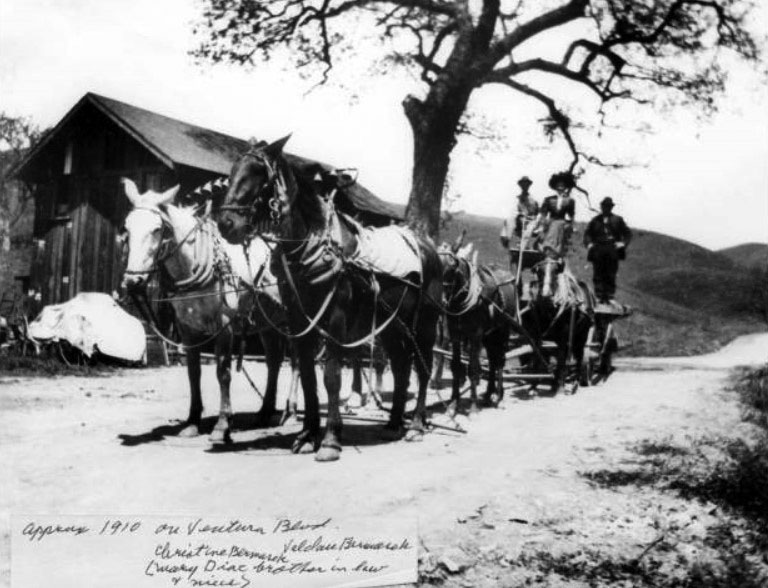 |
|
| (ca. 1910)#^ - Christine Bermark, Valdau Bermark, and an unidentified man on Ventura Boulevard. At that time this stretch of the road still ran across the old Leonis Adobe ranch lands. Ventura Boulevard was a rural wagon road in 1910 and was not fully paved until the mid 1910s. |
Historical Notes Around 1910 Ventura Boulevard was still a rural road that followed the line of the old El Camino Real route through Calabasas. It passed directly through land once worked as part of the Leonis Adobe ranch. The road carried wagons, stagecoaches, and early automobiles traveling between the growing towns of Los Angeles and Ventura. The Bermark family photograph reflects a moment when Calabasas was shifting from an isolated ranching community to a roadside settlement supported by travelers. Paving of Ventura Boulevard began only a few years later and helped bring steady development to the area. The open landscape seen behind the group gives a good sense of how much of the Leonis ranch had already been cleared and fenced as the region moved toward small farms, roadside businesses, and the beginnings of suburban growth. |
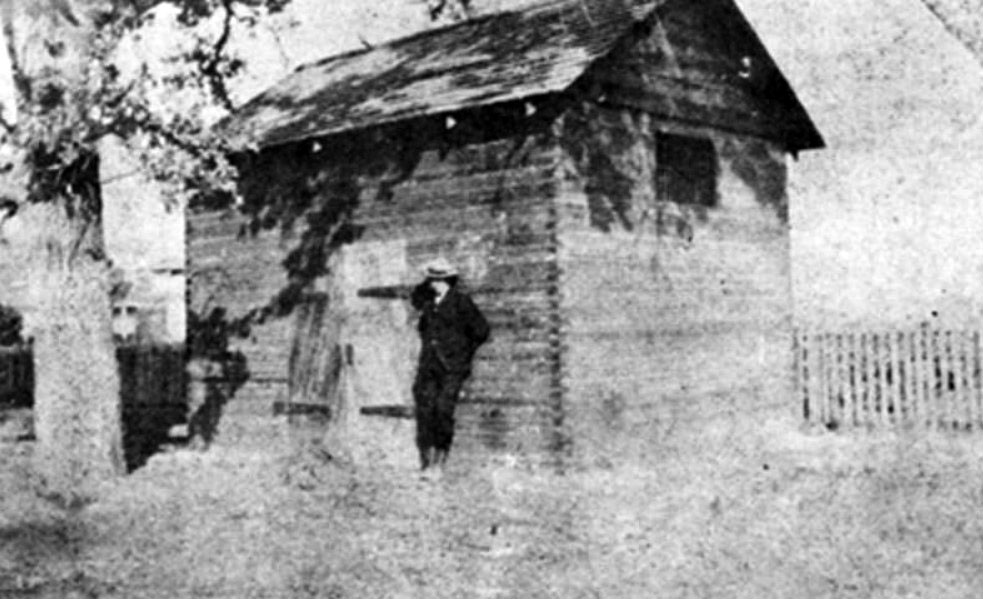 |
|
| (ca. 1902)^ - A man leaning against the Calabasas jail house. A corner of the Leonis Adobe can be seen between the hangmans tree and the jail. |
Historical Notes The Calabasas jail house was built in 1869 and served the small frontier settlement when Calabasas was a stagecoach stop along the road between Los Angeles and the Ventura coast. The jail was moved to Chatsworth in 1902 and was torn down in 1910. The property now occupied by the Sagebrush Cantina originally held a group of small stores built by Lester Agoure Sr. in the early 1920s. The parking lot once held the town jail. The dead hangmans tree, which still stands today, later became the symbol of the Calabasas Chamber of Commerce. |
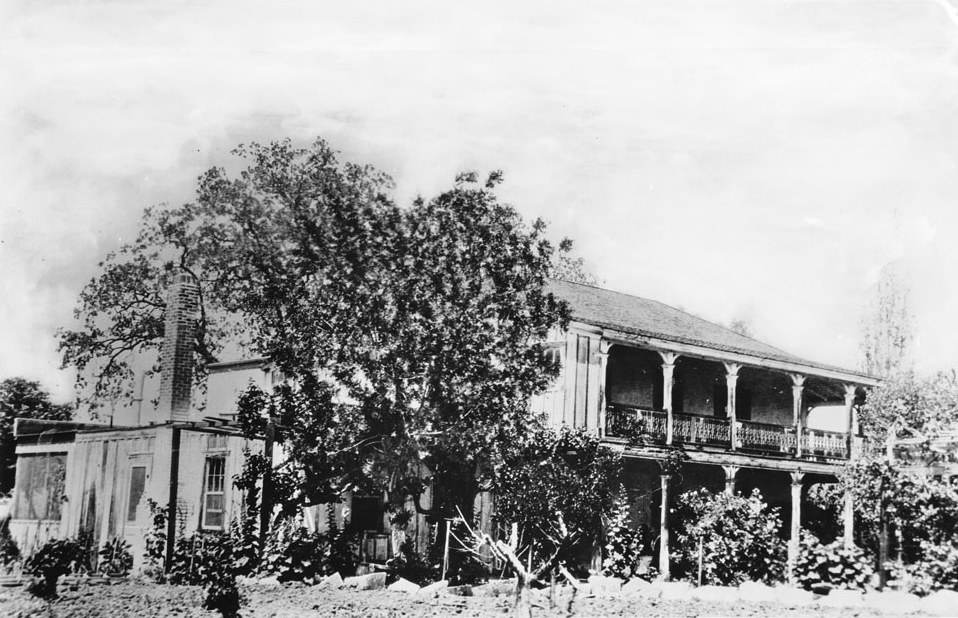 |
|
| (ca. 1915)* - The Leonis Adobe around 1915. The two story home has a covered porch and balcony on the right, along with a brick chimney. Although known as an adobe, much of the visible structure is wood, added during later remodeling. Trees and thick landscaping partly hide the front of the house, a common practice meant to block dust from nearby ranch activities. |
Historical Notes By the early 1960s the adobe had been damaged by neglect and vandalism. In 1961 the owner applied for a permit to demolish the building and replace it with a supermarket. Preservation advocates stepped in and succeeded in having it declared a Historic Cultural Monument in 1962, the first structure in Los Angeles to receive that designation. The Leonis Adobe is also known for its long history of reported ghost stories and was featured in the British television series Most Haunted in 2005. The property was restored and now operates as a living museum of early ranch life in the San Fernando Valley. It was added to the National Register of Historic Places in 1975. Click HERE to see the LA Historic-Cultural Monuments List. |
* * * * * |
Weddington Bros. Store
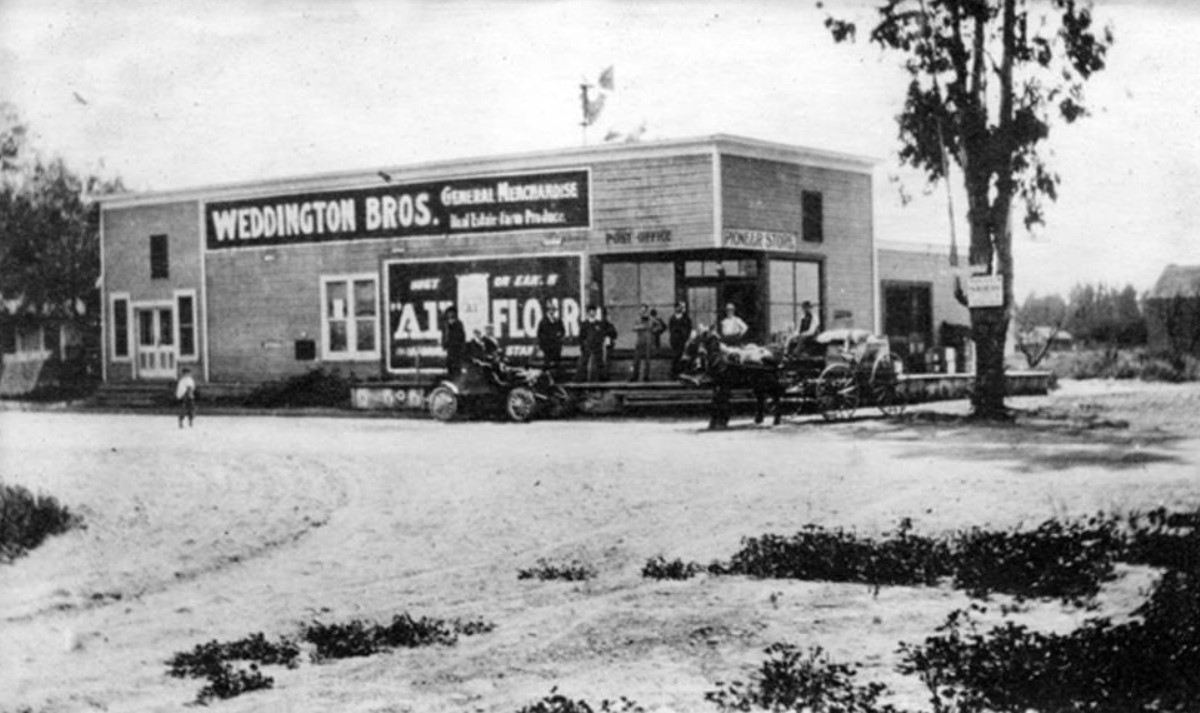 |
|
| (1905)#^ - The Weddington Bros. General Merchandise Store was established in the 1890s and was stocked with groceries and dry goods. The store was owned by Wilson C. Weddington who was a very prominent citizen and civic leader of North Hollywood. |
Historical Notes Wilson C. Weddington was an important figure in the Valley. He established the Weddington Store in the 1890's and was influential in establishing North Hollywood, serving as President of the Chamber of Commerce from 1927 to 1929. He purchased 12 acres of land at $60 an acre, later purchasing an additional 20 acres.*^^^ |
Whitley Mansion
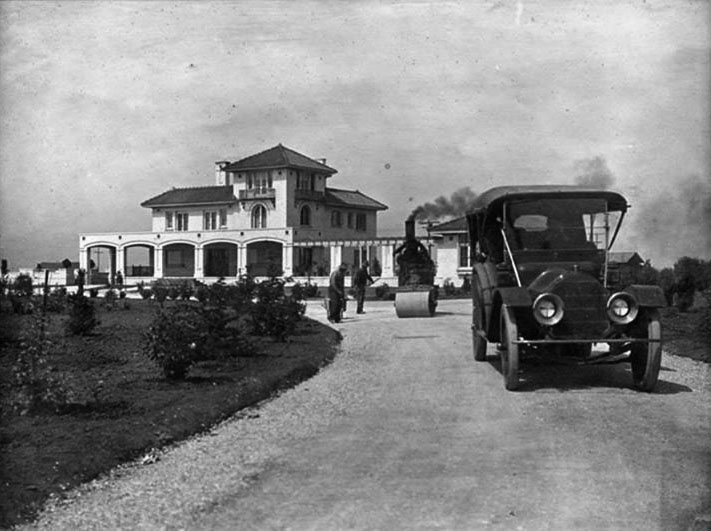 |
|
| (ca. 1910)*^^^ - View of the Whitley Mansion located at 5849 Van Nuys Boulevard. Two men are standing on the driveway next to a steamroller that has smoke billowing out of its stack. On the right, a man is seen behind the wheel of an early model automobile. |
Historical Notes Hobart Johnstone Whitley, also known as H.J. Whitley and the "Father of Hollywood", was a real estate developer who helped create the Hollywood subdivision in Los Angeles. He is also known for helping develop the San Fernado Valley. After Whitley saw the San Fernando Valley and heard of Mulholland's ideas for a new aqueduct, he began discussing opportunities with business associates in Los Angeles. The city's approval of the Los Angeles aqueduct project in 1905, with a proposed terminus in the San Fernando Valley, inspired the formation of a land speculation syndicate, the Los Angeles Suburban Homes Company. Its partners included Whitley, Isaac Newton Van Nuys, General Moses Sherman, James Boon Lankershim, and Harry Chandler, manager of the "Los Angeles Times," as director. The Los Angeles Suburban Homes Company syndicate purchased the 47,500-acre parcel from the Los Angeles Farming and Milling Company, owned by Van Nuys and son-in-law Lankershim, in 1909. It comprised nearly the entire south half of the San Fernando Valley (south of present day Roscoe Blvd.). The price was $2,500,000, or just under $53 an acre. On the land he planned the new towns of Van Nuys, Marian (present day Reseda), and Owensmouth (present day Canoga Park and West Hills. Though located 15 miles to the southwest, Owensmouth was named for the new Owens River aqueduct's terminus/mouth in the northern valley, that opened in 1913. The Janss Investment Company was contracted for developing and promoting Van Nuys and Owensmouth.*^ |
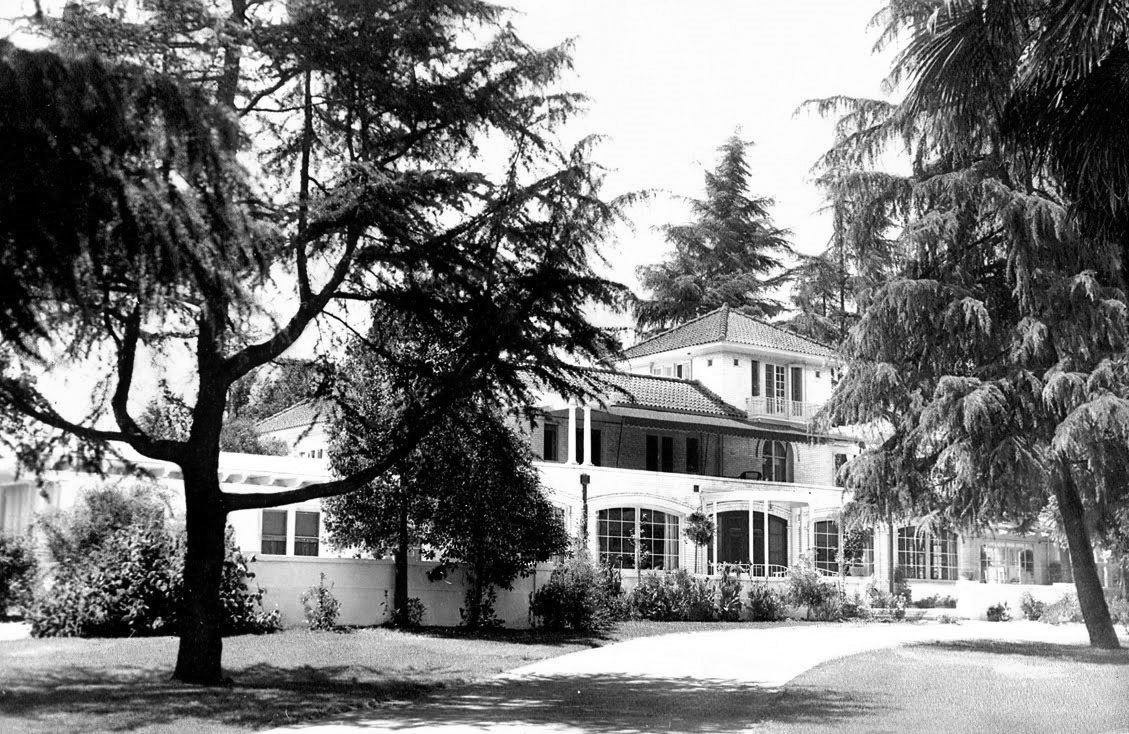 |
|
| (ca. 1920s)^^# – View of the Whitley Mansion of Van Nuys, later to become a funeral home. |
Historical Notes The Whitley Mansion was eventually sold to the Praiswater Family and in 1939 became the Praiswater Funeral Home. Keyes Toyota Dealership on Van Nuys Boulevard now stands where the Whitley - Praiswater Mansion once graced the San Fernando Valley. No trace of the original structure remains today. |
* * * * * |
.jpg) |
|
| (1910)* - View looking north across the San Fernando Valley. Vast amounts of farmland can be seen throughout. |
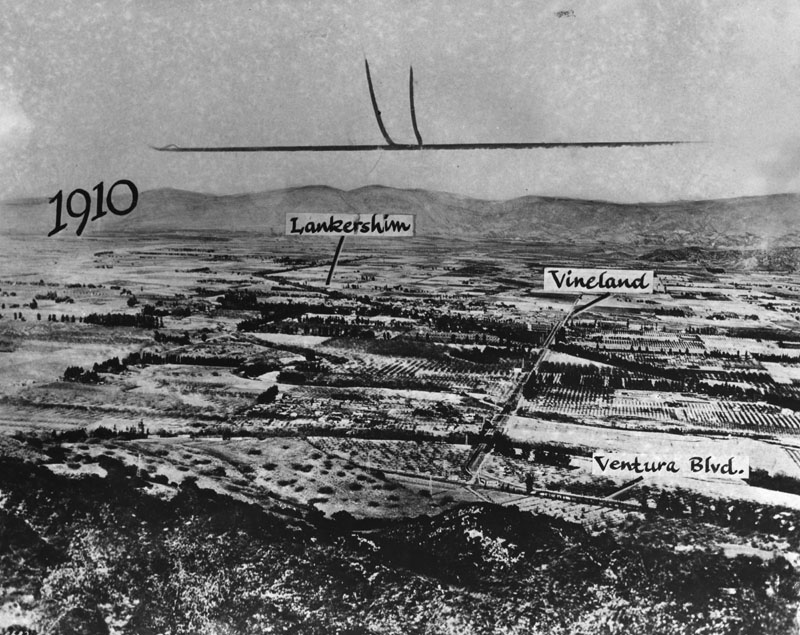 |
|
| (1910)* - Road on top left is Lankershim. Road that comes straight down on the right is Vineland, which curves into Ventura Boulevard (same as previous photo except for street names being highlighted). |
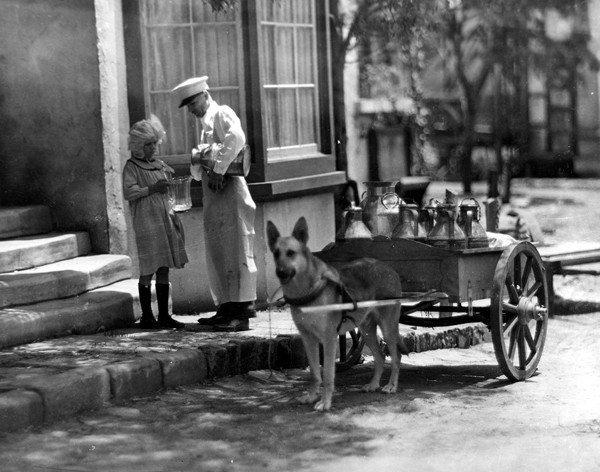 |
|
| (ca. 1910)^ - Milk delivery by dog cart, probably around 1910. This was taken at the intersection of Ventura Blvd. and Lankershim Blvd. The milkman is pouring milk into a pitcher. |
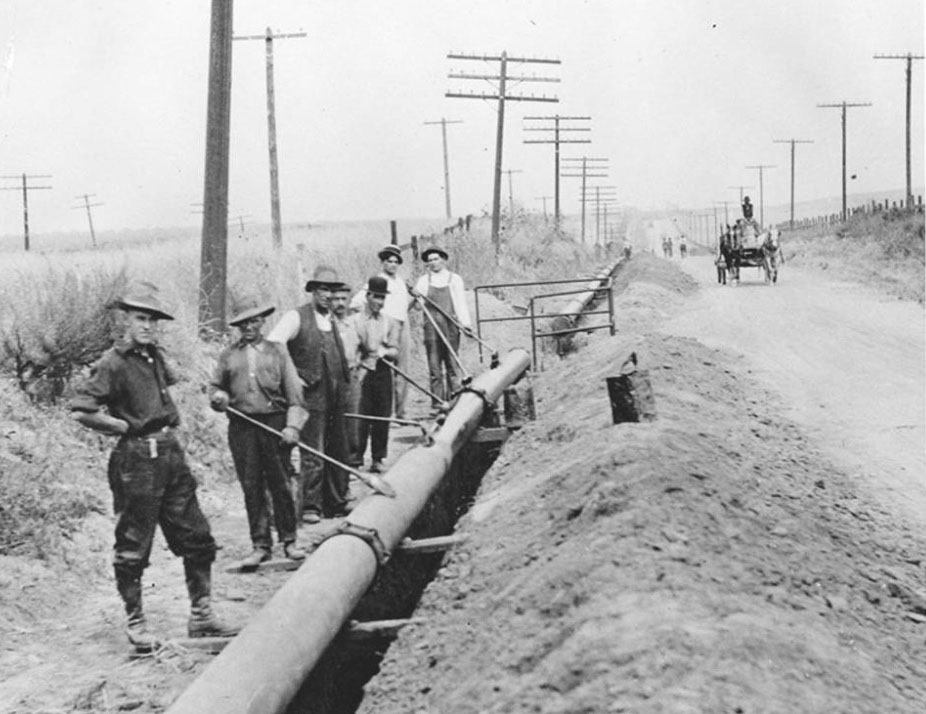 |
|
| (1910)^ - Workers putting in a new gas line along San Fernando Road. |
Historical Notes The San Fernando Rd. gas line was completed in 1912 and by 1913, gas was transported to Burbank from the natural gas fields in Taft, CA. Gas services would reach Tujunga by 1924. |
* * * * * |
Lankershim Development Co. and Los Angeles Suburban Homes Co. (aka The Syndicate)
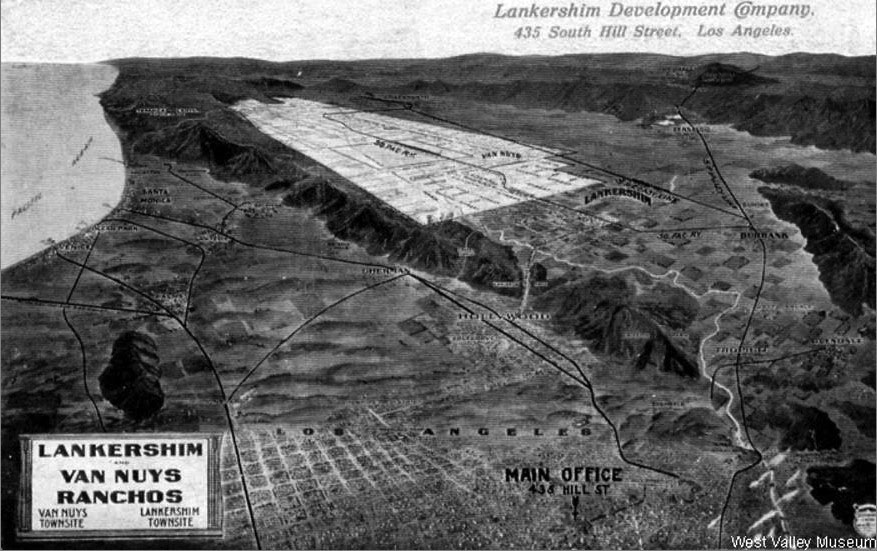 |
|
| (ca. 1910)^ – Postcard showing early development in the San Fernando Valley. The map is marked to identify the routing of a new Red Line that would run from Hollywood through Cahuenga Pass and then to the towns of Lankershim (North Hollywood) and Van Nuys. The Lankershim Development Company was located in downtown LA and developed the towns of Lankershim (North Hollywood) and Van Nuys. |
Historical Notes As the City of Los Angeles authorized building 'William Mulholland's' Los Angeles Aqueduct from the Owens Valley to the city and valley, land speculation plans for the Los Angeles Farming and Milling Company property in the San Fernando Valley were developed. Construction began in 1905. Dryland farming could now be turned into crops, orchards and residential towns. In the "biggest land transaction ever recorded in Los Angeles County", a syndicate led by Harry Chandler, business manager of the Los Angeles Times, with Isaac Van Nuys, Hobart Johnstone Whitley, and James B. Lankershim acquired "Tract 1000", the remaining 47,500 acres of the southern half of the former Mission lands—everything west of the Lankershim town limits and south of the old furrow (present day Roscoe Boulevard) excluding Rancho Los Encinos and Rancho El Escorpión. As the Los Angeles Suburban Homes company, they laid out plans for the towns of Van Nuys, Marian (now Reseda) and Owensmouth (now Canoga Park and West Hills), a system of highways, and incorporation by the city of Los Angeles to get the Owens River water. In the "Sale of the Century" in November 1910 they sold the remaining livestock and non-land assets of the Lankershim Farming and Milling Company at auction. The Los Angeles Times called the auction "the beginning of a new empire and a new era in the Southland". On February 22, 1911, lot sales begin at the new town of Van Nuys, California. |
Sherman Way - "The $500,000 Boulevard"
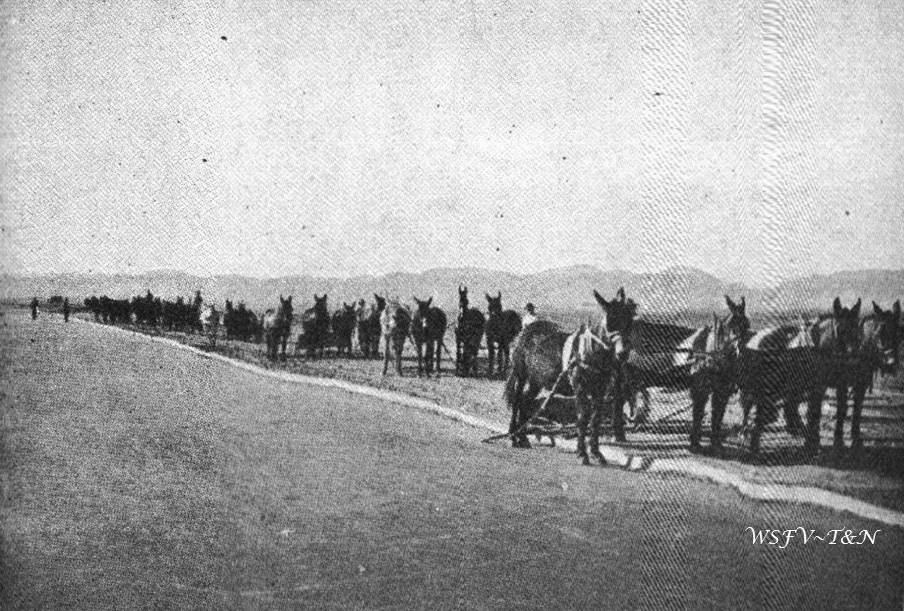 |
|
| (1910)* - View showing the construction of Sherman Way, the $500,000 Boulevard, with the assistance of teams of mules. |
Historical Notes In 1910, the board of the Los Angeles Suburban Homes Company sat down to discuss the land they had bought the previous year. One of the subjects was roads. The existing roads were bumpy and Isaac Van Nuys refused to let the new owners strew the roads with straw to keep the dust down, due to his fear of fires destroying crops. The Board felt it was important to build a good oiled road for general traffic, all through their land and up to the Workman Station (Owensmouth area), for the purpose of showing the land they would be selling. Two names were voted on for this road: Auto Speedway and Sherman Way. Sherman Way won the vote (only Whitley voted for the other), named for General Moses Hazeltine Sherman , one of the five board members. To H.J. Whitley, who wanted to be known as “The Great Developer,” palm trees were a necessary adornment. He had them planted in 1911 along the twenty-two miles of Sherman Way that traversed the length of the San Fernando Valley. The boulevard’s broad sweep was patterned after the Paseo de la Reforma in Mexico City and served as a sales enticement, much like the fountain-punctuated, artificial lakes of modern desert developments. |
* * * * * |
Van Nuys - "The Town That Started Right"
.jpg) |
|
| (1911)* - Site of the future Van Nuys in 1911 looking north, showing work being done on Van Nuys Boulevard. Virginia Street (later Sylvan Ave.) is marked, behind which is an oil derrick. Tracks and a railcar are seen in the foreground. |
Historical Notes In 1910, developers Moses Hazeltine Sherman, Harry Chandler, H. J. Whitley, and others formed the Los Angeles Suburban Homes Company and purchased nearly 48,000 acres of the old Van Nuys and Lankershim ranch lands. Their plan was to create a series of modern towns throughout the San Fernando Valley—Van Nuys, Marion (now Reseda), and Owensmouth (now Canoga Park). The location was chosen with care: flat, fertile land, near the path of the coming Owens River Aqueduct, and close enough to Los Angeles to be reached by rail. The first major improvement was grading and paving what would become Van Nuys Boulevard, shown here under construction. The Pacific Electric Railway’s tracks were laid down the center of the street to connect the Valley with downtown Los Angeles. The oil derrick in the background reminds us that the Valley was still a mix of farms, ranches, and oil leases before the suburban transformation began. |
.jpg) |
|
| (1911)* - Right panel view showing the railroad tracks crossing Van Nuys Boulevard. A partial view of the train depot is seen on the right. Note the vast expanse of open land toward the northeast. |
Historical Notes The railroad seen here was part of the Pacific Electric system—often called the “Red Cars.” The company built an extension into the San Fernando Valley in 1911–1913, making Van Nuys one of the first fully planned “streetcar suburbs” in Los Angeles history. The new line through Cahuenga Pass was completed in December 1911, and full service from downtown Los Angeles to Van Nuys began in March 1913. The depot visible on the right served both freight and passengers, and it became a lifeline for the early community. Farmers shipped crops to city markets, and home buyers rode the Red Cars out to view and purchase land. This integration of transportation, water, and real estate was deliberate—the developers believed that good planning and reliable infrastructure would attract permanent residents, not just speculators. The wide open fields in the distance would soon fill with homes, businesses, and orchards, following the arrival of city water in 1913 and the annexation of the area to Los Angeles in 1915. |
 |
|
| (1911)* - "Opening of the new town of Van Nuys" - February 22, 1911. This panoramic view shows a long procession of people walking away from the train depot toward the camera, some carrying luggage. A train unloading passengers is seen in the background. On the right, an early model car is seen heading toward a second train. |
Historical Notes On February 22, 1911—George Washington’s Birthday—the developers staged a grand opening for the new town of Van Nuys. Excursion trains carried hundreds of prospective buyers and guests from Los Angeles to the brand-new depot, where they were greeted with flags, music, and a huge barbecue lunch. The event marked the official start of lot sales and the founding of Van Nuys. The Los Angeles Suburban Homes Company advertised the Valley as the “Garden Spot of the World,” promising a new life where clean air, sunshine, and cheap land could turn settlers into prosperous farmers and homeowners. The presence of automobiles, trains, and large crowds in this photo captured the spirit of optimism and progress that defined early twentieth-century Los Angeles. The opening day was a complete success. Nearly every lot offered was sold, and within a year Van Nuys had stores, schools, a bank, and growing neighborhoods. |
Then and Now
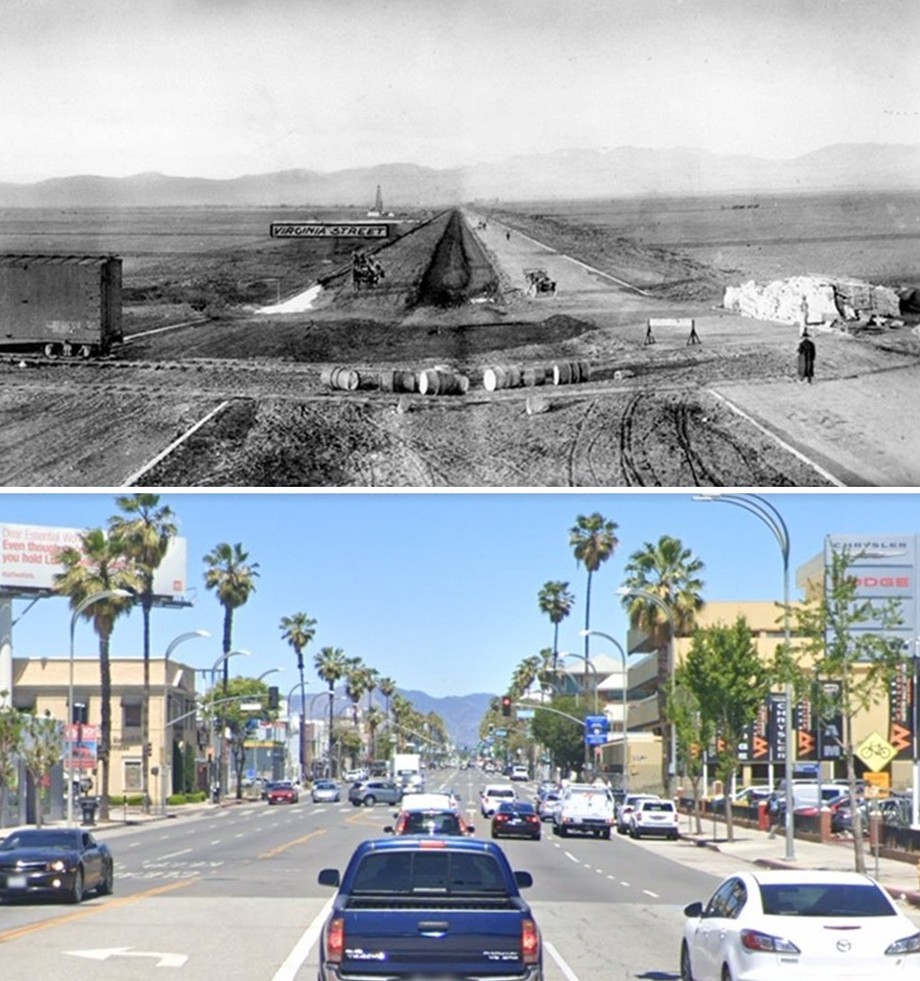 |
|
| (1911 vs. 2021)* - View looking North on Van Nuys Boulevard from near Delano Street. Virginia Street (seen in above photo) later became Sylvan Street. Photo comparison by Jack Feldman. |
Historical Notes The first photograph shows Van Nuys Boulevard as a wide dirt roadway being graded in 1911, with only survey stakes and rail tracks hinting at the future city. The 2021 view shows a busy commercial corridor filled with cars, shops, and offices—a striking reminder of how quickly the San Fernando Valley changed once water, transportation, and opportunity came together. From its earliest days, Van Nuys was designed to be the civic and commercial heart of the Valley. The careful layout, transportation planning, and marketing success in 1911 truly made it, as the slogan promised, “The Town That Started Right.” |
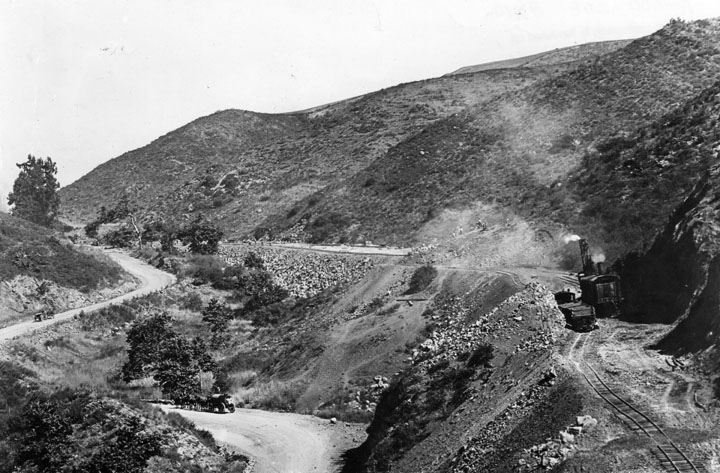 |
|
| (1911)* - Tracks are being built through the hills of the Cahuenga Pass as shown on the right side of this picture. On the lower road can be seen supplies coming and going by teams of horses and wagons |
Historical Notes In 1911, General Sherman (as he was called) added an extraordinary streetcar line. Built over Cahuenga Pass, through North Hollywood to the 1911 town site of Van Nuys, and on to the 1912 town site Owensmouth, now Canoga Park. Wilson C. Weddington, an early Valley pioneer who founded the Weddington Bros. General store, was also instrumental in bringing the Red Car to the Valley. |
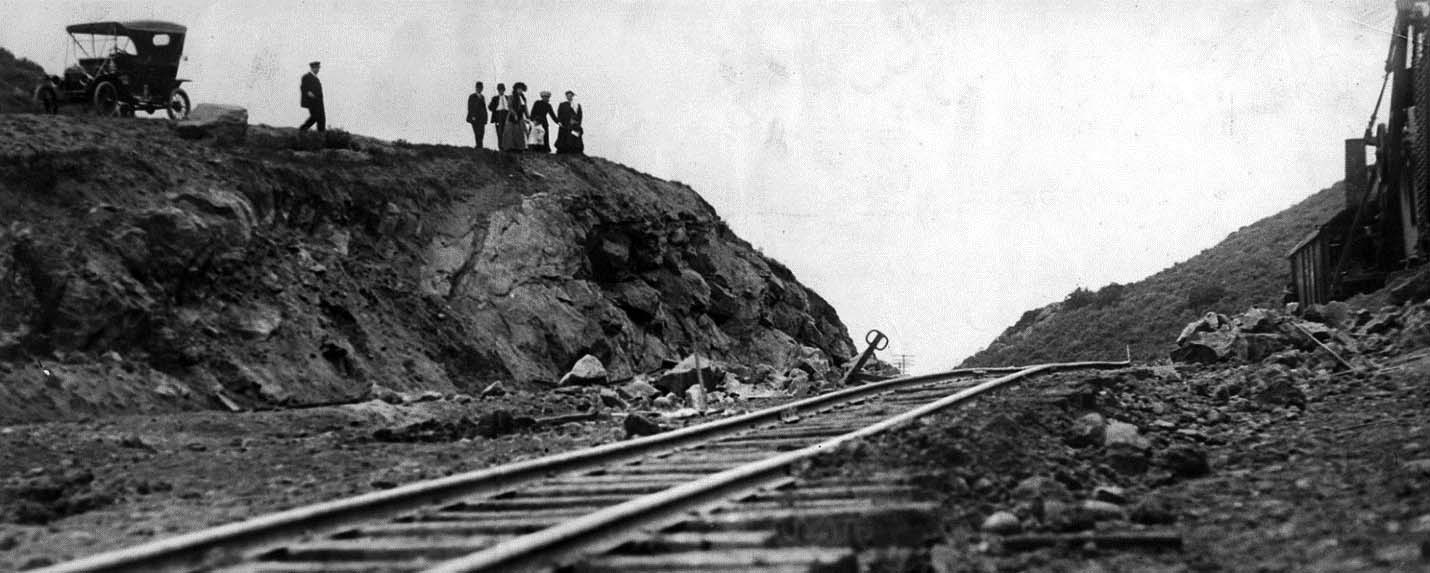 |
|
| (1911)* - LA Times photo showing sightseers checking out the new Pacific Electric trolley line being built in the Cahuenga Pass between Hollywood and the San Fernando Valley. |
Historical Notes The original April 9, 1911, Los Angeles Times caption reported: Electric Line to Van Nuys Through Cahuenga Pass. This picture shows the railroad as now laid to the highest point in the gap which unites Hollywood with the rich San Fernando Valley. The road will be in operation early in the summer. Express trains connecting the town of Van Nuys with Los Angeles will make only one stop, Hollywood. |
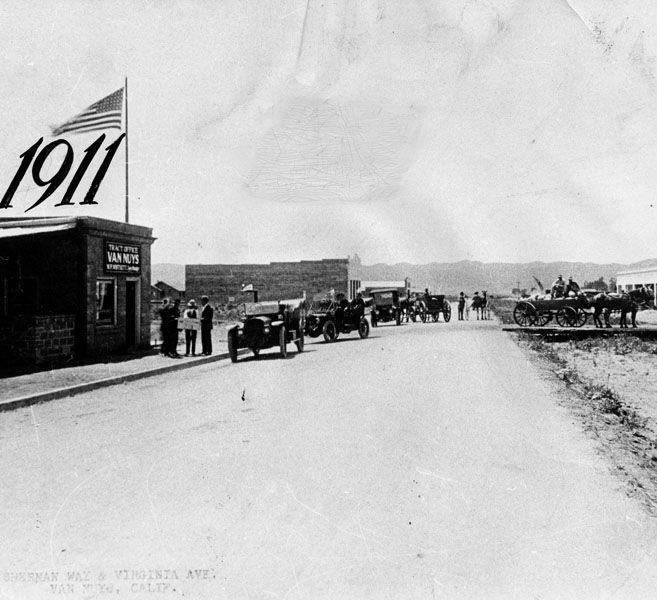 |
|
| (1911)* - Downtown Van Nuys shortly after the community was started. On left is W.P. Whitsett's tract office for selling land on the corner of what is now Van Nuys Blvd. and Sylvan Street. |
Historical Notes Van Nuys Boulevard was then called Sherman Way and Sylvan Street was known as Virginia Street. |
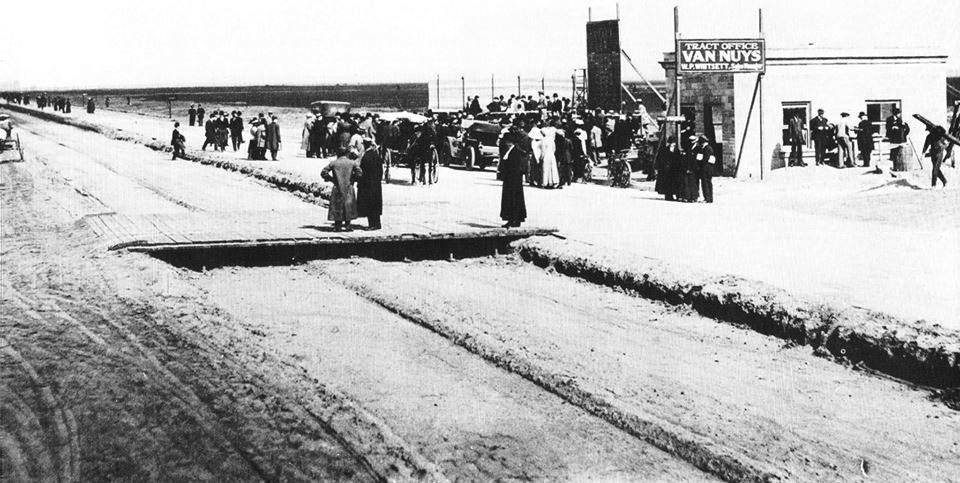 |
|
| (1911)* – View showing prospective customers congregating around the Van Nuys tract office. Sign reads: ‘ Tract Office – Van Nuys – W.P. Whitsett. Note the wooden crossing over a trench seen in the foreground. This is the center of Van Nuys Boulevard (at the time known as Sherman Way). The trench is where streetcar rails would be layed. |
 |
|
| (1911)^^#^ - Workers laying the rails for the Pacific Electric Line in Van Nuys. |
Historical Notes The streetcar line in the so-called “Town That Started Right” ran 19 miles from Los Angeles along Chandler Boulevard from Lankershim (now North Hollywood), turning up Van Nuys Boulevard to Sherman Way. |
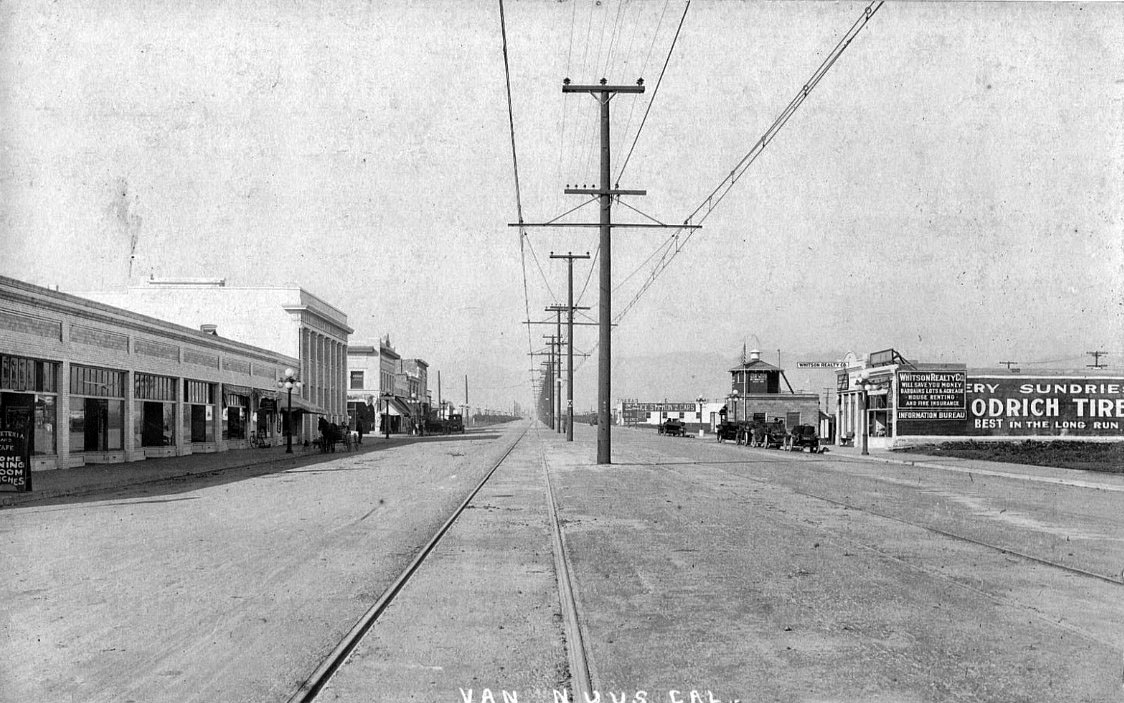 |
|
| (ca. 1911)#^# – Postcard view showing Van Nuys Boulevard shortly after the installation of Pacific Electric streetcar tracks. |
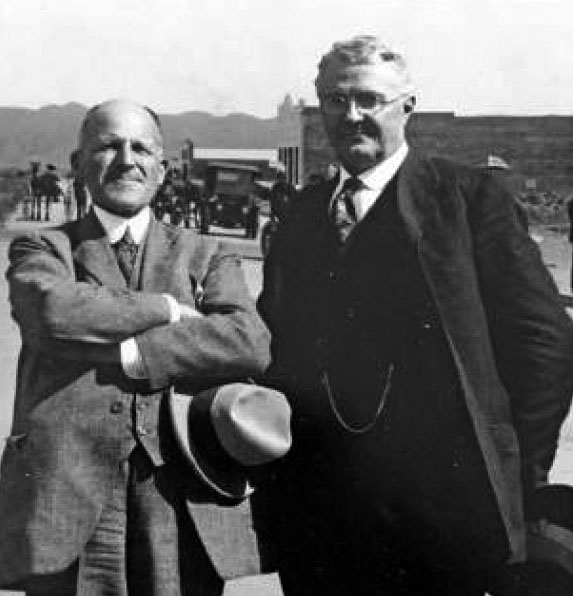 |
(ca. 1911)### - Moses H. Sherman (L) and Harry Chandler (R) standing on Van Nuys Boulevard at the heart of their new land development. |
|
Historical Notes Moses Sherman and Harry Chandler (along with Gen. H. G. Otis, H. J. Whitley, and Otto F. Brant) were two of the five original investors in the Suburban Home Company (aka The Syndicate). Each of the major partners put up $100,000. |
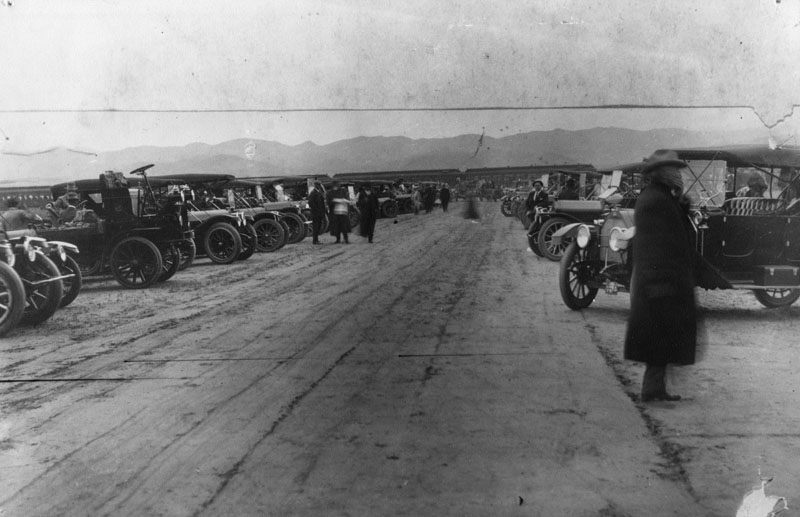 |
|
| (1911)* - People stand by their parked cars in anticipation of the arrival of the Valley's first Pacific Electric streetcar. A train is seen in the background of an unpaved road. |
Historical Notes Along with the streetcar line, Moses Sherman also built the "$500,000 boulevard" named Sherman Way next to the tracks all of which were the key to the development of the Valley. By 1912, 45 minute streetcar service from Van Nuys to downtown and the "no speed limit" paved road (if you could get your "Model A" to do 30 mph) were key selling points. |
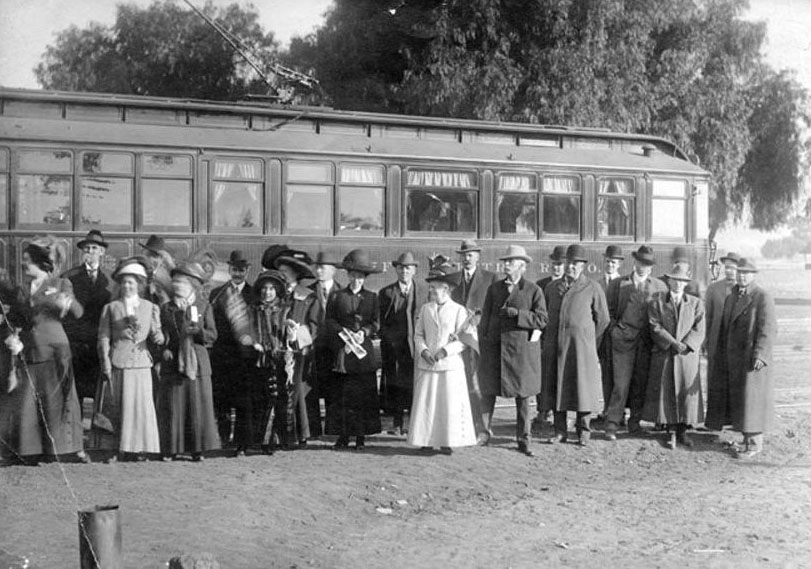 |
|
| (1911)* - View of a group of well-dressed people standing in front of the first "Red Car" to arrive in Lankershim (North Hollywood). The streetcar then continued on its journey to Van Nuys. |
.jpg) |
|
| (1911)#** - View showing the ceremony for the arrival of the first Pacific Electric "Red Car" in Van Nuys. Note the photographer with tripod-mounted camera at lower right. |
Historical Notes The Hollywood-Van Nuys Extension was completed in December, 1911, and the first car entered Van Nuys on December 16, 1911. |
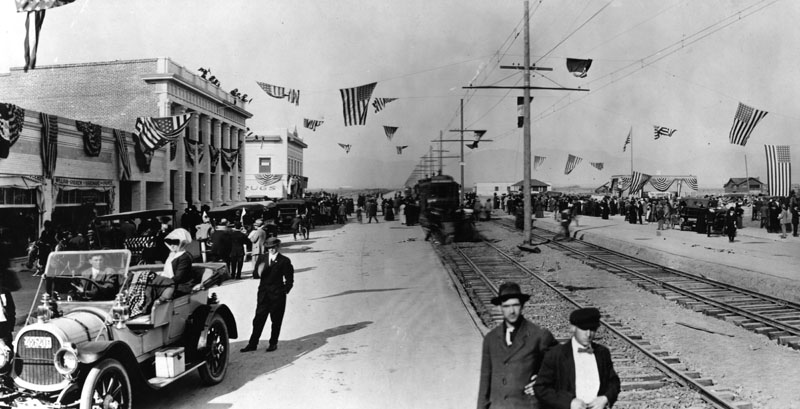 |
|
| (1911)* - View showing a crowd of people in Van Nuys at the arrival of the first Pacific Electric "Red Car." American flags are draped over buildings and on lines that run over the tracks. |
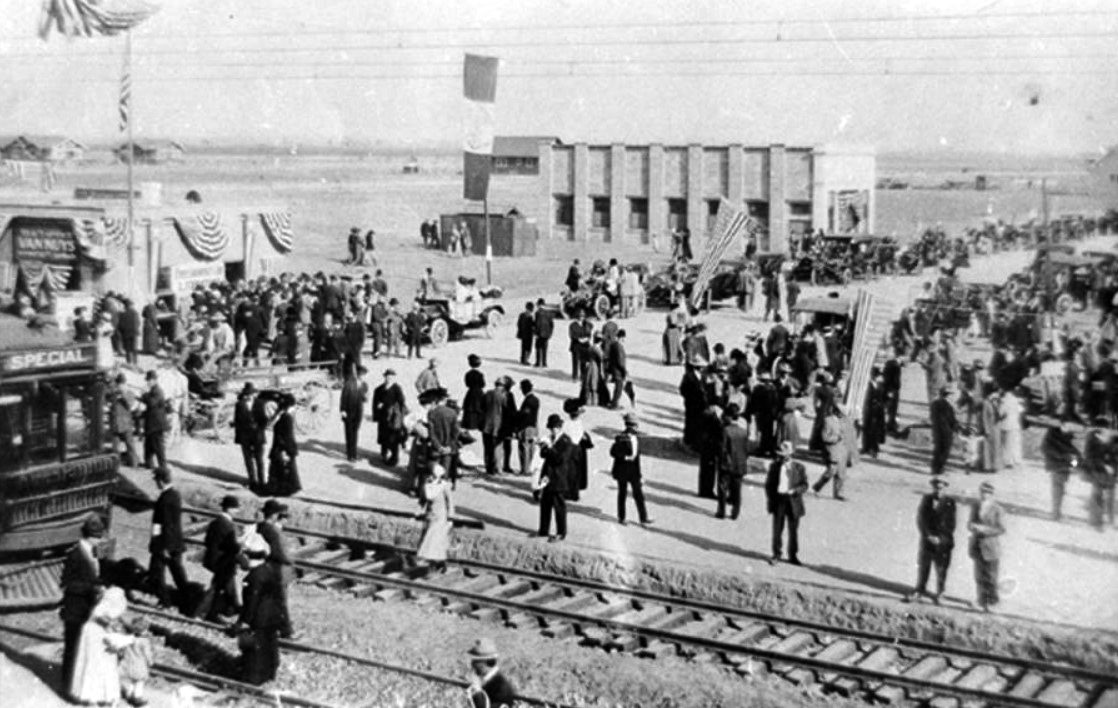 |
|
| (1911)#^ - View showing hundreds of people at the arrival of the first Pacific Electric Car in Van Nuys. The Van Nuys Tract office, visible behind the train, is open for business. |
Historical Notes The day was a time of rejoicing and the Valley was connected to the City in a way which was to see its grain fields cut up into building lots and homes. |
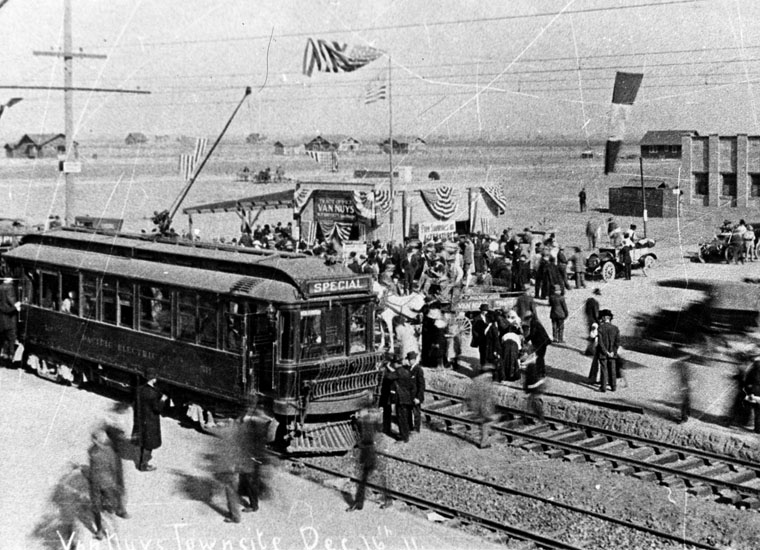 |
|
| (1911)* - Crowds of people surround the first streetcar to arrive in Van Nuys on December 16, 1911. |
Historical Notes From North Hollywood to Kester Junction, a distance of 2.26 miles, this line originally shared the right-of-way and finally the rails of Southern Pacific’s North Hollywood Branch. |
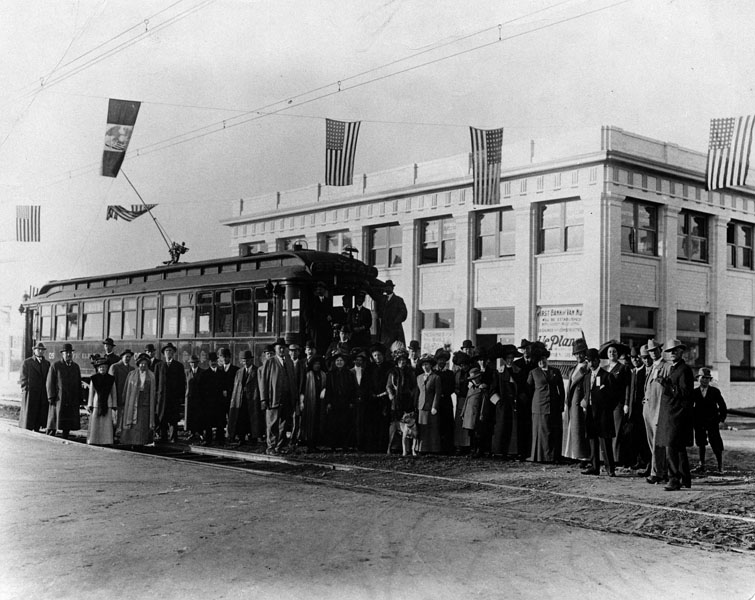 |
|
| (1911)* - View showing a group of people posing in front of the Van Nuys' first streetcar with flags flying overhead. |
Historical Notes After completion of the Hollywood-Van Nuys Extension, construction crews were immediately shifted to the two branches: Owensmouth and San Fernando. The Van Nuys-Owensmouth Extension was begun in January 1912, and final work was completed in July 1913. It was possible to operate cars thorough to Owensmouth considerably earlier, however; Owensmouth welcomed its first big red car on December 7, 1912. The Van Nuys-San Fernando Extension got under way in January 1912, also. It was completed in March 1913, with the first car rolling into San Fernando on March 22, 1913. |
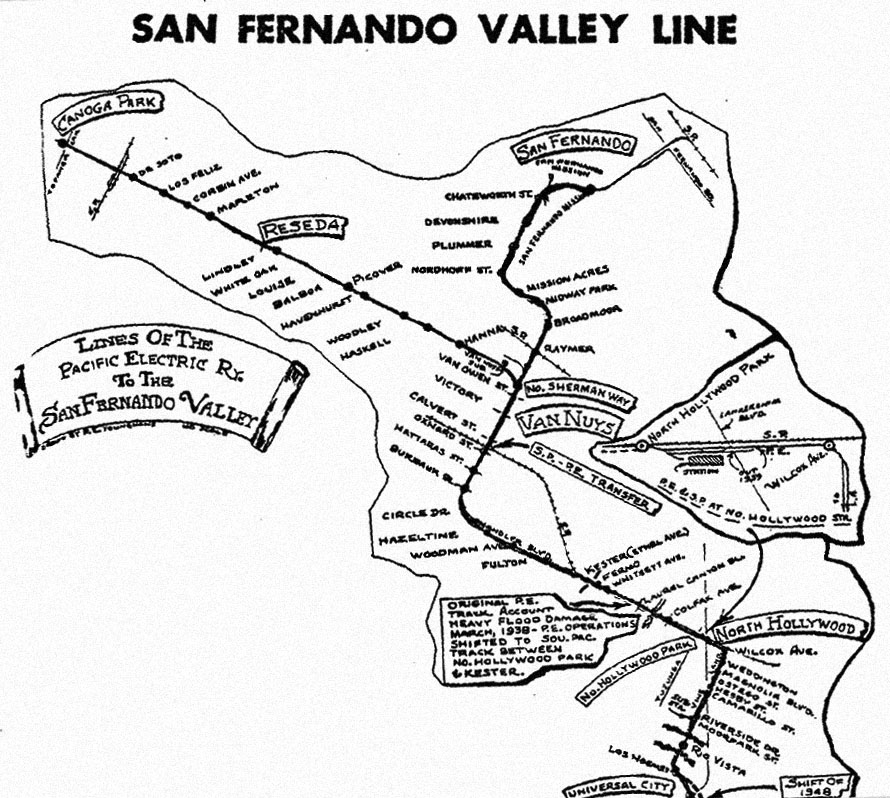 |
|
| (1911 - 1952)***^^ - Map showing the Lines of the Pacific Electric Ry. in the San Fernando Valley. |
Historical Notes The San Fernando Valley line followed the Santa Monica Boulevard line as far as the intersection of Santa Monica and Highland Avenue (7.12 miles). There it turned north on Highland Avenue, using the tracks of the Highland Avenue line to the mouth of Cahuenga Pass (MP 8.66) where its own trackage commenced. This line originally negotiated Cahuenga Pass via a double track line located to the east of the highway. Construction was quite difficult and its successful completion was regarded at the time as being somewhat of a triumph for the Los Angeles Pacific construction crews. Once through the pass, the line passed Universal City (11.11 miles) and arrived at Lankershim (North Hollywood) where the double track ended, 13.83 miles from the Subway Terminal in Downtown Los Angeles. From Kester Junction this line proceeded on its own single track to the town of Van Nuys, passing through the town on double track to North Sherman Way, 19.93 miles, where the line branched into two lines. One branch turned west on Sherman Way, arriving at Reseda, 24.91 miles, and finally at its terminus, Owensmouth (Canoga Park), 29.10 miles. This was single track except for short portions of double track through the two towns. The other branch continued north from Sherman Way via Mission Acres (MP 22.81), Plummer (MP 23.81) and the San Fernando Mission to the city of San Fernando (MP 27.47). This also was single track save for about three blocks of double track operation in the city of San Fernando. Operation through to Owensmouth and San Fernando was terminated on June 1, 1938; thereafter the terminus of this line was at Van Nuys Boulevard and North Sherman Way. On December 28, 1952, busses over the Hollywood Freeway replaced all rail service on this line. |
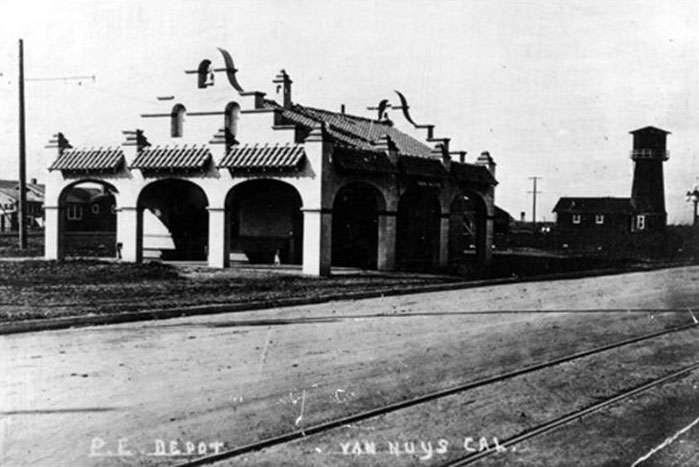 |
|
| (1914)* – View showing the Van Nuys Pacific Electric Station. To the right is the Van Nuys Water Company's pump house and water tower. |
Historical Notes The new LA-Valley streetcar system was so successful that by 1913, over 368,000 passengers rode the line, and by 1926 that number topped one million. |
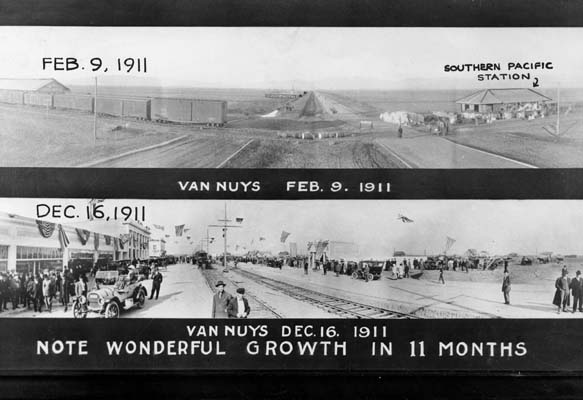 |
|
| (1911)*^ - A sample of the growth boom in Van Nuys, February-December, 1911. |
Historical Notes The sprawling San Fernando Valley was a vast field of grain when the Los Angeles Pacific (LAP) began building north through the Cahuenga Pass from Hollywood in 1911. During the course of construction the LAP was merged with the Pacific Electric (PE). By the time of its completion the line was PE. |
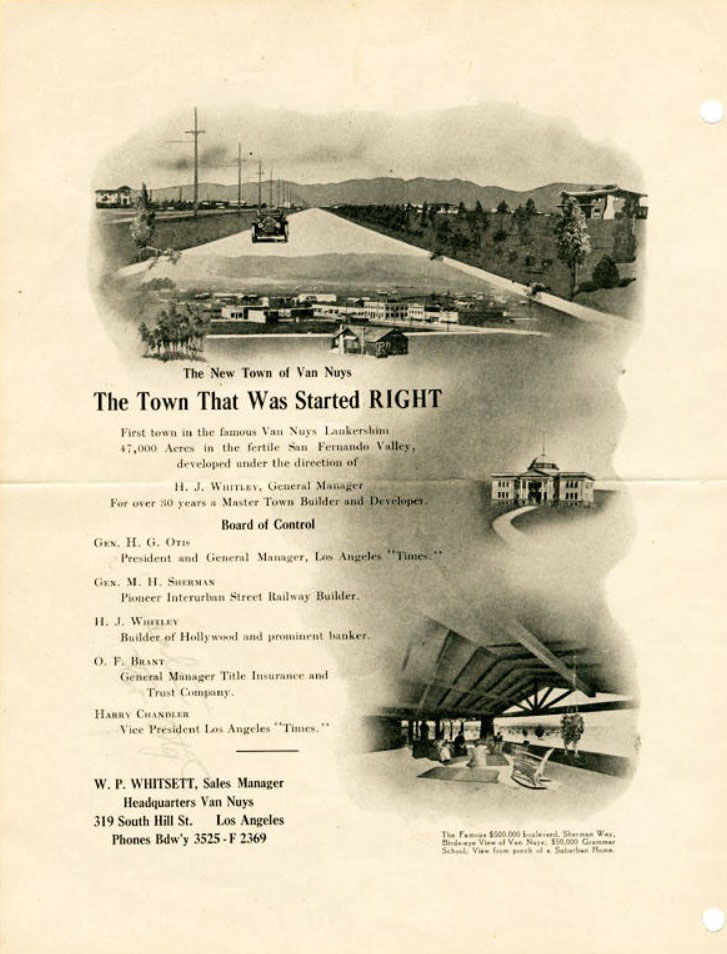 |
|
| (ca. 1912)#^ - Brochure for W. P. Whitsett's free automobile tour to Van Nuys. |
Historical Notes Above is the inside of a 2-sided brochure that was handed out to prospective buyers during their free automobile tour of Van Nuys. It was a promotion developed and coordinated by W. P. Whitsett. The brochure also identifies the 'Control Board' members of the Los Angeles Suburban Homes Company: Gen. H. G. Otis, Gen. M. H. Sherman, H. J. Whitley, O. F. Brant, and Harry Chandler. It also identifies W. P. Whitsett as the Sales Manager. |
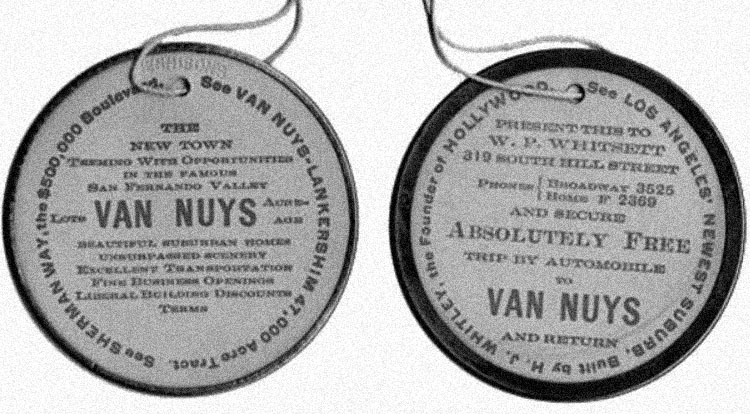 |
|
| (ca. 1912)#^ - Tag advertising a free trip by automobile from downtown Los Angeles to the San Fernando Valley. |
Historical Notes Whitsett began to develop Van Nuys as early as 1910. To promote his development, he passed out coupons in the form of tags that offered a free tour of Van Nuys by automobile. |
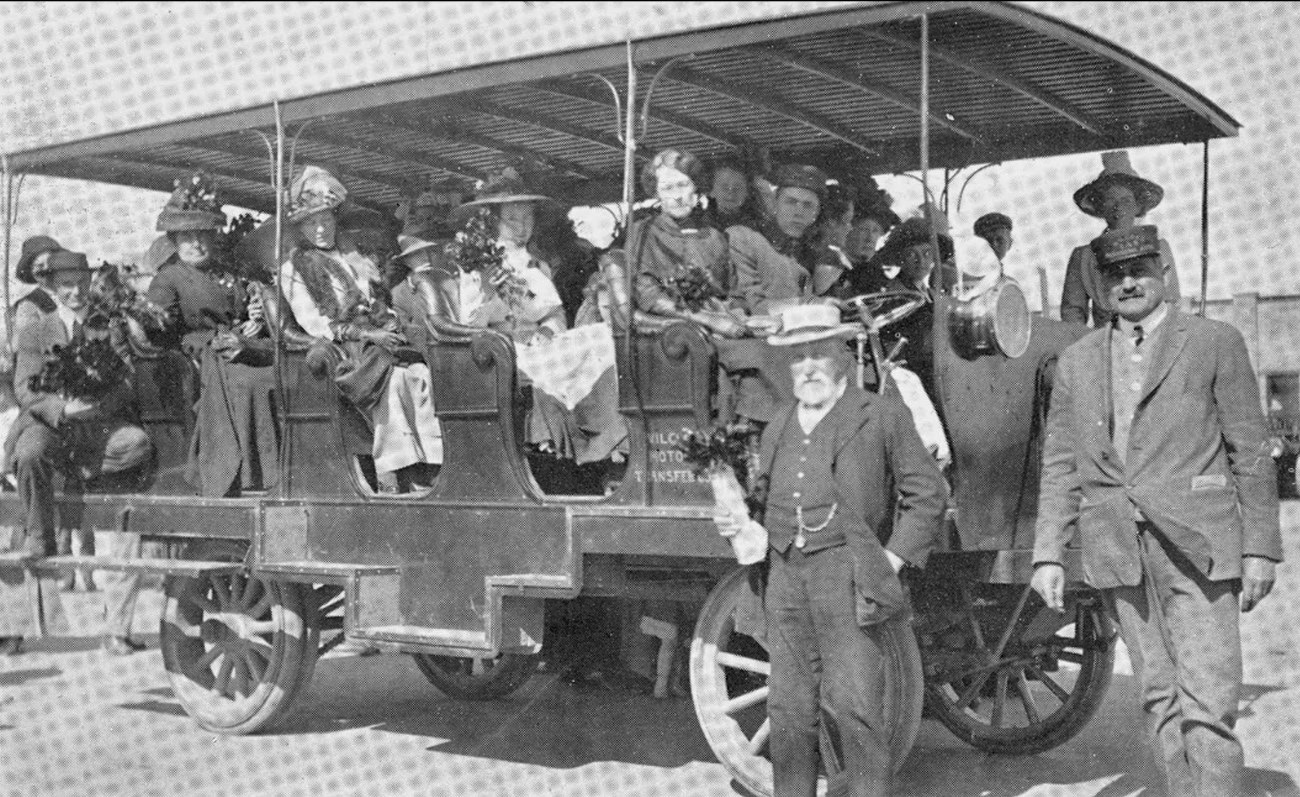 |
|
| (1911)* - Early motor coach used to bring prospective buyers to Van Nuys. Sign on the side of vehicle reads Wilcox Motor Transfer. |
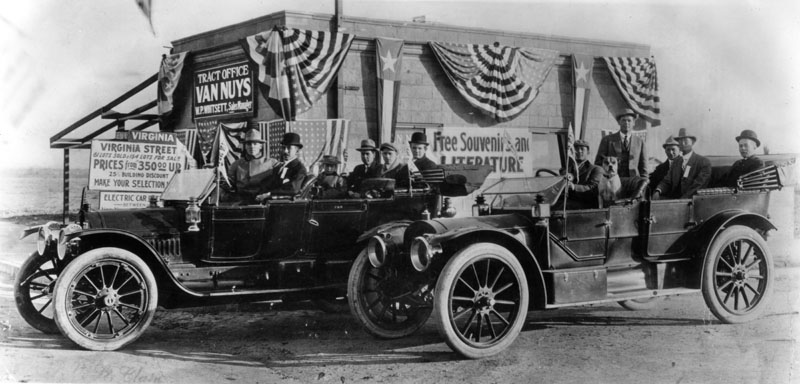 |
|
| (1912)* - Opening of the first tract office in Van Nuys at North Sherman Way (later Van Nuys Boulevard) and Virginia Street (later Sylvan Street) in 1912, with two carfulls of eager salesmen waiting. W.P. Whitsett was the sales manager of the office. Lots started at $350. |
Historical Notes W. P. Whitsett was extremely successful in bringing prospective land and home buyers into the Valley. Whitsett Avenue was named after William P. Whitsett who is remembered by some as the "Father of Van Nuys." He was also a major land developer and water official in Los Angeles. The street was first known as Encino Avenue.^* Click HERE to see more SFV Street Name Origins. |
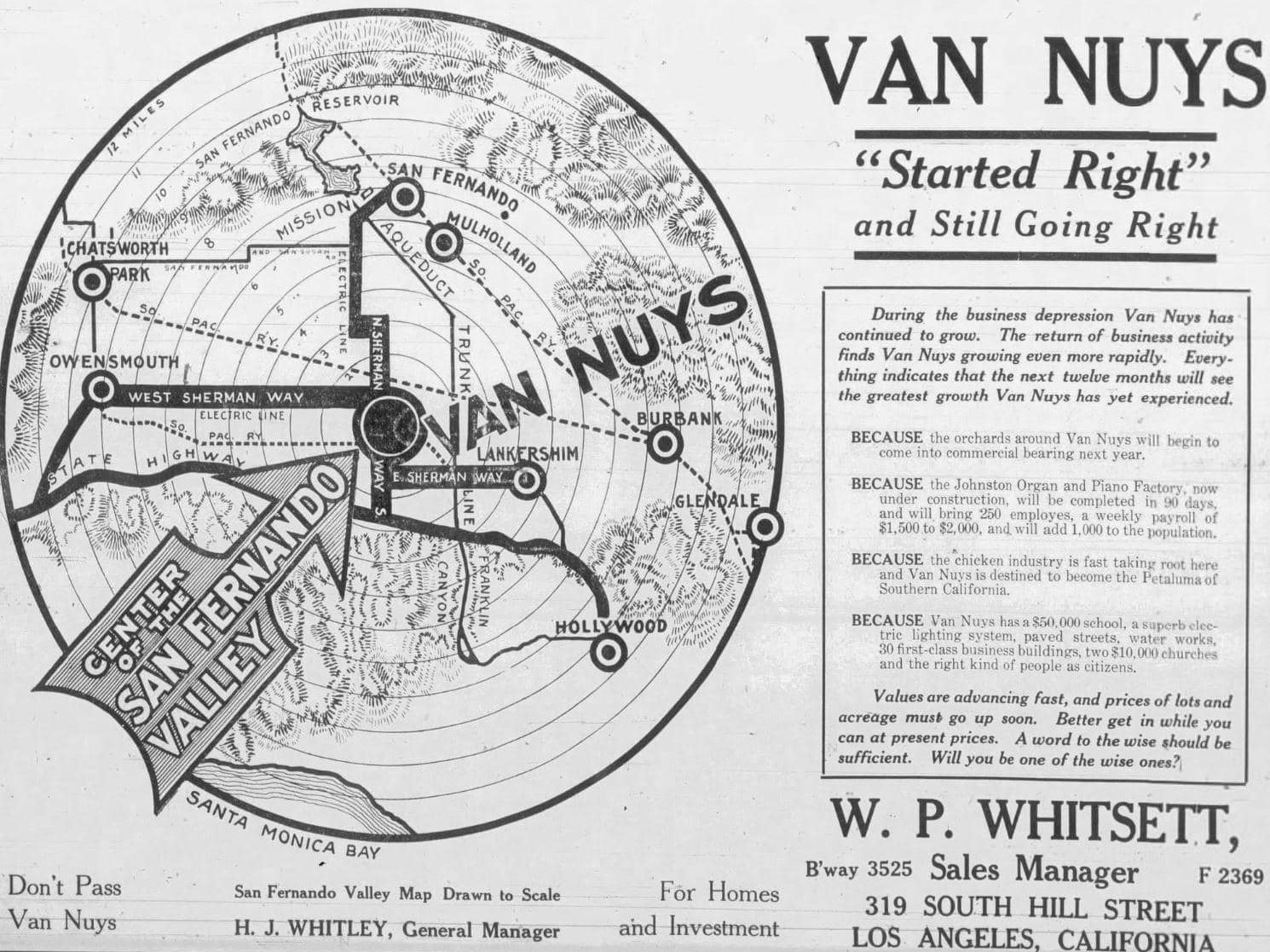 |
|
| (1913)* - Van Nuys 'Started Right' and Still Going Right". Courtesy of The Van Nuys News and Valley Green Sheet, Fri, Sep 05, 1913. |
 |
|
| (1914)#^*^ - View of Van Nuys, looking NE along North Sherman Way, later renamed Van Nuys Blvd. The tall three-story building in the distance is Van Nuys Grammar School (built in 1912). Signs on large building at center-right reads: Studebaker - GARAGE - GOODRICH TIRES |
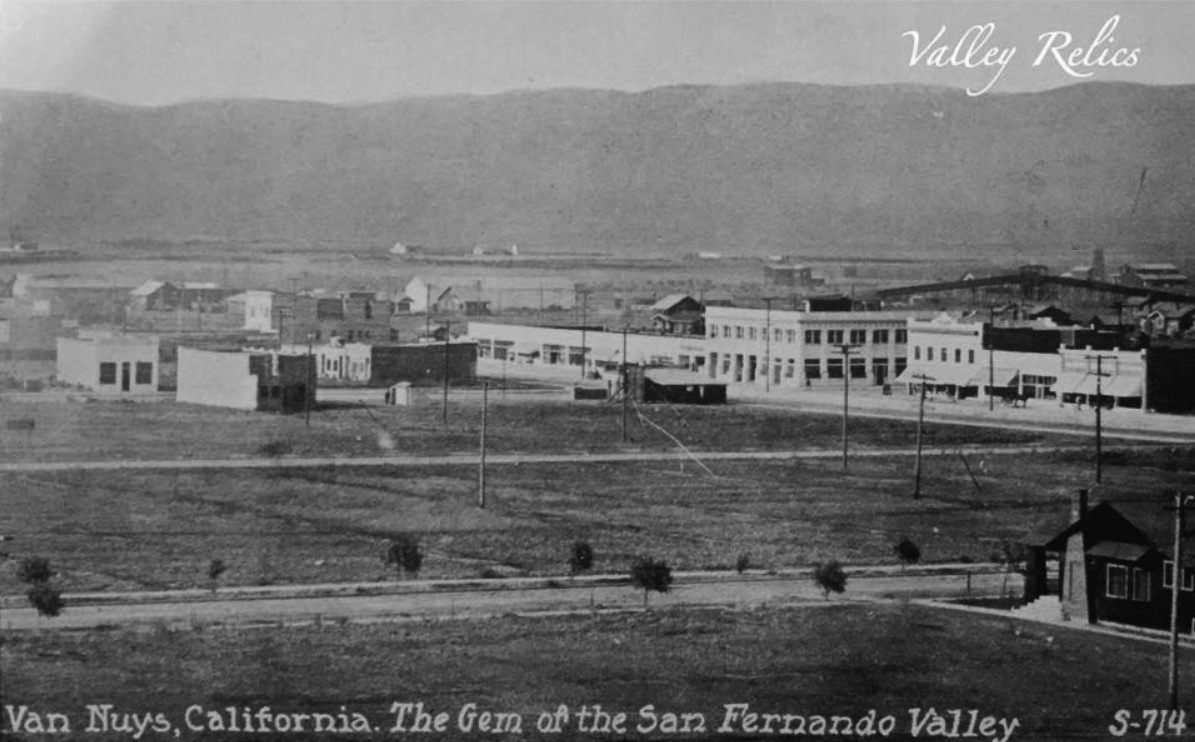 |
|
| (ca. 1912)* – View looking southwest showing the commercial center of Van Nuys, California. “The Gem of the San Fernando Valley” |
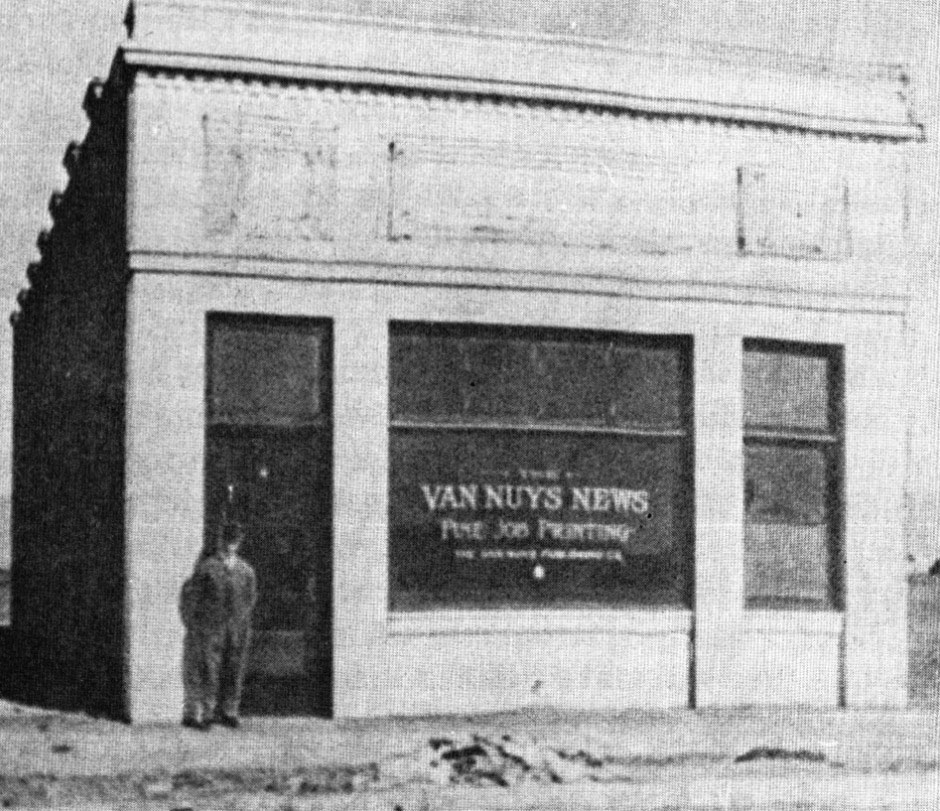 |
|
| (ca. 1911)* – View showing Frank M. Keffer standing in front of the Van Nuys News building located at 14441 Sylvan Street. |
Historical Notes The paper, founded by E.R. Elkins, debuted as The Van Nuys Call on Nov 3, 1911, just nine months following the birth of the town. Purchased by Frank Keefer, a reporter from Pittsburgh, it was published as The Van Nuys News on Nov 24, 1911. The first building was at 14441 Sylvan Street (seen above). It was published as a 4-6 page weekly for a number of years. Walter Mendenhall joined as co-publisher in 1920, and in June of 1922, the paper went semi-weekly. Keffer retired in 1932, and joining Mendenhall as co-owners were brothers Maurice W and Ralph J Markham. In September of 1936, the News moved into its new home at 14539 Sylvan Street. Wanting to reinforce its reputation as the Valley Paper, in the 1940’s it became the Van Nuys News and Valley Green Sheet, when the front page was printed on a pale-green broadsheet to distinguish it from its competitors, in the early 1950’s becoming the Valley News and Green Sheet, and expanded its reach, eventually into the Conejo, Simi and Santa Clarita Valleys. Frequency increased to tri-weekly in October, 1954, and then to four-times-a-week in 1959. New branch offices began to appear in North Hollywood, Canoga Park and Thousand Oaks. The Tribune Company, headquartered in Chicago, acquired the news in December of 1973. In 1976, it became a daily newspaper, and in 1981 changed its name to the Daily News. Subsequently, ownership of the newspaper has changed several times since. |
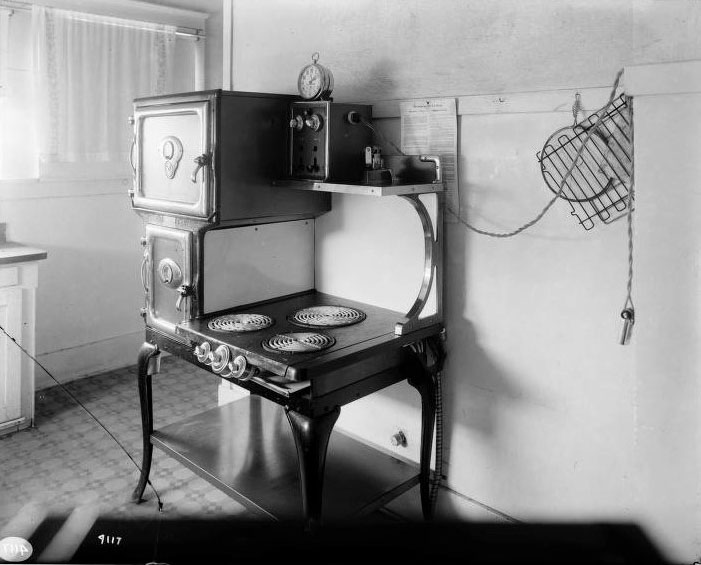 |
|
| (ca. 1917)*^^^ - Westinghouse Electric range (with iron in upper corner and an electric timing device) at a home in Van Nuys. |
Historical Notes In 1917, Westinghouse introduced its first all-electric kitchen range. It advertised its new ranges as follows: These are full size cooking ranges for domestic use, and have reached their high perfection in convenience and economy through many years of experimenting and experience. In addition to the cleanliness, safety, saving in food, and general desirability of cooking with electricity, they have the further advantage of saving a great deal of care, trouble and expense by the aid of the Westinghouse exclusive economical features of full automatic control by attached clock and thermostats. By 1917, most of the valley was already annexed into the City of Los Angeles. Not only was there enough water for the Valley, but there was also more than enough electricity to serve a growing city. Click HERE to see more in Electricity on the Aqueduct. |
Van Nuys High School
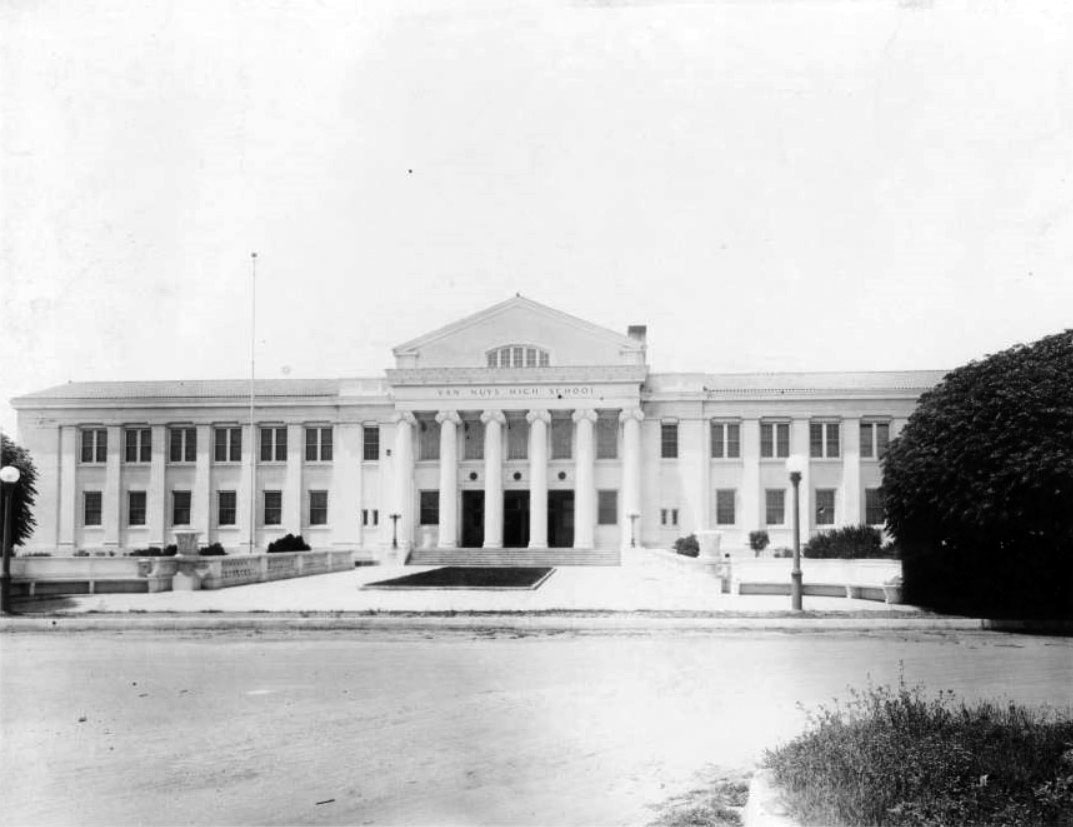 |
|
| (n.d.)^^ – Front view of Van Nuys High School showing the impressive Ionian columns framing the main entrance, located at 6535 Cedros Avenue at Haynes Street. |
Historical Notes Van Nuys High School opened in 1914, four years after Van Nuys was established. For years, the only high schools in the Valley were Van Nuys, Owensmouth (now Canoga Park), San Fernando, and North Hollywood. The football and track stadium, originally built at the same time as the current high school, is named for Bob Waterfield, and the baseball field for Don Drysdale, the two most famous athletes to have played for VNHS.*^ |
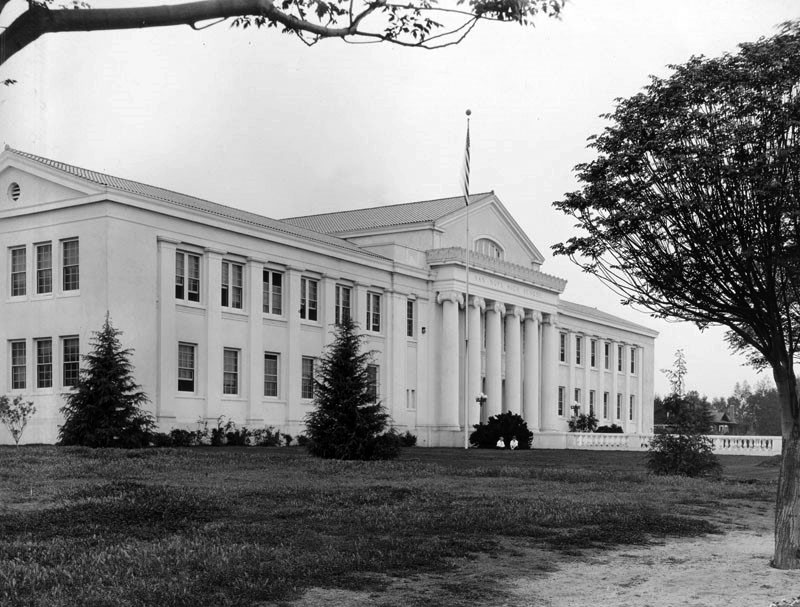 |
|
| (ca. 1923)#** – Early view of Van Nuys High School with its Classic Greek-style architecture. |
Historical Notes Marilyn Monroe attended Van Nuys High School. Click HERE to see more Notable Alumni. |
Van Nuys Hotel
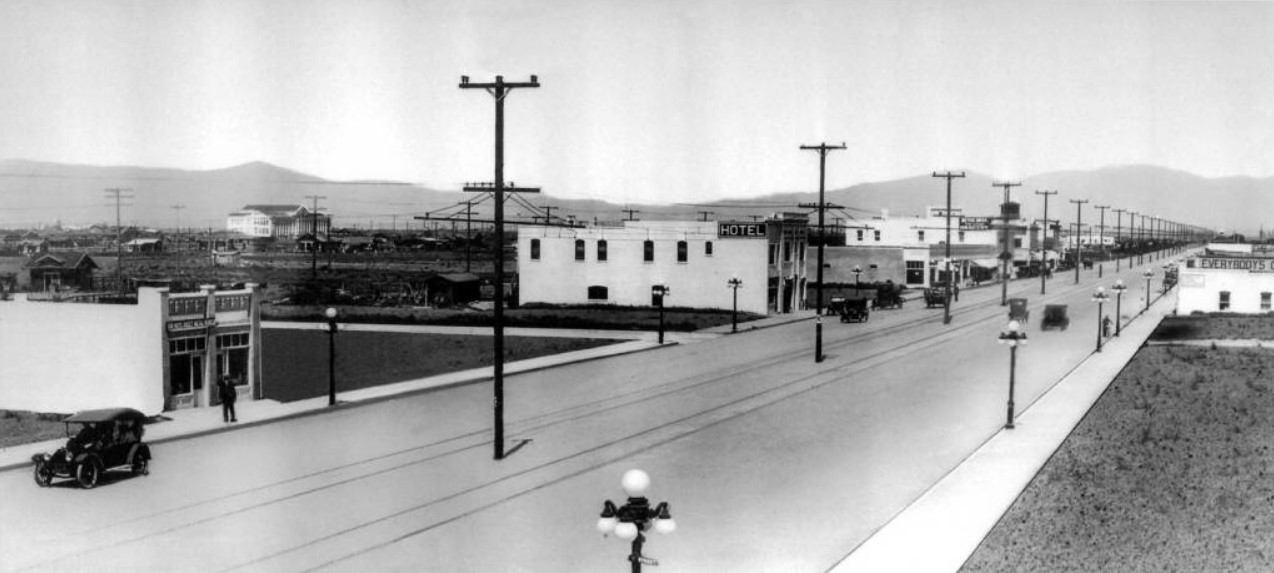 |
|
| (1913)^ – Panoramic view looking north showing early development along Sherman Way (later Van Nuys Boulevard). Two sets of tracks and an electrical pole line run down the center of the street. All of these buildings have been torn down and replaced except for the Van Nuys Hotel building (6211 Van Nuys Blvd), visible here with the "Hotel" sign on it. At left-center can be seen the newly constructed Van Nuys High School located at 6535 Cedros Avenue. Note the ornate 5-bulb streetlights along both sides of Van Nuys Boulevard. |
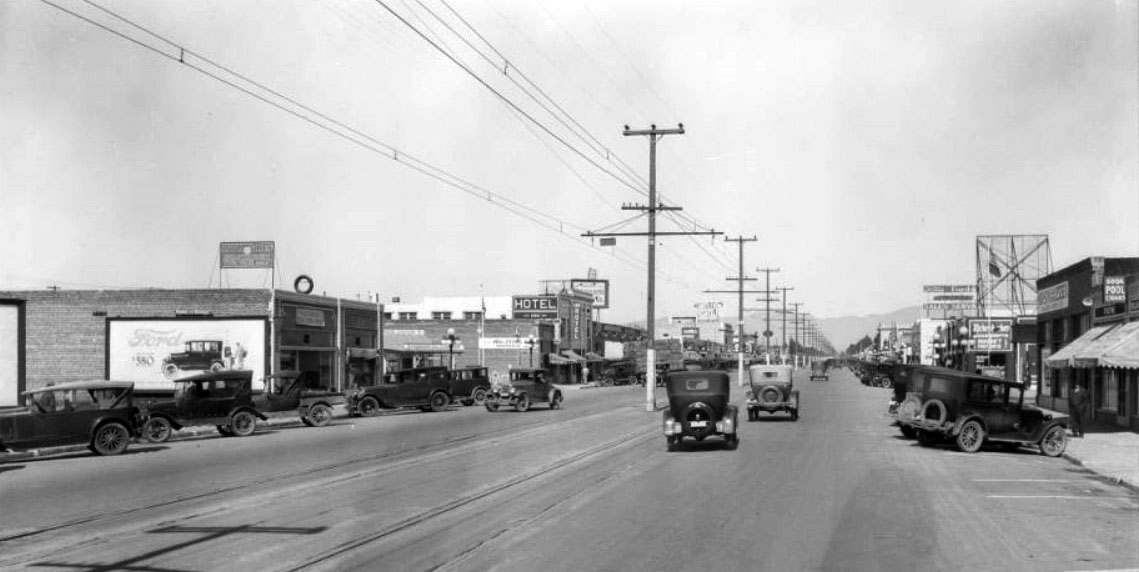 |
|
| (1926)^^ - Wide-angle view looking north on Van Nuys Boulevard showing the Van Nuys Hotel on the west side of the street (left-center). The hotel is located near the NW corner of Van Nuys Blvd. and Delano St. Note the power lines and streetcar tracks running down the center of the wide street. |
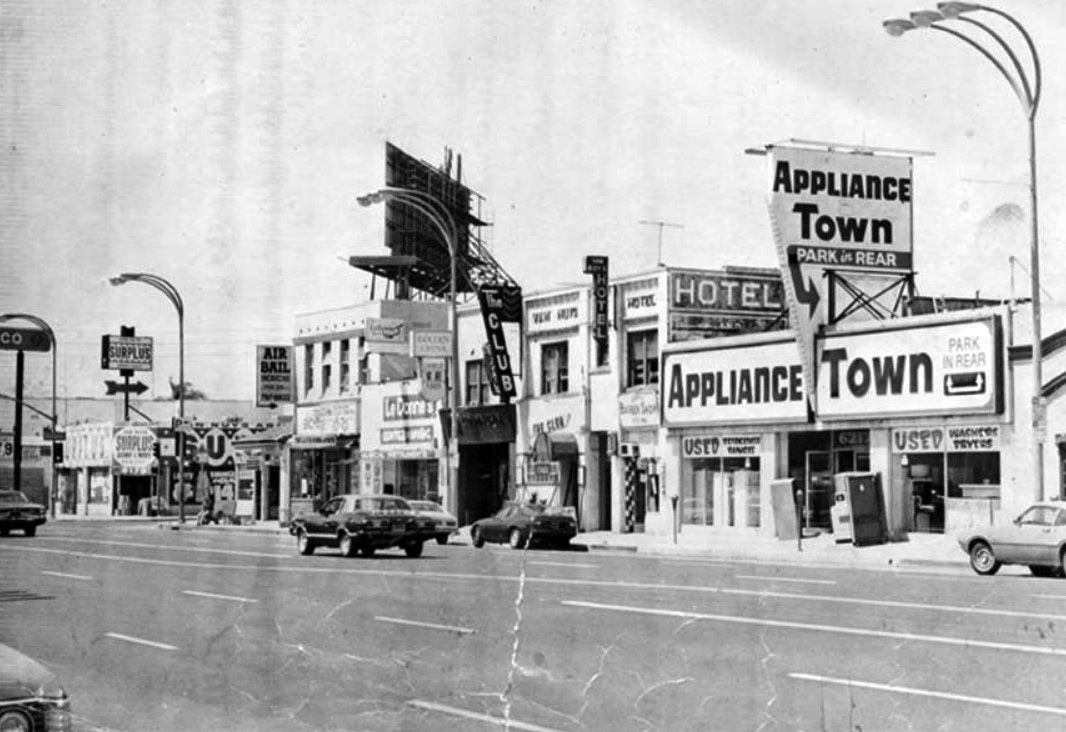 |
|
| (1970s)^ - View looking SW on Van Nuys Boulevard toward Delano Street. Visible at center is 6211 Van Nuys Boulevard, known at that time as the Van Nuys Hotel. It is believed to have had such boarders as silent film star William S. Hart. *Note the forked three-arm streetlights. At the time of their installation they were the brightest streetlights in Los Anglees. |
Historical Notes The forked three-arm streetlights seen above were chosen in the early 1970's by representatives of the Van Nuys business community to light Van Nuys Boulevard and Magnolia Boulevard. Originally, 1,000 watt mercury vapor lamps were used to provide on average five foot-candles. This turned out to be too bright and too costly from an energy level. Today, these three-pronged electroliers can still can be seen on and around Van Nuys Boulevard. However, the luminaires today are 250 watt high-pressure sodium. Click HERE to see more. |
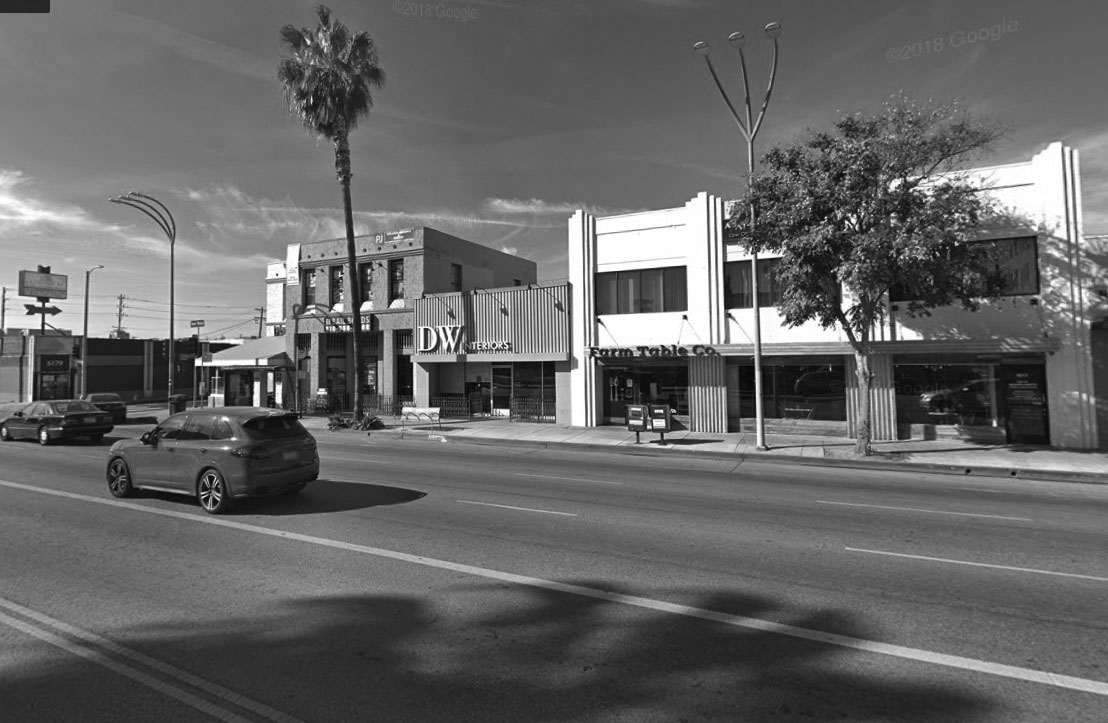 |
|
| (2018)^^ – View showing the old Van Nuys Hotel building at 6211 Van Nuys Boulevard. Expanded and modified, the building is now occuppied by Bail Bonds office and Mexican restaurant. Click HERE for a closer view. |
Then and Now
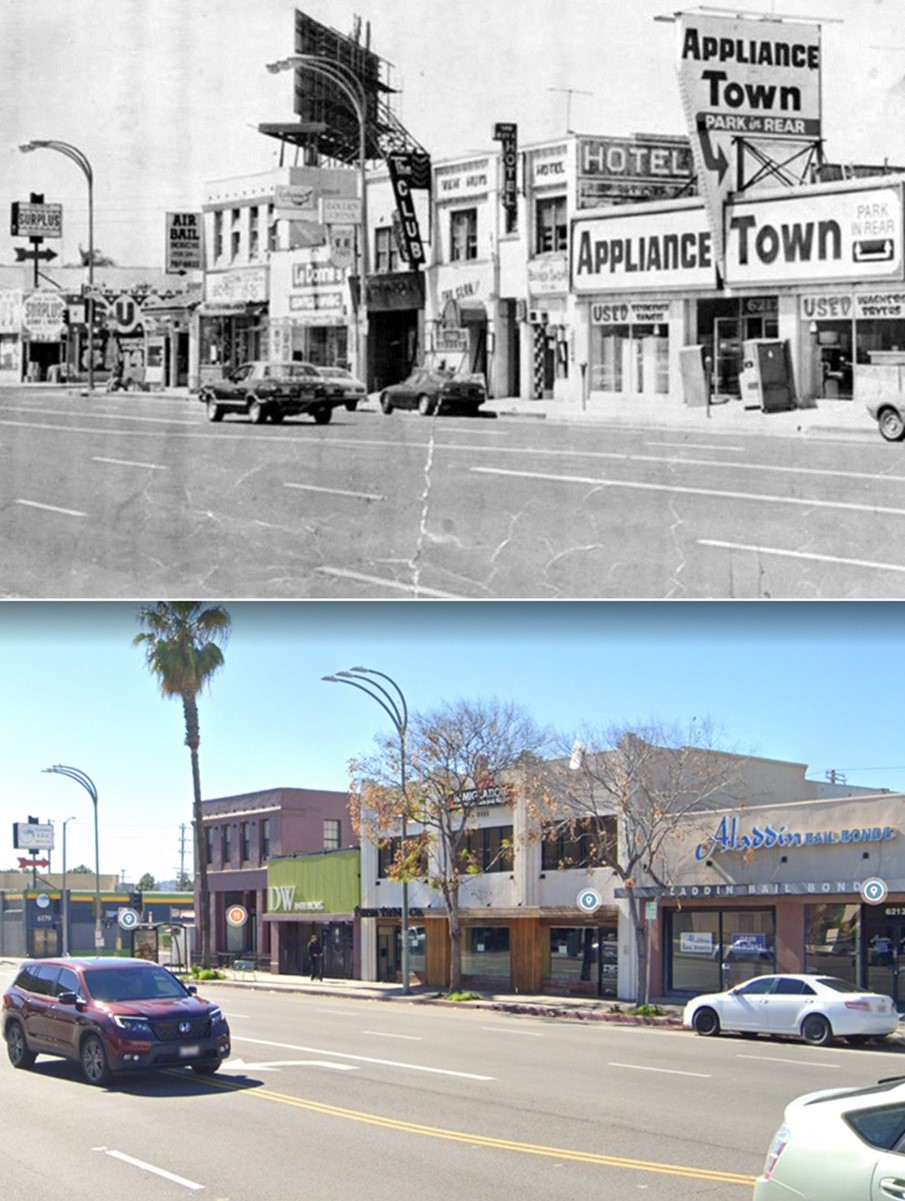 |
|
| (1970s vs. 2023)* - Looking SW on Van Nuys Boulevard toward Delano Street. |
* * * * * |
Early SFV Streetlights
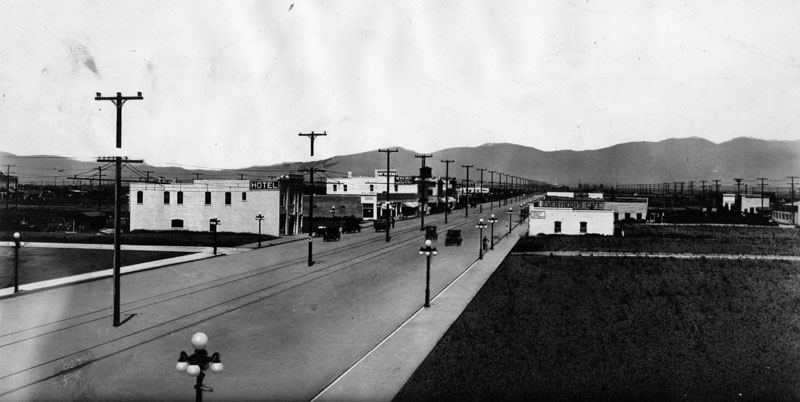 |
|
| (ca. 1912)* - Early view of Van Nuys Boulevard, looking north. Note the ornate 5-lamp light posts along the sidewalks. These lamps were also installed in front of most of the old mansions in Downtown LA. |
Historical Notes The Van Nuys Highway Lighting District was organized August 10, 1912, under the California act providing for the highway lighting of unincorporated towns and villages and country sections. The Van Nuys District, which is 16 miles long and 8 miles wide, embraces about 52,000 acres in the southwestern part of the San Fernando Valley (at the time). The votes creating the district came from the new settlers. Sixty votes were recorded for and eighteen against. The small vote was due to the fact that the majority of people living in the tract came from other states and were not eligible to vote on account of not having been in California the required year. The first lighting undertaken by the district was along Sherman Way, the 16 mile boulevard extending thru the tract. A sum of $75,000 was recommended for this purpose, which was included in the 1912 taxes of the district, and the entire amount was raised in that year.* |
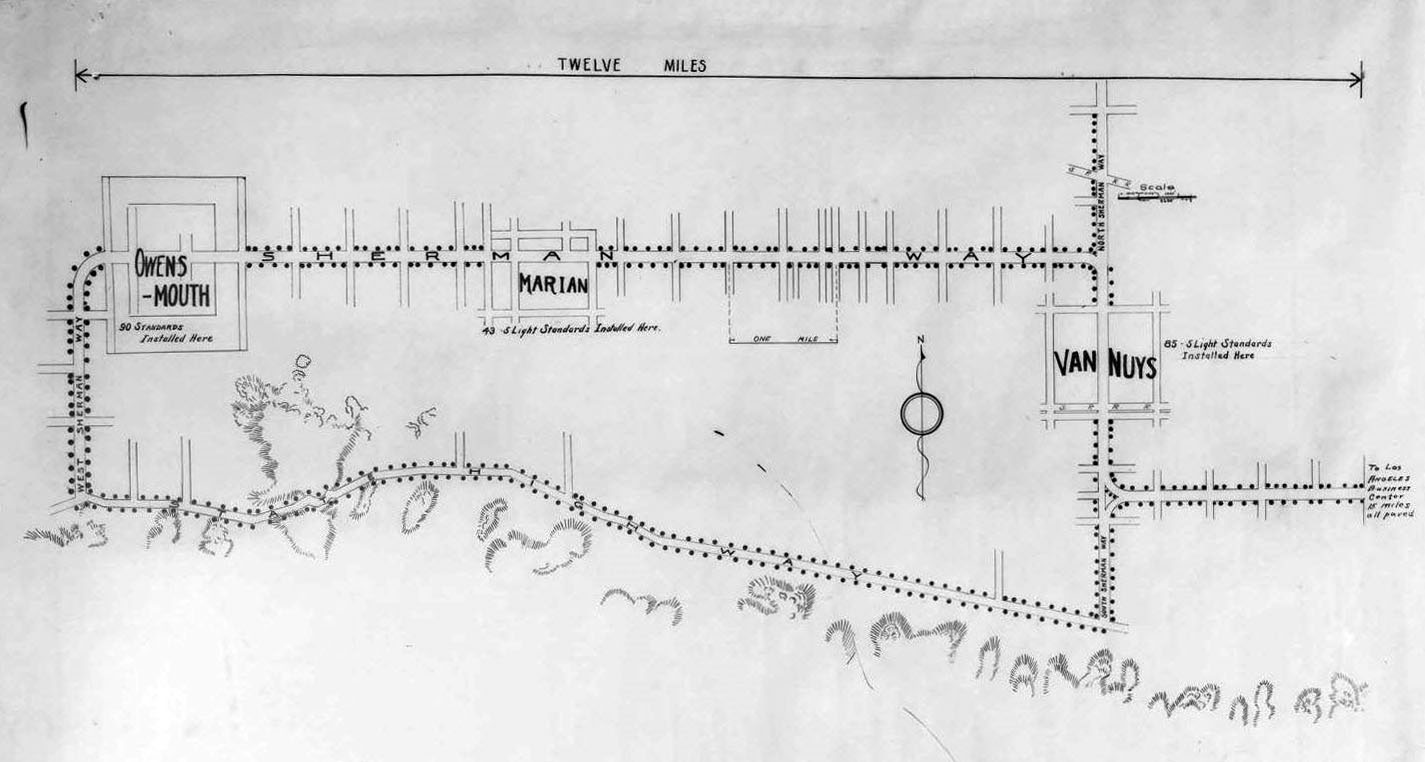 |
|
| (1913)^.^ - Map showing the proposed streetlights for the Van Nuys/Marian/Owensmouth Lighting District. Photo courtesy of Dean Fields. |
Historical Notes This was the first Lighting District the County of Los Angeles created. When completed the lighting system had 484 three-light posts (electroliers) and 129 five-light posts (electroliers). Streetlight "Electroliers" are defined as free-standing streetlights generally on their own posts. The above map shows the original route of Sherman Way, which today is west on Chandler, north on Van Nuys Blvd, and west on Sherman Way. The other sections of today's Van Nuys Blvd were known as South Sherman Way and North Sherman Way. |
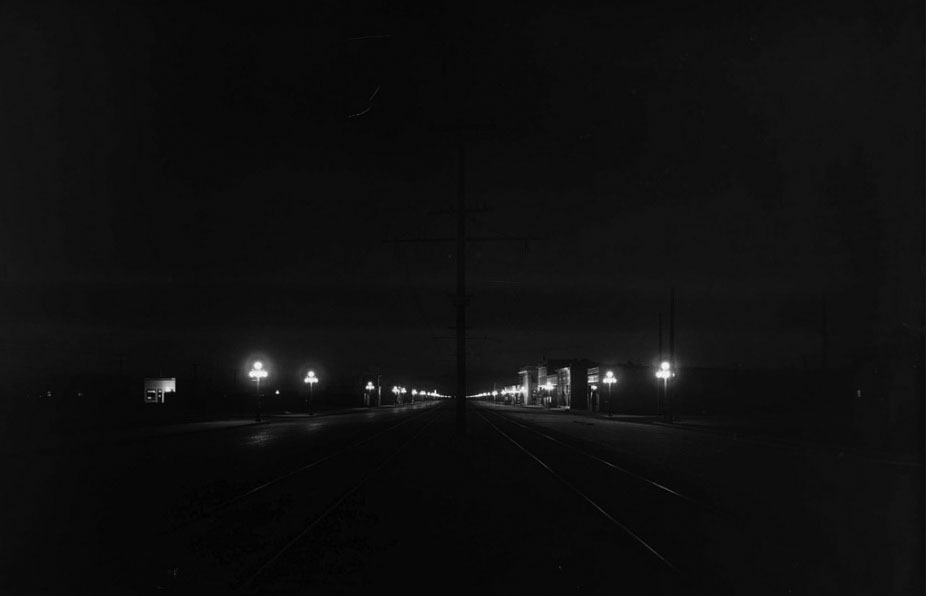 |
|
| (1913)*** – Night view looking south on Sherman Way (later Van Nuys Boulevard). Two rows of 5-lamp electroliers illuminate the area showing two sets of tracks and an electrical pole line running down the commercial center of town. |
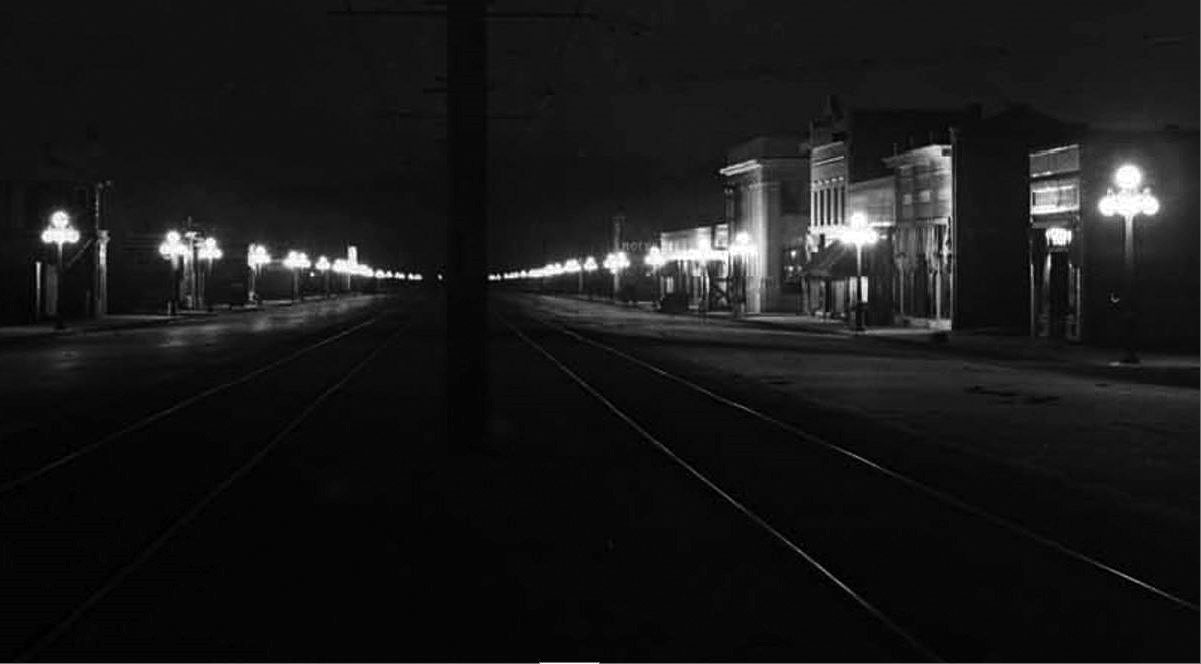 |
|
| (1913)*** – Closer view of Sherman Way (later Van Nuys Boulevard) showing the multitude of 5-lamp streetlights lining both sides of the street. Also seen are streetcar tracks and and an electrical pole line running down the center of the Boulevard. This is a blow-up of the previous photo. |
.jpg) |
|
| (1913)*** – Close-up detailed view showing a five light ornamental lamp. Street sign on lamp post reads: SHERMAN WAY. Sign on left reads: “Electroliers Wired & Installed by Llewellyn Iron Works”. Sign at right reads: “Private Road – Exclusively for Autos”. |
Historical Notes In the three townsites of Van Nuys, Marian, and Owensmouth, five-light clusters were used thru the main parts, four electroliers to every street intersection. On these five-light posts, one 60-watt lamp was upright and four 40-watt lamps pendant, and they were placed through the main parts of the towns, four electroliers to every street intersection.* The most common of the incandescent multiple globe electroliers of the early 1900s were those manufactured by the Llewellyn Iron Works of Los Angeles. The firm became so identified with this style of street light that any multiple globe electrolier became commonly known as a Llewellyn. The Llewellyn Iron Works, founded in 1889‐1890, was one of the largest metal working facilities in Los Angeles. It manufactured structural steel – including that for the Bradbury Building.^ |
 |
|
| (ca. 1913)^.^ – View looking down on an unpaved Sherman Way showing an ornate Llewellyn Iron Works 3-lamp electrolier. |
Historical Notes Cast-iron electroliers (made by Llewellyn Iron Works of Los Angeles) were used with three-light clusters for use along the boulevard outside the townsites, one 60-watt lamp upright and two 40-watt lamps pendant. The electroliers were located 330 feet apart staggered, or 660 feet apart on each side of the boulevard, which is about 100 feet wide.* These ornate streetlights (both 3-globe and 5-globe) still exist today. They can be found on Carroll Avenue in Angelino Heights (near Echo Park). |
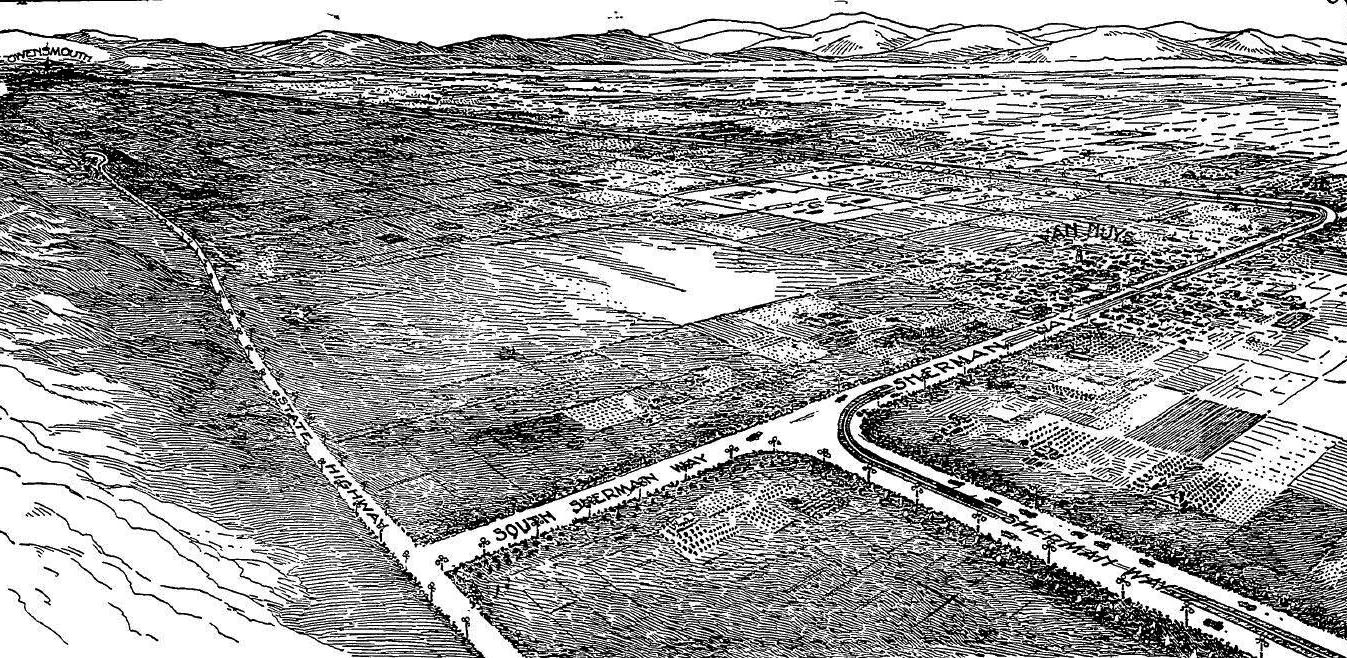 |
|
| (1914)* – Sketch from LA Times article announcing the celebration when all of the new streetlights were turned on along Sherman Way in June 1914. It shows the original route of Sherman Way, which today is west on Chandler, north on Van Nuys Blvd, and west on Sherman Way. The other sections of today's Van Nuys Blvd were known as South Sherman Way and North Sherman Way. |
Historical Notes The LA Times article was titled: League of Brilliant Lights in Unique and Rosy Outdoor Spectacles, reads: “Blaze of Light to Stretch for Miles. City, State and County Officials, With Thousands of Other Visitors, to Aid in Celebrating Completion of Magnificent Boulevard System in the San Fernando Valley… “. Click HERE to see article. |
* * * * * |
Sherman Way (Owensmouth Road Race)
 |
|
| (1913)* - Two cars racing, partly obscured by clouds of dust, with aviator Glenn Martin piloting biplane above serving as race referee. This photograph appears on page 415 of Popular Electricity magazine, Vol. VI, no. 1, May, 1913; the Owensmouth Road Race is covered in the Los Angeles Times, March, 1913. |
Historical Notes The Owensmouth Road Race in 1913 featured a unique promotional element: an airplane. Aviator Glenn Martin piloted a biplane and served as the race referee, a detail confirmed by a 1913 publication stating, "Martin referees car race in air." The scene, with two cars racing through clouds of dust and Martin flying above, epitomized the race's promotional activities. This use of an airplane to oversee and promote the race was part of a broader spectacle designed to showcase the modernity and infrastructure of the newly established town of Owensmouth. Held on March 27, 1913, the race was a significant event in the early history of Owensmouth, now known as Canoga Park. It was part of efforts to promote the town, founded on March 30, 1912, and featured prominent auto racing pioneer Barney Oldfield, receiving extensive coverage from the Los Angeles Times. Owensmouth was created during a period of rapid development in the San Fernando Valley, spurred by improved transportation options like electric railways and automobiles, and the anticipation of water from the Owens Valley. Initially part of a large tract of land owned by Isaac N. Van Nuys, it was sold to the Los Angeles Suburban Homes Company in 1909. This syndicate included influential figures such as Harry Chandler and Harrison Gray Otis of the Los Angeles Times, and developer Hobart Whitley. The Owensmouth Road Race was among many promotional activities organized to attract attention and settlers to the area. The event included a free barbecue, an air show, and live music, culminating in a race between a biplane and a Fiat sports car. These efforts were part of a broader strategy to transform the San Fernando Valley from agricultural land into a suburban area. |
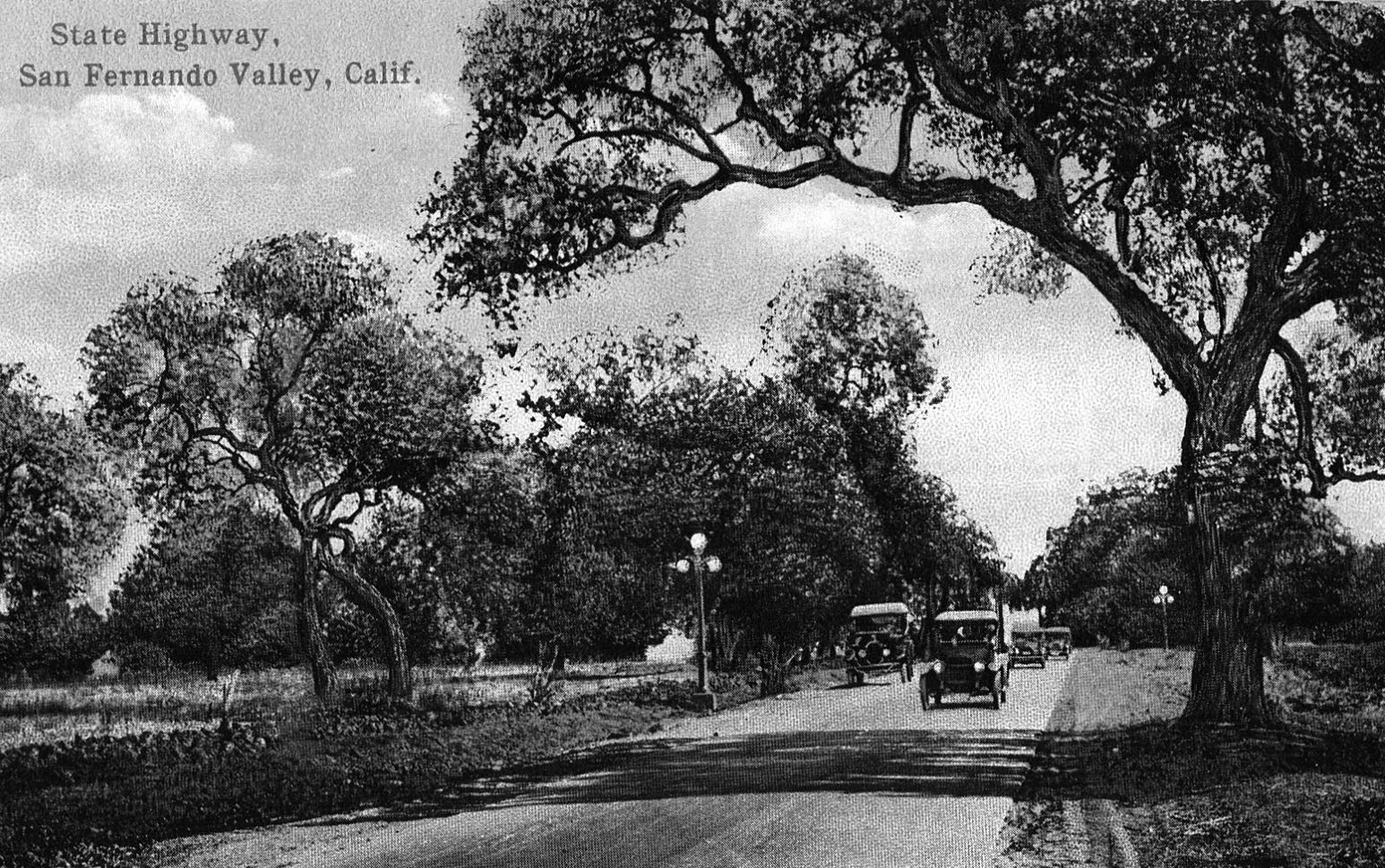 |
|
| (1913)* – Postcard view looking east showing early model cars and ornate streetlights on Sherman Way, one of the earliest paved roads in the San Fernando Valley. |
Historical Notes Sherman Way became the first paved boulevard across the valley. Following this was the paving of the state highway aka the Ventura Road, from the Cahuenga Pass to Newbury Park. Eventually, the road ran all the way to Ventura, and was renamed Ventura Boulevard. |
 |
|
| (1913)* – View looking east on Sherman Way showing the General Moses Sherman-built PE tracks at right. Ornamental lighting posts can be seen on the left. |
* * * * * |
.jpg) |
|
| (1919)* – Map showing the San Fernando Valley routing of Pacific Electric streetcars (yellow) and Southern Pacific trains (red) in 1919. Image courtesy of Barry Lawrence Ruderman Antique Maps (RareMaps.com) |
Historical Notes General Moses Sherman directed the Los Angeles Pacific Railroad electric railway line's construction. It ran from Lankershim to the three new towns the syndicate's partner Hobart Johnstone Whitley had planned for the valley, Van Nuys, Marian (present day Reseda), and Owensmouth (present day Canoga Park and West Hills). The tracks ran in the middle of Sherman Way, a broad new 'lavishly landscaped' and paved avenue to the Owensmouth terminus. |
Marian Pacific Electric Station (later Reseda)
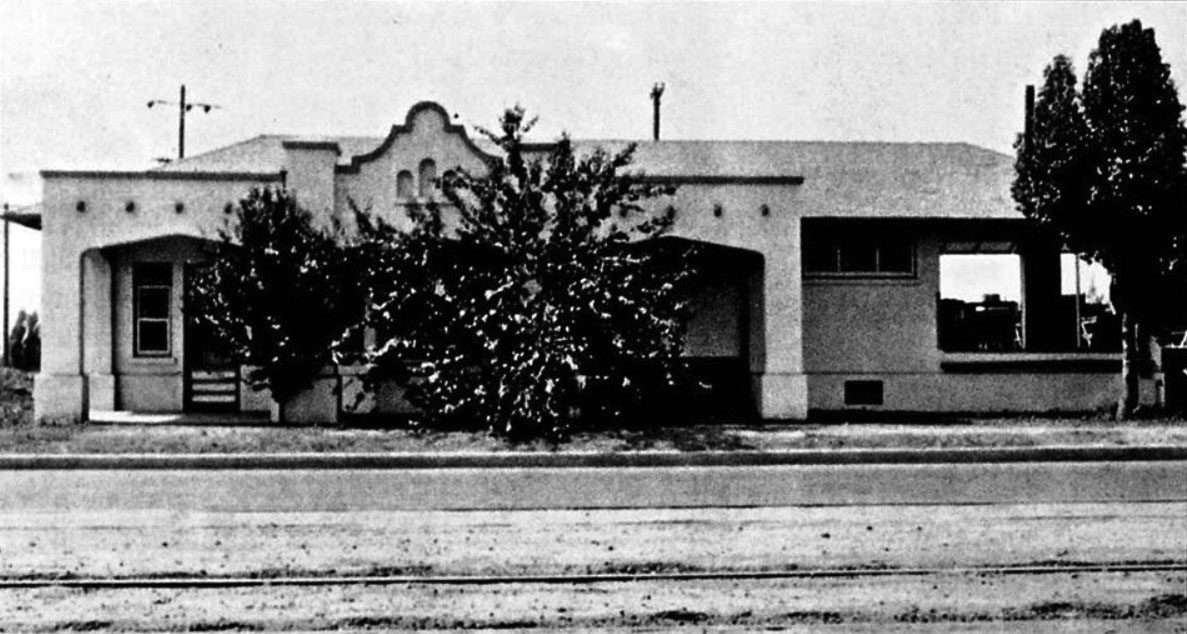 |
|
| (1920s)#^*^ - View of the Pacific Electric Station near Reseda and Sherman Way. It later became the Reseda Women's Club meeting room. |
Historical Notes Reseda originated as a farm town named "Marian" (or "Rancho Marian") that appeared in 1912. Its namesake, Marian Otis Chandler, was the daughter of Los Angeles Times publisher Harrison Gray Otis, a director of the Los Angeles Suburban Homes Company. H J Whitley was the manager of the Los Angeles Suburban Home Company.*^ |
Owensmouth Pacific Electric Station (later Canoga Park)
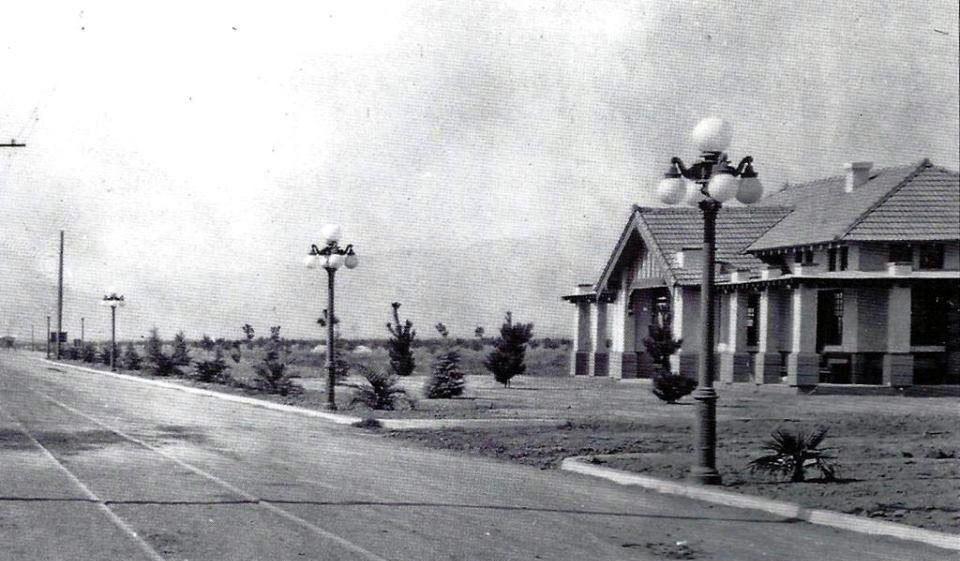 |
|
| (ca. 1913)^ - View showing the Owensmouth PE station looking west along Sherman Way. Park Ave [now Vassar Ave] enters at right; behind the Simi Hills can be dimly seen. Note the five-lamp ornamental streetlights along Sherman Way. |
Historical Notes Sherman Way became the first paved boulevard across the valley. Following this was the paving of the state highway aka the Ventura Road, from the Cahuenga Pass to Newbury Park. Eventually, the road ran all the way to Ventura, and was renamed Ventura Boulevard. |
Then and Now
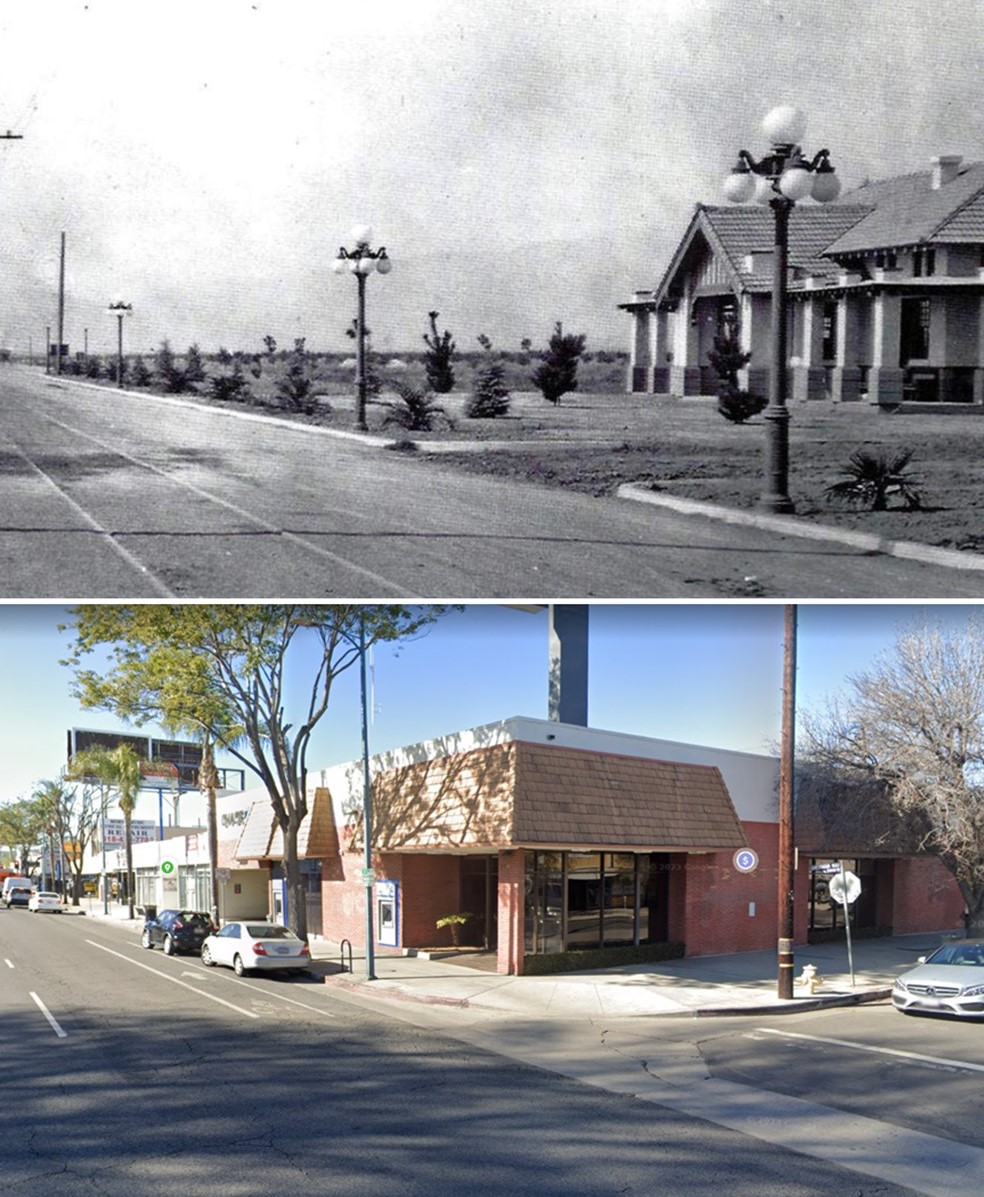 |
|
| (1913 vs 2023)* - Looking west on Sherman Way at Vassar Ave. |
Owensmouth (later Canoga Park)
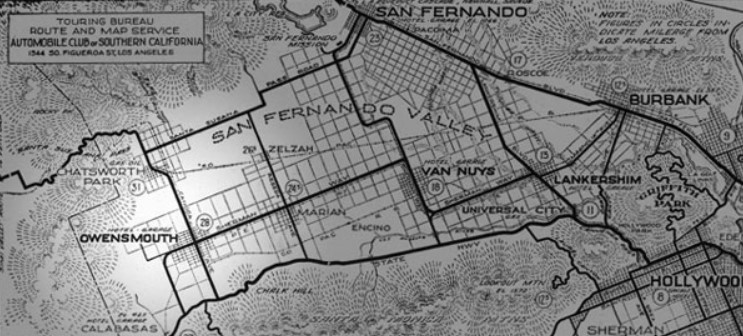 |
|
| (1917)**^^ - Before there was Canoga Park, there was Owensmouth, born on the barley fields of the San Fermando Valley on March 30, 1912. Detail of a 1917 strip map courtesy of the Automobile Club of Southern California. |
Historical Notes Founded on March 30, 1912, the settlement -- renamed Canoga Park in 1931 -- represented one of L.A.'s first steps in a march that eventually transformed the San Fernando Valley from farmland into suburbia. Owensmouth was at the vanguard of a land boom in the San Fernando Valley. For decades, two factors prevented development in the Valley: its remote location, separated by the Santa Monica Mountains from the population and business center of Los Angeles; and the opposition of a few large landholders, who preferred to maintain the valley for agricultural use. By the end of the twentieth century's first decade, however, electric railways and the growing popularity of automobiles shrunk the distance between the city and the Valley. Also, One landowner, Isaac N. Van Nuys, was willing to sell. The aging farmer, banker, and land baron controlled the Los Angeles Farming and Milling Company, which owned a vast tract totaling 47,500 acres and constituting much of the southern half of the San Fernando Valley.**^^ |
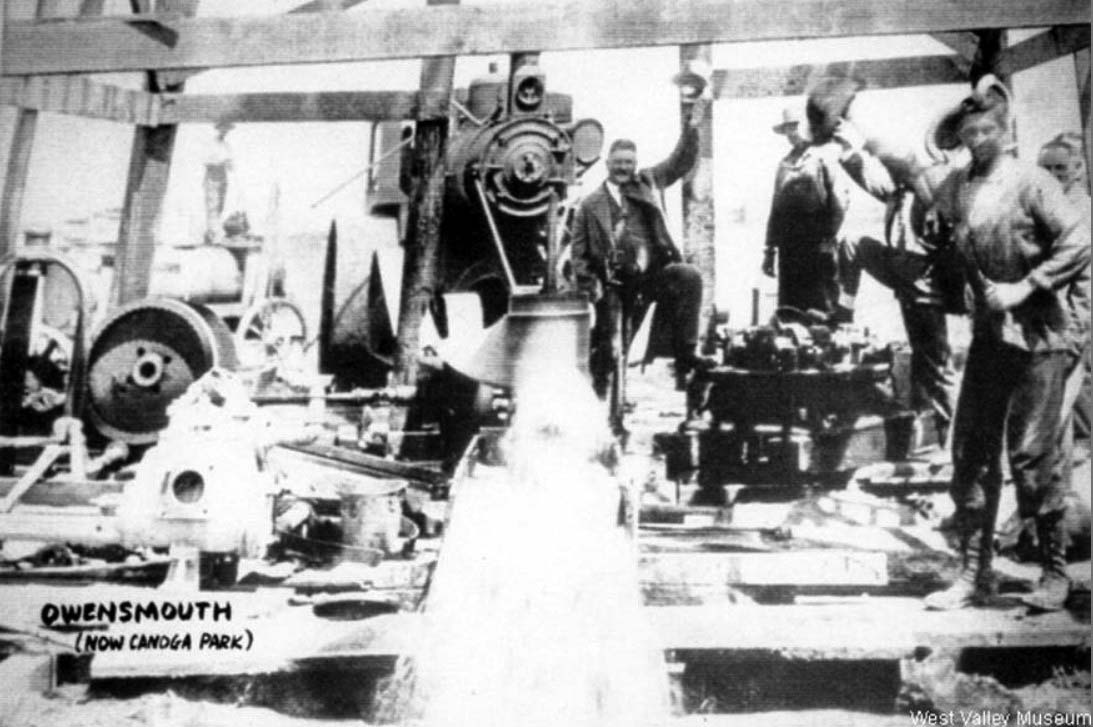 |
|
| (ca. 1910s)^- Water well in Owensmouth installed by the town’s developers near today's intersection of Sherman Way and Deering Avenue. |
Historical Notes In April 1910, a rig was set up to drill Well No. 3 near Canoga Station (south of Sherman and east of Deering), and In October, a pump was installed and a fifty-horsepower gas engine to run it. The well was delivering water by March of 1911. #^*^ |
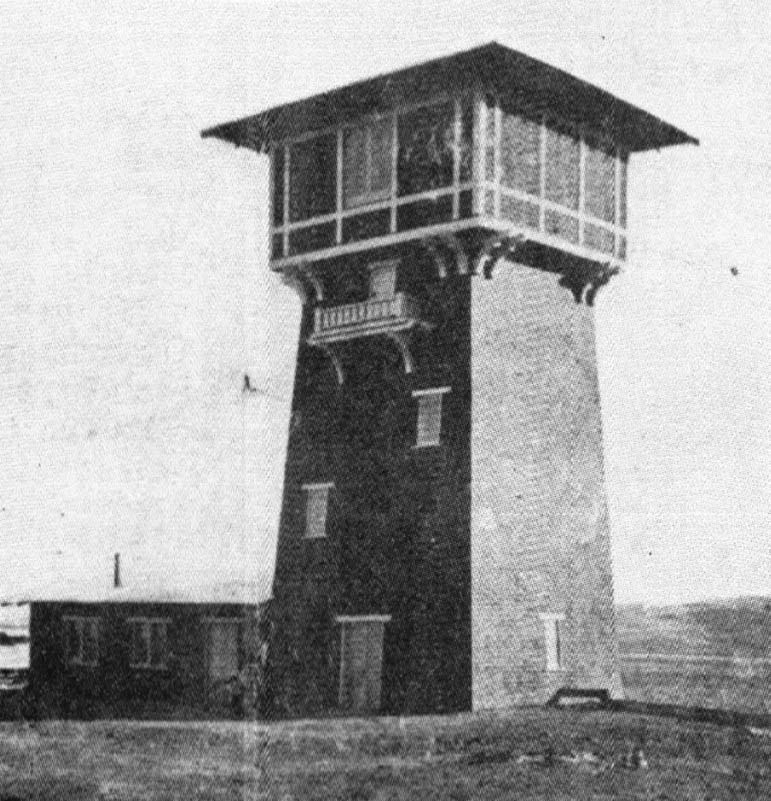 |
|
| (1911)#^*^ – View showing the Owensmouth pump house and water tower located south of Sherman Way and east of Deering Ave. This was Owensmouth's water supply until water came in from the LA Aqueduct in 1917. |
Historical Notes Prior to the opening of the aqueduct, the valley had few sources for water. One source was this well on the south side Sherman Way and east of Deering, providing the early water needs for the town of Owensmouth. The well had a pumping capacity of 20,000 gallons. Whitley and Otis had declared the well sufficient to supply the needs of a population of 10,000, a claim which, fortunately, never had to be put to the test. #^*^ |
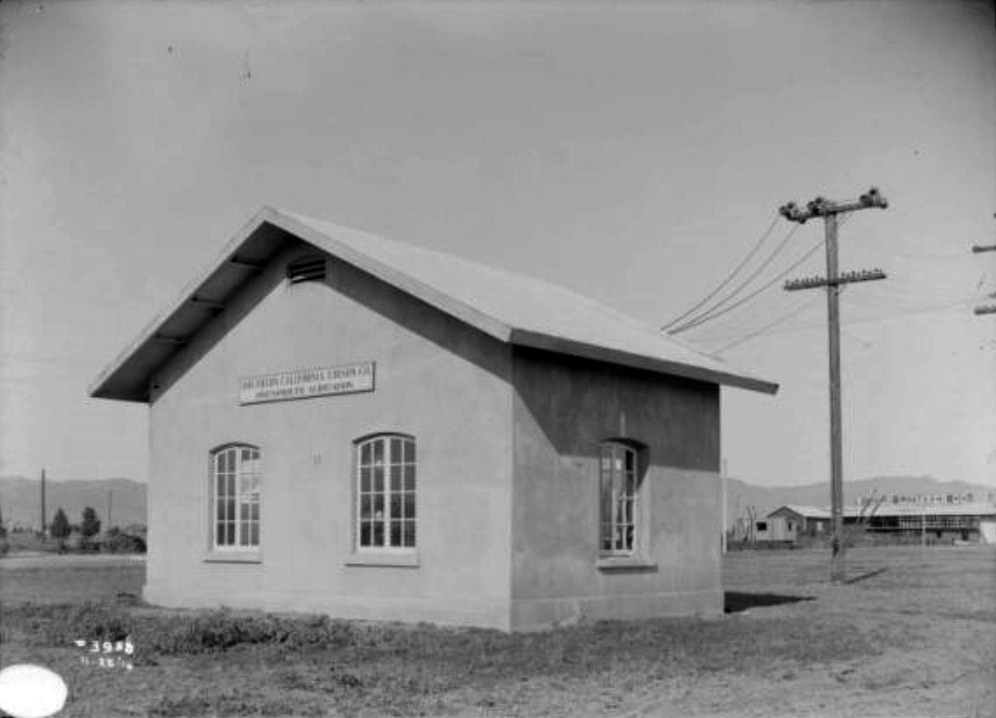 |
|
| (1916)#* – View looking southwest showing Southern California Edison’s Owensmouth Substation located on Sherman Way and Market Street (later Deering Ave). In the background, on the right, is Woods Lumber Co. (opened in 1912), located near Sherman Way and Owensmouth. By January it became the Owensmouth Feed and Fuel Company, shipping valley beans across the country. |
Historical Notes Southern California Edison (SCE) provided electric power to the area in the early part of the century. Even though Owensmouth was annexed by the City of Los Angeles in 1917, it would take another 20 years for the Bureau of Power and Light (later DWP) to completely take over all of SCE’s facilities. Click HERE to see more in First Electricity in Los Angeles. |
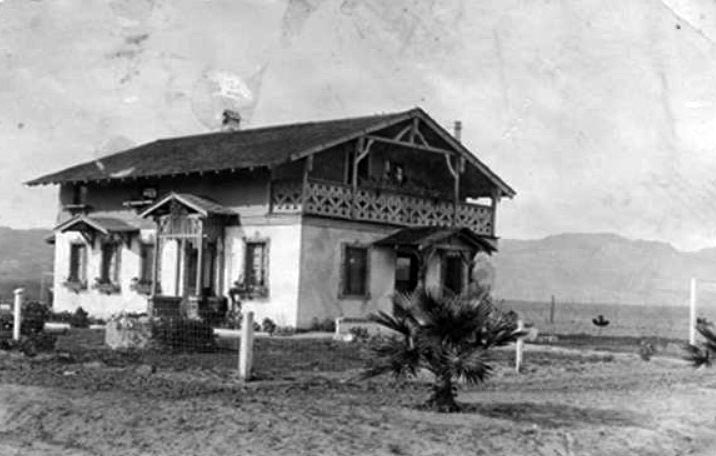 |
|
| (1912)^ - The Knapp home at Owensmouth Avenue and Cohasset Street in Canoga Park. View looking northwest. It was one of the first houses in the area. Knapp Park and Knapp Street is named for these same Knapps. The men of the Knapp family were stone builders and did much of the stone work at Orcutt Ranch. |
Historical Notes The Knapp house, razed in 1926, was located on the NW corner of Owensmouth Avenue and Cohasset Street. Today there are only palms trees on the lot where the house once stood. Click HERE for contemporary view. Owensmouth Avenue was named after 'Owensmouth', designed to evoke an image of being at the mouth of the distant Owens River and was the original name of the settlement that grew into the town of Canoga Park.^* Click HERE to see more SFV Street Name Origins. |
 |
|
| (1912)#* – Suburban Homes Company map of the Van Nuys–Lankershim Lands covering the area from the Town of Owensmouth (now Canoga Park) through the Town of Marian (now Reseda) to Van Nuys, with the Santa Monica Mountains to the south. Ventura Freeway now follows the Southern Pacific right of way. "Not a part of this Subdivision" is today's Sepulveda Basin. Properties with circled numbers had been sold. |
Historical Notes In 1909, Isaac Van Nuys sold his farmland for $2.5 million to a syndicate named the Los Angeles Suburban Homes Company. The syndicate's Board of Control comprised Los Angeles' leading movers-and-shakers: Title Insurance and Trust Company head Otto F. Brant; Los Angeles Times business manager Harry Chandler, a friend of Van Nuys'; Times owner Harrison Gray Otis, Chandler's father-in-law; transit magnate Moses H. Sherman; and developer Hobart Whitley, hailed today as the "father of Hollywood." Thirty participants drawn from L.A.'s business elite joined the board members as investors.**^^ |
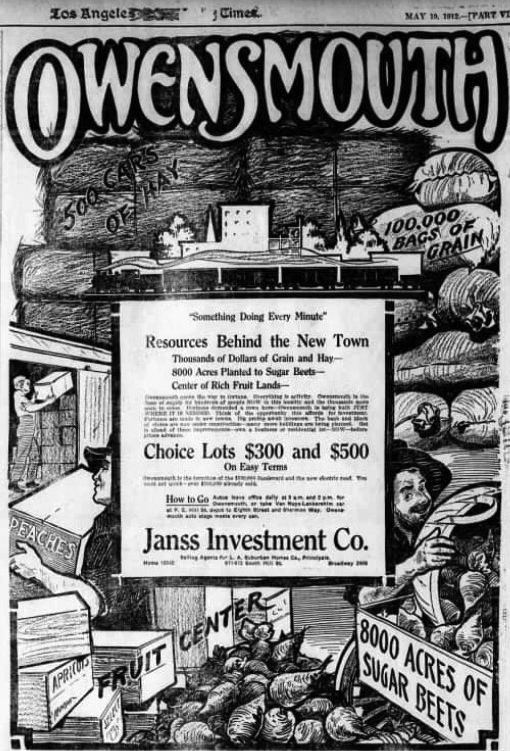 |
|
| (1912)^.^ - LA Times ad for Owensmouth put out by the Janss Investment Company. Janss would go on to develop Westwood and Westwood Village in the 1920s. |
Historical Notes The Janss Investment Company, which the syndicate hired to subdivide Owensmouth, platted the town around the junction of the Southern Pacific tracks and Sherman Way. Throughout 1911, as construction on Sherman Way raced westward from Van Nuys, workers rushed to provide the planned town with its basic needs: a water tower capable of supporting a population of 10,000, according to the syndicate's claims; a passenger depot along the Southern Pacific line; and a mission-style building where Janss could sell lots.**^^ |
Syndicate Block (aka Arcade Block)
 |
(ca. 1912)#^ -
View of the Syndicate Block in Owensmouth. Later known as the Arcade Block, it stood on the south side of Sherman Way between Alabama and Remmet avenues. |
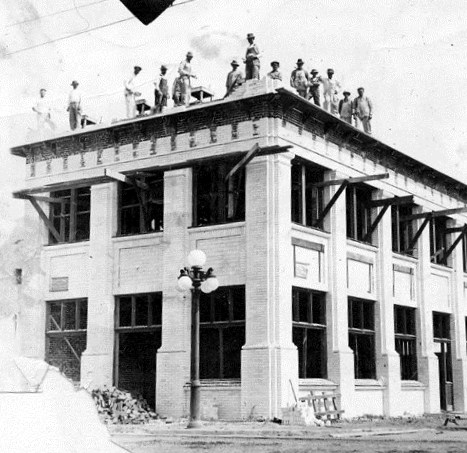 |
|
| (1912)^ - Construction on the first of the buildings that made up Syndicate Block, at the corner of Remmet Avenue and Sherman Way. It was later called Arcade Block. |
Historical Notes This building is part of the Syndicate Block, which was built by prominent investors in the San Fernando Valley. It was the first commercial building constructed after the Owensmouth Station was built. Tracks ran down the center of Sherman Way.#^ |
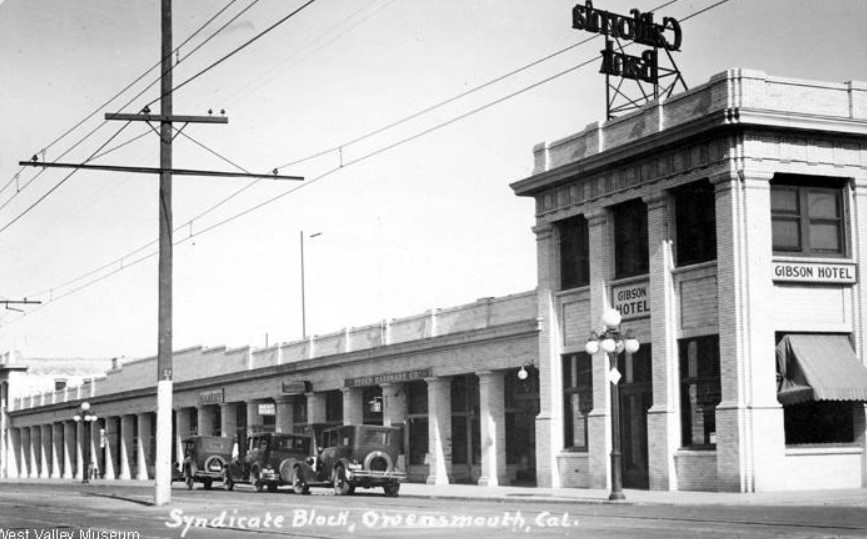 |
|
| (1920)#^ - View of Sherman Way looking east at Remmet Avenue. The full length of the Syndicate Block can be seen. Click HERE to see more views of the Syndicate Block (later Arcade Block - 1940s +) |
Historical Notes Signs on the commercial building include: Gibson Hotel, Hyden Hardware Co., and California Bank. Owensmouth struggled through its first few years. Electricity did not arrive until 1913; natural gas came years later. By 1916, only 200 residents called the four-year-old town home, and residents and farmers could not enjoy the water to which their town's name referred; only after Los Angeles annexed Owensmouth in 1917 did aqueduct water flow into town and into the surrounding orchards and citrus groves.**^^ |
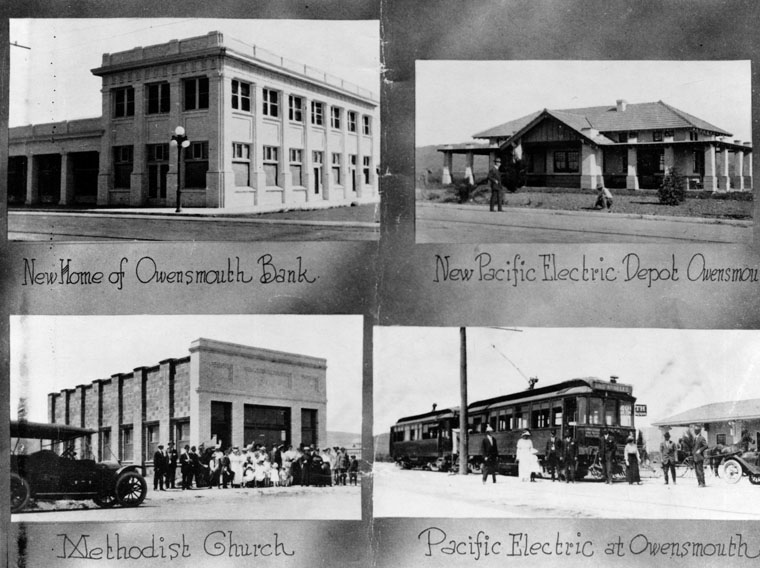 |
|
| (1914)* - Four buildings in Canoga Park (formerly called Owensmouth): Owensmouth Bank, Pacific Electric depot Owensmouth, Methodist Church, and, Pacific Electric at Owensmouth, 1914. |
Historical Notes When the Southern Pacific built a branch line through the area, it designated the spot Canoga, after the town of Canoga, New York, which in turn took its name from the Indian village of Ganogeh ("place of floating oil"). In 1931, Owensmouth became Canoga Park. (The Post Office insisted on adding "Park" to avoid confusion with Canoga, New York.)**^^ |
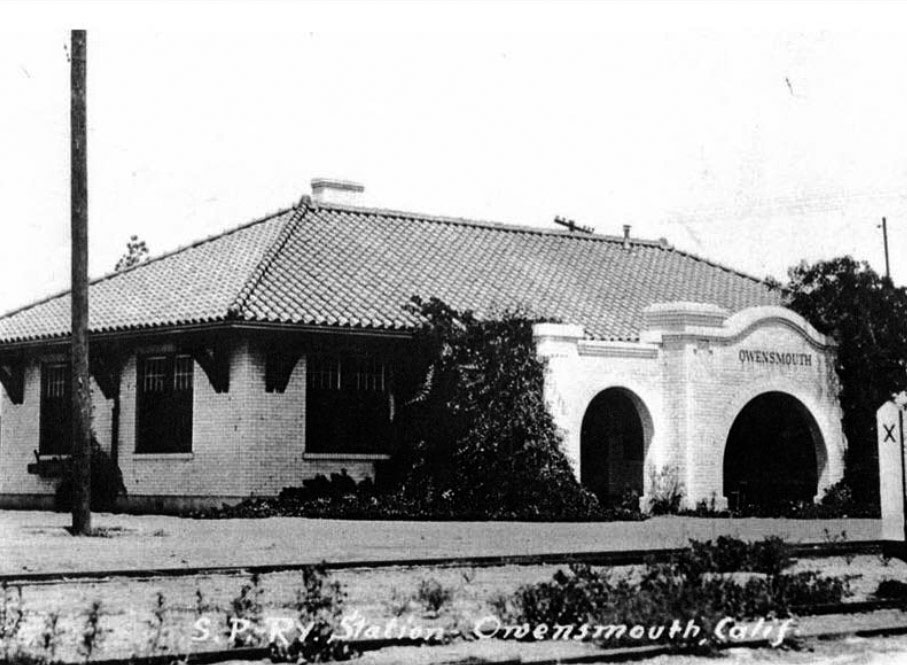 |
|
| (ca. 1915)^ – View showing the Owensmouth Southern Pacific Train Depot located at 21355 Sherman Way, on the northeast corner of Sherman Way and Canoga Ave. It would later become Dicecco’s Hardware Store. |
Historical Notes Built in 1912, the Owensmouth's Southern Pacific Railroad Station was one of the few Spanish Revival railroad Stations in the Valley to survive to the late 20th century. It was declared an historic-cultural monument on May 30, 1990. In 1995 it was damaged by fire and razed.^ |
* * * * * |
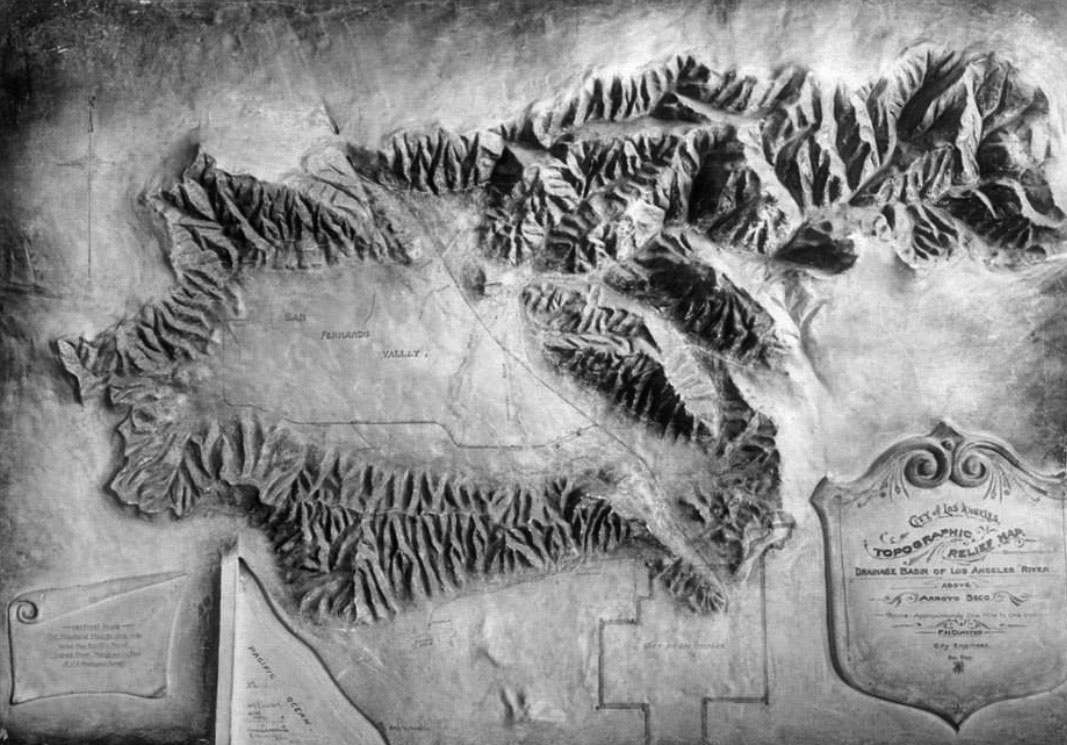 |
|
| (1912)^^*^^ – Topographical relief map titled "Drainage Basin of Los Angeles River." The San Fernando Valley can clearly be seen. It’s so vast that when you’re inside it, you can’t fully see it. |
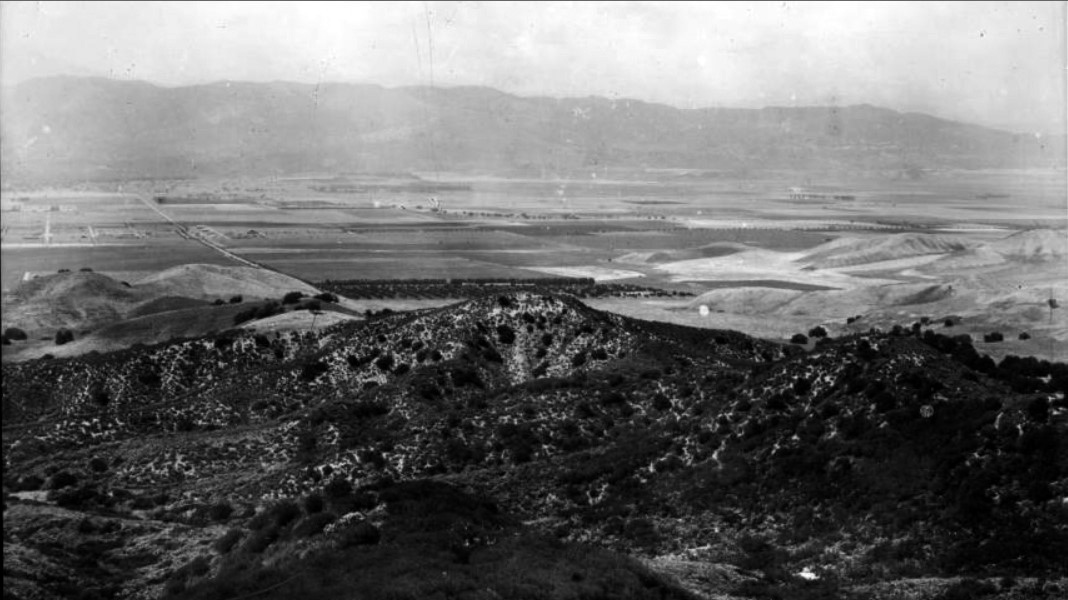 |
|
| (ca. 1914)^^ - Panoramic view of the San Fernando Valley from near Topanga Canyon Road. The wide, flat valley is in the distance at center and is divided into many large farm plots. A small orchard is visible at center and a road cuts through the valley at left. The foreground is occupied by steep, wooded hills, and there are large mountains visible in the background. |
 |
|
| (1915)^ - View of new Topanga Highway winding down north slope into a nearly vacant West San Fernando Valley. |
* * * * * |
Please Support Our CauseWater and Power Associates, Inc. is a non-profit, public service organization dedicated to preserving historical records and photos. We are of the belief that this information should be made available to everyone—for free, without restriction, without limitation and without advertisements. Your generosity allows us to continue to disseminate knowledge of the rich and diverse multicultural history of the greater Los Angeles area; to serve as a resource of historical information; and to assist in the preservation of the city's historic records.
|
More Historical Early Views
Newest Additions
Early LA Buildings and City Views
History of Water and Electricity in Los Angeles
* * * * * |
References and Credits
* LA Public Library Image Archive
^ CSUN Oviatt Library Digital Archives
#^San Fernando Valley History Digital Library - CSUN Oviatt
** DWP - LA Public Library Image Archive
^* The Valley Observied: Street Name Origins; Timeline of Valley History
^# Chatsworth Historical Society; Chatsworth History Timeline; Post Office Poster; Chatsworth Hills Homesteaders
*# Mojave Desert.net: Remi Nadeau
*^^LA Flood of 1938: Cement the River's Future (KCET)
***Los Angeles Historic - Cultural Monuments Listing
*^*California Historical Landmarks Listing (Los Angeles)
^^^LA Times: Adohr Spelled Succes for the Adamsons; Fred Weddington
^^*LA Times: Stanley Norris Petit
*##LA Times: Dig Into History You'll Find Snake Oil..Victor Girard Kleinberger
^##ReoCities: The Chatsworth Tunnels
##+Daughters of the American Revolution: Chatsworth Chapter
###Los Angeles Historical Society
#^^LA River Railroads - Burbank Branch History
#**California State Library Image Archive
#^#San Fernando Valley Blog: Van Nuys Blvd Streetcar Tracks
*#*Project Restore: Van Nuys City Hall
^*^Topanga Canyon History - LA Magazine
*#^LA World Airports - History of Van Nuys Airport
^^#The Museum of the San Fernando Valley
**#Tumblr.com: LA History - Leonis Adobe
^#*Photo of the Northeast San Fernando Valley ca.1950 - Laurie Burns
^*#North Hollywood-Toluca Lake Patch: History of the Laurel Canyon and Valley Plaza Mall; N. Hollywood Train Depot; Weddington House
*^##SCVhistory.com: Beale's Cut
*###California Department of Transportation
**^^KCET: Canoga Park at 100: A Brief History of the Birth of Owensmouth
**^#LA Times Framework: Sepulveda Tunnel
**#^San Fernando Valley Historical Society
*^^^San Fernando Valley Historical Society/Facebook.com Hotel Cecil; 1st Mail Wagon; Whitley Mansion; Van Nuys PE Depot; Toluca Flyer
^^^*San Fernando Valley Relics: Chatsworth Tracks; Beale's Cut
^*^*Metro.net: PE Line Reaches Van Nuys
^^#^Facebook.com - Great Photos from Los Angeles' Past: Van Nuys PE Railroad; Porter Ranch Farmers
*#^#Forum.skyscraperpage.com: Beale's Cut; Hotel Cecil
*#*^Openlibrary.org: Westinghouse Automatic Electric Range
*#^^Big Orange Landmarks: Old Stagecoach Trail
*#^*Los Angeles County Library: Agoura Hills; City of San Fernando
*#*#California Museum: A Journey Along the El Camino Real
#^*^Facebook.com: West San Fernando Valley Then And Now
#**#History of Funeraria del angel Praiswater
#*^#Google Maps and Street Views
#^^^City of Calabasas: cityofcalabasas.com
***^^Pacific Electric Inventory - libraryarchives.metro.net/
****^Facebook: San Fernando Valley Blog
*^*^*Los Encinos State Historic Park: historicparks.org
^^*^^Facebook.com: Garden of Allah Novels
*^^^*RareMaps.com
*^^^#DWP - Water and Power Associates Historical Archives
^***^Pacific Electric San Fernando Valley Line - ERHA.org
*^ Wikipedia: Sherman Oaks; Isaac Van Nuys; Encino; Tarzana; Campo_de_Cahuenga; Cahuenga Pass; Chatsworth; Panorama City; Santa Susana Field Laboratory; North Hollywood; Canoga Park; Woodland Hills; Reseda; Orcutt Ranch; Granada Hills; Andrés Pico; Moses Sherman; Van Nuys; Henry Kaiser; Charles Maclay; San Fernando Valley; Mission Point; Hughes Aircraft; Domonique Amestoy; Winnetka, Los Angeles; City of San Fernando; Canoga Park High School; Ventura Freeway; Hollywood Freeway; Los Angeles Valley College; Domonique Amestoy; Los Encinos State Historic Park; H.J. Whitley; Lankershim-Van Nuys Pacific Electric; Van Nuys High School
< Back
Menu
- Home
- Mission
- Museum
- Major Efforts
- Recent Newsletters
- Historical Op Ed Pieces
- Board Officers and Directors
- Mulholland/McCarthy Service Awards
- Positions on Owens Valley and the City of Los Angeles Issues
- Legislative Positions on
Water Issues
- Legislative Positions on
Energy Issues
- Membership
- Contact Us
- Search Index